LUIS NIEVES FALCÓN



EDITORIALUNIVERSITARIA
ocTOR LuisNievesFalcón,aprofoundresearcherinthefieldof socio-pedagogicalproblems,wasborn inthetownofBayamón,PuertoRico, onDecember29,1929.
AftergraduatingattheUniversity ofPuertoRico.asaBachelorofSocial Sciences,withanEducationmayor, in1950,hetaughtattheHighSchools ofOrocovis,ComeríoandBayamón. In1956hetookhisMaster'sdegree inSociologyatNewYorkUniversity, andthereuponbecameamemberof thefacultyattheUniversityofPuerto Rico,withtherankofinstructoruntil 1958.ShortyafterhewenttoEngland to prepare his doctorate at the LondonSchoolofEconomicsandPolitical Sciences.
UponhisreturntoPuertoRicoand itsStateUniversity,hewasnamed AssistantDirectoroftheSocialResearch Center,Collegeof Social Sciences,andastudyon"Social ConsecuencesintheSchools"was conductedunderhim.
In1962hewentbacktotheLondon SchoolofEconomicsandPolitical SciencestograduateasaDoctorin PhilosophyatitsFacultyofArts, beingsofartheonlyPuertoRican graduatedatthatinstitution.
Morerecentlyhewasinvitedby theInternationalCouncilofSocial Sciences(Unesco)totakepartinthe InternationalConferenceofComparativeSocialStudiesforDeveloping Countries,whichtookplaceinBuenos Aires,Argentina,inSeptember1964.
AtpresentheisDirectorofthe CenterofPedagogicResearchatthe UniversityofPuertoRico,withthe rankofAssistantProfessor.


Copyright, 1965.

199,O -1960

EDITORIAL UNIVERSITARIA
UNIVERSIDADDEPUERTORICO
RIO PIEDRAS
L965

)(TIS nevereasytotracethesourcesofaman'sthinking.In .J( fact,variousconceptsadoptedinthisstudyhavealreadybecomethestock-in-tradeofthesocialscientist.Moreover,theinception,development,andprogressivemodificationsofthestudy initsseveralphasesmouldnothavebeenquitefeasiblewithout theinitiative,tolerance,expertadvice,andpatientpracticalhelp ofvariouspersons.Tothemtheauthormouldliketomakethis modestgestureofacknowledgment,atthesametimereleasing themfromanyresponsibilityforthefinalformwhichthetext hastaken,particularlytheconclusionsandjudgmentsdrawnto emphwsizethefindings.
ProfessorD.V.Glass,headoftheDepartmentofSociology, LondonSchoolofEconomicsandPoliticalScience,forhissustainedscrutinyofthedataanalysesandforhisstimulatingand instructiveadvice thereon.
Dr.MillardHansen,DirectoroftheSocialScienceResearch Center,UniversityofPuertoRico,forlaunchingtheprojectof whichthisstudyisapart.
DeansOscarE.PorrataandAugustoBobonis,CollegeofEducation,UniversityofPuertoRico,forrecommendingthegrantof atwo-yearstudyleavetoenablethegranteetofurtherworkfor thePh.D.degreeonthebasisofthisstudy.
Dr.AsherTropp,ReaderattheLondonSchoolofEconomics, andhiswife,LynnTropp,forreadingthedraftmanuscriptand providinginsightsandsuggestions.
Dr.JaimeBenítez,Chancellor,UniversityofPuertoRico,for grantingpermissiontouseUniversityrecords.

Dr.EfraínSánchezHidalgo,formerSecretaryofEducation, forpermissiontousepublicsecondaryschoolrecordsandtodistributethehighschoolquestionnaire,alsotouseavailabledata attheOfficeofStatistics.
ThevariousdeansintheUniversityofPuertoRico,RíoPiedrascampus,theRegistrar,andpersonneloftheRepordsOffice andtheStudents'OrientationCenter,forfacilitatingtheuseof theirrecordsfiles,andtheIBMCenterforprovidingfacilitiesfor processingthedata:
Thehighschoolseniorsandfreshmanstudentswhowillingly filledthequestionnaires.
Thefollowingpersonswhoinonewayoranothercontributed tóthepracticalphasesofthestudy:AngelinaRoca,AnaTeresa Fábregas,AdadeJesúsNegrón,CeliaRodríguezPacheco,Angela LópezTorres,AlejandroRodríguezFortyz,MiltónBaigésChapel, PaquitaLimardo,CarmenH.López,CarmenEleonoraAranaCa'stró,ConchitáTorruellas,MaríaC.JiménezdePeña,andMaryTutt:..


Education in Puerto Rico is graded into the elementary (6years),secondary(3yearsinjuniorhighschooland3insenior high),andcollegiatelevels.Practicallyallschoolsatthefirsttwo stagesarepublic,orstate-supported.Thesepublicschoolstake 92percentofalltheelementaryschoolchildren,92ofthejunior highand86oftheseniorhigh.Universityeducationisalsopredominantlyastateundertaking,althoughtoalessextentnowthan itwasbefore;73percentofallthecollegestudentsinthe.island wereenrolledinthestateuniversityin1960-61,comparedto93at thebeginningofthetwenty-yearperiodselectedforthisstudy.
The publicinstitution which houses three-quarters of the college-studentsintheislandiscalledtheUniversityofPuerto Rico.Ithasexpandedveryrapidlyduringthelasttwodecades. Thetotalenrolmentinallitsthreecampusesincreasedfrom5,869 in1940-41to18,891in1960-61.TheRioPiedrascampus,which isthesubjectofthisstudy,registeredarisefrom5,099to13,532 betweenthosetwoacademicyears.Thecriteriaforadmissionto theUniversityarethehighschoolgraduationindexandacompetitiveentranceexamination.Aconsiderableamountoffinancialassistance,inavarietyofforms,isavailabletostudentswho mayneedit.Theextentofsuchassistancemaybegaugedfrom thefactthatabout47%ofthestudentsinthe1960-61academic yearattheRioPiedrasCampusreceivedsomekindofassistance. Theaverageamountofassistancegivenwas$266,whichrepresents about29%ofthe$922whichUniversityofficialshavecalculated astheaverageyearlyexpensesforauniversitystudent.
Oneofthemainobjectivesofthisstudyistoseetheextentto whichtheopportunitiesforhighereducationinPuertoRicohave changed.Forthispurposethesocialcompositionofthestudentbody

attheUniversityofPuertoRicofromto1940to1960isanalyzed. Recruitmentintermsofsex,rural-urbanresidenceandschoolof originisanotherimportantaspectforconsideration.Thus,this studywillattemptto definethesocialcharacteristicsof those segmentsofthepopulationwhichareavailingthemselves of the newandexpandededucationalfacilitiesofferedattheUniversity. Itwillalsoseektolocatetheshift,ifany,inthesocialstatusof thestudentsthroughouttheperiodchosenfortheinquiry.
ItisacommonplacethatinPuertoRicothestateuniversity hasalwayshadmoreapplicantsthanitcanadmit.Everyyear aconsiderablenumberareturneddownduetolackoffacilities. Itissignificanttoknownotonlythesocialcharacteristicsofthose admitted,butalsotheiracademiccharacteristics.Thestudywill thusbeconcernedwiththeacademicpreparationofthestudents enteringthefreshmanyear.HowmanyyearsofSpanish,English, mathematics,science,andsocialstudiesdidtheyhaveintheir highschool?Hasthisbasicpreparationdiminishedorincreased?
Duringtheearlypartoftheperiodcoveredbythisresearch, theUniversityhadspecificsubjectrequirementsforadmission. However,theseweresubsequentlywaivedin1954;sincethenonly ahighschooldiplomahasbeenrequiredofapplicantswhohave tocomplyonlywiththesubjectrequirementsforhighschoolgraduation.Whateffects,ifany,didthischangeinpolicyhaveon thepreparationofstudentsadmittedintotheUniversity?Ispreparationrelatedtotypeofhighschoolsattended?Isthereany differencebetweenthosefromprivateandpublicschools?Among thosefromschools located in rural,urban, and metropolitan areas?Amongthosefromdifferingsocio-economicstatus?
Amongsttheacademiccharacteristicsrelevantinthisstudy aretheperformanceindices.Theseincludethehighschoolgraduationindex(orthenumericalaverageofthegradesobtained inallsubjectstakeninthehighschool),theentranceexamination score(ortherawscoreobtainedinthecompetitiveexamination whichisgivenaspartoftheadmissionrequirementsatthestate university),thefreshmanindex(orthenumericalaverageofall gradesobtainedduringthefirstyearofuniversitystudies),and theuniversitygraduationindex(orthenumericalaverageofthe gradesinallcoursestakenattheUniversity).Occupationalstatus, sex,ruralorurbanbackgrounds,type,size,andlocationofhigh schoolwillbeexaminedinrelationtotheseindicesofachievement.Thefollowingareourguidingquestions:Howdoessocial originrelatetoachievementamongthestudentsinthestudy?

Doprivateschoolstudentsperformbetterthanthosefromthe publicschools?Whatarethecharacteristicsofpublicschoolstudentswhoseperformanceishigh?Dotheycomefromlargeor smallschools?Fromrural,urban,or metropolitanschools?Is thereanyrelationshipbetweenhighschoolpreparationanduniversityperformance?Whatarethecharacteristicsofstudentswho drop out? Of those who take more than fouryears tofinish aBachelor'sDegree?Hastherebeenanychangeduringtheperiod1940-60?
Alsoofinterestinthisstudyarethecharacteristicsofthe studentswhogointothevariousexistingcollegesintheUniversity,sincethosewillbearonthequalitiesofthedifferentprofessionalgroupsreceivingtrainingintheinstitutionwhichsupplies thebulkof civilservants andprivate enterprisemanagement personnel.
TheUniversityofPuertoRicoconsistsofacollegeofGeneral Studies,wherethestudentsspendthefreshmanyearandpart ofthesophomoreyear,andfiveothercollegesinwhichtheycompletetheprescribedfour-yearcurriculumleadingtothebachelor'sdegree.Inthecollegeof GeneralStudies,thestudentsgo throughageneraleducationprogram,afterwhichtheymoveto thecollegesoftheirownchoicetospecializeaccordingtothe areasofinterest.ThesearethecollegesofHumanities,Natural Sciences,SocialSciences,BusinessAdministration,Pedagogyand Pharmacy.
Weshalltrytofindtheanswerstothefollowingquestionsin ouranalysisofthecompositionofthestudentbodyofthevarious colleges.Whatarethecharacteristicsofthestudentswhogointo eachcollege?Arethereanydifferencesinsocialcompositionbetweenthecolleges?Inhighschoolpreparationoftheirstudents? Doesstudentperformancevaryfromonecollegetoanother?These questionsalsobearontherecruitmentpatternoftheprofessions intheisland.
Theperiodwithwhichweareconcernedinthisstudyisthat between1940and1960.Thisperiodwaschosenfortworeasons. First,in1940,thePopularDemocraticPartycametopower.Its platformhasstressedsocialandeconomicreformswhosepractical applicationhashadastronginfluenceinstimulatingtherateof socialchangethattheislandisundergoing.Duringthisperiod, anewadministrationtookoverintheUniversitywhichentered onaperiodofrapidexpansionalsonoticedatallothereduca-

tionallevels.Secondly,documentsandrecordsaremorereadily availableforthisperiodthanforanyother.
TnPuertoRicotherearethreeprivateuniversities(theCatholicUniversityinPonce,theInteramericanUniversityinSan Germán,andtheSacredHeartCollegeforWomeninSanturce), onejuniorcollege(PuertoRicoJuniorCollegeinRioPiedras),and thestateuniversity(UniversityofPuertoRico).Thelastonehas threemaincampuses.Thesubjectofourstudyconsistsofallthe studentsmatriculatedinthebachelor'sprogramattheRioPiedrascampusoftheUniversityofPuertoRicofortheacademic years1944-45,1952-53,and1960-61.TheSanJuancampus,where graduateworkinmedicineanddentistryiscarriedout,wasnot included,northecampusofMayagüezwhichincludesmainlythe engineeringandagriculturalartsprogram.
TheUniversityofPuertoRicowaschosenbecauseitisapublicinstitutioninwhich equalityof opportunityisan official objective.Theavailabilityofmaterialstherealsoinfluencedour choice.Lastly,thelimitedfacilitiesatourdisposalconfineusto onlyoneinstitution,andtothemostaccessibleone.TheRioPiedrasCampuswasselectedbecauseithasthelargestundergraduate enrolmentintheentireinstitution.
The presentation of thestudy will consist of four parts. Thefirstdealswithtrendsinthelowerlevelsoftheeducational systeminPuertoRicoduringtheperiodselectedforthisresearch. Thisisfollowedbyanhistoricalaccountof theUniversityof PuertoRico.Thesecondpartisasurveyoftrendsinthesocial andacademiccharacteristicsofcollegestudentsasrepresented bythefreshmanbody.Partthreeundertakesafurthercorrelationoffactorsandvariablestoilluminateorconfirmthepoints madeinprevioussections,againwithspecialreferencetohistoricaltrendsinthe"quality"offreshmanstudents.Onabroader planeitseekstolocateclassinfluenceswhichmightbeoperating inthesystem,particularlyinthelightofmeasuredacademicperformance.Acentralpointofinterestistherelationshipbetween highschoolgradesandtheacademicindicesusedintheUniversity.Thus,thewholeproblemofperformancewillbeplaced withintheperspectiveofsocio-economicstatus,schoolcharacteristics,andsecondarypreparation.Thelast partof thiswork recapitulates the majorfindings on social and academic characteristicsbyrelatingthemtothevariousundergraduatecolleges intheUniversity.Finally,thereisasectionembodyingcertain

broadgeneralizationsandpersonalcommentsbytheauthorrelativetothemainfindingsoftheentirestudy.
ThesectionsoneducationaltrendsandtheUniversityof PuertoRicorepresentanefforttoappraisethefundamental changesundergonebyasystemwhosephilosophyhasostensibly shiftedfromoneofcateringtoanélitetoanotherofproviding masseducation.Thedataforthesetwochapterswerecollected bytheauthorfromthevoluminousfilesoftheDepartmentof EducationandtheUniversityofPuertoRico.Theworkinvolved ascrutinyofreportsandmanuscripts,someofwhichwereconfidential.Fromthissearchithasbeenpossibletopiecetogether scatteredinformationabouttheschoolsystemandtopresent forthefirsttimeanoverallpictureofthelasttwodecades.The purposeofthetwochaptersisnotonlytocollectandsynthesize existingdatabuttogivethemasociologicalmeaning.Further availableinformationwasusedtoplacetheminacross-cultural frameofreference,whilesupplementarymaterialswerereconstructedfromprintedsourcesandprivateconversationswith UniversityteachersandpersonnelofthecentralofficeoftheDepartmentofEducation.
Theprincipalsourceofinformationforthesecondpart,on trendsinthesocialandacademiccharacteristicsofcollegestudents,istheRegistrar'sOfficeoftheUniversityofPuertoRico. Thedocumentsmainlydrawnuponaretheindividualapplicationsforadmissionandtheacademicrecords.ConfidentialdocumentsfromtheScholarshipandVeteran'sDivisionswerealso examined.
Thissecondphaseofthestudystartedwithasurveyof existingrecordsfrom1940to1964withtheobjectofdetermining theacademicyearsforwhichinformationwasmorecomplete. Weproceededbystudyingthehundredthcaseineveryyear.The wholeprocedureprovedlaboriousandtime-consumingowingto thevarietyofapplicationformsusedfromyeartoyearandthe consequentvarietyofinformationfoundinthem.Forsomeofthe years,differentapplicationblanksweredistributedsimultaneously.Theoutcomeofthesearchisthechoiceofthethreeacademicyears1944-45,1952-53,and1960-61ashavingrelatively completerecordsforthetypeofinformationdesired.Moreover, thespanoftimeallowsanhistoricaltrendanalysisofthefindings. Actualgatheringofdatahadtowaitfurtherandcouldnotbe starteduntilafterthefreshmanstudentshadbeenseparated fromalltheothers(sophomores,juniors,seniors,graduates,two-

yearstudents,extra-mural,irregular,andvisitors) 1. Theentire freshmanclasseswhichprovidethesubjectofthisstudynumbered650in1944-45,1,166in1952-53,and1,749in1960-61.
Thedatacollected.fromtheRegistrar'sOfficeweresupplementedbyotherformsofinquiry.First,aninformationsheet wasdistributedamongstthefreshmanstudentsofthe1960class toobtaintheirfathers'occupations.Thissheetwasfilledinby freshmenintheirvariousclasssectionsunderthesupervision oftheauthorandhistwoassistants.Topreventduplication,only theSpanishsectionswerevisited.Secondly,anindividualfollowúpwasdoneforallcasesabsentfromclassonthedaytheinformationsheetwasdistributed.Thirdly,casesforwhominformationonfather'soccupationwasstillmissingwithrespect tothethreeacademicyearsselectedforinvestigationweretraced tothehighschoolsfromwhichtheygraduatedsoastoreduce toaminimumtheno-informationcases.Thiswasdonebycorrespondenceorpersonally,thesourceschieflyrelieduponbeing thestudents'cumulativerecordsandthevocationalcounsellor's fileskeptinthevarioushighschoolsoftheisland.Fourthly,data onthesocialcompositionofhighschoolseniorswereobtained throughapaper-and-pencilquestionnairewhichwasadministered originallytoarepresentativesampleofhighschoolseniorsin theislandforanotherstudybeingundertakenintheSocial ScienceResearchCenteroftheUniversityofPuertoRico.Asto thedatathuscollectedforthisstudy,theauthorundertookthe administering,coding,machineoperationsandanalysis.Lastly, visitsweremadepersonallybythewriterto35publicandprivate highschoolsscatteredovertheisland.
Thevisitslastedforaminimumperiodofoneschoolday ineachschool.Thechiefobjectofthesevisitswastoassess
1. Datawerecodedbyresearchassistantswhoreceivedatwo-week intensivetrainingonthevariousphases of coding.Threemethodswere establishedtoinsurecodingreliability.First,alltheresearchassistants codedthefirstonehundredcasesanddiscussedthem.Secondly,every tenthcase of thosewhicheachresearchassistanthadcodedwasalso codedindependentlybytheauthorsothatdisagreementscouldberesolved whencaseswerecompared.Thirdly,,everytwentiethcase,codedbyeach researchassistantwasinturncodedbytheothers.Foreach of these proceduresitwasagreedthatanydoubtemerginginthecodingprocess wouldbebroughttotheattention of allthecoders. By discussingand counterchecking,discrepanciesincodingwerereducedtoaminimum. Thecodingerrorwas 0.2%.

existingconditionsandtosoundoutteachersandotherpersonnel actuallyinthesystem.Thesetalksdidnotfollowastructured interviewpattern,butwereratherinformal,allowingscopefor teachers and principals to pose their own queries concerning workingconditionsintheirparticularschools,especiallyasregardsfacilities.Theschoolsvisitedwereselectedfromsmalland largepublicschools,urbanandrural,anddenominationaland non-denominationalprivateschools.Theirsizesvaryfromunder 100toover2,000pupils.Someofthebuildingsarenew,others decrepit.Someareprovidedwithmodernfacilities,otherswith thebarestminimum.Someareofrecentorigin,othersoflong standinginthecommunity.Aschoolvisitincludedatalkwith theprincipalandalsowiththeteachers(from1to10ofthem), andatouraroundtheschoolpremises.
Thesecondpartofthisstudyistheresultof thefirstinvestigationsofarundertakenintosocialselectionattheuniversitylevelinPuertoRico,intothechangesinthisselectiveprocess overthetwodecadescoveredbythestudy,andtherelationship ofthisprocesswiththatinthelowerschoollevels.Italsogives forthefirsttimetheacademicbackgroundoffreshmanstudents whoentertheUniversity,thevariationduringthetwenty-year period,andtheconnectionwithsociologicalfactors.Asinthe previoussection,cross-culturaldatawerebroughtintothepicture whenevertheywerecomparabletoourowndata.
Thedataforpartthree,onacademicperformance,werealso constructed from information collected from the Registrar's recordsfor individualstudents.With these data, it has been possibletomakeforthefirsttimeanappraisalofthesocialrelevanceoftheacademicindicesappliedinthehighschoolsandin theUniversity.Previousresearch undertaken by theSuperior EducationalCouncilontwowidelyseparatedyearswithinour period,although excludingsocialconsiderations,permitsusto drawcomparisonswithsomeofourfindings.Supplementarydata forthispartofthestudywereobtainedfromofficialpublications and participantobservation.Thelatterwas conducted bythe authorwhileofferingatwo-semestercourse,duringtheacademic year1960-61, to freshmen in the College of General Studies, meetingthreehoursaweek.Thisphaseoftheinquirygavethe writersomeinsight intothebureaucraticstructurewithin the Universitywithrespecttostudentgrading.
Thelast part of thisstudy,which dealswith curriculum choiceandperformancebycollegeinthestateuniversity,isalso

basedondatacollectedfromindividualrecordsfiledintheRegistrar'sOffice.Itmakesaninitialefforttodefinethedistributionofsocialclassesandmeasuredabilityamongstthevarious colleges.Itssignificanceliesinthe evidenceof arelationship betweencollegecharacteristicsandrecruitmentintotheprofessionsandparticularlyasregardstherecruitmentoftheteaching profession.
Thisstudyformspartofamoreextensiveresearchonthe socialconsequencesoftheschoolsinPuertoRico,undertakenat theSocialScienceResearchCenterofthestateuniversity.The researchprojectasawholeisrelatedtotheprogrammeoneducationalsociologybeingdevelopedatthatCenter.Astothisstudy, thewholephaseofdatacollectionandmachineoperationslasted foraperiodoftwoandahalfyearsandwasundertakeneither bythewriterhimselfaloneorunderhisdirectsupervision.
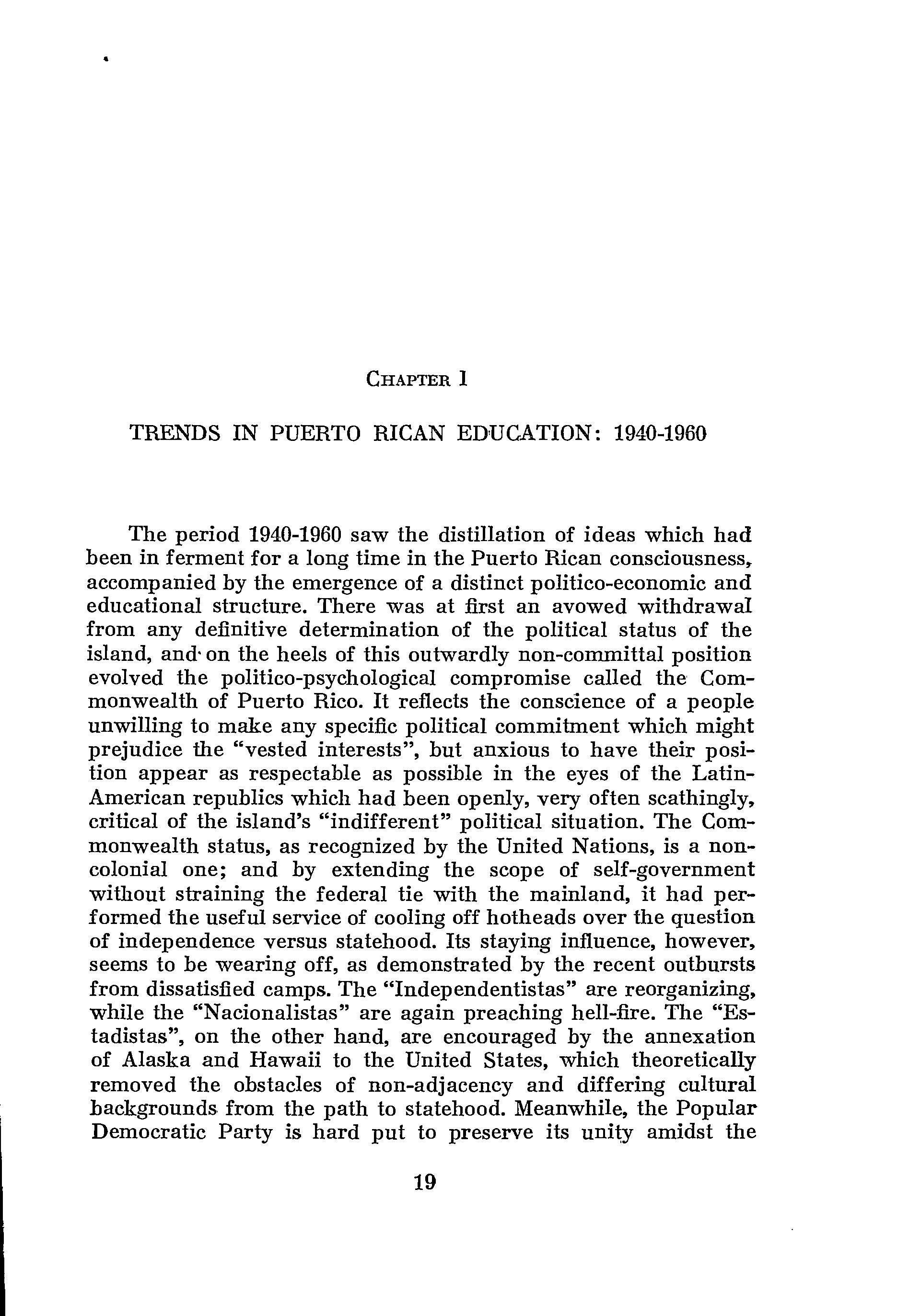
Theperiod1940-1960sawthedistillationofideaswhichhad beeninfermentforalongtimeinthePuertoRicanconsciousness, accompaniedbytheemergenceofadistinctpolitico-economicand educationalstructure.Therewasatfirstanavowedwithdrawal fromanydefinitivedeterminationofthepoliticalstatusofthe island,andontheheelsofthisoutwardlynon-committalposition evolved thepolitico-psychological compromisecalled the CommonwealthofPuertoRico.Itreflectstheconscienceofapeople unwillingtomakeanyspecificpoliticalcommitmentwhichmight prejudicethe"vestedinterests",butanxioustohavetheirpositionappearasrespectableaspossibleintheeyesoftheLatinAmericanrepublicswhichhadbeenopenly,veryoftenscathingly, criticaloftheisland's"indifferent"politicalsituation.TheCommonwealthstatus,asrecognizedbytheUnitedNations,isanoncolonial one; and by extending the scope of self-government withoutstrainingthefederaltiewiththemainland,ithadperformedtheusefulserviceofcoolingoffhotheadsoverthequestion ofindependenceversusstatehood.Itsstayinginfluence,however, seemstobewearingoff,asdemonstratedbytherecentoutbursts fromdissatisfiedcamps.The"Independentistas"arereorganizing, whilethe"Nacionalistas"areagainpreachinghell-fire.The"Estadistas",ontheotherhand,areencouragedbytheannexation ofAlaskaandHawaiitotheUnitedStates,whichtheoretically removedtheobstaclesof non-adjacencyanddifferingcultural backgroundsfromthepathtostatehood.Meanwhile,thePopular DemocraticPartyishardputtopreserveitsunityamidstthe

demandsfromwithinitsownhouseformoreautonomyinlocal andforeignmatters1.
Asfarassettingupeducationalgoalsisconcerned,the presentstatushasbeeninveighedagainstasbeingadeterrent. Itisbelievedbysegmentsoftheintelligentsiathatthelackofa well-definedpoliticalobjectivepreventsthedevelopmentofan educationalsystemgearedtothesocio-economicrealitiesand needsoftheisland.ItisheldfurtherthattheCommonwealth perpetuatesacolonialphilosophyoflifebyfosteringthefeeling ofpoliticalandeconomicinsecuritycharacteristicofearlier periods.
Ontheeconomicside,theperiodhasbeencharacterizedby asystematicefforttodiversifytheisland'sagriculturalsubsistence economyonascientificlevel,topromoteindustrialization,encouragefamilyplanningandeffectamoreequitabledistribution ofwealth.Theseeconomicaimsaretobecarriedoutthrough thelegalrestrictionofland-holdingto500acres,theexpropriation offoreignlatifundia,resettlementoffarmers,statecontrolof basicpublicservices,stateinitiativeinindustrialenterprises,and anall-out"OperationBoot-strap",asthelarge-scaleindustrializationschemeiscalled.
Toassistinthisneweconomicorientation,educationhas beencalledupontoperformspecifictasks.Theseareoutlined byHarveyS.Perloff,andhavebeenincorporatedbysuccessive secretariesofeducationintheirrespectiveprogrammes.Theyare thefollowing:
"1.Tohelpdeveloptheeconomic,social,andpsychological factorsthatconducetoanindustrialclimate.
2.Totrainskilledworkersforthenewlyestablishedindustries.
3.Toexpandfacilitiesamongsttheschoolagepopulation,
1. InPuerto Rico therearethreeofficialparties:the"Independentistas"whoaspiretoachievepoliticalindependencethroughtheexisting electoralprocess,the"Estadistas"whoseultimateaimistheannexationof theislandasastateoftheNorthAmericanunion,andthePopularDemocraticParty,supporterofthepresentstatusofCommonwealth.Other politicalorganizationswhichdonotenjoylegalstatusarethe"Nacionalistas",whoaspiretoachieveindependencebyarmedrebellionandforce, theCommunistPartyandaCatholicPartyofrecentorganization.

therebytoraisetheeducationallevelandimprovethe potentialresourcesfortherecruitmentofworkers, technicians,andindustrialmanagers.
4.Tohelpfostertheimprovementofagriculture,industry, andothersourcesofproduction,andtheconservation andsoundexploitationofnaturalresources.
5.Todevelopaproperunderstandingofthepsychological changes—changesincustoms,beliefs,habitsandways oflife—whicharethenecessaryconcomitantsofindustrialization,withaviewtoreducetoaminimum conflictsandmaladjustments" Z
Aswecansee,thetaskssetupfortheschoolsysteminvolve psychologicalorientationtoaneo-industrialsociety,withlittle regardtotheeconomicrealitiesintheislandandthecultural needsofitspeople.Ineducation,themostpalpableoftheserealitiesisarateofgrowthoftheschoolpopulationcontinuously outstrippingavailablefacilities.Moreover,theresponsibilityfor thenewsocialorderisplacedsquarelyononesingleinstitution whichitselfhasyettoachievesufficientfreedomtotaketherequiredinitiative.TheSecretaryofEducationisresponsibletothe partyinpower,ordirectlytothegovernorwhoappointshim, ratherthandirectlytotheelectorate.Inotherwords,wheretheinterestofthepartymightbeinconflictwiththatofthepeople,the SecretaryofEducationisboundtofollowthepartyline.This situationdiffersfromthatofthelateSpanishandearlyAmericanperiodduringwhichelectedmunicipalschoolboards,in chargeofeducationalfinances,servedasacheckonthecentral authority.Italsodiffersfromexistingconditionsinmostofthe UnitedStates,wheretheBoardsofEducationareelectedand togetherwithcertaincivicorganizationsinfluenceeducational decisions.WiththeconsolidationofAmericanpoliticalrulein PuertoRico,localparticipationineducationalmatterswasabolishedandeducationalauthorityconcentratedinaSecretaryof Education,whowasapoliticalappointeeoftheUnitedStates Presidentandvestedwithextraordinarypowersoverbothpublic andprivateschools.Thelegalstructurehasremainedunchanged, andtheSecretaryofEducation,whoisnowresponsibletothe
2.AnnualReportoftheSecretaryofEducation;1952-53,p.56-57.

Governoroftheislandandthepoliticalpartyinpower,enjoys thesamepowersashispredecessors.
Thattheinterestsofthepartyandthecommunityneednot coincidewasshownin1957,whenthenewlyappointedSecretary ofEducationorganizedapublicevaluationoftheschoolsystem. Atthesametimehegavethetop-leveleducatorstounderstand thatthefindingsofthatenquirywerenottobebindingonthe SecretaryofEducationinanyway.Morerecently,theEducation Commissionoftheisland'sLegislatureorderedanevaluative studyoftheeducationalsystem,andagainitwasexplicitlyindicatedthatthecabinetmemberforeducationwasnottobebound bytheresults.Thissituationismadepossiblebythefactthatthere arenoadequatechannelsofpubliccontrolwhichcanpreventthe legislatorsfrompassinglawscontrarytothenationalinterest orpressthemintopassingfavourableones.Organizedopinionis stillundeveloped;thustherearevirtuallyno"pressuregroups" tobearinfluenceonthegovernment.Infact,thepoliticalsituationintheislandisgearedtothepreservationofthisstateof affairs.
InPuertoRico,electionsareheldeveryfouryears.Allthe politicalpositions,fromthegovernorandresidentcommissioner intheUnitedStatesCongressdowntothemunicipalcouncillors arefilledbythoseelections.Nominationstothesepositionsrest onthepartyleaderwhoisalsoheadofthegovernment.Indeed, aspirantsdependonthepersonalinfluenceofthepartyleaderfor successatthepolls.Thepopulaceidentifythemselvesratherwith theleaderofthepartythanwiththepartyitself;thustheyare "muflocistas",insteadof"populares".Atthepollingboxes,the majorityoftheelectoratehardlymakeuseofthe"splitticket" andmerelycasta"blockvote"forthepartyoftheirleader.Elected officialsthereforefeelthemselvesboundnottotheelectoratebut tothepartyleadertowhomtheyowetheirelection.Between electionstheysubmittostrictpartydiscipline.Deviationistsare likelytolosepartynominationinthenextcampaign,thereby forfeitingtheirchancesofcontinuingapoliticalcareer.Sofar nocandidateshaveeverbeenelectedonanindependentticket inPuertoRico.
Partydisciplineisespeciallyfeltinthenationallegislature; infact,itissostrongthat"itpreventstheLegislativePowerfrom exercisingadequatefiscalizationoftheExecutiveBranch" 3 When
3.Comitédelgobernadorparaelestudiodelosderechosciviles,

conflict ariseswith regard toalegislativemeasure,interested partiesdonotlobbylegislators.Theyprotestpersonallytothe governor,"thesupremesourceofauthority".Intheirimageof him,hecanhavelegislationpassed,stoppedorabrogated,and theyarenotfarfromtheactualtruth.
Inthispoliticalclimate,itisthe"paternalauthority"notthe citizenrywhichdetermineswhatisbestineducationalmatters. Educationalplanningisperforcethechildofpartypolitics,and inthelasttwodecadesithasmainlytakentheformofexpanded educationalfacilities.
Thischapterisconcernedwithtrendsineducationalplanning andorganizationduringtheperiod1940-1960whichbeganwith theaccessiontopowerofthePopularDemocraticParty.Itscampaignplatformpromisedimprovementofsocialconditionsinthe islandandafreshapproachtoeducation.Theeducationalprogrammewasstartedoff bysettlingthelanguageproblem.So farinstructionatalllevelsofeducationhadbeenconductedchiefly inEnglish,withSpanishasasupplementarymedium.Thiswas inaccordwiththeUnitedStatespolicyof"americanization"of theisland.Thenativelegislature,underthecontrolofthePopular Party,nowdecreedthatSpanishwastotakeprecedenceover Englishinallthepublicschools 4 OppositionfromthePresident oftheUnitedStatesandhisappointee,theGovernorofPuerto Rico,sparkedoffaparliamentaryandlegaldebate,theoutcome ofwhichwasanadministrativeresolutionconfirmingthelegislativemeasure,reducingEnglishtoacompulsorysecondlanguage forallpublicelementary,secondaryanduniversityinstruction intheisland 5
ThedissociationofPuertoRicaneducationfromofficialpolicyinthemainlandwasanotherfeatureofthenewregime.It startedin1947,whenthepopularlyelectedgovernorwasgiven thepowertoappointtheSecretaryofEducation.In1952,with
InformealhonorablegobernadordelEstadoLibreAsociado(SanJuan, PuertoRico:ColegiodeAbogados,1959),pp.61-78,passim.Seealsoreport forthissameCommitteeonCivilRightsbyMiltonPabon,RobertW.Anderson,and.VíctorJ.Rivera,"Losderechospolíticosylospartidospolíticos"(mimeographed),1958.
4.SenateBill,Number51,1946.
5.Thelocaladministrationgotaroundthepresidentialvetoby treatingthematterasanacademiconeandthereforewithinitsjurisdiction.Withthisasprecedent,itispossibleinthefutureforthemedium ofinstructiontoreverttoEnglishbyasimilaradministrativedispensation.

thecreation of the Commonwealth, educationalmatters came under thefull jurisdiction of local authorities.But the legal machineryof theearly"American"periodwasretained.The chief educationalpolicy-makerremainedacreatureof theappointingauthorityandassuchwasboundfirstto"playpolitics" withintheeducationalsystemintheinterestoftheregime 6.
Withinthispoliticalcontext,sincethenativeregimetook over,whathasbeentheeducationalexperienceofthepopulation whichthesystemisdesignedtoserve?Theimplicationsofeducationonoccupation,income,andfertilityratesinPuertoRico havebeenthesubjectofcompetentresearchandstudyandmake anappropriatestartingpointforthepresentanalysis.Fromhere, weshallproceedtotracethegrowthoftheschoolsystemandits impact,usingthefollowingasindices:—expendituresperstudent, studentsperclassroom,student—teacherratio,andteacherpreparation.Finally,growthwillberelatedtoschool-agepopulation, sex,andrural-urbanresidence.
Thefirstbasicingredientofeducationalexperienceisliteracy, ortheabilitytoreadandwrite.InPuertoRico,theproportionof illiterates,amongstpersonsoftenyearsofageandover,declined progressively throughout the period 1940-1960: 31.5 per cent intheearlieryearand17inthelatter.Illiteracyappearstobeless amongstthemalesthanamongstthefemales.Butwhenweconsider residentialorigin,asomewhatdifferentpictureemerges. Urbanfemales,thoughlessliteratethantheurbanmales,are moreliteratethantheruralmales.Thusresidence,notsex,isthe determiningfactorinliteracy.Further,althoughbothgroupsdecreasedtheirproportionateshareofilliterates,therateofdecrease hadbeengreateramongstthefemalegroup'.
Wefindsimilarresultsifweuseasacriterionthemedian
6.TheobviousexampleofpartypoliticsintheDepartmentofEducationisthepublicationbythedivisionofthenewspaper"Semana".This weeklywasdefinedbytheCommitteeoftheGovernorfortheStudyof CivilRightsas"anorganofpoliticalpropaganda"infavouroftheparty inpower.Itisentirelyfinancedanddistributedwithpublicfundsallocated toeducation.Despitefrequentcriticisms,thepresentarrangementstill persists.SeeComitedelgobernadorparaelestudiodelosderechosciviles,op.cit.,p.55.
7.U.S.BureauoftheCensus,U.S.CensusofPopulation;1940.CharacteristicsoftheyPopulation:PuertoRico,BulletinnP2,p.22;Id.,1950, Part.53,ChapterB,p.33;Id.,1960,GeneralandEconomicCharacteristics, p.121.

yearsofschoolingattainedamongsttheadultpopulationof25 yearsandover.In1950,theurbanadultswere1.9gradesabove therural,andin1960,thisdifferencehadincreasedto3.1.Between theurbanandruralmales,thedifferencein1950was2.4infavourofthefirst;in1960,3.7.Thedifferenceamongstthefemales wasalsoinfavouroftheurban,althoughnotasgreatasthat amongst the males. Again, the urban advantage was evident betweenmalesandfemales:themalestendedtosurpassfemales inbothruralandurbanareas,butmalesfromruralsorroundings werebelowurbanfemaleresidentsa.
Theobviousfruitsofliteracyandschoolinghavebeenincome. Thus a man with no schooling received in 1959 a medium incomeof$472;anotherwithoneortwoyearsof elementary education,$690;witheightyears,$1,593;withhighschool,$2,299; andwithacollegedegree,$5,510.Theexperienceofwomenhas beenthesame,althoughtheirmediumincomeshavebeensmaller thanthoseofthemen 9 Inaddition,unemploymentandunderemploymentarelessfrequentamongbettereducatedpeoplelo.
EducationinPuertoRicohasalsobeenshowntobethegatewaytotheoccupationalhierarchy,withitsstatussymbolsand powerresources11. Inotherwords,educationintheisland,as inmanyothercountriesoftheworld,hadtendedtobeaprincipalescalatorforupwardmobility.Thisacquiresgreaterimpetus inasocietylikePuertoRico's,wheretheoldformsofascribed statusaregivingway,underthepressureofsocialandeconomic change,tomore"democratic"methodsofstatus-seeking;where the"certifiedtitles"thateducationconfers"aremorehighlyregardedthaninmostUnitedStatescommunities"12; whereacademicdegreesarethebasicstock-in-tradeoftechnicians,administrators, government officials and top-ranking civil servants;
8.Id.,1960,DetailedCharacteristics,p.249.
9.Id.,1950,Part53,ChapterB,p.174;Id.,1960,DetailedCharacteristics,p.287.SEEALSOMELVINM.TUMIN,SocialClassandSocialChange inPuertoRico(NewJersey:PrincetonUniversityPress,1961),p.62-65.
10.A.J.JAVFE,People,JobsandEconomicDevelopment(Glencoe, Illinois:TheFreePress,1959),p.204-205.
11.Aseriesofstudiesintheruralsub-culturesandtheupperclass, conductedunderJulianH.Steward,pointinthisdirectionandsupport thisassumption.Morerecently,wehaveTumin'sstudyonsocialclassand socialchangetosubstantiateit.Op.cit.,pp.66,69and72.
12.C.WRIanuMILLS,CLARENCESENIORANDROSEK.GOLDSEN,The PuertoRicanJourney(NewYork:HarperandBrothers,1950),p.10.

andwheretheabsenceofanapprenticeshipsystemunderlinesthe educationalneedsofanindustrializingsociety.
Theeffectsofeducationhavealsobeendemonstratedwith regardtofertilityrates.Ontheaverage,"womenwithnoschooling hadthemostchildreneverborn".Thosewithoneortwoyears ofgradeschoolwere"lessfertile"thantheunschooled."Beginningwithwomenwho hadcompletedfour tosevenyearsof gradeschool,fertilityratesdroppedoffsharplyamongstsuccessivelyhigher levels of education,in every age and residence group."Finally,women,whohadgonethroughonétothreeyears ofhighschool,hadratesofchildrengenerally"lessthanhalfas thoseamongwomenwithnoschooling"13_
InclosingthisshortintroductorysectiononthesocialimplicationsofeducationinPuertoRico,weshouldpointoutthe centralideainthegovernment'spolicyofeconomicdevelopment, whichis,"thattheproductivityofthelaborforceisrelatedto theamountandcharacterofitseducation",andfurtherthatthe lackofaneducatedandtrainedlaborforceisanobstacletoeconomicgrowth 1a
Thefoundationof educationaldevelopmentinPuertoRico duringtheperiod1940-1960isthestate'sassumptionofresponsibilityforprovidingeducationtoitscitizens,thelegalsanction forwhichdatesbacktothecomingoftheAmericans.TheSchool Law,asithasalwaysstood,definestheschoolageasthatbetween 5and18yearsandprescribescompulsoryattendancebetween theagesof8and1415.In1952,thiswasreinforcedbyaconstitutionalpledgeonthepartoftheCommonwealthtoassumethe responsibilityforeducation.ThenewConstitutionrecognizesthe rightofallcitizenstoafreeprimaryandsecondaryeducation. However,forallpracticalpurposes,throughtheadditionofan escapeclause,thenewregimewouldhaveprimaryschoolattendancecompulsoryonly"totheextentthattheeconomicresources
13.U.S.BureauoftheCensus,Fertilitybysocialandeconomicstatus forPuertoRico,1950.Washington,D.C.:U.S.GovernmentPrintingOffice, 1954,p.2.Foryear1960see:Id.,U.S.CensusofPopulation:1960,Detailed Characteristics,PuertoRico,p.277.
14.See"Planningforbalancedeconomicandsocialdevelopmentin PuertoRico".(E/CN.5/346/Add.2.)
15.TheSchoolLawsofPuertoRico.(CompiledandrevisedbyA.AndinoLopez),"TheCodifiedSchoolLaw,GeneralProvisions",Section2,p.7.

of thestateshould permit"16. In retrospect,this cautionwas necessary.Throughlackoffacilitiesthegovernmenthasnotbeen abletocopewiththerapidlyexpandingschoolpopulation.Itis thereforenotstrangethatithasbeendisinclinedtogivelegal enforcementtothecompulsoryschoolageattendance(8to14), although thisis thelowest compulsoryschool agewithin the UnitedStatesandherterritories17.
Nevertheless,themostimpressivefactintheeducationaldevelopmentofPuertoRicoduringthetwenty-yearperiodisthe rapidincreaseofschoolenrolmentatalllevels.In1940-41,both publicandprivateschoolsenrolledatotalof293,183students; in1959-60,thetotalfigurewas627,158.Ofthese,4percentwere inprivateschoolsin1940-41,and9percentin1959-60,arate ofincreasegreaterthaninthepublicschools(atwo-foldincrease inthepublicandfourfoldintheprivate).Asaresultof this expansion,PuertoRicoranksaheadofallLatinAmericancountriesandother"underdeveloped"regionsoftheworldinprimary andsecondaryenrolment.Infact,itspatternofdevelopmentis closertothatoftheU.S.A.andother"developed"countriesin EuropethantowhatiscommonlyfoundinLatin America 18.
Thepublicschool expansion no doubtwasmadepossible bytheconstantandsubstantialincreasesinthebudgetaryallocationsfor education, one-third of thestate'sbudget,placing PuertoRicoasthecountrywiththehighestpercapitaschool expenditureinallLatinAmerica($107.34,althoughthelowest inNorthAmerica) 19, andthecountrywiththehighestpercentage of thenationalincomedevotedtopublicexpenditureon education 20. Thegrowthoftheprivateschools,ontheotherhand, maybeduetothelackoffacilitiesinthepublicschools,the
16.ConstitucióndelEstadoLibreAsociadodePuertoRico,1952,ArticuloII,Sec.5.
17.U.S.DepartmentofHealth,Education,andWelfare,Officeof Education,CurriculumResponsibilitiesofState,Washington,D.C.:GovernmentPrintingOffice,1955,p.6-7.
18.UnitedNations,DepartmentofEconomicandSocialAffairs,ReportontheWorldSocialSituation(NewYork:UnitedNations,1961), p.48-49.
19.Vide,BERESFORDHAYWARD,TheFutureofEducationinPuerto Rico-It'sPlanning(HatoRey,DepartmentofEducation,1961),p.6.
20.U.N.E.S.C.O.,BasicFactsandFigures:InternationalStatistics RelatingtoEducation,CultureandMassCommunication(Paris:1962), p.72-79.

failureofpublicinstructiontosatisfytheneedsforhighersocial andacademicstandards,oreventhepolicyofGovernmentitself. AspointedoutbyBeresford_Hayward,aplanningconsultantto theDepartmentofEducation,thereexistsinPuertoRico"aprocedureforbuildingpublicschoolswhichlocatesthemyearsafter anurbanizationhasbeenbuiltandoccupied,thusvirtuallyforcingpeopleinnewurbanizedareasintoprivateschools" 21.
Comparisonofthetotalschoolenrolmentbylevels,thatis, elementary,juniorhigh(7thto9thgrade),andseniorhighschools, showsfurtherdisparityinenrolmentincreases.Whilealllevels expandedintermsof absolutenumbers,theelementaryalone decreaseditsproportioninthetotalenrolment,from83percent in1940-41to68in1959-60.Meanwhile,thejuniorhighenrolment trebledandtheseniorhighquintupled,theresultofwhichhad beenasixfoldincreaseinthenumberofsecondaryschoolgraduates.At theselevels,facilitieshadbeen rapidlyexpanding, apparentlytomeetthedemandsformorehighlyskilledlabor. Theelementary,ontheotherhand,hadalreadyreachedsaturationpoint.Theenforcementofsomekindofuniversalelementary educationin1952hadput90percentormoreofthecorrespondingage-groupinschool.Thedecreaseintheproportionateenrolmentintheelementarymayalsobeduetothemovementof childrenofthisagetotheUnitedStates.Forexample,in1959-60, ofthechildrentransferredtoNewYorkCityandotherplaces onthecontinent,67percent(5,107outof7,677)wereoftheelementaryschool agegroup 22. Finally,the expansion of school facilitieshadnotbeenabletokeeppacewiththerapidgrowth oftheelementaryschoolagepopulation.
Thesamegeneraltrendswithrespecttototalenrolmentare evident if wetakethe private and publicschoolsseparately, althoughtheproportionatedecreaseintheelementarywasless andtherateofincreaseinthejuniorhighgreaterintheprivate schools.
Thischapter is mainly concerned with the public school system,inwhichfrom96to91percentoftheschoolchildren wereenrolledbetween1940and1960,andwhereGovernmenthad sunkagooddealofmoney.Thenumericalexpansionofpublic
21.B. HAYwnnD, op. cit.,p.16. 22.DepartmentofEducation,StatisticalAnnualReportoftheSecretaryofEducation,1959-60(HatoRey,PuertoRico:DepartmentofEducation,1960),p.154.
schoolenrolmentduringthetwenty-yearperiodhadbeenmost impressive,butthisleadsustoaskwhethersuchgrowthhad affectedthe"quality"ofinstructioninthesystem.Thefollowing indiceswillbeusedinouranalysisofthesituation:numberof studentsperclassroom,student-teacherratio,teacherpreparation,andstudentperformance.
Table1showsthatenrolmentexpansionhadresultedina morethantwo-foldincreaseinthenumberofclassroomsduring

(*)Informationnotavailable.
SouxcEs:AnnualReportsoftheSecretaryofEducation:1940-41to 1959-60.

ourperiod.However,classroomexpansion,thoughprogressive throughout,didnotreducethestudent-classroomratiountil 1958-59.Beforethattime,noteventhe1940markwasmaintained, whilethe1959-60ratio(48.2studentstoaclassroom)wasstill shortofthegoal(40toaclassroom)setforthesystem.Specific databyschoollevelsarenotavailable,butpartialinformation seemstoindicatethatovercrowdinghadbeenmostacuteinthe elementary 23.
Table2showsthevariationsinthenumberofstudentsper teacher.Wemustcaution,however,thatthefiguresmaybean overestimateoftheactualsituation.Theclassification,"teachers accordingtoworkdone",asusedintheannualreportsofthe DepartmentofEducation,mayverywellincludethosewhodo notactuallyteachbutworkinthesystem.Thetrendsobserved withregardtothestudent-classroomratioarealsonoticedhere. Thepublicschoolsystemhadmorethandoubleditsnumberof teachersduringthesameperiodbutachievedonlyslightreductionsintheratioofstudents,perteacher.Thus,in1959-60, therewere43.3studentstoateacher,comparedto48.2in1940-41, oranimprovementof4.9.ByNorthAmericanstandards,the1959 ratiowasstillveryhighbyatleast10 24. Attheelementarylevel, theoverloadingoftheteacherwasevengreater.Heretheaverage numberofstudentsperteacherhadalwaysbeeninexcessof50, whileinsomemunicipalities,65andmorehadbeenreported 25. Thispupil-teacherratiointheelementaryschoolsoftheisland ismuchhigherthanthatfoundinLatinAmericancountries (excepttheDominicanRepublic),inEurope,Oceania,andmostof thecountriesinAfricaandAsia 26. Inthejuniorandseniorhigh schoolswheretheteachershadbeenmuchlessloaded,thetendencyhoweverhadbeenoneofincreasingtheirloadofstudents (intheformerthefiguresare27.8for1940-41and33.3for1958; inthelattertheyare34.7and37respectively).
23.BERESFORDHAYWARD,TowardComprehensiveEducationalPlanning inPuertoRico(HatoRey,PuertoRico,DepartmentofEducation,1958), p.31-34.
24.Ibid.,p.13.
25.ConsejoSuperiordeEnseñanza,FacilidadesEducativasdelEstado LibreAsociadodePuertoRico(RíoPiedras,P.R.:UniversidaddePuerto Rico,1957),p.218-219.
26.U.N.E.S.C.O.,op.cit.,p.32-37.

(*)Informationnotavailable.
(1)Classificationofteachersaccordingtoworkdone. SouxcEs:AnnualReportsoftheSecretaryofEducation:1940-41to 1959-60.
The rapid recruitment of teachers to meet the needs of expandingenrolmenthadhadaneffectontheiracademicpreparation.In1940-41,abouthalfoftheteachingcorpshadhad lessthantwoyearsof college,30percenthadcompletedthe requisite two-year collegiate training, and 20 per cent the bachelor'sdegree.Thiswasmoreorlessthesituationduringthe firsttenyearsofourperiod.Substantialimprovementoccurred towardtheendoftheseconddecade;by1958-59,the"undertrained"

teachershad been reduced to18per cent,while the number of certificateholders and bachelor's degreegraduateshadincreasedto45and37percentrespectively.Teacherpreparation alsovariedfromoneleveltothenext;thehigherthelevelthe highertheacademicattainmentoftheteachingstaff.Butbythe standardssetbytheDepartmentofEducationforthelicensing ofteachers,thatis,aminimumoftwoyearsinateacher-training collegefortheelementaryandabachelor'sdegreeforbothjunior andseniorhighschoolteaching,alllevelswerestillsuffering fromundertrainedteachers 27. In1958-59,21percentoftheelementaryschoolteacherswereunqualified,42ofthejuniorhigh, and22ofthesenior.Viewedfromanotherangle,theproblemin thesecondarylevelsassumesamoreseriousaspect.
Hayward evaluatedthe qualifications of secondaryschool teachersforteachingtheirsubjectsonthebasisofaminimum of18credithoursin thecórrespondingcollegesubjects 28. He foundthat54percentoftheteachingpositions(2,584outof4, 693)werefilledbyunqualifiedpersons:79.6percentamongst teachersteachingmathematics,78.5inSpanish,63.5inEnglish, and57.6innaturalsciences 29. Thisstateofaffairswasconfirmed byotherreportswhichmaintainedthattaechersintheelementaryschoolsdidnothavesufficientmasteryofthecontentand techniquesofteaching 30. Contributingtothissituationisthefact that"manywhoaretrainedasteachers,particularlyforsecondary teaching,donotentertheschools...,andmanyteachersbegin teachingonlytoleaveduringthebeginningoftheschoolyear"31, thelatteraccountingforanetlossofqualifiedteacherstothe systematarateof7to10percentayear.
Inanefforttogetrounditseconomic-educationaldilemma,the systemhashadtoresorttosupposedlytemporarymeasures,one ofwhichdeservesspecialattention.Thisistheso-calledalterna-
27.CertifyingrequirementslaiddownintheDepartamentodeInstrucciónPública.Reglamentosobrecertificacióndemaestrosparalasescuelas públicas,yescuelasprivadasacreditadasdePuertoRico,p.5-6.
28.Onecollegecredithourcorrespondstooneweeklyhourofclass duringasemester.
29.BERESFORDHAYWARD,TheFutureofEducationinPuertoRico: ItsPlanning,p.39-40.
30.OSCARLOUBRIEL,TelevisionforTeachersinService(RioPiedras,P.R.:UniversityofPuertoRico,1961),p.8-11.
31.BERESFORDHAYWARD,TowardComprehensiveEducationalPlanning inPuertoRico,p.11,36.
SchoolYear

(1)Includesassistantsuperintendentsandschoolprincipals.
(2)Excludesassistantsuperintendentsandschoolprincipals.
(3)Doesnotinclude156teachersonwhomnoinformationwasavailable.
SOURCES:Foryears1942-43to1947,AnnualReportsoftheSecretaryofEducation.Datafor1958-59calculated fromConsejoSuperiordeEnseñante,EstudiodelsistemaeducativodePuertoRico,Cap.9:"LosMaestros",.p.21.

tiveenrolmentplan,whichiseitherthe"double"orthe"interlocking".Up to1944-45,theplan of enrolmenthad been the "single", in which the students received five hours of daily classroominstruction,exclusiveofotherschoolactivities.Inthe "double"enrolment,ateacherhandledonegroupofstudentsin themorningandanotherintheafternoon,thelatterreceiving approximatelythreehoursofinstruction.Thishadtheobvious advantageofdoublingtheeducationalopportunitieswiththesame number of teachers and classrooms, but the disadvantage of cuttingbyalmosthalfthe"learning"periodofthestudents.Inthe "interlocking",ateacherworkedinthemorningwithagroupof students and in the afternoon, another teacher worked with anothergroupofstudents,butinthesameclassroom.Herethe studentsreceivedasmanyhoursofclassroomteachingasinthe "single"enrolment.Itsmain disadvantagelayinthefactthat itdidnotprovideabreakwithinthefive-hourperiod,foreither theteacherorstudent,andalsothatitlimitededucationalactivitiesoutsidetheclassroom.
Between1945-46and1956-57,morethantwo-thirdsof the totalschoolenrolmentintheislandwereunderthetwoalternativeplans.Therewasaslightdecreaseinthisproportionin1957-58 andinsubsequentacademicyears,butin1959-60,theplansstill coveredthesubstantialproportionof58percent.Inotherwords, whatwasinstitutedasatemporaryexpedienthadbecomepart andparcelofthesystem.
Theadoptionof thealternativeplanshadvarying effects onthethreeschoollevels.The"double"plan,withitslimited threehoursofinstruction,hadbeenappliedtoelementarygroups only,accountingfor75.3percentofthetotalenrolmentatthis levelin1951-52and61.2in1959-60,whichisnearlytheproportion for1945-46.Ofthetwoupperlevels,thejuniorhighhadhigher proportionsofitsenrolmentinthe"interlocking"thanthesenior high,althoughthetendencyinbothhadbeentoreducethese proportionsandincreasethoseinthe"single"enrolmentplan.
Thequalityofpublicschoolinstructionmayhavealsobeen affectedbythe"promotionpolicy"laiddownbytheDepartment of Education.Thiswas an adaptationtotheNorthAmerican assumptionthatfailureshaveagenerallydetrimentaleffecton thechild 32. Infact,inPuertoRico,schoolfailureshadcometo
32.DivisióndeInvestigacionesPedagógicasyEstadísticas, Estudio

meanadditional economicburdensonthestatebudget,which hadtobereducedtothebarestminimumsoasnottoprejudice otherstudentsseekingadmissiontotheschools 33.
Up to1950, there hadbeen a minimum of requirements prescribedforeachgradelevel,whichwasthebasisofpromotionfromonegradetothenext.Theabilitytoreadwasthefirst requisite,particularlyforpromotionfromfirsttosecondgrade. In1950, the minimum grade requirements, including that of reading,wereabolished,andin1954,thefollowingdirectiveswere issuedregulatingfailures.Nopupilshouldbefailedatthefirst andsecondgrades.Knowledgeofacademicmattershouldnotbe theonlycriterionindecidingapupil'spromotionbutalsothe advantageswhichthechangewouldbringtohisgeneralgrowth anddevelopment.Theteachershouldtakeintoconsiderationall pertinentfactorsphysical,intellectual,emotional,pedagogical, andenvironmental—beforedecidingthefateofapupil.Ifafter dueconsiderationofalltheprinciplesinvolved,theteachershould stillfinditnecessarytofailapupil(afterthethirdgrade),such apupilshouldnotbekeptinthesamegradeformorethantwo consecutiveyears 34 In1957,itwasfurther prescribedthatin instanceswhereteacherswereindoubtastothepromotionof achild,theyweretomakeadecisioninconsultationwiththeimmediatesupervisor,inwhichcasethemainpointtoconsiderwas whatwouldbemost"convenient"forthechild 3s.
sobrelosfracasosenprimergradoenZasescuelaspúblicasdePuertoRico (SanJuan,PuertoRico:DepartamentodeInstrucción,1950),p.7-8.Also: CharlesO.Hamill,"Establishingbasesforasoundpromotionalpolicyin theelementaryschool",HatoRey,PuertoRico:DepartamentodeInstrucción,1961,p.17.
33.DivisióndeInvestigacionesPedagógicasyEstadísticas,Estudio sobrelosfracasosenprimergrado,p.8-9.Also:AnnualReportofthe Commissioner of Education:1947-48,p.75;PabloRoca,"Unfactoreconómicoenlaenseñanzadelalectura",Lalecturaenlaescuelayenlavida: MemoriadelCongresodelaLectura,UniversidaddePuertoRico,1940, p.157-161;ConsejoSuperiordeEnseñanza,Problemasdeeducaciónen PuertoRico(RíoPiedras,PuertoRico:UniversidaddePuertoRico,1947), p.34-44;Id.,FacilidadeseducativasdelEstadoLibreAsociadodePuerto Rico,p.203-214;Id.,EstudiodelsistemaeducativodePuertoRico,cap.11, "Losalumnos",p.81-82.
34.DepartamentodeInstrucciónPública,LaescuelapúblicaenPuertoRico:normasdesupervisiónyadministraciónescolar(HatoRey,Puerto Rico:DepartamentodeInstrucción,1954),p.26-27.
35.ConsejoSuperiordeEnseñanza,Estudiosdelsistemaeducativo dePuertoRico,cap.11,"Losalumnos",p.73.

(1)Figuresonschoolorganizationtakenattheendofthefirstmonthofthesecondsemester. SouRczs:AnnualReportsoftheSecretaryofEducation:1957-58to1959-60.

Atthesecondarylevel,therehadalsobeenatendencyto discouragefailures.Teachershadhadtoshowevidencethatall opportunitieshadbeengiventothepupilwhofailed,thatfrequentandsufficientnotificationhadbeensenttotheparentsof theunsatisfactorystateoftheirchild'sworkandthattheimmediatesupervisoragreedwiththeteacher'sdecision.
In1958,thesystemmadeacompleteturn-aboutonthepolicy ofpromotion.Theminimumacademicrequirementswererestored andfailuresinthefirsttwoprimarygradeswereagainsanctioned.
Anotherpolicywhichhasabearingontheproblemof"quality"inpublicschooleducationisthatofreplacingEnglishwith thevernacularastheprincipalmediumofinstruction.Thelegal operationofthispolicyreactedvisiblyonbookfacilities.Spanish textbookstosubstituteforthoseinEnglishwerenon-existentand yetprescribed.RatherthanfollowtheexampleofmanyLatin Americancountries,whichhadbeenproducingtextsinSpanish, theDepartmentofEducationinPuertoRicostartedoffbytranslatingEnglishtextsandsuggestingalternativeonesinSpanishfor studentstoprovidethemselveswithontheirown 36. Theprocedureinvolvedinthefirstprovedlong-drawnandexpensive,withoutmakingthenecessaryconceptualadjustmentsfromonesocial contexttoanotherwhichisthefirstlogicalreasonforanyswitch inthemediumofinstruction.Thenatureoftheproblemisclearly reflectedintheSchoolLawof1952whichboundtheGovernment, withitsdemonstrablylimitedresources,toprovidebooksfreeof costintheelementary, junior andseniorhighschools 37 The progressmadealongthislineattheelementarylevelbetween 1944-45and1955-56appearsinadequate.Inthesecondacademic year,firstandsecondgradersreceivedpracticallythesamenumberofbooksasinthefirst,orone-thirdofthe"required"number assetbytheDepartmentofEducationitself.Inthehighergrades, wheretheimprovementhadbeengreater,thefiguresfor1955-56 wereasfarshortofthemarkasthoseofthelowergrades,i.e., thirdandfourthgradesreceivedhalf oftheestimatednumber
36.Itseemsthatthisdecisionwastaken,first,toavoidanyimpressionthatthenewregimewasgetting"tooclose"toLatinAmericaand thusnearertoindependenceasasolutiontotheproblemofpoliticalstatus, andsecondly,duetopressureofprintinginterestsintheUnitedStates whowereafraidoflosingpublicationcontractstoforeignconcernsin LatinAmericaorSpain.
37.LeyesdePuertoRico(SesionesExtraordinarias,1952),p.7-9.

andfifthandsixthgradesonethird.Inthesecondarylevels,where therateofimprovementwasstillgreater,thegapbetweenactual (1955-56)andtheoreticalnumbersremainedwide.Intheseventh andeighthgrades,bookfacilitieswerestillonlyone-halfofthe prescribedamount;inthetwelfth,thebestsuppliedofall,the proportionwasfive-sevenths.
Our inquiry now takes us to the subjectof actual academicperformanceinthe publicschools.Wearehandicapped bytheabsenceofspecificdataonthismatterandcanonlyintroduce relevantinformation from scattered sources. In1958, fourthandfifth-gradeteachersreportedtotheSecretaryofEducationwhatappearedtobea"seriousdeficiencyinthereading of students".Theyrevealed the inability of fourth and fifthgraderstoreadevenfirstgradebooks;over10percentinsome districtswere non-readers.And in someschools,"ashigh as one-thirdofthestudentsintheupperelementarygrades"were foundunabletoread"38.
Thatpubliceducation,asreflectedinstudentperformance, seemsalsotohavedeterioratedwasdemonstratedbytheSuperior EducationalCouncil,whichadministeredthesamesetoftestsin Spanishreadingcomprehensionin1956and1959.Itwasfound thatwiththeexceptionofthefourthgrade,allelementarylevels gaveresultsin1959"inferior"tothoseobtainedin195639 The Councilalsoadministeredin1959abatteryofteststomeasure comprehensionandlinguisticabilityinbothSpanishandEnglish andalsothepowerofmathematicalreasoning.Thesetestswere given to a representativesample of fourth, sixth, ninth, and twelfthgraders,whichtotalled32,942,frombothpublicandprivateschools.Fromtheresults,itwasconcludedthat"onthewhole, thestudentsmatriculatedinprivateschoMshavegreaterindices of performance than those matriculatedin public schools"40, InformationontheentranceexaminationfortheUniversityof PuertoRicoconfirmstheCouncil'sfindings,asweshallseein asubsequentchapter.Theprivateschoolexamineesdidbetter
38.See:BERESFoRDHAYWARD,TowardComprehensiveEducational PlanninginPuertoRico,p.5;andEverettReimer,"ImplicationsofEconomicDevelopmentforEducation",SanJuan,P.R.:CommitteeonHuman Resources,p.10.
39.ConsejoSuperiordeEnseñanza,Estudiodelsistemaeducativode PuertoRico,cap.15,"Resultadosdelosexámenesadministradosenalgunas áreasynivelesdelsistemaescolar",p.178.
40.Ibid.,p.90-94,170.

notonlyintheoverallresultsbutinthoseobtainedontheseparate partsoftheexamination.Thegapascomparedwiththepublic schoolswillbeshownfurthertohavewidenedthroughtheyears. PerformancewithintheUniversityitselfwillalsobeseentobe increasinglyinfavouroftheprivateschoolgraduates.Another typeofevidencecollectedattheRegistrar'sOfficeofthatUniversity,moreover,showsthatin193-54,86.9percentofallnew studentssuspendedforacademicreasonswerefrompublicschools (99outof114),atendencywhichpersistedinsubsequentyears 41, Havingthusdweltatlengthontheimpactoftheexpansion oftheschoolpopulation,especiallyasitbearsonthe"quality" ofpublicschooleducation,weshallproceedtoinquireintothe effectsofsuchexpansiononthedifferentlevelsoftheschool-age populationandthedistributionbysexandrural-urbanresidence intheschoolpopulation.
Weshouldnotefirstofallthattherateofincreaseinthe schoolpopulationoverthetwenty-yearperiodwas.2.1,whilethat oftheschool-agepopulationwas1.3.Thus,astable5shows,while in1940-41aboutfiveoutof10studentsofschoolagewereenrolled, in1959-60theratiohadincreasedtoeightoutofevery10.The proportionateincreaseswereprogressiveatfirst,until1955-59 whenthefiguresrepresentedaplateau.In1959-60aslightdecline wasinevidence.Theabsenceofprogressinthelastfiveyearsmay beareflectionoftheeconomicstressesoftheeducationalsystem orthelimitsbeyondwhichthesystemcouldnotpossiblyexpand.
Theexpansionofschoolenrolmenthaddifferentmeanings forthevariousage-groupswithintheschool-agepopulation.We mayhavetolooktothepolicyoftheGovernmentfortheunderlyingcauses.Thestrategyofeducationaldevelopmentin PuertoRicoappearstohavebeenoneofabsorbingtheentiree1e-
41. See:OfficeoftheRegistrar, Informesobreelexamendeingreso, U.P.R.1952-53;Informesobreelexamendematemáticasparacandidatos aingresoenZaU.P.R.,1955;Informesobreelexamendeingreso,1954; ReportsontheEntranceExamination:1955to1960. Fordataonfreshman grades,seeappendixtablesofthisstudyandConsejoSuperiordeEnseñanza,op. cit.,p.24,60-69;Id.,Astudyofthehighschoolacademicindices as acriterionforcollegeadmission,p.8-36 and 77 to 78C. Forsuspensionsattheendofthefreshmanyear,see:Officeofthe Registrar, Estudiantesnuevossuspendidosporinstitucióndeorigen 1954-1960.
Forperformancethroughoutthefourcollegeyearsseedatainour appendicesandConsejoSuperiordeEnseñanza, Recursoshumanoscon preparaciónuniversitaria(Río Piedras, P. R.: U.P. R., 1958),p.27-52.

SOURCESOFDATA: SchoolagepopulationestimatedbyP.R.Department ofHealthBureauofDemographicStatistics.
FiguresonenrolmentfromAnnualReportsoftheSecretaryofEducation:1940-41to1959-60.

mentaryschool-agepopulation(6to12years),andofexpanding facilitiesfortheupperlevelsaccordingto availableresources. Thusby1960almost everychildof theelementaryagegroup wasinschool,theproportionsfallingattheupperlevels:seven outof10atthejuniorhighschoollevel(13to15yearsofage) andfouroutof10atthesenior(16to18years).However,therate ofincreaseattheelementarylevelwassmallerthanthatofthe highschool.
Indealingwiththesexcompositionoftheeducationalsystem, wecomputedseparatelythepercentagesofschool-agemalesand femalesactuallyenrolled.Table6showsthatin1940-41themale enrolmentinalllevelsrepresented50.5per centof allmales intheschool-agepopulation,whilethefemaleenrolmentcomprised46.4percentofthecorrespondingschool-agepopulation. Notonlywasthedifferencesmalltobeginwith,butittended todiminishduringthetwenty-yearperiod.Maleattendanceseems tobemoreconcentratedattheelementarythan atthehigher levels.Inthejuniorhigh,themaleadvantagetendedtobelower, andintheseniorlevelthefemaleshadincreasedtheirconcentrationsoastoexceedthemaleproportion..
Theurban-ruraldifferentialisdescribedinTable7.Troughout1940-60,theurban enrolmentexceeded therural,andthis wasstillevidentevenifweexcludedtheprivateschoolenrolment whichhadbeenpredominantlyurban.Takingtheschoollevels separately,wefind theresidentialfactorbeingreflecteddifferently.Ruralpreponderancewasmostlyattheelementarylevel, whiletheurbanitesdominatedthejuniorandseniorhighschools, especiallythelatter.Supplementarydatafromthecensusshows thatfrom1950 to1960,theruralfemalepopulationinschool expandedmorerapidlythanthatof eithertheruralorurban male,aswellasthatoftheurbanfemale,atalllewels 12 This demonstratestheequalizingtendencybetweenthesexesinPuerto Rico,orthediminishinginfluenceofsexasafactorinschool attendance.Moreover,asthecensusalsoshows,therateofattendanceofurbanfemalesatthejuniorandseniorhighschool levelswasgreaterthanthatoftheurbanmales,afactwhich confirmswhatwasearlierdemonstratedinthischapter,andthat is,thatresidenceratherthansexwasthesourceofdisparityin schoolattendanceintheisland.
42. U.S.BureauoftheCensus, CensusofPopulation:DetailedCharacteristics.PuertoRico1950,p.122-123. For 1960,Id.,p.241-245.

(*)informationnotavailable.
SOURCESOFDATA:School-agepopulationbysexestimatedbyP.R.DepartmentofHealth,BureauofDemographicStatistics.
EnrolmentbySexfromAnnualReportoftheSecretaryofEducation: 1940-41to1959-60.

(1) FiguresonenrolmentasattheendoftheSchoolYear.
SOURCES of DATA:AnnualReportsoftheSecretaryofEducation1940-41 to 1959-60.

Wehavethusshownthesomewhatinsignificantdifferential betweenmaleandfemaleschoolchildren,andthemajor one betweenruralandurbanresidents.Ournexttaskistoevaluate the"holdingpower"oftheentireeducationalsystem,asreflected inthecompletionornon-completionofthevariousgradelevels. InPuertoRico,theSchoolLawdefinestheageof compulsory school attendance as that between 8 and14 years, covering roughlythetimerequiredtofinishjuniorhighschool.Thusit maybeassumedthatthegreatertheproportionwhichpassesthis level,thegreatertheholdingpowerofthesystemorits"effectiveness".
Table8showstheoriginalgroup ofstudentswhostarted firstgradeineachacademicyearcoveredbythisstudy,andthe proportionwhichwentintoandpassedasucceedinggradelevel. Oftheelementarygrades,onlythethirdandsixthareexamined, beingthemidandfinalpointsoftheelementaryschooling.Similarly,theseventhandninth,andthetenthandtwelfthrepresentthecrucialstagesinjuniorandseniorhighschooleducationinPuertoRico.Itwillbenoticed thatthroughout our period,therewasamarked"strengthening"oftheholdingpower ofthepublicschoolsystem,asevidencedbytheprogressively increasingproportionsofthosepassingateachgradelevel.Thegap betweenfirstgradeentrantsandthirdgradepassers,inparticular,hadnarrowedconsiderablyastoshowamere3.1percent ofleaversoutofthe1954-55group.However,theproportionin thesameyearof thosewhofinishedthewholeof elementary schoolingwasgreatlyreducedafterthethirdgrade,leavingmore thanaquarterofthefirstgradegroupamongstthedrop-outs. Ifwerecallthefactthatmostoftheschoolsattheelementary levelwereonthedoubleenrolmentplanwithitsthreehoursof dailyinstructioninsteadoftheusualfiveinthehigherlevels, wegetthepictureofacorrespondinglyhugenumberofchildren supposedly finishing the elementary stage but whose actual schoolingwasequivalenttothreeschoolyears,thebarestminimumrequiredtoattainliteracy.
Aftertheelementary,thepropórtionsofthosewhocontinued inschooldiminishedprogressivelyastheyreachedthehigher grades.Moreover,ifwelookatthedifferencebetweenthepercentageofthe1940-41groupwhichfinishedthesixthgradeand enteredtheseventh,andcompareitwiththatforthe1953-54 group,wenoticethattheproportionofsixth-gradeleavershad grownovertheyears.Thus,ofthe1940-41groupoffirst-graders,
NUMBERANDPERCENTAGEOFSTUDENTSWHOSTARTFIRSTGRADEANDFINISHVARIOUSSCHOOLLEVELSINPUBLICSCHOOLS URBANANDRURAL,BYYEAR
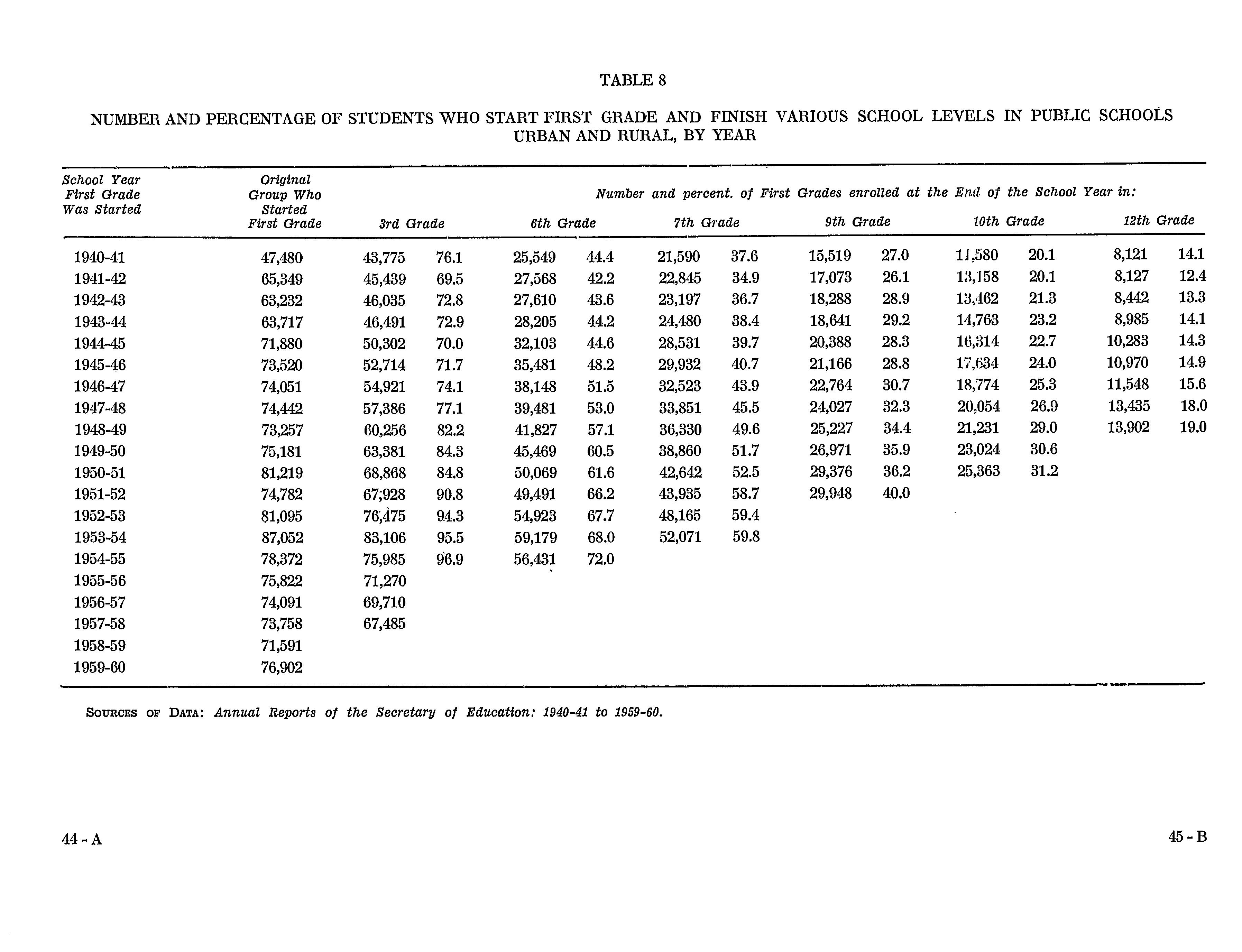
SOURCESOFDATA: AnnualReportsoftheSecretaryofEducation:1940-41to1959-60.

44.4percentfinishedsixthgradeand37.6continuedtoseventh, ora differenceof 6.8per centof drop-outsbetweenthe two grades.Forthe1953-54group,theproportionswere68.0and59.8 respectively,andthedifference8.2.Theselectivenessatthebeginningofthejuniorhighschoolincreasedinintensityfromone academicyeartothenext.Also,theproportionofpupilswho startedthislevelandleftbeforefinishingincreased.
Afterthecompletionofthejuniorhighschool,furtherselection continued, though to a lesser degree.Thechances for continuingtotheend of thesecondaryeducationwerefairly goodforthosewhohadreachedninthgrade.Butaswiththe junior highlevel, theproportion of thosewho, havingbegun seniorhigh,leftinthemiddle,increasedbetweenthe1940-41 and1948-49groups.
Applyingthesamekindofanalysistotheurbanandrural elementaryschools(theonlylevelforwhichthistypeof data wasavailable),wefindthatwhile96outofevery100children intheurbanschoolsreachedtheendoftheirelementaryschooling, only 58 out of 100 did so in the rural zones. The rate of withdrawalsamongstthelatterwasasgreatbetweenfirstand thirdgradesasitwasbetweenfifthandsixth.Itseemsthatit wasintheruralregionsthattheschoolsystemwasfacedwith the difficult problem of ensuring aminimal education to the rapidlyexpandingschoolpopulation.
This urban-rural dichotomyhad been perpetuatedby the existenceoftwotypesofschoolfacilitiesintheisland,onefor the"privileged"urbanites,andtheotherforthe"underprivileged"ruralites.Theruralschoolsgenerallylackedcertainminimumfacilities.Moreoftenthantheurban-locatedschools,"they lacklighting,watersupply,adequatesanitaryservices,andrecreationalplaces" 43 Therewasmuchtobedesiredintermsof rural"buildings, equipment,books, and teachingmaterials"'. Janitorialserviceswere usually non-existent and teacher and pupilalikewerecalledupontoperformthem.Atthebeginning of theschoolyear,aroutinesightattheofficeof theschool superintendent was the distribution of materials to the rural
43.RamónA.Cruz,"Elfuturodelaescuelapuertorriqueña:suplaniflcación",HatoRey,P.R.:DepartamentodeInstrucciónPública,1961,p.5.
44.JesúsMaurasPovertud,"Laescuelaelementalpuertorriqueña", HatoRey,P.R.:DepartamentodeInstrucción,1961,p.22.

teachersandamongstthefirsttobehandedoutwereabroom, cleaningrags,apailandsomesoap.
Notonlywerephysicalfacilitiesinaworseshapeinthe ruralschools,butalsotheteachingloadoftheteachersherewas greaterthanthatoftheurbanteachers.Theaveragenumber ofstudentsperteacherintheruralschoolswas61in1949-50, 61.3in1955-56,and53in1958-59.Intheurbanschoolsthefigures were57,58and52respectively ¢5. Nearlyallthemunicipalities (95percent)hadmorethan50studentstoateacherintherural areas;somehadasmanyas86.Addtothisthefactthatunder thedoubleenrolmentplan,whichwastheruleamongstthe elementaryschools,teachersusuallytaughtmorethanonegrade ofstudents.Theeducationalsurveyof1959showsthat54per centoftheelementaryruralteacherstaughttwoormoregrades, against11.7percentintheurbanzones.Intheruraljuniorhigh schools,8percentoftheteacherswereengagedinelementary teachingaspartoftheirteachingload 4s,
Underthedepartmentalizedsubjectcurriculumsuchas PuertoRicohas,teachingmeanseightsubjectareaspergrade andthecorrespondingnumberofelaboratedailylessonplans. Someelementaryschoolteachersinfacthavetomakefrom10to 16detaileddailyprogrammestosatisfysupervisorydemands,not tomentionthecorrectionandmarkingofpapers,andattendance atprofessionalandparent-teachermeetings.
Otherformsofbiasagainsttheruralareasandruralchildren existed.Theteachersweregenerallylessfullytrainedthanthose intheurbanzone;60percentofthoseteachingintheelementary schoolsin1942-43hadhadlessthantwoyearsofcollegetraining comparedto39percentamongsturbanteachers.In1958=59,the proportionofuntrainedteachersintheurbanareashadbeen reducedto7percent,whiletheruralproportionwasstillashigh as32.Moreover,amongsttheprovisionalteachersthosewithless trainingwereplacedinruralschools Infactaslongasthe selectionofteachersisregulatedinthepresentmanner,the
45.Forsourcesonstudentsperteacherinruraláreassee:Consejo SuperiordeEnseñanza,FacilidadeseducativasdelEstadoLibreAsociado dePuertoRico,p.217-238;andDivisiondeEstadísticas,Informesobrela matrículaymaestrosdesalóndeclasesalterminarelsextomesescolar: 1958-59,tables2and3oftheappendix.
46.ConsejoSuperiordeEnseñanza,Estudiodelsistemaeducativode PuertoRico, 9,"Losmaestros",p.61-62. 47.Id.,p.64.

discrimination against rural teachingwill persist.Positions at thebottomoftheregisterofeligibleswereusuallyassignedto ruralschoolsandwerenaturallyheld by thelessqualified 48. Ruralteacherswerenotonlylessacademicallyprepared,they werealsolessexperienced and receivedlesssupervision.The directsupervisiónofruralelementaryteachersisinthehands ofanassistantsuperintendent,whosupervises38teachersonthe averagecomparedtothe15undertheurbanelementaryschool principal 4s,
Ruralgradeofferingsweregenerallyattheelementarylevel, withahighconcentrationinthefirstthreegrades,"sinceagreat numberof ruralschoolsdonotofferstudentsthefacilitiesto finishtheelementaryschool" 50. Mostofthoseelementaryschools wereonthedoubleenrolmentplan,74.3•percentin1959-64comparedto44amongsttheurbanelementary.
Socialandhealthserviceswerealsofewerorlessaccessible totheruralchild.Vocationalcounsellingwaspracticallybeyond hisreach.Hislibraryfacilitieswerealsolessadequate.Hischances of getting government scholarships were limited; in 1954-55, 35percentofhiskindreceivedsuchboonsandin1958-59,this proportionwasreducedto28.1percent 51,
The apparent,systematic discrimination against the rural zonesforeducationalpurposeswasreflectedfirstofallinthe ruralchild'sreadingperformance,whichwasfoundtobegenerallylowerthanthatofhisurbancounterpart.Thisdisadvantage wasbornebytheruralchildrenallthroughtheirschoolingand wasmostpalpableinarithmeticalreasoning,readingcomprehensionofEnglishandSpanish,andotherlinguisticabilityperformances.It alsofollowsthat theproportion of schoolfailures amongst themwould begreater thantheirshareinthe total enrolment.Furthermore,thedisproportionaterepresentation of ruralstudentsamongsttheschoolfailurestendedtoincreaseover thetwenty-yearperiod.
Fromtheevidence•analyzedabove,wecandrawthefollowing
48. RAMÓN A. CRUZ, O. cit.,p.5.
49.Thissituationlededucationalofficialsthemselvestoconcludethat supervisionintheruraláreaswas"limited,sporadic,andlackinginefficiency".J.M. PovERxun, op.cit.,p.21.
50.Ibid.,p.20.
51.ConsejoSuperiordeEnseñanza,Estudiodelsistemaeducativode PuertoRico,Cap.11,"Losalumnos",p.99.

generalconclusions.Thegrowth of the educationalsystemin PuertoRicohadvaryingeffectsonthepublicandprivateschools. In spite of the increasing government budgetary allocations, publicschoolfacilitieshadnotkeptpacewiththerapidlyexpandingenrohnent.Thequalityofinstructionandofstudentperformancehaddeterioratedinthepublicschoolsbutimprovedinthe private.Thiswillbemoreamplydemonstratedinsubsequent chapters.Thedilemmaofpubliceducationisparticularlyreflected intherural-urbansituationattheelementarylevels.Hereinlies thekeytotheeducationaldifferentialoperatingintheisland. Itisatthoselevelsthattheselectionprocessbeginsandimpedes aconsiderablenumberofruralchildrennotonlyfromcontinuing tothesecondarylevelbutevenfromfinishingtheirelementary schooling.Limitedfacilitiesanddiscriminatorypracticesinfact hadhadanincreasinglynegativeeffectontheeducationaldevelopmentoftheruralchild.Itisuthereforedebatablewhether• thepresentgovernmentishonoringtheconstitutional,guarantee to"everyperson...therighttoaneducationgearedtowardsthe strengtheningofrespectforhumanrightsandthefundamental liberties" 52.
Inpurelyeconomicterms,unlesssomethingdrasticisdone toreversethesituationintheruralschools,theislandwillcontinuetobefloodedbyasuperfluityofmanpowerinadequately preparedtocarryouttheeconomicgoalssetbytheir"politicos". OntheproblemofpopulationgrowthinPuertoRico,education alsoseemstohaveadirectbearing.Inacountryinwhichthe officialencouragementofcontraceptivemethodshassofarproducedlittleresults,butwhereitcanbeshownthatwomenwith sixyearsormoreofschoolinghavelowerfertilityratesthan thosewithlessschooling,educationmayprovideamoreeffective checktopopulationgrowth.
Inhighereducation,theinfluenceof populationgrowthat thelowerschoollevels,thequalityofpubliceducationandthe ruraldiscriminationwasparticularlyfelt.Thisisthesubjectof detailedconsiderationinsubsequentchaptersandforthepresent weneedconcernourselvesonlywiththenatureoftheexpansion attheuniversitylevel.Duringthetwenty-yearperiodunderstudy, enrolmentattheuniversitylevelexpandedmorethanfourtimes; from6,308enrolleesin1940-41to25,878in1960-61.Basedonthe
52.ConstitucióndelEstadoLibreAsociadodePuertoRico,1952,ArticuloII,Section 5.

school-agepopulation,collegeattendancein1960-61represented 16percentoftheeligibleage-group,oranincreaseoffourtimes overthatoftheacademicyear1940-41.Itwillberecalledthat thehighschoolgraduatepopulationhadincreasedsixtimesover thesameperiod.Tomeetthisrapidlygrowingsecondaryoutput, theUniversityofPuertoRicohadexpandeditsfresmanintake fivetimes,althoughitsoverallexpansionhadbeenonlythree-fold. In1960-61,about43.5percentofdayhighschoolgraduateswere distributedamongstallthecollegesanduniversitiesintheisland, comparedto39.7in1950-51.Itisexpectedthatwiththerecent organization of a programme of juniorcollegescovering the wholeofPuertoRicotherewillbeadefiniteimprovementinthe accommodationofsecondarygraduates.Meanwhile,theproportionofintendingstudentsrejectedbythestateuniversityhadbeen increasing,andin1959-60amountedto54percentofallapplicants(5,417refusalsoutof10,021applications).However,college attendancebysexconfirmswhathasalreadybeenindicatedearlier inthischapter,namely,theequalizingtendencybetweenmales andfemalesinthepursuitofeducation.In1960-61,50.6percent ofuniversitystudentsweremalesand49.4percentfemales,or 17and15percentoftherespectiveage-groups.

TheUniversityofPuertoRicowascreatedbyanactofthe InsularLegislaturepassedonMarch12,1903,"toprovidetheinhabitants,assoonaspossible,withthemeansof acquiring a thoroughknowledgeofthevariousbranchesofliterature,science, and useful arts"i.Thelawfurtherspecified the departments whichshouldcompriseit,tobeorganized"assoonasthenecessaryallocationswereavailable" Z, andalsoprovidedforsuch others,"germanetoawell-equippeduniversity,astheboardof trusteesmayfromtimetotimebeabletoestablish" 3
Thefirstofthedepartmentstobeorganizedwasthenormal school,offeringatwo-yeartrainingcourseforteachers.Thiswas followedbytheAgriculturalDepartmentin1904,theLiberalArts Collegein1910,LawandPharmacyin1913,TropicalMedicine in1924,BusinessAdministrationin1926, andSpanishStudies in1927.
Fromtheirinceptionto1940,these academicdepartments underwentfundamentaladministrativeandcurriculumchanges whichweshalldescribehere,althoughonlybriefly,bywayof introducingtheperiodunderstudy.
ThenormalschoolwastransformedintoaCollegeofEducation,offeringabachelor'sdegreeinadditiontothetwo-yearnormalcertificate.IntimeotherbranchesbecameattachedtotheCollege,suchastheSchoolofSocialWork,theInstituteofPsycho-
1.AnnualReportoftheCommissioner of Education:1903,p.251. 2.Ibid.,252. 3.Ibid.
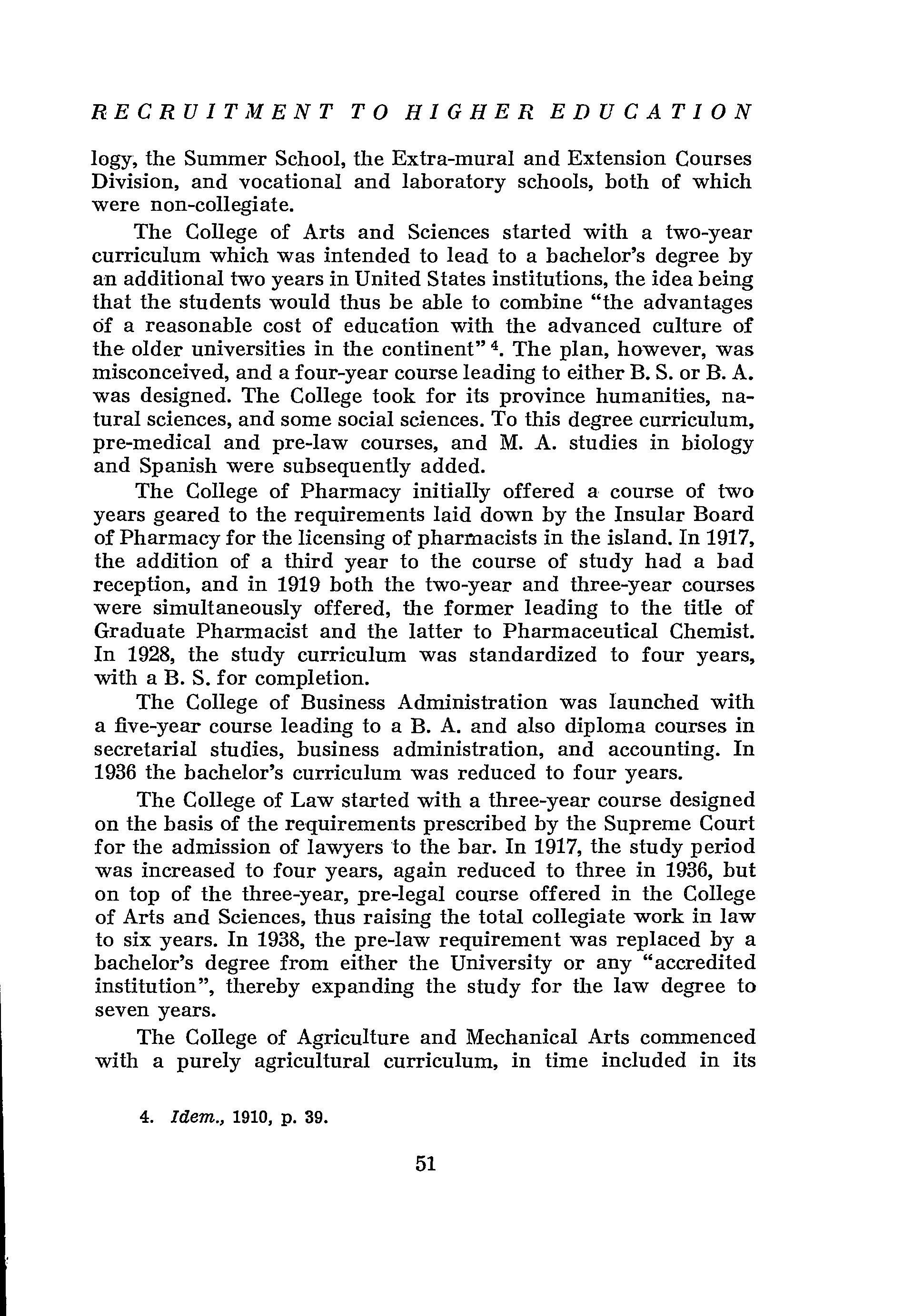
logy,theSummerSchool,theExtra-muralandExtensionCourses Division,andvocationalandlaboratoryschools,bothofwhich werenon-collegiate.
TheCollegeofArtsandSciencesstartedwithatwo-year curriculumwhichwasintendedtoleadtoabachelor'sdegreeby anadditionaltwoyearsinUnitedStatesinstitutions,theideabeing thatthestudentswouldthusbeabletocombine"theadvantages ofareasonablecostofeducationwiththeadvancedcultureof theolderuniversitiesinthecontinent" 4 Theplan,however,was misconceived,andafour-yearcourseleadingtoeitherB.S.orB.A. wasdesigned.TheCollegetookforitsprovincehumanities,naturalsciences,andsomesocialsciences.Tothisdegreecurriculum, pre-medicalandpre-lawcourses,andM.A.studiesinbiology andSpanishweresubsequentlyadded.
TheCollegeofPharmacyinitiallyofferedacourseoftwo yearsgearedtotherequirementslaiddownbytheInsularBoard ofPharmacyforthelicensingofpharmacistsintheisland.In1917, theadditionofathirdyeartothecourseofstudyhadabad reception,andin1919boththetwo-yearandthree-yearcourses weresimultaneouslyoffered,theformerleadingtothetitleof GraduatePharmacistandthelattertoPharmaceuticalChemist. In1928,thestudycurriculumwasstandardizedtofouryears, withaB.S.forcompletion.
TheCollegeofBusinessAdministrationwaslaunchedwith afive-yearcourseleadingtoaB.A.andalsodiplomacoursesin secretarialstudies,businessadministration,andaccounting.In 1936thebachelor'scurriculumwasreducedtofouryears.
TheCollegeofLawstartedwithathree-yearcoursedesigned onthebasisoftherequirementsprescribedbytheSupremeCourt fortheadmissionoflawyerstothebar.In1917,thestudyperiod wasincreasedtofouryears,againreducedtothreein1936,but ontopofthethree-year,pre-legalcourseofferedintheCollege ofArtsandSciences,thusraisingthetotalcollegiateworkinlaw tosixyears.In1938,thepre-lawrequirementwasreplacedbya bachelor'sdegreefromeithertheUniversityorany"accredited institution",therebyexpandingthestudyforthelawdegreeto sevenyears.
TheCollegeofAgricultureandMechanicalArtscommenced withapurelyagriculturalcurriculum,intimeincludedinits
4.Idem.,1910,p.39.

offerings,besidesthetwo-yeardiplomacoursesinagricultureand polytechnicscience,degreestudiesinagriculture,sugarchemistry, engineering,andgeneralscience.TheCollegewasoriginallyorganizedinthecampusatRioPiedras,butin1911,itwasmovedto Mayagüez,inthewesternpartoftheisland.
Otherpartsof theUniversityinthepre-1940periodwere theAgriculturalExperimentStation,devotedtostudyandresearch inconnectionwiththesugarindustry;theAgriculturalExtension Service,forfosteringcooperativefarmwork;andtheInstituteof TropicalAgriculture.
ItwillbenotedthatmuchofthetrainingofferedintheUniversityintheinitialstagesofdevelopmentofitsvariousdepartmentswasofanon-collegiatesort.Thiswasinaccordwiththe factthatapplicantswithonlyeightyearsofpreviousschooling wereaccepted.Withtheexpansionofthevariouscurricula,entrancerequirementswereraisedandin1919,ahighschooldiplomashowingatleast12yearsofschoolingwasprescribedfor allintendinguniversitystudents.
Ingeneral,therefore,thetrendintheUniversityhadbeen toeliminatethesub-collegiateformsofinstruction.Allbutthree ofthedepartmentsmentionedintheUniversityLawof1903had beenestablished,e.g.,medicine,architecture,andahospital.
BehindtheadministrativeandacademicchangesintheUniversityofPuertoRicopriortotheperiodselectedforthisstudy, wenoticetwolevelsofinfluence,theeffectsofwhichhavebeen felttothepresentday.Oneisthe"generaleducation"ideawhich wouldguaranteeaminimumofculturalpreparationcommonto allgraduatesoftheUniversity.Theotheristheneedfeltfora freshexaminationandstatementoftheUniversity'seducativerole. Theseweremanifestedintwoseparateinstances.Thefirstwas in1926,followingthecreationoftheofficeof"deanofinstruction", whenitwasdecreedthathenceforthallfirstyearstudentsin theCollegeofLiberalArtsandEducationshouldtakegeneral coursesincontemporarycivilization,integratedscience,Spanish, English,musicandartappreciation.Adecadeafterwards,Dr.Juan B.Soto,ChancelloroftheUniversityfrom1936to1941,enunciatedhisobjectivesfortheUniversitywhichinphilosophicalterms identifieditsroleinauniversal,humanisticcontext.Incommon withotherinstitutionsofhigherlearning,itssightsmustbedirectedto"theeducatedman"withanunderstandingofhisplace insocietybothascitizenandman.Itshouldcultivatethestatesman, the legislator, the judge onwhom"public prosperity

andindividualhappinessaresomuchtodepend" 5. Itshouldbe "inapositiontoassistthegovernmentoftheislandinstudying andsolvingthedifferentproblemswhichitiscalleduponto confront"s.Thusbesidessubjectsofapurelyculturalnature,the Universityshouldoffercoursesinpoliticalandsocialscience.
Theyear1946wasmarkedbytheadventtopowerofthe PopularDemocraticParty,committedtoexpandeducationalfacilitiesatalllevelsandtoprovideallsegmentsofthepopulation, especiallythe"lessprivileged",withequalopportunitiesforobtainingeducation.TheproductofthispolicywasanewUniversityLaw,commonlyknownastheReformLawof1942.Ithassince remainedthecharterofthestateuniversity,unalteredthrough theyears.
Themostsignificantchangeinstitutedunderthelawbythe new Chancellorwasthe abolition of the Collegeof Arts and Sciencesandthecreationofthethreecollegesof Humanities, NaturalSciences,andSocialSciences.TheDepartmentofHispanic 'Studies was placed under Humanities, along with the newly createdDivisionofHistoricalResearch,artgalleryandmuseum. IntheCollegeofNaturalSciences,thecurriculaincluded the bachelor's,thepreparatorycoursesinmedicineanddentistryand meteorologicalandnuclearstudies.TheCollegeofSocialSciences introducedtheB.A.specializinginthisfieldandthegraduate certificatesinsocialworkandpublicadministration.In1954,its facultywasauthorizedtogranttheM.A.insocialwork and publicadministration.Otherbranchesof thecollegewerethe InstitutesofLaborRelationsandCooperativismandtheSocial ScienceResearchCenter.
Aspartofthe"liberalarts"reform,thethreenewlycreated collegesshouldoffertheprescribedgeneraleducationcourses. However,in1946,thisfunctionwastakenoverbyanautonomous Division of General Studiesunderitsown dean.In1956, the divisionwasgivenfacultystatusandstartedofferingtheB.A. IntheCollegeofBusinessAdministration,thediplomaswere discontinuedaltogether,exceptthatinsecretarialstudies.Italso losttheInstituteofEconomicstotheCollegeofSocialSciences anditseveningsessionstotheExtensionDivision.
TheCollegeof Education acquiredtheshort-livedEnglish
5.AnnualReportoftheChancellor of theUniversityofPuertoRico: 1937-38,p.7-10.
6.Ibirl.

Institute,inchargeofresearchintotheteachingofthelanguage toSpanishspeakers,butlosttheInstituteofPsychologyandthe SchoolofSocialWorktotheCollegeofSocialSciencesandits vocationalschooltotheInsularDepartmentofEducation.The curriculumofferingswerereplenishedbyintroducingthegraduate diplomaineducationaladministration,supervisionandguidance, whileforsometimethecollegeawardedcertificatesinindustrial artsandnativehandicraftsandtothisdaystillgivesthetwo-year certificateinEnglishteaching.
TheB.S.inPharmacynowrequiredfiveinsteadoffouryears toaccommodatethegeneraleducationprogramme.Thesame thinghappenedtotheengineeringcoursesintheSchoolofAgricultureandforthesamereason.Weneednotdwellontheother departmentsoftheUniversity,asonlythosementionedinthe aboveparagraphs,exceptAgriculture,havebeenchosenassubject ofthepresentstudy.
Inthenewadministrativeset-upwenoticeahighlyspecialized divisionofsubjects.Thus,mathematics,history,philosophyand artwhichnormallycomeunderthesameroofweredistributed underseparatecolleges.Itwasalsoinherentinthenewstructure ifnotimmediatelyapparent,thatofferingsinthesamesubject wouldconflictbetweenthecollegesontheonehandandthe generalstudiesprogrammeontheother.Lately,theisolationof thefacultiesfromoneanotherhasbeenstronglyfeltandwidely deplored,alongwiththeconsequentlackofcoordinationbetween curriculumprogrammes.Thepatternofdevelopment,however, hadbeentruetoform.Ithadfollowedthelinesfirstlaiddown in1926and1936.Theunexpectedramificationsweretooccurin thevaluationandscalingoftheso-called"ideationalgoals"of theUniversity.
TheCharterof1942setthefollowingobjectivesfortheinstitution:
1.Toimparthigherlearning
2.Tomakescientificresearchinthevariousfieldoflearning
3.TostudythefundamentalproblemsofPuertoRico
4.Toextendtothepeoplethebenefitsofculture
5.Topreparepublicservants
6.Tostimulateanddevelopadeepfeelingofunityinthe PuertoRicanpeople.
7.UniversidaddePuertoRico, Leyuniversitariayreglamentos (ediciónrevisada), 1953,p.6.

Inhisinauguraladdressin1942,ChancellorBenitezreaffirmedthedutiesoftheUniversitytothepeoplewhich"support" it.ReiteratingthewordsoftheCharter,hedeclaredthat"inall itsactivities,theUniversityshouldstimulateanddevelopadeep feelingofunityamongourpeople".Theseactivitieswouldinclude "takingmusic,songs,paintings,books,theater,dances,children's games,andpoetrythroughtheroads,publicsquares,townsand ruralsections"$.Ontheacademiclevel,hewouldcreateextensioncourses"inthehomes",havewritingsofprofessorsand graduatespublishedanddisseminated,andtheworksof"illustrious"PuertoRicanandAmericanthinkersprintedinpopular editions.HewouldalsostrivetofostertheestablishmentofmunicipallibrariesbyUniversitydonationintheformoffreebooks.
ChancellorBenitezfurtherstressedtheneedfortheUniversitytoacknowledgeitselfaspartofthePuertoRicanreality, andtousethisnationalrealityasthestartingpointwhenceto examinethecomplexofPuertoRicanculture,itslanguage,history,economy,politicsandpersonalityofindividuals.
Theseutteranceswereindirectagreementwiththeobjectives laiddownbytheUniversity'sCharterof1942.Theyinfactembodiedthepoliticalidealofanationaluniversityforanautochthonousbodyofpeople.Thesignificanceoftheinauguralspeech, however,laynotinthespeaker'saccordwiththeprescribedpurposesoftheUniversity.Whileemphasizingthenationalisticcharacteroftheinstitution,hestruckadecidedlysupra-nationalist .overtone."IhaveassumedthetremendousresponsibilityofdirectingtheUniversity",hesays,"becauseIhaveadeepfaithin theseyouthsandbecauseIbelieveinthepotentialityofthisorganismtoservehighlythelife,theculture,andthespiritofman inPuertoRico.Ihavesaidtoserve`maninPuertoRico'andnot `thePuertoRicanman',inordertounderlinefromthebeginning theessentialuniversalityofthehumanbeingandtheessential universalityofourtradition" 9 Hewentontosay,"PuertoRico isinthelastinstancetheplacewhere,bychance,wehavehadthe opportunitytoachieveinourlivestheinherentdignityofthe humannature...Whenreferringheretoman...Idonotmean thatparticularman,ormaninastateofnature,butman...asa
8.JaimeBenítez,"Lareformauniversitaria",TheUniversityof PuertoRicoBulletin,SeriesXIII,N.°3,March,1943,p.14. 9,.Ibis,p.3.

seedofpotentialperfection,manastheideaofdivinity"10 This positionofatranscendent,universalorientationfortheUniversitysetagainstaparticularized,nationalonewastohaveprofoundrepercussionsintheisland.
In1945,inhisreporttotheSuperiorEducationalCouncil, theChancellorleftoutfromthecustomaryrestatementofgoals hispropositionregardingthesupra-nationalroleoftheUniversity.Alsomissingwasthepreviousreferencetothestimulation anddevelopmentofnationalunityamongthePuertoRicanpeople. Indeed,thelatterwasnotmentionedagaininthenexttwodecades.
ItshouldbenotedthattheChancellor'sreportof1945and subsequentoneshadtobedirectedtotheSuperiorEducational Council,thegoverningboardestablishedbylawtopresideover the Universityandwhich represented the official government policyineducationalmatters.ItmaybeinferredthatanadministrationwithaPopularDemocraticmajoritymightnothave beendisposedtosanctionapropositionwhichwouldbeinterpretedascontrarytotheobjectiveaimfora"PuertoRicanidentity", aPartycommitment.Bethatasitmay,theseedsofanideological conflicthadalreadybeensown.Thenationalistand"universalist" approachestouniversityeducationweredividingopinioninside the academiccommunity andwould soon reach out into the spheresoflayinfluencetoobtaintheirrespectivehearing.The Chancellor himself, by virtue of his position in the highest institutionoflearningintheisland,wastheacceptedleaderof theuniversalistposition.Althoughherefusedformanyyearsto verbalizehisstandonthegrowingissue,hissilencewastakenby manyasconsentbydefaulttotheuniversalistideals.Hisrepeated refusaltocreatea"basiccourseinPuertoRicancultureand society"confirmed his critics' suspicion.Thus the lines were drawnbetweenPuertoRicananduniversalvaluesasconflicting standardsintheorientationofuniversityeducationinPuertoRico.
In1954,theissuereachedtheopenwhenChancellorBenitéz issuedhisfirstofficialstatementinmanyyearsonthefunctions oftheUniversityofwhichhewasthehead."Likeallcentersof higherlearning",hedeclared,"ourshasasitsdutytoservethe superiorvaluesof thehumanspiritatthesametime thatit attendstothemoreimmediatedemandsofthecommunity.Ire-
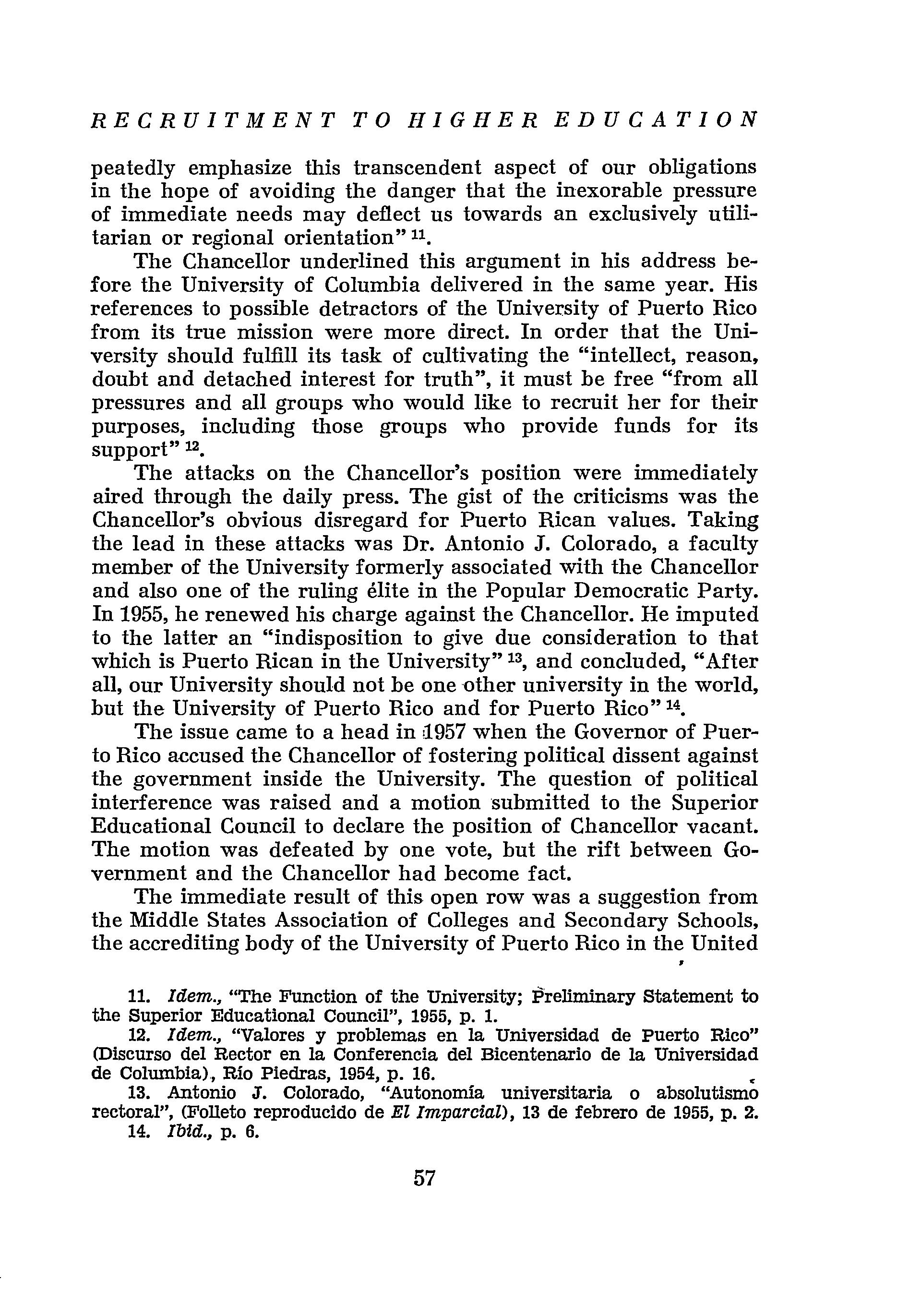
peatedlyemphasizethistranscendentaspectof ourobligations inthehopeofavoidingthedangerthattheinexorablepressure ofimmediateneedsmaydeflectustowardsanexclusivelyutilitarianorregionalorientation"11.
TheChancellorunderlinedthisargumentinhisaddressbeforetheUniversityofColumbiadeliveredinthesameyear.His referencestopossibledetractorsoftheUniversityofPuertoRico fromitstruemissionweremoredirect.InorderthattheUniversityshouldfulfillitstaskofcultivatingthe"intellect,reason, doubtanddetachedinterestfortruth",itmustbefree"fromall pressuresandallgroupswhowouldliketorecruitherfortheir purposes, including those groups who provide funds for its support" 12
TheattacksontheChancellor'spositionwereimmediately airedthroughthedailypress.Thegistofthecriticismswasthe Chancellor'sobviousdisregardforPuertoRicanvalues.Taking theleadintheseattackswasDr.AntonioJ.Colorado,afaculty memberoftheUniversityformerlyassociatedwiththeChancellor andalsooneoftherulingéliteinthePopularDemocraticParty. In1955,herenewedhischargeagainsttheChancellor.Heimputed tothelatteran"indispositiontogivedueconsiderationtothat whichisPuertoRicanintheUniversity"13, andconcluded,"After all,ourUniversityshouldnotbeoneotheruniversityintheworld, buttheUniversityofPuertoRicoandforPuertoRico"14.
Theissuecametoaheadin:1957whentheGovernorofPuertoRicoaccusedtheChancelloroffosteringpoliticaldissentagainst thegovernmentinsidetheUniversity.Thequestionofpolitical interferencewasraisedandamotionsubmittedtotheSuperior EducationalCounciltodeclarethepositionofChancellorvacant. Themotionwasdefeatedbyonevote,buttheriftbetweenGovernmentandtheChancellorhadbecomefact.
Theimmediateresultofthisopenrowwasasuggestionfrom theMiddleStatesAssociationofCollegesandSecondarySchools, theaccreditingbodyoftheUniversityofPuertoRicointheUnited
11.Idem.,"TheFunctionoftheUniversity;PreliminaryStatementto theSuperiorEducationalCouncil",1955,P.1.
12.Idem.,"ValoresyproblemasenlaUniversidaddePuertoRico" (DiscursodelRectorenlaConferenciadelBicentenariodelaUniversidad deColumbia),RíoPiedras,1954,p.16.
13.AntonioJ.Colorado,"Autonomíauniversitariaoabsolutismo rectoral",(FolletoreproducidodeElImparcial),13defebrerode1955,p.2. 14.Ibid.,p.6.

States,tosendrepresentativestomakefirst-handobservationson thematter.Thesuggestionwasrebuffed,butin1959,theAssociation'sCommissiononInstitutionsofHigherEducationreopened thequestionandsentapartytoPuertoRicotoinvestigate theUniversity'seducationaleffectiveness.Thefindingswere favourabletotheUniversity,andinreaffirmingitsconfidencein theinstitution,theCommissionwasbyinferencebackingthe Chancellor.Furthermore,theCommissionrequiredannualreports tobemadetoitcontinuallyupto1963.
TheinterventionoftheAmericanCommission,andfearthat theaccreditedstatusoftheUniversitymightbejeopardized, coupledwiththegrowingpro-Chancellorsentimentworkedup successfullybytheantigovernmentpress,tooktheedgeoffthe issue.ThequestionhaslatelytakenanewturnwiththeorganizationoftheAssociationofUniversityProfessorswhichappealedtotheInsularLegislatureforavirtualoverhaulingof theCharterof1942.ThisgroupwithintheUniversityisgathering strength,itsfounders,significantlyenough,beingstaunchadvocatesofastrongcurriculuminthevariousaspectsofPuerto Ricancultureandsociety.
AnotherimportantdevelopmentintheUniversitysincethe Actof1942cameintoforcewastheemergenceofthe"general education"programme.Thisaspectofthereorganizationunder ChancellorBeniteziscloselyconnectedwiththematterjust described,butistreatedhereseparatelytoenableustounderstand morefullytheacademicstructureunderwhichstudentshadbeen recruitedintotheUniversity.Thetwomajorpurposesoftheprogrammewereexpressly:"tomakethestudentawareoftheworld inwhichhelives",andtoprovidehimwith"asurveyofthe majorfieldsofknowledge"whichinturn"mayservehimalso asasurveyofprofessionalandvocationalopportunities"15. The vocationalaspectofthisorientationhadsincedisappearedfrom theprogramme,withtheavocationallatelymakingaheadway. Jn1957,theChancellorelaboratedtheneedforaliberalandgeneraleducationinthesameuniversalistveinhehadearliershown inhisdefinitionoftheUniversity'srole.
Thegeneraleducationprogrammestartedwithsixofthe major.fieldsofknowledge,e.g.,humanities,social,biologicaland
' 15.SpecialReportSubmittedtotheSuperiorEducationalCouncilat fitsJanuary1945MeetingbytheChancelloroftheUniversityofPuerto Rico,(fromSept.1942toJan.1945),p.8.

physicalsciences,EnglishandSpanish.StudentsinPharmacy andthoseenrolledinthetwo-yearcoursesinBusinessAdministrationandEducationwereatfirstexemptedfromthisprogramme, butintimetheytoohadtosubmittoitwiththeexceptionof thetwo-yearenrolleesinBusiness.Meanwhiletheprogramme itselfhadexpandedtoincludeasecondyearinhumanities, SpanishandEnglish,plusabasiccourseinmathematics.Recently,aproposalhadbeenmadetoextendthesocialsciences alsointothesecondyear.ThusineffectallgraduatesoftheUniversitywillhavehadatleasttwofullyearsofthegeneraleducationprogramme.
Opinionontheprogrammehadbeenverymuchdivided,the divergenceoccurringnotononebutseveralpoints.First,there werethosewhofavouredthepresentarrangement,ortheconcentrationofthegeneraleducationcoursesinthefirsttwoyears ofcollegiatework,asagainstthosewhowouldspreadthemover thefouryearsofthebachelor'sprogramme.Thefirstgroup arguedthatstudentsshouldhaveabroadculturalbackground beforeenteringthenarrowlinesofspecialization.Theother group,asrepresentedbythecollegesofEducationandBusiness Administration,basedtheirargumentsinoneoftheoriginalpropositionsforthecreationoftheprogrammeitself,andthatis, toenablethestudenttoexplorethepossibilitiesforhisfuture. Thusitwassuggestedinthosetwocollegesthatthestudentwould dowelltobeintroducedtohisfieldsofinterestearlyincollege, asthiswouldenablehimeithertoexploit"whateverproficiency inhischosenlineofspecializationhebroughtwithhimfrom highschool",or"toevaluatehisaptitudeforsuchspecialization" 16. Thislineofreasoning,however,wastoloseteeth,since the"raisond'etre"ofthegeneralstudiesprogrammeitselfhad becomeavowedlypurelycultural.
Theprogrammehadalsobeenscoredontheappropriateness andrelevanceofitscoursestotherequirementsofthedifferent colleges.In1949,theDirectoroftheDepartmentofBusiness EnglishsuggestedthatallstudentsgoingintoBusinessAdministrationbeexcusedfromtheBasicCourseinEnglishandshould takeinsteadoneingrammar,whichwouldbe"moreeffective thanthebasiccourseasapreparationforthecoursesinBusiness
16.UniversityofPuertoRico,EvaluationReportfortheCommission onInstitutions of HigherEducationoftheMiddleStatesAssociationof CollegesandSecondarySchools,RioPiedras,1954,p.24,29.

English"17. ThissuggestionwasrejectedbytheDirectorofthe BasicCourseinEnglishwhofelt thatthesubjectsofferedin the General Studies"should fill the immediate needs of the studentsandshouldnotbeusedasapreparationforanyspecific courseorcourses"18. In1952,theDirectorof theHistoryDepartmentintheCollegeofHumanitiescomplainedthatthesecond yearbasiccourseinhumanitiesduplicatedcertainofferingsin theCollege.Similarcomplaintsoftheinadequacyofthegeneral educationcourseofferingswerelodgedbytheCollegeofNatural Sciencesinthreesuccessiveyears,1953,1954and1955.
Attemptsonthepartofthecollegestogetcoursesinthe GeneralStudiescurriculumeitherreplaced,modifiedorabolished hadprovedmostlyunsuccessful.Theythusproceededtoopen what were to them the proper introductory courses in their respective disciplines. The outcome had been described by FrankH.Bowles,visitingconsultanttotheUniversity,inthe followingterms:
"Oncethestudentleavesgeneralstudiesheentersthe differentcollegesandisheldinavicewhence,savefor minorandinconsequentialexceptions,hecannotescape. Eachcollegeseemstofeelthatsincegeneraleducationhas supposedlytakenplacealready,thestudentneednotconcernhimselfwithanyintellectualproblemsoutsideofhis speciality.Ontheotherhand,thecollegesofHumanities, NaturalSciences,andSocialSciencesassumethatatleast intheirownparticularfieldwhatevertraininghasgone oningeneralstudiesisineffectualandtheyproceedunconcernedlytoputthemthroughtheirownintroductory courses.Theendresultisthatthestudentisintroduced twicetothesamesubjects,andconsequentlythereisan appreciableduplicationofeducationaleffort"19,
Letusgointothebasicfactsofthesituationbywayofamplifyingthispartofourdiscussion.Thebachelor'sdegreeatthe
17. InformeanualdeZaFacultaddeEstudiosGenerales,1949-50,'p.22.
18. Ibid.
19.FnxxH.BOWLEs,PreliminaryreporttotheSuperiorEducational CouncilofPuertoRicoandtheChancelloroftheUniversityofPuertoRico relativetothedevelopmentofagraduateprogramattheUniversityof PuertoRico.Río Piedras, 1954,p.38.

UniversityofPuertoRicorequiresthecompletionof130hour creditsspreadoverfouryearsofstudy.Outofthesefouryears, thefirsttwoarealmostentirelydevotedtotherequirementsof generaleducation,oratotalof60hourcredits;thethirdyear totheintroductorycoursesprescribedinthefaculty;and the fourthtothefieldofspecialization.Whetherastudentcanbeadequatelytrainedinhisspecialinterestinoneyearisofcourse debatable.Somefacultieshavetriedtogetroundthisproblemof adequatespecializationbyincreasingthetimerequirementfor completingthebachelor'sdegree.Wehave noted thecaseof PharmacyandEngineering.BusinessAdministration,ontheother hand,hadbeenunabletoavailitselfofthisresource,andhad beenobligedofnecessitytoreduceitsownprofessionalcourse offerings,eitherbycombiningexistingonesoreliminatingthem altogether,and to cut down to an almostnegligiblelevelthe numberof electivesubjects.NaturalScienceshadnotonlyreducedthenumberofelectivesbuthadtakentoprescribingthem, thestudentbeingadvisedastotheelectivestotake,whichmore often than notwerecollateralsubjectsin hischosenfield of study.Thecollege,moreover,increasedthenumberofhoursof laboratorywork.
Itmaybequeriedinthefirstplacewhethertheincreasesin generaleducationcourseswerenotinfactthesubstitutingofone kindofspecializationforanother,inwhichcasetheprogramme itselfwasself-defeating.Secondly,hadtheUniversitybeengiving thepropertraininginprofessedfieldsofspecializationandwere itsdegreesvalidcredentialsofsuchspecialization,—aguarantee ofproficiencyinagivenareaorofadequateequipmentfora job?Thisisasuggestedsubjectforfurtherinvestigationasno follow-upstudyoftheUniversitygraduateshasbeenmade.
OtherspecificobjectivesoftheUniversityofPuertoRicoas prescribedbytheActof1942weretomakescientificresearchin thevariousfieldsoflearningandtostudythefundamentalproblemsoftheisland.Toascertaintheresultsoftheeffortssofar madealongtheselines,weatfirstsuggestedacomparisonbetween thenumberofpublicationsinagivenyearwiththesizeofthe facultyinthewholeUniversity.Thismethodofinquiry,however, hadtobeabandoned,asitwasimpossiblefromtheavailable listsandreportstoobtainprecisedata,asregards,forexample, the original date of publication and the nature of thework, whetherbook,pamphlet,articleorreview.Asanalternativewe havegoneintothereportsoftheChancellor,deans,anddepart-

mentalheads,fromwhichwehavetriedtomakeanover=alli comparisonofresearchactivitiesinthedifferentfieldsorcolleges andtoascertainthecausesofdisparity,thedifficultiesandfacilitiesofresearchwithintheUniversity.
Generallyspeaking,groupresearchhadbeenwidespreadin theUniversity.Thehighestconcentration,however,couldbe foundundertheAgriculturalExperimentStation,NaturalSciences,andMedicine.WorkintheSocialSciences,althoughsubstantial,stillhadbeenfarshortofthatdoneintheabove-mentioned fields.InHumanities,"inspiteofanactivefaculty",theoutput hadbeenmuchmorelimited.BusinessAdministration,whilerepresenting"acrucialproblemarea"inthePuertoRicansociety, hadbeenparticularlybarren.Education,comparedwiththe othercolleges,hadalsobeenlowonresearchactivity.Theofficial surveysfurthershowedthatthemajoremphasishadbeenin appliedresearch.
Themostsignificantfactnoticed,however,wasthenegligible amountofresearchdoneontheindividuallevel,amongstthe academicstaff.Itisevidentthatresearchhadnotbeenapopular activityamongthefacultymembers,undertakeninconjunction withteaching.Ithadbeenrathercenteredinseparateunits devotedentirelytoresearchwithnoteachingfunctions.Anexceptiontothis,wastheteacherconductinganinquiryonhisown initiative,eitherathisownexpenseorwithfinancialassistance fromanoutsidesource.Butthislatterarrangementisminimal.
UnderDr.Chardon,ChancelloroftheUniversityfrom1931 to1936,attemptswere.apparentlymadetostimulatethefaculty todoresearch,buttheseattemptsfailed.Dr.Osuna,aformer' deanoftheCollegeofEducation,inappraisingtheprogramme' ofresearchforthefacultyunderthisadministration,ascribed thedifficultiesandobstructionstotheheavyteachingload,lack oftrainingforscientificinquiry,andlimitedtimeforsustained• research20In1942-45,ChancellorBenitezmetwiththesamepersonalobstaclestoresearch.In1956heconfirmedthesebysaying that"theheavydémandsontheteachers'timebecauseofextra workloadsorextra-universitywork"21hadoperatedconjointly withotherfactorstoreduceworkinresearch.
20.JUANJOSÉOSUNA,AHistoryofEducationinPuertoRico(RíoPiedras,EditorialdelaUniversidaddePuertoRico,1949),p.541.
21.AnnualReportoftheChancellortotheSuperiorEducational Council:1957,p.47.
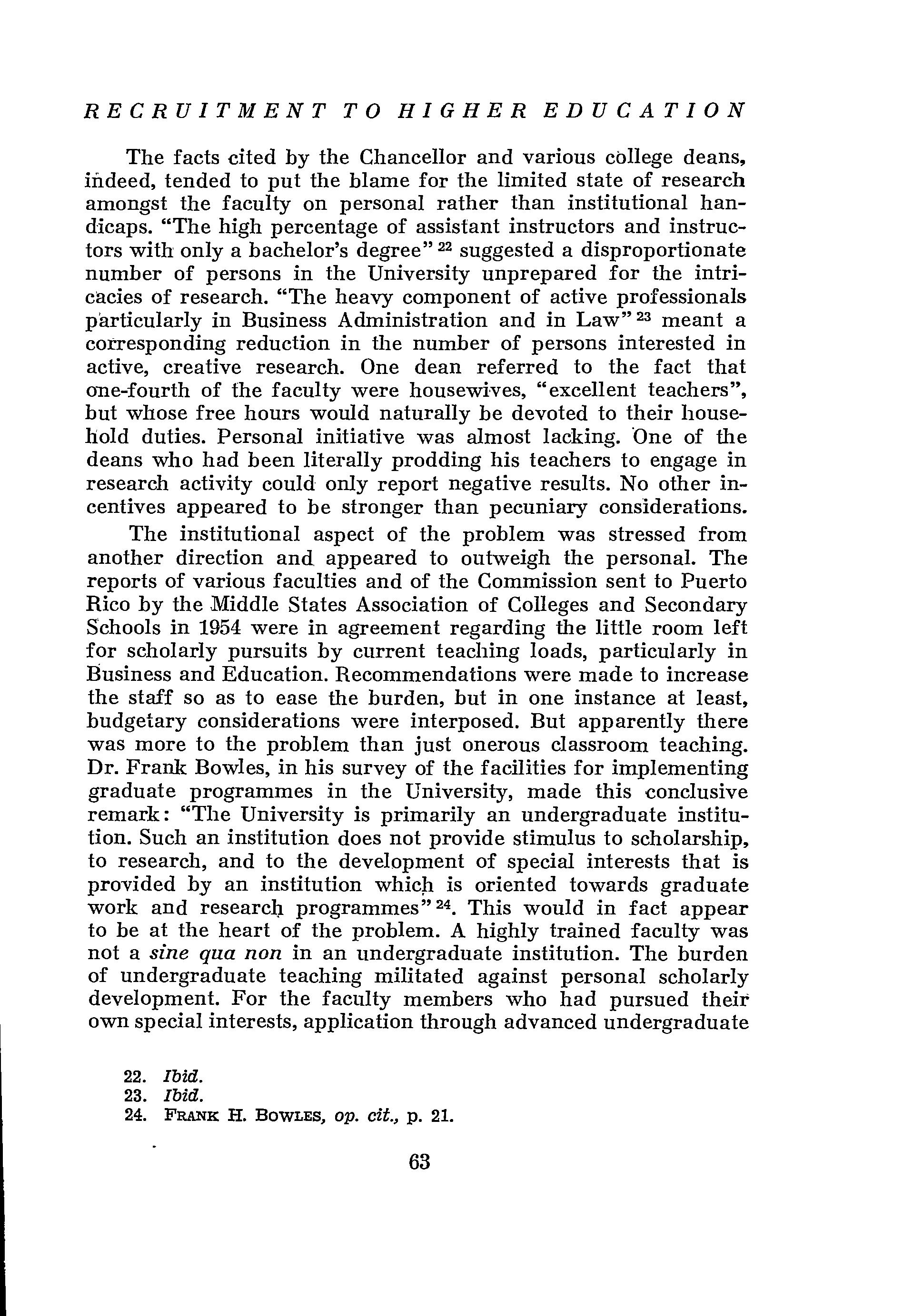
ThefactscitedbytheChancellorandvariouscollegedeans, iñdeed,tendedtoputtheblameforthelimitedstateofresearch amongstthefacultyonpersonalratherthaninstitutionalhandicaps."Thehighpercentageofassistantinstructorsandinstructorswithonlyabachelor'sdegree" 22 suggestedadisproportionate numberofpersonsintheUniversityunpreparedfortheintricaciesofresearch."Theheavycomponentofactiveprofessionals particularlyinBusinessAdministrationandinLaw" 23 meanta correspondingreductioninthenumberofpersonsinterestedin active,creativeresearch.Onedeanreferredtothefactthat one-fourthofthefacultywerehousewives,"excellentteachers", butwhosefreehourswouldnaturallybedevotedtotheirhouseholdduties.Personalinitiativewasalmostlacking.Oneofthe deanswhohadbeenliterallyproddinghisteacherstoengagein researchactivitycouldonlyreportnegativeresults.Nootherincentivesappearedtobestrongerthanpecuniaryconsiderations.
Theinstitutionalaspectoftheproblemwasstressedfrom anotherdirectionandappearedtooutweighthepersonal.The reportsofvariousfacultiesandoftheCommissionsenttoPuerto RicobytheMiddleStatesAssociationofCollegesandSecondary Schoolsin1954wereinagreementregardingthelittleroomleft forscholarlypursuitsbycurrentteachingloads,particularlyin BusinessandEducation.Recommendationsweremadetoincrease thestaffsoastoeasetheburden,butinoneinstanceatleast, budgetaryconsiderationswereinterposed.Butapparentlythere wasmoretotheproblemthanjustonerousclassroomteaching. Dr.FrankBowles,inhissurveyofthefacilitiesforimplementing graduateprogrammesintheUniversity,madethisconclusive remark:"TheUniversityisprimarilyanundergraduateinstitution.Suchaninstitutiondoesnotprovidestimulustoscholarship, toresearch,andtothedevelopmentofspecialintereststhatis providedbyaninstitutionwhichisorientedtowardsgraduate workandresearchprogrammes" 24 Thiswouldinfactappear tobeattheheartoftheproblem.Ahighlytrainedfacultywas notasinequanoninanundergraduateinstitution.Theburden ofundergraduateteachingmilitatedagainstpersonalscholarly development.Forthefacultymemberswhohadpursuedtheir ownspecialinterests,applicationthroughadvancedundergraduate
22.Ibid.
23.Ibid.
24.FxnxxH. BowLEs, op.cit.,p.21.

courseswereprecludedbytheexistingorganizationofinstruction. Finally,theUniversitylibrarywasorganizedandoperated to facilitateundergraduatebutnotgraduatework.
Itisdifficulttosaytowhatextentthe"undergraduate"characteroftheUniversitymaybeusedtoexplainthelackof"academicatmosphere"whichforeignvisitors,equippedwiththeir ownyardstick,werewonttolookforintheinstitution.Inthe past year, two of them had levelled serious critisms against segmentsoftheteachingstaff:"lackofqualityinstruction,low morale,lowlevelofscholarship,assenceofareasonablychallenging intellectual environment", etc. 25. It those segments representedthegeneralityofthefaculty,thenthehigherpurposesfor whichtheUniversitystoodwerenotbeingfulfilled.Aswehave said,itwasnotpossibletoobtaindataonthequantityandquality ofcreative,independentstudiessofarundertakenbythefaculty oftheUniversity.Forourpurposes quality"canbemeasured onlyintermsofacademicpreparatióñ,thepremiseherebeingthat thehigherthedegree,thebetterthepreparation,andthegreaterthe numberofPh.D.'samongstthefaculty,thehighersits"quality".
Throughout the twenty-year periodunderstudy, theUniversityasawholeregisteredanincreaseofsixpercentinthe percentageofteacherswiththePh.D.degreeandofthreeper centwiththeM.A.,accompaniedbyadecreaseofB.A.'sofseven percent.Ofthethreecampuses,theRioPiedrasaloneshowed anunchangingproportionofthePh.D.element,infact,atendency foritsB.A.componenttoincrease,untilthelastthreeyears whenitmanifestedsomeshiftinfavourofthehigherdegrees.In 1960-61,theM.A'swereinthemajority,followedbytheB.A.'s, withthePh.D.'scomprising19percentoftheentireteaching staffinthecampus.
TheimprovementintheacademicpreparationoftheUniversity'sstaff,feebleasitwas,nodoubtowedmuchtotheexpansion of budgetary allocationsforsabbatical andstudyleaves.The totalamountspentonthisitemduringourperiodwas$3,454,167, startingwith$10,754in1941-42andreaching$494,892in1960-61, orroughlyanincreaseof50times.Thedisparitybetweenthis andtheincreasesamongsthigherdegreeholdersintheUniversity
25.SeeTheSanJuanStar,August9,1962,p.10,forcommentsonthe UniversityofPuertoRicobyaBritishsociologist.AlsoMemorandumof August1,1962totheDeanoftheCollegeofEducationfromavisiting NorthAmericanprofessor.
ACADEMICPREPARATIONOFTHEFACULTY,BYCAMPUS,UNIVERSITYOFPUERTORICO,INPERCENTAGES, BYSELECTEDYEAR
AcademicYear
PREPARATIONBYCAMPUS 1941-19421950-19511951-19521952-19531953-19541954-19551955-19561956-19571957-19581958-19591959-19601960-1961
U.P.R.Total

RioPiedrasCampus
(N=341)(N=620)(N=629)(N=598)(N=711)(N=780)(N=863)(N=1,029)(N=1,108)(N=1,315)(N=1,424)(N-1,438)
(N=247)(N=394)(N=420)(N=396)(N=477)(N=527)(N=577)(N=697)(N=767)(N=839)(N=884)(N=929)
MayagüezCampus
SanJuanCampus (N=55) (N=152)(N=115)(N=127)(N=155)(N=174)(N=201)(N=231)(N=231)(N=288)(N=324)(N=314)
SOURCES of DATA:1941-42.OficinadePlanificaciónUniversitaria,Personalacadémicopordepartamentosypreparaciónacadémica. 1950-51to1960-61.AnnualReportsoftheChancellortotheSuperiorEducationalCouncilandMemorandaonAcademicAttainment ofInstructionalStafffromtheOfficeoftheDeanofStudies.

isstriking.Twoexplanationsmaybesuggested.Someof those whoavailedthemselvesoftheUniversity's"economicassistance" hadleftforoutsidejobs.Othershadutilizeditnotwiththepurposeof obtainingadegree.Therehadbeeninfactplentyof roomforabuseofthis"boon"undertheexistingregulationsin theUniversity.For example,for everyyearofsucheconomic assistance,onehadonlytostaywiththeUniversityforanequivalentperiodandthisobligationwascancelledifthebeneficiary transferreddirectlytoagovernmentjob.Therehadalsobeen casesof"lingering",intheabsenceofprescribedlimitswithin whichtoterminateaproposedstudyundereconomicassistance.
Thebasicproblemstillremainedofafacultygenerallydisinclinedtoresearchandhigherformsofacademictraining,andthe consequentabsenceofan"intellectualatmosphere"intheUniversity.Academicstagnationamongstthefacultystaffisfurther suggestedbythenumberofbookstakenoutbyitsmembersfor theirownusefromthecirculationsection of theRioPiedras Campus.Theratesperteacherwerefound tohavedecreased overtheyears,from35in1942-43to13in1961-62.
Apossiblecluetotheproblemisthesociologicalimageofthe "successfulacademic"insidetheUniversity.Bytheprevailing standardsofrecognitionandpromotion,itwasnotthewriter ofbooks,neitherthepoetnorinvestigator,noreventheteacher, whoepitomizedsuccess,buttheadministrator.Fromtheirunglamorousteachingpost,personsgot"kickedup"toadministrativepositionsasdeans,assistantdeans,assistantstothe•Chancellor,ordirectorsofsomedivisionsinsidetheUniversity,positionswhichplacedrecipientsamongstthepowersthatbe,dispensingfavourstofriendsandcolleaguesintheformofacceleratedpromotion,supplementarybonusfor"distinguishedservices", assignment to summer teaching which involved double compensation,oreventheadmissionofastudentotherwisedisqualifiedbytheentrancerequirements.Ontheotherhand,researchandpublicationweretheoutletsof"dissentients",and weaponsof"trouble-makers"transgressingthe"cult"of reverencetoauthority.Inthisclimate,personalrelationshipsrather thanresearchorotherintellectualattributesweretheladders of"socialmobility".
LetusreturntotheobjectivesoftheUniversityasprescribed bytheLawof1942."Toextendtothepeoplethebenefitsofculture",ChancellorBenitezembarkedonathree-pointprogramme,

e.g:,tospreadanappreciationoftheartsamongthevarious sectionsoftheisland,tofacilitatetheacquisitionofknowledge outsidetheUniversitycampus,andtomakemoreaccessibleto thepeopletheworldofprintedworks.Withinthenexttwenty years,a:choir,amuseum,anartgallery,anexperimentaltheater andatravellingtheaterwereestablished,accompaniedbyan ambitiousprogrammeofculturalactivitiesconsideredbymany asthebestintheisland.Butthestudentsandpersonnelofthe Universitywerethechiefbeneficiariesanditwashighlydoubtful whethertheculturalinfluencesgeneratedbysuchaprogramme wentmuchbeyondthelimitsoftheinstitution.Thechoir,for instance,whichhadgainedsomereputationabroad,hasyettobeheardinmanypartsoftheisland.Moreover,themuseumand artgallerywereaccessibleonlytothemetropolitanarea,noexhibitionsbeingsofarmadeinothertowns.Eventhetravelling theater,whichcameclosesttobringingtheartstothepeople, becameconfinedandcity-oriented.
Asregardsthedisseminationofknowledgebeyondthewalls oftheUniversity,greaterheadwaywasmade.Itwasachieved mostlybytheextensionprogrammecarriedoutthroughthemeans of extra-mural centers in seven municipalities and evening coursesintheRioPiedrascampus.Buthereagain,therealpurposewassomewhatdefeated.Theprogrammehadbeenlimited topart-timestudents,workingforadegreeorwhosejobsrequired furtheruniversityeducation.Thereisnoroomasyetforthe intellectuallycuriouswhohasneitherthedesireforadegreenor ahighschool diploma toqualifythemfor admission.Inthis connection,theUniversitymayexplorethefieldofcorrespondence courses,acommonrecourseintheislandduringtheearlypart ofthiscenturyandonewhichproducedacoreofdistinguished professionals.
ThethirdcommitmentmadebythepresentChancellor,i.e., tofacilitatethediffusionofprintedworks,hadanencouraging start,withthescarcityofpopulareditionsinSpanishandthe needfor more economicallypriced books.The creation of a subsidizedUniversityPrintingPressseemedtobethefirststep intherightdirection,butresultssofarhavebeendisappointing. ThePresshasbeenutilizedmainlyfortheprintingoftextbooks prescribedintheUniversity,andotherwisefortheproductionof booksonaprofit-makingscheme.Inexpensiveeditionsofmany importantworksinPuertoRico,amongothers,haveyettobe madeavailabletothegeneralpublic.

Finally,bytheReformLawof1942,theUniversityofPuerto Ricowastoundertakethepreparationofpublicservants.Inthis connection,weproposetodiscussthegeneralaspectofgrowth oftheinstitutionandrelateittothefollowingindicesofgrowth impact:student-teacherratio,student-classroomratio,studentbookratio,andfacultypreparation.Therelationshipsbetween growthandthequalityofuniversityworkwillbedealtwithin asubsequentchapter.
TherateofexpansionoftheUniversitypopulationduring ourperiodisshowninTable2.Iñtwentyyears,theenrolment hadincreasedthree-fold,from5,869in1940to18,891in1960.The progressiveincreasesinthetotalenrolmentnoticeablethroughout wereinterrupted only duringtheyears1950-53, theeffect no doubt of the Korean war. The distribution of enrolment by campusshowsRioPiedrastobestrikinglyandcontinuouslyin theascendant,althoughtherehadbeenanaccompanyingprogressivedecreaseintheproportionateshare.Thuswhiletheenrolmentinthatcampushadalmonsttrebledduringthetwenty-year period,therateof increasein absolute numberswassmaller comparedtotheothertwocampuses.RioPiedras,mainlyfor undergraduates,hadevidentlyreachedthesaturationpoint,and measureshavebeentakensincetolimitthefreshmanadmission andtodivertfirst-yearenrolmenttoMayagüezandtheExtension Division.Thelatter,untilrecentlyconcernedwiththequalifying of"provisionalteachers"forateacher'slicence,wasnowaresort ofapplicantswhofailedtobeadmittedinRioPiedrasorMayagüez.Aftercompleting24creditsonapart-timeload,withat leastanaveragescoreofC,thesestudentscouldtransfertoany ofthemaincampusesasregularstudents.Thispolicyhadgreatly boosted theenrolmentintheExtensionDivision,from871in 1940to4,524in1960.
TheenrolmentinSanJuanhadincreasedmorethantwenty timesduringthesameperiod,chieflytheresultoftheopeningof themedicalanddentalschoolsandtheexpansionofthegraduate programmeinnursing,tropicalmedicine,therapy,sanitation,and medicaltechnology.Thefour-foldincreaseinMayagüez,onthe otherhand,was due totherestrictedfreshman admission in RioPiedras,thegrowingpopularityoftheengineeringprofession, andtherisinginterestinthegraduateprogrammesinmathematicsandscience.
Theoverallgrowthinenrolmenthadbeenaccompaniedby

progressiveincreasesinthenumberofgraduates,inspiteofthe factthatmorethan40percentofeachenteringclasshadtended todropout.Duringthelasttwodecades,theUniversitygranted 37,102degrees,certificatesanddiplomas.Of these,85percent wereawardedinRioPiedras,11inMayagüezand4inSanJuan. Intermsofabsolutenumbers,theUniversitygraduatedin1961 fourtimesmorestudentsthanin1941.Therateofincreasein either Rio PiedrasorMayagüezhad kept pacewith that for thewholeUniversity,whilethatinSanJuanmeantsixtimesmore graduatesin1961thanin1941.
Notonlyhadthenumberofgraduatesgreatlyincreased,but alsothetypesofdegree,certificate,ordiplomaawarded:47differentkindsin1961asagainst22in1941.RioPiedrashadconsistentlyexcelledtheothersinthediversityof graduates,andin 1961turned out aslightlygreatervariety thanthe other two campusescombined.TheFacultyofEducationaloneaccounted for ten differentdegreesinthatyear,reflectingthewidening rangeofspecializationrequiredbytheschoolsystem,fromthe certifyingofelementaryschoolteacherstothelicensingofprincipals, supervisors, superintendents, vocational and guidance counsellors,besidesthedegreesforelementaryandhighschool teaching.TheCollegeofSocialSciencesgaveacademictraining inpublicadministration,socialwork,and economics,Business Administrationinaccountancyandsecretarialwork,andNatural Sciencesinmedicineanddentistry.Mayagüezasawholewas devotedtopreparingengineers,agronomists,andresearchscientists,whileSanJuanspecializedintheturningoutof doctors, dentists, nurses, medical technologists, and public health and sanitationexperts.Theproliferationofthefieldsofspecialization merelyreflectedtheneedfordiversetalentsinthesocietyatlarge andtheinstitution'sresponsetothisneed.
Notwithstanding the growth of University enrolment, the CommitteeonHumanResourcesreporteda-deficiencyof 2,000 universityeducatedpersonsinthelaborforcefortheyear1955. Thiswasblamedonthelackofeducationalopportunitiesprior to1940.Itwasfurtherestimatedthatby1975PuertoRicowould needtodoubleitsprofessionalmanpower.Measuredintermsof the educational requirementsfor thatyear,thismeant 49,000 universitygraduates,butbythecurrentratetherewouldbea shortageinthesameyearof12,000.Tofillthisneedandthatof anunder-educatedlaborforce,theCommitteerecommendedan

TOTALENROLMENTINTHEUNIVERSITYOFPUERTORICO ANDPERCENTAGECAMPUSENROLMENTREPRESENTSOF TOTALENROLMENTBYACADEMICYEAR
SOURCESOFDATA:1940-41. ConsejoSuperiordeEnseñanza,Análisisde lamatrículauniversitaria...,p.53. 1941-42to1958-59.UniversityPlanningOffice.FirstSemesterandSummerSessionEnrolmentbyCampus,1958. 1959-60.OfficeoftheRegistrar,Matriculaporrecintoañocleclasificaciánysexo,1959-60. 1960-61.Id.,MatrículaenlaUniversidaddePuértoRico,PrimerSemestre,1960-61.

expansionprogrammefortheUniversitywhichwouldgraduate about16,000adultsbetween1955and1975 26.
HavingthusexaminedthegrowthofUniversityenrolment duringtheperiodselectedforthisstudy,letusinquireintothe effectsofsuchgrowthontheteacher-studentratio.Inthatsame periodoftwentyyears,theacademicpersonnelintheentireUniversityexpandedfrom274in1940-41to1,454in1960-61,oran increaseoffivetimesasagainstthethree-foldriseinenrolment. Thishadledtoaloweringoftheteacher-studentratio,from 21in1940to12in1960.Ofthecampuses,RioPiedraswasthe mostcrowded,with1tstudentsperteacher,comparedwith10in Mayagüez,and4inSanJuan.Differencesprobablyalsoexisted byfacultiesanddepartments,butsuchcomparisonswerenotpossiblefromtheavailabledata.Itshouldbeemphasized,moreover, thatthestatisticsonacademicpersonnelhadbeeninflatedbythe inclusionoffull-timeadministratorsandmembersoftheelementaryandsecondarylaboratoryschoolswhodidnotdoany teachingofUniversitystudents.Nevertheless,thetrendhadbeen tolowerthestudent-teacherratiointheentireUniversity.
Weshallnextcosiderthestudent-classroomratio.Forthis, ourinformationwaslimitedtotheacademicyears1944-45through to1960-61,andtoRioPiedrasandMayagüez,butnonetheless maybeconsideredasadequatelyrepresentingtheactualsituationintheUniversity.Duringtheperiod1944-60,thenumberof classroomsinthosetwocampuseshadmorethandoubled,butthe ratioofstudentstoclassroomhadrisenfrom76to81.Thetrend inthelatterhadbeenmostlyupward,withsubstantialdrops in1951and1952andsomeimprovementinthelastyear.The factremainedofanovercrowdedUniversity,thecongestion centeringmostlyinRioPiedras,with96studentstoaroomas against52inMayagüez.
Onthesubjectofbookfacilities,wehaddataonlyforthe RioPiedrasgenerallibrary,themaindepositoryoftheUniversity'sreadingmaterials,andnoneforthelibrariesinthedifferent collegeswhich,inanycase,keptmostlytextbooksandbasicreferences.Wethushadtomakeanallowanceforthisandsuggest thatourfindingsmightbeabitofanunderestimate.Atthebeginningofourperiod,theratioofbookstostudentwas15to1;
26.ComitéSobreRecursosHumanos,Proyeccióndelademandayla ofertadelosrecursoshumanosenPuertoRico (San Juan:JuntadePlanificación,1954),pp.85-86,115,161.

attheenditwas18to1.Thus,althoughcontinuousacquisitions had-morethantrebledthelibrary'sstock,thefacilitiesperstudenthadremainedaboutthesame.AstothequalityoftheUniversity'slibraryprogramme,werefertothereportoftheCommissiononInstitutionsofHigherEducationmadein1954after aninspectionvisittotheisland.Thegistofitsfindingswasthis, that"manyoftheprogrammesoftheUniversityareadmirable inthehighestdegree,butthelibraryprogrammecannotbegiven thischaracterization..,withsomeexceptions...bookcollections areweak";that"consideringthescopeoftheeducationalprogrammeatRioPiedrasandthelackofotherlibraryresources forstudentsandfaculty,currentacquisitionsarenotadequate"z7 Thefinancialaspectof theproblemwasalsoexplored,andit wasfoundthatsupportofthelibrarieshadbeen"inadequate". In1960,theCommissionfoundthesamesituationandremarked that"perhapsthegreatestdisappointmentonefindsattheUniversityisthelackofanyrealdevelopmentinthelibrary" It thensuggeststhat"appropriationsforbookacquisitionsneedto beraisedconsiderably" 29.
Wehavealreadybroughtupthesubjectoffacultypreparation,althoughinadifferentcontext.Weneedtoemphasizehere, inconnectionwiththegrowthofenrolmentintheUniversity,that RioPiedras,amainlyundergraduatecampus,hadhadapredominantlyM.A.andB.A.faculty,andthatthereductionsamongst thelatterhadbeenfilledinforthemostpartbyincreasesamongst the former, the Ph. D. element remaining about the same throughout.AttheotherextremewasSanJuan,chieflymedical andgraduate,withanoverwhelminglyPh.D.faculty.
Itappears,therefore,thatenrolmentincreasehadhad no negativeeffectsonfacultypreparation,andthatinthecaseof RioPiedras,aswellasMayagüez,therapidexpansionhadtended tokeeptheM.A.'sandB.A.'sinapredominantpositionamongst thefaculty,withthePh.D.'sslightlyimprovingtheirproportionate number.Thestudent-teacherratiohadbeenthemostfavourably affectedbytheexpansion,withthesimultaneousrapidrecruitment ofteachers.Ontheotherhand,libraryandclassroomfacilities
27.UniversityofPuertoRico,EvaluationReportetc.,p.62.
28.MiddleStatesAssociationofCollegesandSecondarySchools, CommissiononInstitutionsofHigherEducation,AReportonTheUniversityofPuertoRico,November1959,p.20.
29.Ibid.
whichwerealreadysufferingfrominadequacyweremadeworse bytheenormousexpansionofthestudentpopulation.
Inconclusion,whilethestaffarenoworseintermsofpaper qualificationsthanbefore,afallinqualityisindicatedbytheir attitudetoresearch,lackof publications, andreducedlibrary borrowing.Concurrently,theimprovementinthestaff/student ratiocompensatesforthepoorerlibraryfacilitiesavailableto studentsbutnotforthelackofscholarlyactivitiesonthepartof teachers. On balance, the result is a university staffed with teachersdevotedtoteachingbutcontributinglittletotheexpansionofthefrontiersofknowledgewhichisoneoftheavowed interestssetfortheinstitution.
Thekeytothewholesituationliesinthecharacterofthe Universityitselfasshapedbythefunctionswhichhavebeenattributedconsistentlytoit.WehavealreadyreferredtotheundergraduateorientationoftheinstitutionasfoundbyBowles.Asto thestressgiventotheteachingfunctionoftheUniversity,we havethe1954-55reportoftheDeanofNaturalSciencesbywhich togaugeit.Inexplainingthesmallamountofresearchgoingon inhiscollege,hestates,"TheChancelloraswellastheDeanof AdministrationhaveaffirmedthattheprincipaltaskoftheUniversity,asconstitutedatpresent,isteachingandnotresearch. Incaseofbudgetarylimitations,itistheiropinión,andIconcur with them, that research should be sacrificed rather than teaching"30. Thispositionstillpredominatesandperpetuatesthe ideathatteachingandresearchprecluderatherthancomplement eachother.Unlessabalanceisstruckbetweenthem,theUniversitywillbemerelypayinglip-servicetotheacceptedtraditionsof higherlearning.

30. InformeanualdelDecanodeCienciasNaturalesalRectordela. UniversidaddePuertoRico:1954-55,p.12.

Education at the universitylevel, asat the lowerstages, receivedaconsiderableimpetusduringthe1940-1960period.In thesecondhalfofthisperiod,thenumberofpersons,25years ofageorover,withcollegeeducationofonekindorother,rose from28,572to69,348,whilethosewithfouryearsormoreof collegeexpandedfrom14,819to32,5641.Thisprogressstemsfrom theaccelarationofavailablefacilitiesmadepossiblebytheopeningandexpansionofprivateinstitutions,andinthecaseofthe UniversityofPuertoRico,bythegenerousandincreasingsupport fromGovernment.
Theextentofthissupportmaybegaugedfromthebudgetof thatuniversity,whichin1960-61,amountedto'$28,158,929.Ofthis, theinsulargovernmentcontributed66.6percent.Therestcame fromstudent fees, university enterprises, and thefederal government 2 Thisbudget,comparedtothatof1940-41,represents aneleven-foldincrease 3 Distributedamongstthefull-daystudents,itinvolvesaninvestmentof$237.60perstudentandonthe basisoftotaluniversityenrolment,$149.04toapupil.
Thegrowingdemandforhighereducationreflectedinthe
1.U.S.BureauoftheCensus,U.S.CensusofPopulation:1950. Vol.II,"CharacteristicsofthePopulation,PuertoRico",Part.53ChapterC, p.132;Id.,1960."DetailedCharacteristics.PuertoRico",p.249.
2.UniversidaddePuertoRico,OficinadePresupuesto,ResumenGeneralEstadísticodelPresupuesto:AñoFiscal1960-61,p.12.
3.UniversidaddePuertoRico,OficinadelRepresentantedelClaustro,InformeN.°17,14deseptiembrede1960.
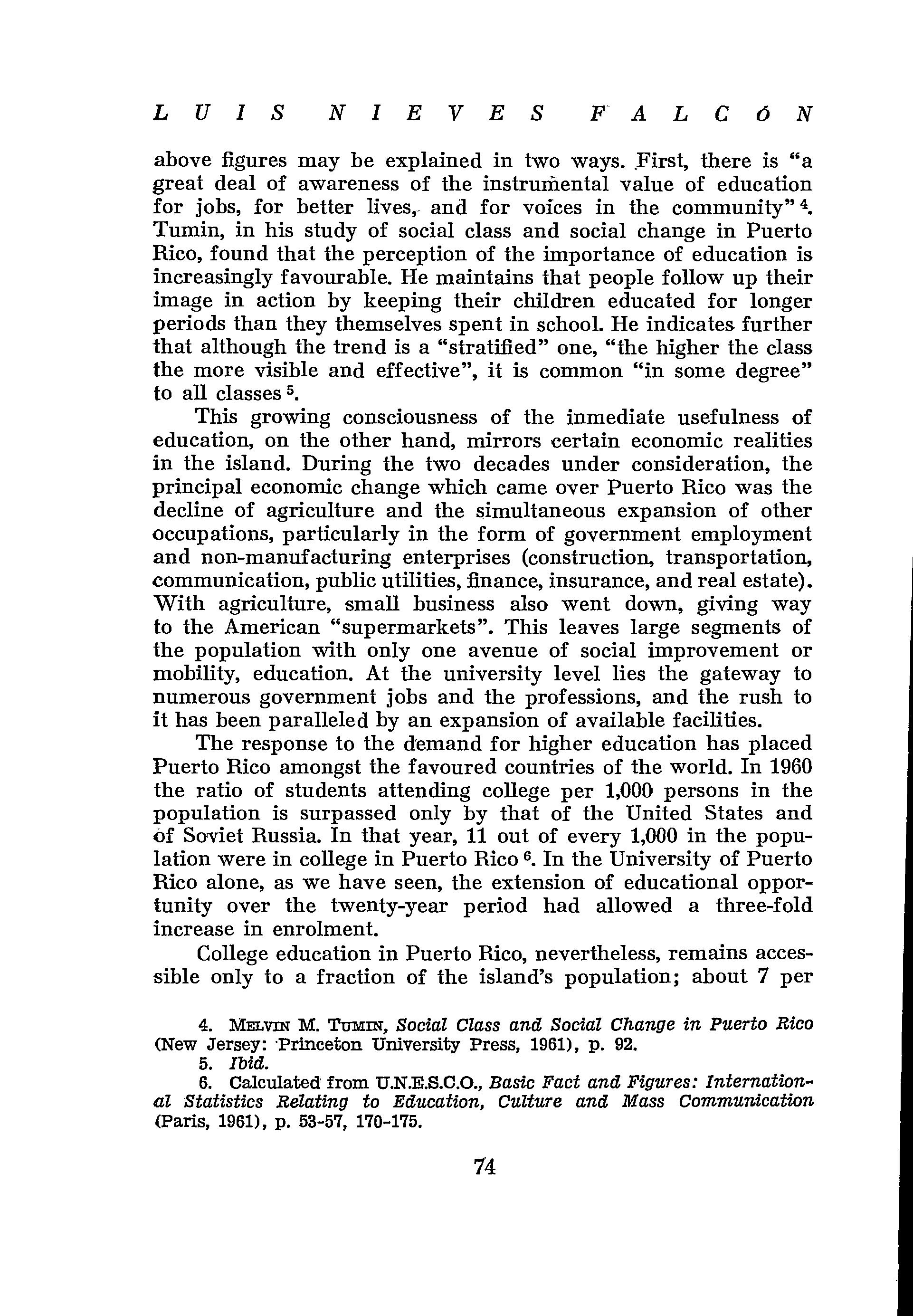
abovefiguresmaybeexplainedintwoways.First,thereis"a greatdealofawarenessoftheinstrumentalvalueofeducation forjobs,forbetterlives,-andforvoicesinthecommunity" 4. Tumin,inhisstudyofsocialclassandsocialchangeinPuerto Rico,foundthattheperceptionoftheimportanceofeducationis increasinglyfavourable.Hemaintainsthatpeoplefollowuptheir imageinactionbykeepingtheirchildreneducatedforlonger periodsthantheythemselvesspentinschool.Heindicatesfurther thatalthoughthetrendisa"stratified"one,"thehighertheclass themorevisibleandeffective",itiscommon"insomedegree" toallclasses 5
Thisgrowingconsciousnessoftheinmediateusefulnessof education,ontheotherhand,mirrorscertaineconomicrealities intheisland.Duringthetwodecadesunderconsideration,the principaleconomicchangewhichcameoverPuertoRicowasthe declineofagricultureandthesimultaneousexpansionofother occupations,particularlyintheformofgovernmentemployment andnon-manufacturingenterprises(construction,transportation, communication,publicutilities,finance,insurance,andrealestate). Withagriculture,smallbusinessalsowentdown,givingway totheAmerican"supermarkets".Thisleaveslargesegmentsof thepopulationwithonlyoneavenueofsocialimprovementor mobility,education.Attheuniversitylevelliesthegatewayto numerousgovernmentjobsandtheprofessions,andtherushto ithasbeenparalleledbyanexpansionofavailablefacilities.
Theresponsetothedemandforhighereducationhasplaced PuertoRicoamongstthefavouredcountriesoftheworld.In1960 theratioofstudentsattendingcollegeper1,000personsinthe populationissurpassedonlybythatoftheUnitedStatesand ófSovietRussia.Inthatyear,11outofevery1,000inthepopulationwere'incollegeinPuertoRicos.IntheUniversityofPuerto Ricoalone,aswehaveseen,theextensionofeducationalopportunityoverthetwenty-yearperiodhadallowedathree-fold increaseinenrolment.
CollegeeducationinPuertoRico,nevertheless,remainsaccessibleonlytoafractionoftheisland'spopulation;about7per
4.MELVINM. TuMnv, SocialClassandSocialChangeinPuertoRico (NewJersey:PrincetonUniversityPress,1961),p.92.
5.Ibid.
6.CalculatedfromU.N.E.S.C.O.,BasicFactandFigures:InternationalStatisticsRelatingtoEducation,CultureandMassCommunication (Paris,1961),p.53-57,170-175.

centof thepersons25yearsold oroverhasenteredcollege. Expansionatthecollegiatelevel,infact,doesnotimply"equality ofopportunity"inthesensethathighereducationisaccessibleto allregionsandsocialclassesalikeintheisland.Inthischapter weshalltrytoascertainhowcollege-goinginthestateuniversity, theinstitution which provides thelargest number of collegeeducatedindividuals,isapportionedwithregardtotheeligible age-group,thehighschoolgraduatepopulation,sex,rural-urban residence,andsocialclass,asmeasuredbyfather'soccupation. Ofmajorinterestalsoisthehighschoolacademicpreparation ofthecollege-goinggroups.Weshalldealwiththisindetailin thesubsequentchapter.
AllPuertoRicansaged18yearsareconsideredasbelonging totheagegroupeligibleforthefreshmanyearincollege,asthat isthemodalageofenteringfreshmenattheUniversityofPuerto Rico.Onthebasisofthisgroup,theproportionofcollegeentrants isshowntohaveincreasedfrom2.7percentin1944-45to8.3per centin1960-61.ThisratioishigherthanthatfoundinAustria, Belgium,Denmark,France,Germany(FederalRepublic),Greece, Iceland,Italy,theNetherlands,Sweden,andtheUnitedKingdom, butlowerthanthatofeitherCanadaortheUnitedStates 7 Byinstitutions,theexpansionofthefreshmanclassatthe UniversityofPuertoRicoinrelationtotheeligibleage-group representsatwo-foldincreaseovertheperiod1944-1960,while thatofotherinstitutionswassix-fold.Thedifferenceintherates ofexpansionindicatesthediminishingpreponderanceofthestate universityandtheincreasingsignificanceofotherinstitutions.
Lookingatthenumberof highschoolgraduatesover the sameperiod,wefindthatithadgrownfrom4,256to18,287,a rateofincreasewhichismuchgreaterthanthatof thehigh school-agepopulation.Theexpansionoffacilitiesnodoubtboosted attendanceatthislevelasshownbytheriseinthenumberof privateandpublichighschools,from77in194344,to109in 1951-52,andfinallyto175in1959-60.
Howdidthisexpansioninthenumberofhighschoolgraduates affect the University of Puerto Rico and other institutions ofhigherlearninginPuertoRico?'In1943,22percentof the highschoolgraduateswereadmittedtothebachelor'sprogramme
7. OrganizationforEconomicCo-operationandDevelopment,Ability andEducationalOpportunity(Paris:O.E.C.D.Publications,1961), p.190-191.
PERCENTAGEOFELIGIBLEAGE-GROUPATTENDINGUNIVERSITYFORFIRSTYEAROF
BACHELOR'SDEGREEBYYEAR

Year of Study Numberof PuertoRicans Aged18years(1)
Numberat University ofPuertoRico ForFirstYearof Bachelor'sDegree RioPiedras&Mayaguez Percentageat Universityof PuertoRico Number atOther Colleges forFirst Yearof Bachelor's Degree(2)
atall
Eligibleage-groupstimatedbyP.R.DepartmentofHealth,BureauofDemographicStatistics.
SouRCE OF DATA:PersonalcorrespondencewithRegistrar'sOfficesatthevariousuniversitiesinPuertoRico.
Includes110studentsfromPuertoRicoJuniorCollege.
Includes411studentsintheBachelorofArtsprogrammeinthePuertoRicoJuniorCollege.

attheUniversityand5percenttoallotherinstitutions.This makesatotalof27percentfortheislandasawhole.In1951-52 theproportionofhighschoolgraduatesmatriculatedatthestate universitydeclinedwhilethatatotherinstitutionsremainedthe same.Fortheislandasawholetherehadbeenafallintheproportion of highschoolgraduatesattendingthefreshmanyear ofthebachelor'sprogramme.In1960theratioof highschool graduatesattheUniversitydecreasedfurther,whilethatofother institutionswentup$.Theproportionfortheentireislanddropped offslightlyfortheperiod1952-61.Thus,althoughthenumberof freshmenstudentsinthebachelor'sprogrammeattheUniversity hadmorethandoubledandatotherinstitutionstheincreasehad beensix-fold,theinstitutionsofhigherlearninginallPuertoRico matriculatedinthefirstyearof thebachelor'sprogrammein 1959-60only22percentofthetotalhighschoolgraduates,as comparedwith27percentfor1943.Inotherwords,alarger fractionofhighschoolgraduatesdidnotgoontouniversitythan before.Someprobablydidnotwanttogo,butifmoreofthem hadwantedtogothechancesarethattheycouldnothavebeen admitted,atleasttothepublicinstitution.Thelatterhadrefused morethanhalf oftheapplicantsfrom1955-56to1961-62,although universityauthorities admitted thatmanyof thoserejectedhadsufficientacademicqualificationsforadmission 10 The restrictivefactor,accordingtotheChancellorandtheSecretary ofEducation,wasmainlyoneoffacilities.Theyreportedtothe governmental authorities that"it isnot possible to solve the
8.TheestablishmentoftheCatholicUniversityatPoncein1948had broughteducationtothehighschoolgraduatesofthesouthern,southeastern,andsouthwesternregionoftheisland.ThePuertoRicoJunior CollegewhichopenedinRioPiedrasin1950hadalsobeguntotakean increasingnumberofstudentsforatwo-yearliberalartsprogramme,qualifyingthemtoproceedafterwardstoanyofthecollegiateinstitutionsin theislandtocompletethebachelor'sdegree.Thefactthatnoentrance examinationisrequiredinthatinstitutionmusthavedivertedtoitsome highschoolgraduateswhowerenotadmittedtothestateuniversity. Thelatter,however,hasmadeaneffortrecentlytoincreaseitsintake ofhighschoolgraduatesbytheestablishmentofjuniorcollegesdesigned toservethewholeisland.
9.OficinadelRegistrador,NúmerodepersonasquetomaronelexamendeingresoalaUniversidad,númerodesolicitudesdeingresorecibidasynúmerodesolicitantesadmitidos,1962.
10.CLnvnioR.PRmxo,Proyectopreliminardecolegiosregionalesde laUniversidaddePuertoRico,1961,AppendixB."Númerodeestudiantes coníndicedeingresode85omásporpueblo."

problemofover-congestionnorincreasethenumberoffirst-year studentswithoutestablishingnewcollegefacilities"11. Theythus recommendedtheestablishmentofjuniorcollegesthroughoutthe island,includingthemetropolitanareaitself.
Howdidthesexdistributioninthefreshmanyearatthe University compare with that among high school graduates? Table2givestherelevantdata.Themostsignificantfactwhich emergesfromthistableistheequalizingofcollegeattendance betweenthesexes.Thuswhilein1944theratioofmalefreshmen tomalehighschoolgraduateswasgreater thanthatbetween femalefreshmenandfemalesecondarygraduates,in1960the gap between the two sexeshad closed.If we keep in mind, however, that the Mayagüez campus, where engineering.and agriculturalsciencesaretaughtandwhichismainlyamalecampus,isexcludedfromthisstudy,theadvantagemaywellstay onthesideofthemales.Nonetheless,thedifferencehasbecome toosmalltobesignificant.Wehavenocompletedataforthe otherinstitutions,butfor1960atleastithasbeenshownthat thesexeswereonacloseparity.Asimilartrendisalsonoticeable intheeligibleage-group andthehighschoolgraduategroup, besidesallthroughthelowerlevelsof theeducationalsystem aswehaveseen.ThistrendhasplacedPuertoRicoamongstthe countrieswith the highestpercentage of female enrolment in highereducation12.
Tracedtotheirplacesof residence,mostof thefreshman studentswerefoundtobeurbandwellers.Ontheotherhand, morethanhalfofthePuertoRicansaged18,themodalageof freshmanstudents,wereruralresidents.However,thepredominanceofruraldwellersamongsttheeligibleage-groupdeclined from88percentin1940to52in1960.Thedecreaseintherural populationmaythus accountfortherapid increaseof urban enrolleesinthebachelor'sprogramme.Thedataareshownin Table3.
This pattern of college-going between urban and rural dwellersisnotunexpected.In countrieswherestudiesof this nature havebeen undertaken,it hasbeenfound that college attendanceismorecommonamongsturbanthanamongstrural
11. CLrano OLIVERASYJAMEBENÍTEZ,"InformealaAsambleaLegislativadePuertoRicosobrecolegiosregionales"(RíoPiedras,P.R.:UniversidaddePuertoRico,1962),p.4,5. 12.U.N.E.S.C.O.,op.cit.,p.54.

(1)Informationonsexcompositionof2,667publichighschoolgraduatesobtainedfrom:DepartmentofEducation,AnnualReportoftheCommissionerofEducation:1943-44,198-99.Sexcompositionof529privatehigh schoolgraduatesinferredbyusingsexcompositionofseniorclass(29%boysand71%girls);for333extension graduatesinferredbyusingsexcompositionofseniorclass(49%boysand51%girls):for727publicsummer highschoolgraduatesinferredbyassumingthatsexcompositionwasthesameasthatforregularseniorgraduates(38%boysand62%girls).
(2)Informationonsexcompositionof7,080publichighschoolsgraduatesand447veteransobtainedfrom: DepartmentofEducation,AnnualReportoftheCommissionerofEducation:1951-52,254-258.Sexcompositionfor 994privateschoolgraduatesinferredbyusingsexcompositionofseniorclass(37%boysand63%girls);for678 publicsummerhighschoolgraduatesinferredbyassumingthatsexcompositionwasthesameasthatforregular seniorgraduates(41%boysand59%girls).
(3)Informationonsexcompositionof12,057publichighschoolgraduatesand2,337privateschoolones obtainedbypersonalcorrespondencewithMrClydeL.Fisher,Director,DivisionofStatistics,DepartmentofEducation.Sexcompositionfor1,260studentsfromeveningschoolsand1,355publicsummerhighschoolgraduates inferredbyusingsexcompositionoftheirrespectiveseniorclasses.
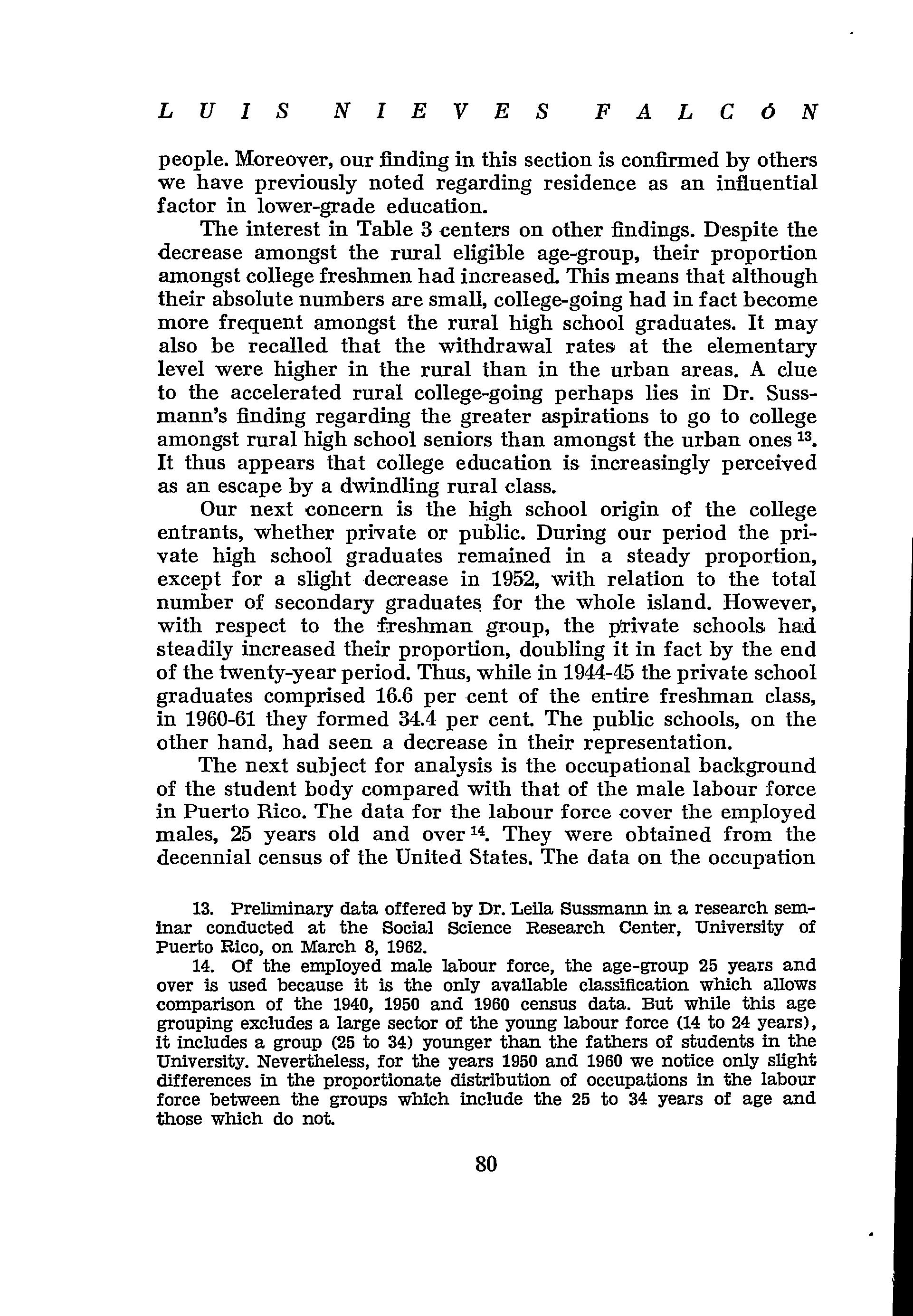
people.Moreover,ourfindinginthissectionisconfirmedbyothers wehavepreviouslynotedregardingresidenceasaninfluential factorinlower-gradeeducation.
TheinterestinTable3centersonotherfindings.Despitethe decreaseamongsttheruraleligibleage-group,theirproportion amongstcollegefreshmenhadincreased.Thismeansthatalthough theirabsolutenumbersaresmall,college-goinghadinfactbecome morefrequentamongsttheruralhighschoolgraduates.Itmay alsoberecalledthatthewithdrawalratesattheelementary levelwerehigherintheruralthanintheurbanareas.Aclue totheacceleratedruralcollege-goingperhapsliesiiiDr.Sussmann'sfindingregardingthegreateraspirationstogotocollege amongstruralhighschoolseniorsthanamongsttheurbanonesls, Itthusappearsthatcollegeeducationisincreasinglyperceived asanescapebyadwindlingruralclass.
Ournextconcernisthehighschooloriginofthecollege entrants,whetherprivateorpublic.Duringourperiodtheprivatehighschoolgraduatesremainedinasteadyproportion, exceptforaslightdecreasein1952,withrelationtothetotal numberofsecondarygraduatesforthewholeisland.However, withrespecttothefreshmangroup,theprivateschoolshad steadilyincreasedtheirproportion,doublingitinfactbytheend ofthetwenty-yearperiod.Thus,whilein1944-45theprivateschool graduatescomprised16.6percentoftheentirefreshmanclass, in1960-61theyformed34.4percent.Thepublicschools,onthe otherhand,hadseenadecreaseintheirrepresentation.
Thenextsubjectforanalysisistheoccupationalbackground ofthestudentbodycomparedwiththatofthemalelabourforce inPuertoRico.Thedataforthelabourforcecovertheemployed males,25yearsoldandover 14. Theywereobtainedfromthe decennialcensusoftheUnitedStates.Thedataontheoccupation
13. PreliminarydataofferedbyDr.LeilaSussmanninaresearchseminarconductedattheSocialScienceResearchCenter,University of PuertoRico,onMarch 8,1962.
14. Oftheemployedmalelabourforce,theage-group 25 yearsand overisusedbecauseitistheonlyavailableclassificationwhichallows comparisonofthe 1940,1950 and 1960 censusdata.Butwhilethisage groupingexcludesalargesectoroftheyounglabourforce (14 to 24 years), itincludesagroup (25 to 34) youngerthanthefathersofstudentsinthe University.Nevertheless,fortheyears 1950 and 1960 wenoticeonlyslight differencesintheproportionatedistributionofoccupationsinthelabour forcebetweenthegroupswhichincludethe 25 to 34 yearsofageand thosewhichdonot.
RURAL-URBANCOMPOSITIONOFTHEFRESHMENSTUDENTSINTHEBACHELOR'SPROGRAMMEATTHEUNIVERSITYOFPUERTORICO,RÍOPIEDRASCAMPUS,COMPAREDWITH
RURAL-URBANCOMPOSITIONOFAGE-GROUPBYYEAR

(1)Informationonrural-urbanresidenceofeligibleage-grouptakenfromdecennialcensusespublishedin1940, 1950,and1960.Datafor1940from:BureauofDemographicStudies,DepartmentofHealth,SanJuan,PuertoRico. Datafor1950from:U.S.BureauoftheCensus,SixteenthCensusoftheUnitedStates:1950.Population,II,Part53, PuertoRico,ChapterC,107-109.Datafor1960from:U.S.BureauoftheCensus,SeventeenthCensusoftheUnited States:1960.Population,II,Part53,PuertoRico.ChapterC,21.

of students'fatherswerecollected especiallyfor thisinquiry fromtheRegistrar'srecordsattheUniversity.Thecomparative dataarepresentedinTable4.Fromthistablewecanseethat thehigh-statusoccupationsareover-representedamongstcollege students.Thereisnodoubtthatithasbeenmoredifficultfor thelower-occupationgroupstomeettheeconomicexpensesof collegeeducation.IthasbeenfurthershownthatinPuertoRico, asinothercountries,childrenfromlower-classfamilies,onthe whole,tendtohaveloweraveragescoresinmeasuredabilitytests thanthosefromhigherclasses 15,
Table4yieldsotherimportantfindings.First,whilethe"old middleclass"ofprofessionalsandentrepeneurswasheavilyrepresentedamongstcollegestudentsineveryyearincludedinthis study,thisover-representationwasnotsoevidentin1952and1964 asin1944.Ontheotherhand,the"newmiddleclass"ofwhitecollarworkers,whiledoublingitsproportioninthelabourforce duringourperiod,tripleditsratioin.thestudentbody.Forthe latterclass,educationhasclearlybecometheroyalroadtostatus.
Foronesectionofthe"oldmiddleclass",however,thefindingsarenotthesame.Farm-ownersdeclinedsharplyaspart ofthelabourforcebetween1944and1961,buttheirsonsdidnot dosoamongstthestudentbody.Infact,therelativerateof college-goingamongstyoungstersfromthesefamiliesroseover theperiod.Thereasonbehindthis,aswealreadyindicatedabove, isthedeteriorationoftheruralclasswhichisapparentlytrying torecoupitssociallossbymeansofeducation.ThisissubstantiatedbyasmallsurveyconductedbytheRuralExtensionServicewhichfoundthattheproportionofsonsof farmerswho
15.See:AmericanCouncilonEducation,OnGettingintoCollege (Wash.,D.C.,1949),p.16;DOROTHYHums CaLLIcuT, AStudyofSocioeconomicStatusofPuertoRicanSchoolChildren,UnpublishedMaster's Thesis,UniversityofTexas,1945,p.47;J.E. FLOUD, A.H.Husuvnrm F.M.MARTnv,SocialClassandEducationalOpportunity(London:William HeinemannLtd.,1957),p.44;J.E.Floud,andA.H.Halsey."SocialClass, IntelligenceTestsandSelectionforSecondarySchools",inA.H.Halsey andothers,eds.,Education,EconomyandSociety(NewYork:TheFree PressofGlencoe,Inc.,1961),p.212;A.GntanD,"SelectionforSecondary Education",Ibid.,p.194;TheScottishCouncilforResearchinEducation, SocialImplicationsofthe1947ScottishMetalSurvey(London:University ofLondonPress,1953),p.50;P.E. VERNoN, SecondarySchoolSelection (London:MethuenandCo.,Ltd.,1957),p.41; DAEL WoLFLE, America's ResourcesofSpecializedTalent(NewYork:HarperandBrothers,1954), p.159-60.
OCCUPATIONSOFSTUDENTS'FATHERSINTHE FRESHMAN YEAR OF THE BACHELOR'S PROGRAMMEATTHEUNIVERSITYOFPUERTO RICO, RtO PIEDRAS CAMPUS, COMPARED WITHOCCUPATIONALCOMPOSITIONOFPUERTORICO,EMPLOYEDMALES25YEARSAND OVER,BYYEAR1
OCCUPATIONS
Professionals,semiprofessionals, proprietors and managers

(1)Includescivilianlabourforce,employedmales25yearsoldandover.SouucsOFDATA:U.S.Bureauof theCensus,SixteenthCensusoftheUnitedStates:1940.BulletinN.°2,CharacteristicsofthePopulation,Puerto Rico,p.61-64;Id.,1950.Part53ChapterC,p.162-163;Id.,1960.DetailedCharacteristics,p.317-319.Dataon occupationsofstudents'fatherscollectedforthisinquiryfromadmissionapplicationsintheRegistrar'sOffice attheUniversityofPuertoRico.

wishedtoremaininthefarmingoccupationwasmuchlessthan thosewhowishedtoleave16
Turningtothechildrenofworking-classfamilies,wefind thattheurbanworking-classincreasedfrom28percentofthe labourforcein1944to44percentin,1961.Duringthissame period,however,thechildrenofthisfastexpandinggroupmade upasteadyone-quarterofthestudentpopulation,whichmeans thattherelativeshareofuniversityenrolmentfromthisclasshad declined.Asomewhatdifferentpictureemergesinthecaseof farm-workers.Here,therurallabourersalsomadeasteady(one percent)proportioninthefreshmangroup,buttheirpartinthe labourforce had been greatly diminished, which means that collegeattendancehadbecomemorefrequentamongstthisclass. Nevertheless, theyarestillunder-represented amongst collegegoersinthecountry.
Table5,whichpresentsthedatainTable4inanotherform, makesthispointonsocialselectionattheuniversitylevelclearer. Intable5weseethestudentsfromeachoccupationalclassin theirproportiontotheemployedmales25yearsoldandoverof thatclass.Itisclearthattheproportionsincollegeincreasedfor allclasses,excepttheprofessionals 17. Thusin1940-41,forevery 15sonsofprofessionalsincollege,therewere11sonsofsmall business,threeofwhite-collar,twooffarm-owners,twoofurban workersandnoneoffarm-labourers.In1960-61,forevery10sons of professionals,white-collarhad11,smallbusiness20,farmowners7,urbanworkers3,andfarm-labourers, 1 18
Thechancesofattendingcollegehaveincreasedforallclasses, butthemiddleclasseshavetakenarelativelygreatershareof themthanthelowerclasses.Thuswhilein1944therewere53
16.CarlosE.Montes,"Aspirationsocupacionalesdeloshijosdelos agricultorespuertorriqueños",SanJuan:ComitéSobreRecursosHumanos,1960.
17.Whenonlymales35yearsoldandoverwereincludedinthecomparisonsfor1950and1960,theoveralltrendobservedwasfortheproportionsofalloccupationalgroups,includingtheprofessionals,toincrease.
18.Whenemployedmalesunder35yearswereexcluded,thesituation in1950wasasfollows:15sonsofprofessionals,15ofwhite-collar,18of smallbusiness,4ofindustrialworkers,4offarm-owners,and1offarm labourers.In1960,itwas16sonsofprofessionalsforevery17ofwhitecollar,23ofsmallbusiness,5ofindustrialworkers,8offarm-ownersand 3offarmlabourers.Thusthetrendisfoundtobeconsistentwiththat alreadyobserved.
NUMBEROFFRESHMANSTUDENTS,BYFATHER'S OCCUPATION, PER 10,000 EMPLOYED MALES,25YEARSOLDANDOVERINTHELABOURFORCE,PUERTORICO,BYYEAR

SOuRCEs OF DATA: SameasTable4.

sonsoffathersinthewhite-collaroccupations,in:1960thefigure hadswollento426,oraneight-foldincrease.Ontheotherhand, thesonsoffarm-labourersincreasedtheirnumberbetweenthose twoyearsfrom4to21,orafivefoldexpansion,andwiththe latterfigurecomprisedlessthanonepercentofthefreshman classof1960.Theurbanindustrialworkers,althoughincreasing theirabsolutenumbersmorethantwice,werestillunder-represented.Inrelativeterms,foreverythreestudentsfromworkingclasshomestherewerethreetimesmorefromprofessionaland white-collarfamiliesandseventimesasmanyfromsmallbusiness.
Wecansumupourfindingsbysayingthatduringthetwentyyearperiodunderstudy,theopportunitiesforcollegeeducation hadexpandedtremendously,buttheoveralleffecthadnotdiminishedtheexistinginequalitiesbetweentheoccupationalgroups andhadinfactincreasedthem.ThisiscontrarytowhatPuerto Ricanswouldgenerallyfeelhadbeentheirexperienceoverthe twentyyearsinquestion.Theaccelerationofuniversityfacilities andtheexpansionofopportunitiesforhighereducationwould suggestanincreasingaccessibilityofsucheducationtoallsocial classes.Thisisinfactwhatthepeoplethinktheyhaveexperiencedintheirlivesorhaveseeninthelivesofthosewhomthey know.ThereisalwaysthecaseofJuan,thesonofthebaker,or ofPedro,thesonofthefactoryhand,whohavemanagedtoenter college,afactalmostunheardofbefore.However,lessvisiblein thisimmediateexperienceisthefactthattheopportunitiesfor collegeeducationmaybeimprovingatunequalratesfordifferentclasses.Inequalitiesofopportunity,indeed,tendtobefar morevisiblesociallywhentotalopportunityissmallorcontracting thanwhenitislargeorexpanding.Thusourmainfindingwith respecttocollege-goinginPuertoRicoisonewhichtodayhas lowsocialvisibility.Everyone'schancesofgettingintocollege havebecomebetter,buttherelativeshareinuniversityenrolment oftheworkingclasses,comparedwiththatoftheoldandparticularlythenewmiddleclasses,haveactuallybeengettingworse.
Theunder-representationoftheurbanindustrialandthe ruralworkingclassatthecollegelevelhasbeentheresultofa selectionprocessoperatingearlyintheschoollifeofachild.It hasalreadybeenshownthatthechancesofruraldwellerscompletingelementaryschoolhadbeenlessthanthoseforurban residents.Outofevery100ruralchildrenwhostartfirstgrade, 50donotgopasttheprimarylevel.Theselectionwhichcontin-
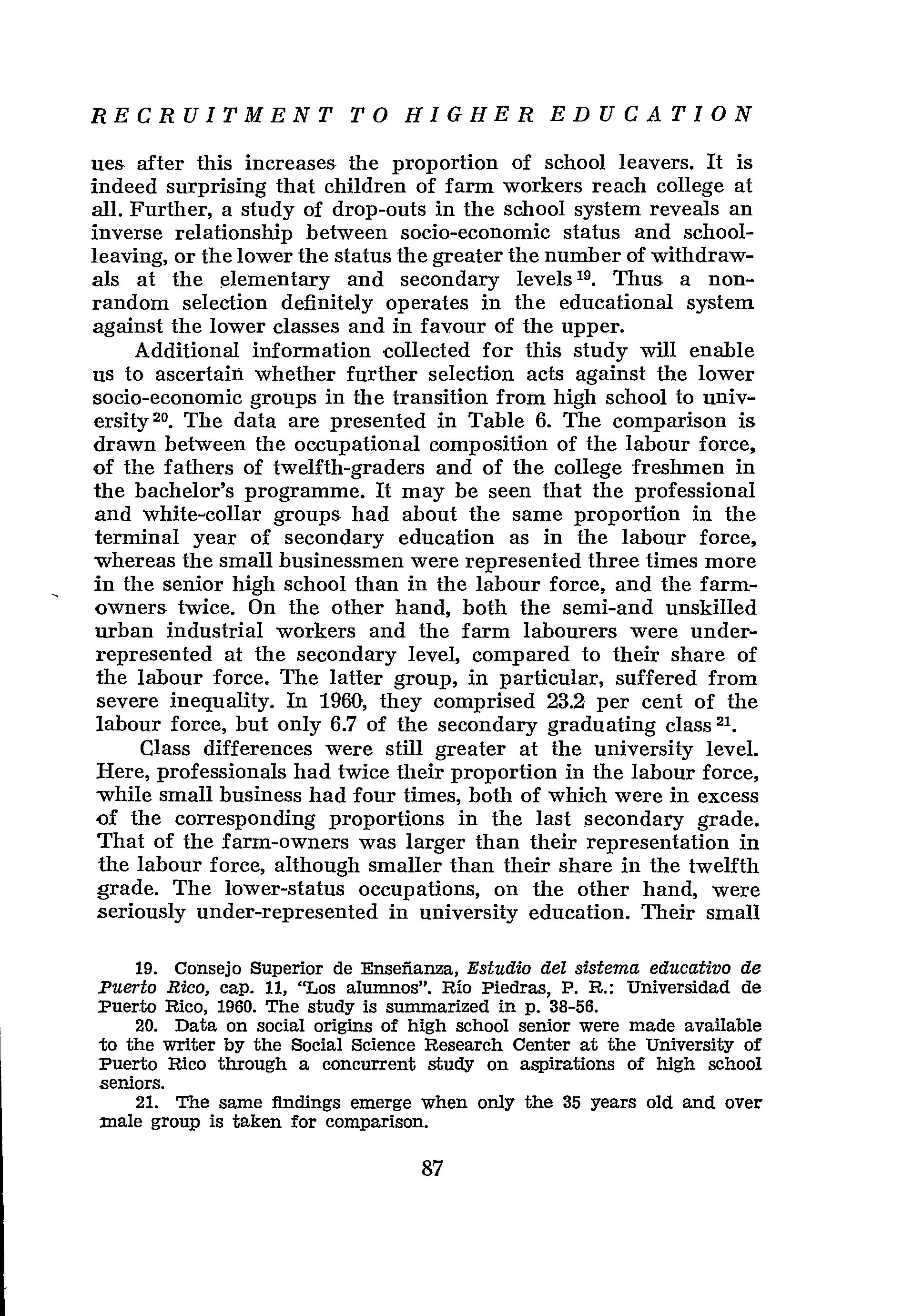
uesafterthisincreasestheproportionof schoolleavers.It is indeedsurprisingthatchildrenoffarmworkersreachcollegeat all.Further,astudyofdrop-outsintheschoolsystemrevealsan inverserelationship betweensocio-economicstatus andschoolleaving,orthelowerthestatusthegreaterthenumberofwithdrawals at the elementary and secondary levels19. Thus a nonrandomselectiondefinitelyoperatesinthe educationalsystem againstthelowerclassesandinfavouroftheupper.
Additionalinformationcollectedforthisstudywillenable ustoascertainwhetherfurtherselectionactsagainstthelower socio-economicgroupsinthetransitionfromhighschooltouniversity 20 ThedataarepresentedinTable6.Thecomparisonis drawnbetweentheoccupationalcompositionofthelabourforce, ofthefathersoftwelfth-gradersandofthecollegefreshmenin thebachelor'sprogramme.Itmaybeseenthattheprofessional andwhite-collargroupshadaboutthesameproportioninthe terminal year of secondary education asin thelabourforce, whereasthesmallbusinessmenwererepresentedthreetimesmore intheseniorhighschoolthaninthelabourforce,andthefarmownerstwice.Ontheotherhand,boththesemi-andunskilled urbanindustrialworkersandthefarmlabourerswereunderrepresentedatthesecondarylevel,comparedtotheirshareof thelabourforce.Thelattergroup,inparticular,sufferedfrom severeinequality.In1960,theycomprised23.2percentofthe labourforce,butonly6.7ofthesecondarygraduatingclass 21 Classdifferenceswerestillgreaterattheuniversitylevel. Here,professionalshadtwicetheirproportioninthelabourforce, whilesmallbusinesshadfourtimes,bothofwhichwereinexcess of thecorrespondingproportionsin thelastsecondarygrade. Thatofthefarm-ownerswaslargerthantheirrepresentationin thelabourforce,althoughsmallerthantheirshareinthetwelfth grade.Thelower-statusoccupations, on the other hand,were seriouslyunder-representedinuniversityeducation.Theirsmall
19.ConsejoSuperiordeEnseñanza,Estudiodelsistemaeducativode PuertoRico,cap.11,"Losalumnos".RíoPiedras,P.R.:Universidadde PuertoRico,1960.Thestudyissummarizedinp.38-56.
20.Dataonsocialoriginsofhighschoolseniorweremadeavailable tothewriterbytheSocialScienceResearchCenterattheUniversityof PuertoRicothroughaconcurrentstudyonaspirationsofhighschool seniors.
21.Thesamefindingsemergewhenonlythe35yearsoldandover malegroupistakenforcomparison.

OCCUPATIONALCOMPOSITIONOFEMPLOYEDMALES,25YEARSOLDANDOVER,OFPUERTO RICOLABOURFORCEIN1960COMPAREDWITHOCCUPATIONALCOMPOSITIONOFHIGH SCHOOLSENIORSIN1959-60ANDCOLLEGEFRESHMENINABACHELOR'SPROGRAMME IN1960-61.

sharesattheendoftheseniorhighschoolwerefurtherreduced uponreachingtheuniversitylevel.Differenceshadthuspersisted andcontinuedtomilitateagainsttheloweroccupationalclasses inthetransitionfromsecondarytocollegiatelevel.
Thefactorswhichpreventthelowerclassesfromreaching thecollegelevelhavebeeneconomicratherthanmotivational. AsTuminshowsinhisstudyonSocialClassandSocialChange inPuertoRico,thelower-classparents"seemtobeaspiringmore imaginativelyfortheirin-schoolchildrenthanparentsinother groups" 22. Headdsthat"iflower-classparentsfulfilltheirstated aspirations, they will close the gap between the educational achievementoftheirchildrenandthoseofupper-classparents" 23. Ontheotherhand,.Tuminmaintains that lower-classparents "expect to encountermoreseriousdifficultiesastheyturnto thebusinessofeducatingtheirchildren" 24. Forthemtokeepa childinschoolisarealburden,andthereisnothing"toovercome oroutweightheimmediatelyfeltpressureandpinchonthefamilybudget",noranythingtoaffecttheirimmediatevaluations oneducation.Inotherwords,theireconomicinabilityissogreat andtheirviewoflifesocircumscribedbylowincomethatthey cannotapparentlyrisetotheconceptionofamplereducationfor theirchildren,evenwherethereisthewill,thedesiretodoso.
Therealityoftheireconomicstringenciesmaybebetterunderstoodifwebearinmindthatthecostofoneyearofcollege educationinthestateuniversityiscalculatedbyUniversityauthoritiestoamountto$922.Thisexcludesclothing,anexpensiveitem inacountrywhereitisasocialsymbol.Theannualmedianincomeforpersons25yearsofageorover,ontheotherhand,is X1,079.Theaverageamountofgovernmentassistancegivenin 1960-61isX266,whichmakesabout29percentofthetotalcost. Thisstillleavesabalanceof$656forthefamilyofastudenton scholarshipaidtoscrapeup.
Manyofthepoorparentsindeedmaybereluctanttosend theirchildrentocollege,asinothercountries.Butformanyof themtoothefollowingdescriptionbyTuminholdstrue."These arenotstupidpeoplewhoareunwillingtomakethenecessary sacrifices.Rather,weseeapictureofthesheerinabilityofparents atthelowerlevelstoconceiveofthepossibilityofmakingthe
22. MEr.vnv M. TIInairr, op. cit., p. 125.
23. Ibid.
24. Ibid., 128.
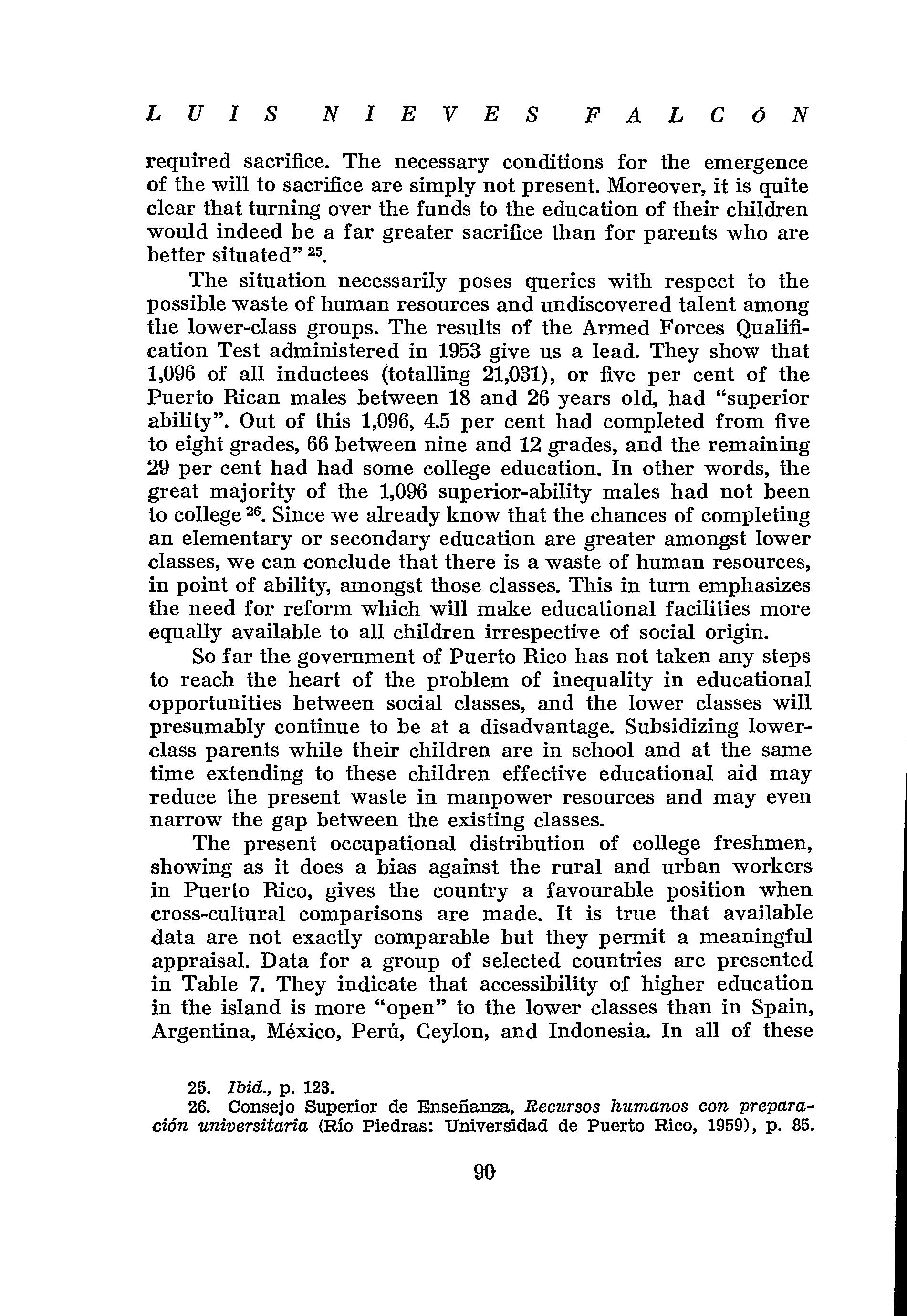
requiredsacrifice.Thenecessaryconditionsfortheemergence ofthewilltosacrificearesimplynotpresent.Moreover,itisquite clearthatturningoverthefundstotheeducationoftheirchildren wouldindeedbeafargreatersacrificethanforparentswhoare bettersituated" 25.
Thesituationnecessarilyposesquerieswithrespecttothe possiblewasteofhumanresourcesandundiscoveredtalentamong thelower-classgroups.TheresultsoftheArmedForcesQualificationTestadministeredin1953giveusalead.Theyshowthat 1,096ofallinductees(totalling21,O31),orfivepercentofthe PuertoRicanmalesbetween18and26yearsold,had"superior ability".Outofthis1,096,4.5percenthadcompletedfromfive toeightgrades,66betweennineand12grades,andtheremaining 29percenthadhadsomecollegeeducation.Inotherwords,the greatmajorityofthe1,096superior-abilitymaleshadnotbeen tocollege 26. Sincewealreadyknowthatthechancesofcompleting anelementaryorsecondaryeducationaregreateramongstlower classes,wecanconcludethatthereisawasteofhumanresources, inpointofability,amongstthoseclasses.Thisinturnemphasizes theneedforreformwhichwillmakeeducationalfacilitiesmore equallyavailabletoallchildrenirrespectiveofsocialorigin.
SofarthegovernmentofPuertoRicohasnottakenanysteps toreachtheheartoftheproblemofinequalityineducational opportunitiesbetweensocialclasses,andthelowerclasseswill presumablycontinuetobeatadisadvantage.Subsidizinglowerclassparentswhiletheirchildrenareinschoolandatthesame timeextendingtothesechildreneffectiveeducationalaidmay reducethepresentwasteinmanpowerresourcesandmayeven narrowthegapbetweentheexistingclasses.
Thepresentoccupational distribution of college freshmen, showingasitdoesabiasagainsttheruralandurbanworkers in Puerto Rico,givesthecountryafavourablepositionwhen cross-culturalcomparisons are made.It is true thanavailable dataarenotexactlycomparablebuttheypermitameaningful appraisal.Dataforagroupofselectedcountriesarepresented inTable7.Theyindicatethataccessibilityofhighereducation intheislandismore"open"tothelowerclassesthaninSpain, Argentina,México,Perú,Ceylon,andIndonesia.Inallofthese
25.Ibid.,p.123.
26.ConsejoSuperiordeEnseñanza,Recursoshumanosconpreparaciónuniversitaria(RíoPiedras:UniversidaddePuertoRico,1959),P.85.

Spain(Madrid,1949)
Argentina—BuenosAires,1958
LaPlata,1947-57
México(NacionalAutónoma,1949)
Perú(SanMarcos,1957)
Ceylon(CeylonUniversity,1950)
Indonesia(GadjahMada,1960)
Britain(KelsallInquiry,1955)
UnitedStatesofAmerica—RoperInquiry,1947
SOURCES OF DATA:Spain:MANUELFRAGAIRIBARNEandJOAQUÍNTENAARTIGAS,"UnaencuestaalosestudiantesuniversitariosdeMadrid",RevistaInternacionaldeSociología,AñoVII,N.°28,p.313-51;Argentina:Universidad deBuenosAires,CensoUniversitario,BuenosAires,1959,p.109;UniversidaddeBuenosAires,"MemorándumaclaratoriodelaencuestadelaUniversidaddelaPlata",BuenosAires,1962;Perú:ComisiónCoordinadoradelaReforma,OficinaCentralEjecutiva,Censodelalumnado:estudiodelarealidaduniversitaria,Lima,Universidad NacionalMayordeSanMarcos,1957,p.90-93;México:UniversidadNacionalAutónoma,InstitutodeInvestigacionesSociales,Primercensonacionaluniversitario,1949,CiudaddeMéxico:EditorialStylo,1953,p.45-47;Ceylon: MURRAYA.STRAUSS,"FamilyCharacterosticsandOccupationalChoiceofUniversityEntrantsasCluestotheSocial StructureofCeylon",UniversityofCeylonReview,Vol.IX,1951,p.123-35;Indonesia:JOSEPHFISCHER,"TheStudent PopulationofaSoutheastAsianUniversity:AnIndonesianExample",InternationalJournalofComparative Sociology,Vol.2,N.°2,1961,p.224-333;Britain:R.K.KELSALL,ReportonanInquiryintoApplicationsforAdmission toUniversities,London:AssociationofUniversitiesoftheBritishCommonwealth,1957,Table15;U.S.A.:ELMO ROPER,FactorsAffectingtheAdmissionofHighSchoolSeniortoCollege,Washington,D.C.:AmericanCouncil onEducation,1949,p.143;EducationalTestingService,BackgroundFactorsRelatingtoCollegePlansandCollege EnrollmentAmongPublicHighSchoolStudents,Princeton,NewJersey,1957,AppendixD,Table4A;PuertoRico: DatacollectedforthisparticularinquiryfromtheindividualrecordsattheRegistrar'sOfficeattheUniversityof PuertoRico.

countriestheproportionofuniversitystudentsfromprofessional and white-collar families dominate the educative field to a greaterextentthaninPuertoRico,andconcurrently,thereis alowerrepresentationfromthelowerclasses.Infact,themodel ofrecruitmentto'highereducationinPuertoRicoismoreakin tothatfoundinGreatBritainandtheUnitedStatesthantothat oftheLatinAmericancountriesandotherdevelopingsocieties. Whetherpresentinequalitiesintheislandwillbereducedtoensure orwidenthe"openness"oftheschoolsystemremainstobeseen. Otherwise, present conditionsmayleadtowardsamorerigid andclass-orientededucationalstructure.Thewriterisinclined tothinkthatunlessadequatemeasuresaretakenintime,the systemwillreduceitspresent"openness"andexistingclassbiases willhardenratherthandissipate.

Upto1942thepublichighschoolsofPuertoRicowereorganizedonthe8-4planmeaningeightyearsofelementaryandfour yearsofhighschooleducation.Inthatyear,theDepartmentof Educationinstitutedanumberofreforms,chiefofwhichwas thereorganizationoflowereducationonthe6-3-3plan.Thisnew arrangementprovidesforsixyearsofelementaryschooling,three ofjuniorhigh,andanotherthreeofseniorhigh.Thechiefreason givenforitsadoptionwasthatitwouldmakeitpossibletogive greaterattentiontotheproblemsofadolescents,andwouldalso helptodiminishthehighrateofdrop-outattheconclusionof thefourthgrade 1. Theproponentsof theplan arguedthat'a diplomawhichwasgrantedonlyafterfinishingtheeighthgrade was insufficient motivation for students to stay on, past the fourthgrade.Byreducingthiseight-yearwaittooneofsixyears, manyafourth-gradepupilmightbeencouragedtopursuethe remainingtwoyears.Notonlywouldthe"holdingpower"ofthe schoolsincrease,butalsotheelementarypreparationofthestudentswouldbeimproved.Itmayalsobementionedthatthe6-3-3 plan,independentlyofthelocalsituation,reflectedcontemporary schoolorganizationpracticesinvogueintheUnitedStates,and thatundertheplan,thesystemcontinuestohavethesameweak "holding-power"with respect to enrollees, particularly at the elementarylevel.
1. DepartamentodeInstrucciónPública,"Filosofíaeducativayreformasenelcurrículodelaescuelaelemental"(Cartacircularnúm.1), 1.°dejuliode1942.

Whatevertheaimsandeffectsthischangemayhavehad,the newplandidnotaltermateriallythestructureofthehighschool curriculum.
Thepublichighschoolsoffervariouscoursesofstudytothe students.Theyarethegeneraloracademicprogramme,thecommercial,the"diversifiedoccupation",andthe"tradeandindustry" curriculum.Eachoftheseprogrammeshasspecificadmissionand graduationrequirements.
MostofthepublicseniorhighschoolsinPuertoRicoofferthe academiccurriculum.Outofatotalof93,fivearevocationalhigh schoolswhichgrantahighschooldiploma,whilesevenofthe academiconesalsooffertheothercurricula.
Admission to the general academic programme is based solelyonofficialevidenceof juniorhighschoolgraduation.No furtherspecificationsconcerninggradeindexaremadeforadmissiontothisprogramme.Inordertoobtainajuniorhighschool diplomathe,studentmusthavepassedmorethan half of the subjectshe tookintheninthgrade.Thisgeneral programme requiresthesatisfactorycompletionof12highschoolunitsunder thenew6-3-3planand16unitsunderthe8-4plan.
Thegraduationrequirementsforthisprogramme(excluding ninthgrade)are:
TwoyearsofSpanish
TwoyearsofEnglish
Twoyearsofhistoryorsocialstudies
Oneyearofmathematics(nospecifickind)
Oneyearofnaturalscience(nospecifickind)
Fouryearsofelectiveswhichmayormaynotbeacademic.
Thelargeschools,whichasarulearelocatedinthelarger cities,areabletoofferawidervarietyofelectivesthanthesmaller onesz.
The commercial curriculum offers the secretarial, clerktypist,book-keeping,anddistributiveoccupationsdiplomas.To beadmittedtothisprogrammethestudentmusthavegraduated fromtheninthgradewithaminimumgradeindexofC.Hemust havetakenageneralabilitytestandanotherinSpanishreading,
2.WILLIAMVANTu.,"LaEnseñanzaSecundariaenPuertoRico",Río Piedras:ConsejoSuperiordeEnseñanza,UniversidaddePuertoRico,1960, p.20.

withaminimumpercentilerankof50ineachtest.Furthermore, heisinterviewedbythevocationalcounselloroftheschooland theteacher-coordinatoroftheseprogrammes.Inadditiontothese requirements, a student selecting the distributive occupations programmemustbeatleast16yearsold,haveaminimumindex ofCattheendofthetenthgrade,showinterestintheoccupation selected,havedesirablepersonalitytraitsandcharacteristicsfor theoccupationheisapplyingfor,andacertificateofgoodhealth. Finally,hisparentsmustdeclareinwritingthattheyconsentto thetrainingthathewillreceive.
Thecommercial programmesrequire under the new6-ái-3 planthesatisfactorycompletionof15highschoolunitsforthe secretarialdiploma,141/2forthatofbook-keeper,14or141/2 forclerk-typist,and15forthedistributiveoccupationsandtrades andindustry.(Undertheold8-4planthiswouldbeequivalent to19,181/2,18or181/2,and19unitsrespectively).
Thegraduationrequirementsforthesecretarial,clerk-typist, andbook-keepingprogrammeare:
ThreeyearsofSpanish
ThreeyearsofEnglish
Oneyearofgeneralhistory
Seventoeightyearsofbusinesssubjects.
Thedistributiveoccupationsandtradesandindustrygraduationrequirementsareslightlydifferent.Theyinclude:
TwoyearsofSpanish
TwoyearsofEnglish
Oneyearofmathematics(GeneralMathematicsorElementary [Algebra)
Oneyearofbiology
Oneyearofgeneralhistory
OneyearofSocialandEconomicProblemsofPuertoRico
Oneelective
Sixyearsofvocationalcourses.
Onenoticesimmediatelythatthehighschoolcurriculumwith thelowestentrancerequirementsistheacademic,anditisfrom herethatmostofthecollege-goingstudentsaresupplied.Thus, whiletheothersusemultiplecriteriaforselectingtheircandidates, thegeneralprogrammereliessolelyonthejuniorhighschool
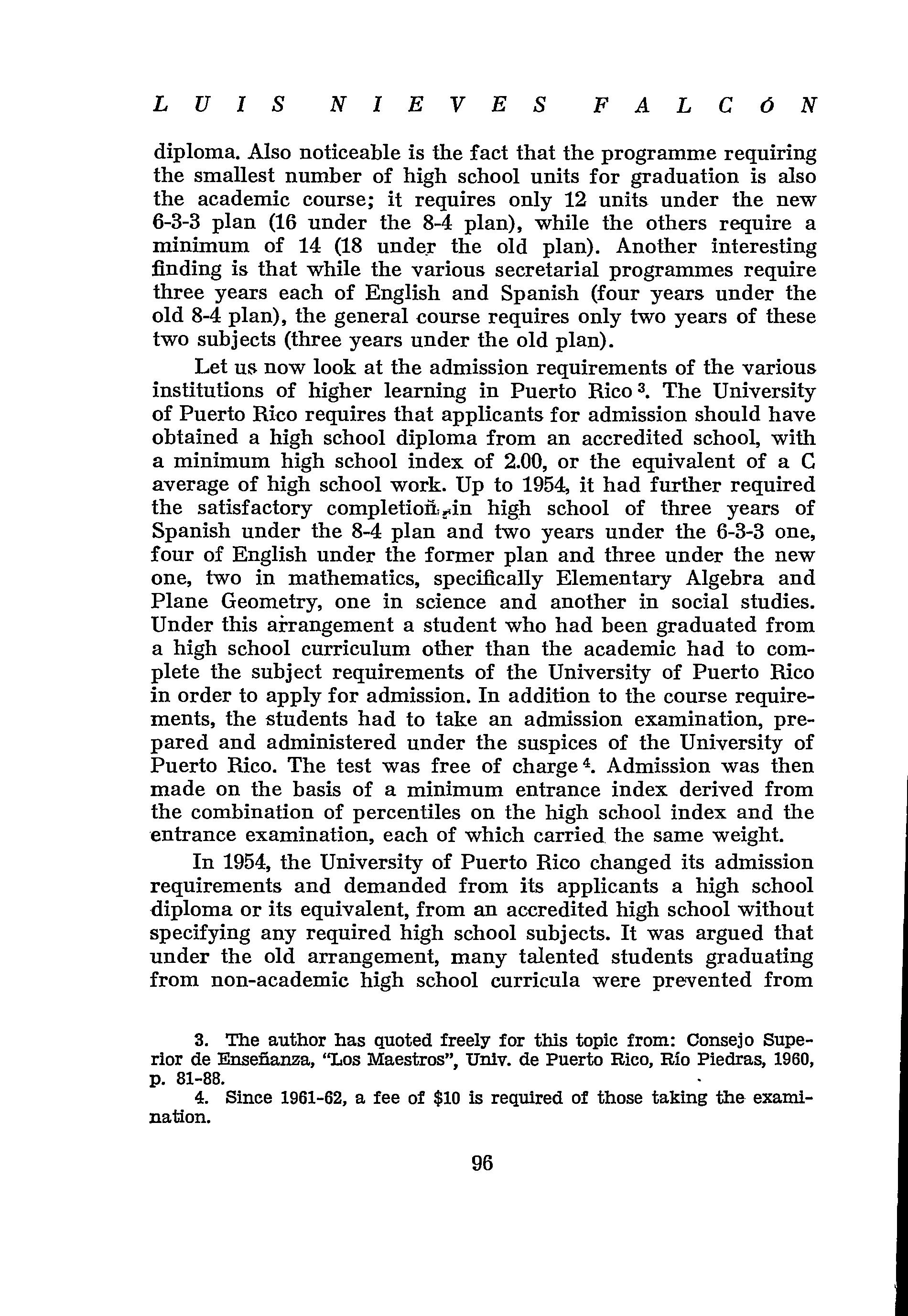
diploma.Alsonoticeableisthefactthattheprogrammerequiring thesmallestnumberofhighschoolunitsforgraduationisalso theacademiccourse;itrequiresonly12unitsunderthenew 6-3-3plan(16underthe8-4plan),whiletheothersrequirea minimum of14(18 under the old plan). Another interesting findingisthatwhilethevarioussecretarialprogrammesrequire threeyearseachofEnglishandSpanish(fouryearsunderthe old8-4plan),thegeneralcourserequiresonlytwoyearsofthese twosubjects(threeyearsundertheoldplan).
Letusnowlookattheadmissionrequirementsofthevarious institutionsofhigherlearninginPuertoRico 3 TheUniversity ofPuertoRicorequiresthatapplicantsforadmissionshouldhave obtainedahighschooldiplomafromanaccreditedschool,with aminimumhighschoolindexof2.00,ortheequivalentofaC averageofhighschoolwork.Upto1954,ithadfurtherrequired the satisfactory completioñ:in high school of three years of Spanishunderthe8-4planandtwoyearsunderthe6-3-3one, fourofEnglishundertheformerplanandthreeunderthenew one, two inmathematics,specificallyElementaryAlgebra and PlaneGeometry,oneinscienceandanotherinsocialstudies. Underthisarrangementastudentwhohadbeengraduatedfrom ahighschoolcurriculumotherthantheacademichadtocompletethesubjectrequirementsoftheUniversityofPuertoRico inordertoapplyforadmission.Inadditiontothecourserequirements,thestudentshadtotakeanadmissionexamination,preparedandadministeredunderthesuspicesoftheUniversityof PuertoRico.Thetestwasfreeofcharge 4 Admissionwasthen madeonthebasisofaminimumentranceindexderivedfrom thecombinationofpercentilesonthehighschoolindexandthe entranceexamination,eachofwhichcarried,thesameweight.
In1954,theUniversityofPuertoRicochangeditsadmission requirementsanddemandedfromitsapplicantsahighschool diplomaoritsequivalent,fromanaccreditedhighschoolwithout specifyinganyrequiredhighschoolsubjects.Itwasarguedthat undertheoldarrangement,manytalentedstudentsgraduating fromnon-academichighschoolcurriculawerepreventedfrom
3.Theauthorhasquotedfreelyforthistopicfrom:ConsejoSuperiordeEnseñanza,"LosMaestros",Univ.dePuertoRico,RíoPiedras,1960, p.81-88.
4.Since1961-62,afeeof$10isrequiredofthosetakingtheexamination.

goingintotheuniversity.Byrequiringonlyahighschooldiploma, without specific subject requirements, the University would attracttalentfromallcurricula.Theentranceexaminationand theminimumhighschoolindexcontinuedtobecompulsoryfor alladmissionseekers.
This1954changeinentrancerequirementsmeantessentially thathighschoolgraduatesotherthanthosewhohadfollowedthe academiccurriculumcouldentertheUniversitywithoutnecessarilyhaving taken thesame number of yearsin the academic subjects.In otherwords,itwouldbepossiblefor agraduate ofthecommercialcurriculum,whohadbeenrequiredtotakea greateramountofEnglishandSpanishbutlesshistoryandno science and mathematics, to enter the University, if his high school index and performance on the entrance examination warrantedit.Onematerialchangeeffectedin1954wastheloweringofthepreviousrequirementofthreeyearsofEnglish.The otherwas the replacement of Elementary Algebra and Plane Geormetrybyanyonecourseinmathematics.Toputitplainly, onecouldbeadmittedintheUniversitywithouthavinghadany AlgebraorPlaneGeormetryinthehighschool.
HowdotheadmissionrequirementssetdownbytheUniversityofPuertoRicocomparewiththoseinotherinstitutions ofhigherlearningintheisland?TheInteramericanUniversity, aPresbyteriancollegeinSan German,theCatholicUniversity atPonce,andtheSacredHeartCollegeforWomeninSanturce, allrequireonemoreyearofEnglishthandoesthestateuniversity. Inaddition,theyspecificallyrequireAlgebraandPlaneGeometry amongstthehighschoolcreditsoftheirapplicants.Thesecolleges alsogiveanumberofabilitytests,besidestheentranceexaminationbuttheyusethemmerelytoobtaininformation about thestudents.ThePuertoRicoJuniorCollege,atwo-yearsliberal artsinstitutioninRíoPiedras,hasthesameadmissionrequirementsastheprivateinstitutionsexceptthatonlystudentswith ahighschoolindexoflessthanCarerequiredtotakeanentranceexamination.
Tosumup,allinstitutions,exceptthePuertoRicoJunior College, require an entrance examination. The University of PuertoRicoistheonlyoneatpresentwhichhasnospecifiedhigh schoolsubjectrequirementsforadmission.Howdidthischange affectthenumberofcoursesthatthestudentscompletedineach ofthebasicacademicareasofhighschoolpreparation?What factorsinfluencedtheamountofpreparationtheywentinto?We
shalltrytoanswerthesequestionspresently 5 Table1shows thatthepreparationofthisgrouphadincreasedmaterially.By thiswemeanthatthepreparationofuniversitystudentswith morethan16unitsofhighschoolsubjects.increasedintheperiod 1952-60:76outofevery100studentshadcompletedmorethan the16-unitrequirementin1960-61,whileonly60outofevery 100studentshaddonesoin1944-45and1952-53.Thisfindingis somewhatsurprising.
TOTALNUMBEROFHIGHSCHOOLUNITSCOMPLETED BYENTERINGFRESHMENBYYEARs

Inthefirstplace,iftherequirementshadgonedown,how isitthatthestudents'preparationactuallywentup?Oneexplanationcanbederivedfromananalysisoffreshmanstudentsby highschoolcurriculum.The1954reformwasmeanttoopenthe Universitytograduatesofthenon-academichighschoolcurricula. Sincetheygraduatewithmorehighschoolsubjectsitcouldbe takentoimplythattheincreasewasaresultoftheirincreased numbersamongstuniversityfreshmen.But Dr.Sussmann
5.Thediscussiononhighschoolpreparationisbasedontheanalysisofrecordsoftheentirefreshmanclassesforthethreeacademicyears understudy,atotalof3,565cases.
6.Thestudentsinourstudywhograduatedin1943-44studiedunder the8-4plan,whilethoseof1951-52and1959-60cameunderthe6-3-3plan. Someoftheprivateschoolshavekeptthe8-4plan,whileothershave adoptedthenewone.Bywayofinsuringauniformbasisofcomparison forallthreeacademicyears,thedataonschoolpreparationwerehandled asifalltheschoolswereundertheformer8-4organization.Thus,for theyears1951-52and1959-60,thenumberofunitsobtainedunderthe 6-3-3planiscompletedbytheadditionoftheseunitsintheninthgrade: 1unitinSpanish,1inEnglish,1inmathematics,and1inscience.

suggestedinherstudyofhighschoolseniorsthatsuchstudents didnotactuallycometotheUniversityinveryhighproportions. Evidentlytheywerenotmotivatedtodoso 7. Theexplanation thenlieselsewhere.Theincreaseinthecourseofferingsofthe highschoolsthroughouttheisland,especiallyinthemetropolitan areaswhencethemajorityofuniversityfreshmencome,maybe offeredaspartofthatexplanation.
Inoursearchofthesubject-matterareasinwhichthisincreaseofunitsofpreparationoccurred,wefoundthatthispreparationintermsofnumberofyearshadincreasedinallmajor academicsubjects,exceptinEnglish,whereadeclinewasnoticed. Thusby1960,themedian(freshmanstudenthadcompleted17.5 unitsofhighschool,withfouryearsofSpanish,fourofEnglish, threeofmathematics,threeofnaturalsciencesandtwoofsocial studies.
ThesefigurescomparefavourablywiththoseoftheUnited States,wherein1958"approximately70percentofallpupils graduatedwithatleast161/2credits"and"themedianpupil completed31/4tofourcreditsinEnglish,21/4tothreecredits insocialstudies,11/4totwocreditsinmathematics,11/4totwo creditsinscience..."$.
ThedeclineintheEnglishpreparationofthePuertoRican enteringcollegeisthemostnotablefindinginthispartofour analysis.In1960,thenumberoffreshmanstudentswhohadonly theminimumrequirementinthesubjecthadincreased,instead ofdecreasingasinthecaseoftheothersubjectareas.
Fromourdiscussionofthisproblemwithsomehighschool principals,weunderstoodthattheinfluentialfactormighthave beenbroughtonbythecurrentmethodofteachingEnglishin PuertoRico.Intheearlyfifties,theoralapproachexpoundedby Dr.FriesoftheUniversityofMichiganwasacceptedandincorporatedintheEnglishprogrammeintheisland.Thisapproach, asunderstoodandpracticedinPuertoRico,gaveatremendous importancetotheoralteachingofthelanguagethroughasetof agreed-uponpatternsofcommunication.Readingandwriting!
7.PreliminarydataofferedbyDr.LeilaSussmanninaresearch seminarconductedattheSocialScienceResearchCenter,Universityof PuertoRico,enMarch8,1962.
8.EnrrxS.GREERANDRicxniuM.HA$BECH,WhatHighSchoolPupilsStudy,Washington,C.D.:U.S.DepartmentofHealth,Educationand Welfare,1962,p.65,85.

wereseriouslyneglected.ThereadingofEnglish"classics"was abandoned, andsimplifiedreadingsweresubstituted.Amongst thosescrappedwereStevenson'sTreausureIsland,Poe'sPitand thePendulum,Milton'sSelectedPoems,Tennyson'sIdyllsofthe King,Shakespeare'sMacbethandMerchantof Venice,andSir WalterScott'sTalismanandTheLadyof theLake.Thenew methodofapproachalsodidawaywiththememorizingandoral interpretingofliterarypassages,likethesoliloquiesinMacbeth, andwith the one-day-a-week oralreporting of world current eventsfromnewspapers.Itgaveupfurtherthecompulsoryoutside readinginEnglish,withtheoralandwrittenreportingpreviously requiredofthestudentstobemadeonit.
Intheviewofhighschoolprincipals,thepresentprogramme giveslittlechallengetothestudentsanddoesnotmakethem feeltheneedforanadditionalyearinEnglish,especiallyasthis isnotrequiredforadmissiontothestateUniversity.Upto•1954, aswehaveseen,thatuniversityrequiredfromitsapplicantsfour unitsinEnglish,whichrequirementhassincebeenwaived.
Itisinterestingtonote,fromastudybytheSuperiorEducationalCouncil,thatbetween1948and1958theachievementof studentsenteringtheUniversityofPuertoRicoasmeasuredby the entrance examination, remained the same. The exception wasinEnglishwhereitdeclined,aswastobeexpected 9 In otherwords,thestudentshadtakenmoreyearstoaccomplish thesameresult.If thisinferenceistenable,wecan drawthe furtherdeductionthattheworkgoingonatthesecondarylevel duringtheseyearsofexpansionhadinsomewaybecomediluted —agivenamountoflearningstretchedoveralongerperiodof time.Orviewedfromanotherangle,thestudentswerelearning lessinagivenspaceoftime.Onewillbehardputtomaintain thattheexpansionneednotleadtoadeclineinquality,sinceit appearsthatthisquantitativeexpansionofthehighschoolin PuertoRicohasalreadybeenaccompaniedbyaqualitativedecline,atleastinthesensedescribedabove.
Inthesecondphaseofouranalysiswetriedtofindtherelationshipbetweenthenumberofunitscompletedbyfreshmanstudentsandthetypeofhighschoolattended.Wewantedtosee howtheschooloforiginhadcontributedtotheirpreparation,
9.ConsejoSuperiordeEnseñanza,Evaluación:Resultadosdelos ExámenesAdministradosenAlgunasAreasyNivelesdelSistemaEscolar (mimeographed),Univ.dePuertoRico,RíoPiedras,1960,p.16.
andiftherewasanysignificantdifferencebetweenprivateand publicschoolsinthisrespect.
Fromthefollowingtableitcanbeseenthatallhighschools hadimprovedinthenumberofyearsofpreparationoftheirstudentssince1944.Theprivatedenominationalschools,predominantlyCatholicwithsomeProtestants,registeredasteadyimprovement.
PROPORTIONOFHIGHSCHOOLSTUDENTSWHOCOMPLETEDMORETHAN16UNITSOFHIGHSCHOOLSUBJECTSBY TYPEOFHIGHSCHOOLBYYEAR
TYPEOFHIGHSCHOOL YearandPercentage WhoCompletedMoreThan16Units

Thepublicschoolsandtheprivatenon-denominational,on theotherhand,showednosignificantchangesbetween1944and 1952,butimproveddrasticallyinthedecade1950-60.Thegap betweenthepublicandprivateschoolinyearsofpreparation wasaboutthesamein1960asitwastwentyyearsbefore.The SuperiorEducational Council'sstudy,however,showsthatthe gapinperformanceontheUniversityofPuertoRicoentrance examinationfrom1948to1958hadwidened,thatis,thattheprivateschoolstudentsweresuperiorinboththesetwoyears,and that thissuperiority augmented during the10 year periodlo. Sinceourownevidenceshowsaparallelimprovementinpreparationinbothprivateandpublicschools,wecanthendeduce thateitherthequalityofachievementinthegivenperiodhad
10.Ibid.,p.24.

declinedinthepublichighschoolsorelsethatithadimproved intheprivateones.
Acomparisonofstudentsfromthedifferenttypesofhigh schoolsaccordingtosubjectpreparationshowsthatthetrend during1940-1960isoneofwideningthegapbetweenprivateand publicschoolsinfavouroftheformer.ThedisparityismorenoticeableinEnglish,mathematics,andsocialstudies.InSpanish, thebreachisgreaterin1960thanin1944,butmuchlessthan in1952.Inscience,thedifferencesremainedaboutthesame in1960asin1944,butmuchlessthanin1952.Thefactsareconclusive:inallfivesecondaryschoolsubjectstheprivateschool studentstendedtobebetterpreparedthanthepublic.
Whenstudentpreparationisrelatedtothelocationofthe publicschools,wefindthemetropolitanandurbanstudents,with morethan16unitsofsecondarywork,enteringtheuniversityin agreaterproportionthantheruralstudentsofthesamepreparation.Toward1960,however,theruralhighschoolsovercame thisdisadvantage.Inotherwords,theruralhighschoolswere givingasmuchpreparationastheurbanandmetropolitanones. Thisfindingnaturallyposesthefurtherqueryofwhetherthe qualityofpreparationisthesameinruralandurbanschools.
Asurveyofthetotalnumberofhighschoolunitscompleted accordingtothesizeofthepublicschoolsrevealsanoverall trendtowardanarrowingofthegapbetweenlargeandsmall schools.OncemorewerefertothedatacollectedbytheSuperior EducationalCouncilwhichhavearelevancetoourfindings.They foundthatnotonlydostudentsfromsmallschoolsperformless ablyintheentranceexamination,butthatsuchstudents"onthe whole...arelesspreparedforuniversitystudyandmakelower gradesintheuniversitythandostudentsfromthelargehigh schools"11. Thisagainsubstantiatesourargumentthatthenumberofyearsdoesnotalwaysindicatehowmuchistaughtoris learned,especiallywhenentranceexaminationsscoresanduniversitygradesareusedtomeasuretheresultsofhighschool education.
Intheanalysisofsecondarystudybysubjects,thedifferences inpreparationofstudentsinthefivebasicacademicsubjects amongpublichighschoolsonthebasisofsizeandlocationwere reallysmall.Infact,thetendencywasoneofmoreuniformity
11. Idem.,AStudyoftheHighSchoolIndicesasaCriterionforCollege Admission,1942,p.84-5.

thanwasexpected,withaslightlygreateradvantageshownby theruralschoolthanwhatwasgenerallythought.Itseemsthat thefundamentalvariableisthatwhichdividestheprivatefrom thepublicschools,wherebyalargerproportionofprivateschool studentsseemtobemuchbetterpreparedthanthosefrompublic schools,notwithstandingtheincreasingpreparationinevidence inpublicschoolsthroughouttheperiodunderstudy.
Theabovefindingshaveotherimplications.Ontheonehand, onefindsthatprivate.schoolstudentshadincreasedtheirpreparationandwerealsoperformingbetterin1958thanin1948as shownbytheSuperiorEducationalCouncil'sdata.Thosefrom publicschoolshadalsoincreasedtheirpreparation,buttheirperformancewasthesameinboth1958and1948.Thismeansthat ittookpublicschoolstudentsmoreteachingtimetoachievethe same;infact,theydidnotdoaswellin1958astheydidin1948. Furthermore,wefindthatstudentsfromsmallpublicschools weregenerallyaswellpreparedorslightlybetterpreparedthan thosefromlargeronesinthefivebasicacademicareas.Yet,as revealedintheCouncil'sstudy,theperformanceofstudentsfrom smallschoolstendedtobeinferiortothatoflargeschoolswhen measuredbytheUniversityentranceexamination.Ourconclusion wouldbethatstudentsinsmallpublicschoolstakemoresubject preparationbutdoworseontheuniversityexaminationthan studentsfromlargepublicschools.Onemayaskatthispoint whethertheteachinginpublicschoolsproducesthesamequality asthatintheprivate;alsowhethertheteachinginsmallpublic schoolsgivesthesameresultsasthoseofthelargeones.Fromour findingonschoolpreparation,basedonthenumberofunitscompletedinhighschoolandfromtheCouncil'sdata,theanswerinconclusivelyno.Itseemsthatinpublicschoolsingeneralthereis.a greatneedforimprovementandmostparticularlyinthesmallones.
Ifthecleavageisindeedbetweenurbanandruralschoolsand betweenprivateandpublic,howcanitbereducedtobringall tothesamestandardofqualityandtherebyensuregreaterequalityofopportunityforhighereducation?Thekeytothisquestion liespartlyinthedisparateconditionsprevailinginthevarious highschools.Thefollowingisageneraldescriptionofwhat i₹ is like in four senior high schools. Each may be taken as reasonably representative of a type found throughout the island 12,
12. A representative sample of 35 high schools was chosen and visited by the wirter.
TOTALNUMBEROFHIGHSCHOOLUNITSCOMPLETEDBYENTERINGFRESHMENBY
LOCATIONOFPUBLICHIGHSCHOOLSBYYEAR

TOTALNUMBEROF UNITSCOMPLETED
(N=254)(N=269)(N=16)(N=361)(N=490)(N=56)(N=429)(N=603)(N=116)
SOURCES of DATA:AcademicrecordsintheRegistrar'sOffice,UniversityofPuertoRico.

Themostprestigiousofpublicseniorhighschoolsintheisland islocatedinthemetropolitanareaofSanJuan.Itisbig,withan averageenrolmentof1,000students.Foralongtime,itwasthe onlypublichighschoolinPuertoRico.Ithasretaineditspreeminenceintermsoffacilitiesandstudentperformance.Ithasturned outtop-performersintheUniversityentranceexaminationand winnersinessay-writingcontestssponsorednowandthenbybig privateorganizationsintheisland.
Ithasoneprincipal,twoassistantprincipalsandaregistrar, withtheirrespectivesecretarialstaff.Inadditiontotheseadministrativepositions,there are two vocationalcounsellors, one socialworkerandagraduatenurse.Teachersasaruleteach onlyonesubjectareaandareprovidedwithampleteachingaids andsupplies.Thebuildinghouses,besides theclassrooms, an assemblyroom and an adequatelyequippedlibrary.Boththe academicandcommercialcurriculumareoffered,withavariety of courseofferingsrangingfromFrench and dramaticart to driving.Theschooloperatesunderthesingleenrolmentplanand enteringstudents are selected according to their junior high schoolindex.
Theprincipaldeterminesthelimittobeputtoenrolment, confiningthechoiceofstudentstothosewithveryhighaverages. Rejectedapplicantsgenerallyfindplacesinanotherseniorhigh school,situatednotfarfromSanJuanandwhichhasinfact becomethe"dumpingground"ofthoseturnedawayfromthe SanJuanschool.Thewriterwasinformedbystudentsinthelatter schoolthat duringthematriculationfor the1960schoolyear theycameasearlyas5.0o'clockinthemorningtoqueuefor matriculationpermits,therebytoensuretheirwayinto"oneof thefewgoodpublichighschoolsinPuertoRico".
Thereisaprescribedschooluniform.Duringschoolhours, studentsneedateacher'spermitinordertoleavetheclassroom. Therearevariousstudentorganizations,recreationaland educational,andastudentnewspaperpublication.Theteachersspend muchtimeplanningschoolactivitieswithstudentsandusually stayafterclasshourstodoso.Homeassignmentsaregreatly stressed, the teachersexpectingtheir pupils to work ashard outsideasintheschool.Atgraduation,theseniorclassballis celebratedinoneoftheexclusivehotelsinthecapital,generally theCaribeHilton.
About13.milesfromthis"privileged"publicschoolisanother schoolinanon-metropolitanarea,alsopublicbutlackingthe

"exclusiveness"oftheother.Thisschoolwasoriginallybuiltfor 700students,mainlyfromthesevensurroundingmunicipalities whichdidnothavehighschoolsthen.Itwas,atonetime,"one ofthebestschoolsintheisland",the"old-timers"amongstthe facultypridingthemselvesonthecropsofgoodprofessionals turnedoutinthosetimesandonthelargenumberoftheir colleagueswhohad"movedup"fromthisschooltotheUniversity.
Atpresent,theschoolisburstingwithanenrolmentof2,000 students.TheperformanceofitsgraduatesintheUniversity entranceexaminationhasdeterioratedthroughtheyears,inspite oftheincreasingamountofcoachingwhichteachersareobliged togivebeforeanexamination.Thefacilitiesarenotasup-to-date asintheSanJuanschool.Teacherssolicitcollectionsfromstudentsandrecruittheirhelpinpaintingroomsandfurnitureand repairingequipment.Thiseffortisfruitless,astheschoolbuilding isusedforeveningclassesuntil10.0p.m.eachday.Thejanitors complainthattheyareover-worked,whilethedayteacherscontinually"kick"aboutthefilthinessoftheirclassrooms.
Thelibraryisnotonlyinadequate,itisoftenusedasa classroom;evenwhenotherwisefree,itisscarcelyusedby students.Textbooksaregenerallylacking.Teacherswithincompletesetsshiftthemaroundamongsttheirstudents.When booksarenotavailableforonegroup,theteachersresortto copyingthetextontheblaskboardortoindividualreports. Otherswillnotrisklosingthefewbooksthatareplaced undertheirresponsibilityandkeepthemlockedawayfrom students.
Theschoolhasnoassemblyroom.Thehallatthebackofthe buildingandadjoiningthestoreroomsisroofedtoservethat purpose.Thereareonlyfourworkinglavatoriesforboys;the otherfouronthesecondfloorwereclosedbytheprincipalbecause theteacherwhooccupiedthenext-doorroomcomplainedof odours.Theschoolhasabus-stopinfrontofitandacrowded shoppingareaaround,withpubs,billiardhállsandjukeboxes. Theroomsinthefrontofthebuildinggetthenoisesofthe neighbourhoodandofthestudentslingeringaroundwaitingfor theirclassperiods.
Theschoolisrunontheinterlockingplan,hasoneprincipal, twoassistantprincipals,onevocationalcounsellor,andonelibrarian.Itoffersboththeacademicandcommercialcurriculum,but onlyfewelectivesoutsideofthebasicsubjectareas.Studentactivitiesareverylimited,sincethereisnoroominwhichtohold

themandstudentsarevirtuallythrownoutwhennotinclass. Teachersrarelystayafterclasshoursandbarelygettoknow eachotheriftheyteachindifferentsessions.Manyofthemhave jobsincommercialprivateschoolsinthecommunity.Theyrarely giveassignmentstotheirstudentsoutsidethetextbook.
Theelaboratefestivities,thatattendgraduationareconsideredtobe"apainintheneck",andfewteacherswillwillingly assumetheirmanagement,althoughsomegetmaterialcompensationfortheir"trouble"fromgenerousgraduatingstudents.In thepast,thesecelebrationswereheldin"posh"hotelsinSan Juan.Lately,theyhavebeenconfinedto"second-class"clubs foundinthemunicipality.Theyalsohavetoheheavily"policed" byteacherstopreventstudentsfromgetting"high"with smuggledalcoholicdrinks.
Oneofthenumeroussmallpublichighschoolsislocatedin aninteriorpartoftheisland.Itconsistofasmallbuilding,recentlybuiltandenrollsabout500students.Ithasasmalllibrary, inadequatelyequippedbesidesbeingusedfrequentlyasa classroom.Thecollapsibledoorsbetweenroomsallowstudents togathertogetherfortheirinfrequentmeetings,listeningtojob informationlecturesfromtheDepartmentofLabour,electingthe studentcouncilortheofficersofthegraduatingclass,andtaking theUniversityentranceexamination.
Thereisoneprincipal,withnoassistants,vocationalcounsellor,norlibrarian.Allclericalworkandstudentorientationfall ontheteacher.Theprincipal'smainconcernisforhisteachers tokeepup-to-dateelaboratelessonplans.Thelatterusuallyteach threedifferentsubjectsaday.Theyrarelystayonthejobfor morethanayear.Thecommunitythusishardputtostimulate localstudentstogointotheteachingprofession.Thosewhogo inarealmostalwaysdrawnlatertobig,metropolitanareas,in searchofa"better"schooloranotherjob.
Bookfacilitiesareingeneralinadequate.Studentsspenda lotoftimecopyinglessonsfromtheblackboard,whiletheteacher preparesforhisnextclass.Oneperiodofnote-copyingisfollowed byadiscussiononthefollowingday,afterwhichanothersession ofblackboardcopyingandsoon.Classroomteachingisusually conductedbythequestion-and-answermethodorbylecture,in bothcases,mostlyonthebasisofthetextbook.Scienceequipment andmapsarealmostunknown.
Thecurriculumofferedisexclusivelytheacademic,withfew electives.Somestudentsaftergraduationtakecommercialcour-

ses,suchastypingandbook-keeping,intheprivateschools.The schoolisorganizedonthesingleenrolmentplan,butthereare fewstudentactivitiesoutsidetheclassroom.Intheirfreeperiods, studentsfrequentlywalkaroundthetownforwantofanything elsetodo.Thegraduationceremoniesaresimpleandareheld intheschoolbuildingitself.
Theprivateschoolwhichisnowdescribedis Catholicin. denomination,co-educational,andsituatedinthecenterofSan Juan.Studentspayarateof$200ayearformatriculationalone, andvariouscontributionsforschoolpurposes.Thebuildingand equipmentarekeptingoodconditionandarevery"modern". Eachstudentsupplieshimselfwiththenecessarytextbooksand othermaterials.Thelibraryhasamodestcollection,asitrelies onthestudents'hometoprovideamplereadingmaterial,butit iswellstockedwithdictionaries,encyclopedias,andotherbasic references,andsupplementarybooksinEnglish.Thesupplyof Spanishbooksislimited,althoughteachersclaimthatthoseare providedbythestudentsthemselves.
AlltextbooksareinEnglish.Themediumofinstructionis alsoexclusivelyEnglish,exceptinSpanishclasses.Teachersmaintainthattheprincipalreasonwhyparentssendtheirchildrento privateschoolsistolearn"good"English.Theschooloffersonly theacademiccourse,andtheelectivesareconfinedtothebasic subjectareas..Itschiefconcernistogiveadequateacademicpreparationtoenableitsgraduatestocopesuccessfullywithcollege work.Infact,itsstudentshavehadnodifficultyinpassingthe Universityentranceexamination.Thestandardishigh,thestudentsbeingrequiredtobearaheavyloadofhomeassignments. Teacherscalculateonaminimumofthreetofivehoursofdaily homeworkforeachstudent,andthisisincreasedfortheweekend. Theschooldaystartswithareligiousserviceinthechurch nearby.StudentsarealsorequiredtoattendSundayservicesunless excusedbythechaplain.Studentswearoneuniformforeveryday wear,andanotherforholidays.Nostudentisallowedinthehalls duringclasshourswithoutateacher'spermit.Therearevarious studentorganizationswhichincludeadramaticandamusical society.Aprincipalsocialfeatureisthepopularity-beautycontest heldeveryyear.
Althoughteachersgivemuchindividualattentiontostudents, parentsareexpectedtoobtainandpayfortutorialsiftheirchildrenhavedifficultiesinanyofthesubjects.Teachersaresometimesavailableasprivatetutorsfortheirownpupils.Thereare

practically no problemsof misbehaviour.Students' conduct is consideredastheirparents'responsibilityratherthanthatofthe school.Casesofmisconductaresubjecttosuspensionorwithdrawal,unlessparentsundertaketopreventtheirrecurrence.Failure tocompletehomeassignments,lackofparticipationinclassand otherschoolactivities,and"uncooperativeness"arereflectedin thegradesandrequireimmediateattentiononthepartofthe parents.
Theschoolhasonlyoneadministrativeposition,theprincipal. Shetakescareof allclericaltaskswiththeassistanceof the teachers.Enrolmentisonthesingleplan,andteachersteachonly onesubject.
Wehavejustseenthediscriminationinfacilitiesandother physicalconditionsamongstthepublicschoolsthemselves,abias cuttingbetweenurbanandruralandbetweenmetropolitanand non-metropolitanschools.Thatsuchdisparitydoesnotnecessarily existbetweenpublicandprivateschoolisalsodemonstrated.The generalityofpublicschoolscomparedwiththegeneralityofprivateschools,however,presentsanotherpointofview,acritical one,fromwhich no doubt derivestheimageof public-school inferioritytotheprivate.Thisisrevealedinthestudyconducted bytheSuperiorEducationalCouncilin1959.
Asampleof1,196 teachersfromboth publicand private schoolswereaskedtocheckfromalistthosecharacteristicswhich theythoughtdescribedthetwotypesofeducationalinstitutions. Morethanhalfattributedthefollowingtotheprivateschools: betterteachingofEnglish,betterschoolequipment,moretextbooks,better building, better student performance in college, nowasteoftime,gooddiscipline,goodmannersdeveloped,virtuositystimulated,greaterreligiosityinspired,andahigherconcept ofhumandignityimbibed.Ontheotherhand,thefollowingwere believedtoprevailinthepublicschools:thegroupsaretoobig, moreworkisdemandedoftheteacher,toomanychangeshavebeen adoptedwhichhaveprovedprejudicialtothesystem,students arepromotedevenwhentheyhavenotmasteredbasicskillsand concepts,admissionrequirementsaretooliberal,takingineverybody, thereis more juvenile delinquency, moral education is neglected,thestudentsarelesspreparedforlifeandsupplythe coreofmediocreemployees.
Criticismoftheprivateschoolsincludestherigorousdisciplineandthebiastowardhighersocio-economicgroups.Public schools,ontheotherhand,arecommendedfortheirvocational f
orientation,theequalityofopportunityaffordedtoall,andthe assistancegiventopoorstudents
Theadverseperceptionofthepublicschoolismanifestedin otherways.Thegroupsurveyedabovewasaskedfurthertocheck thetypeofhighschoolwheretheyexpectedtofind15positive traitsand19negativeonesamongststudents.Theconclusive resultscredittheprivateschoolstudentswith14positivetraits andattributetothemonlytwoofthenegativeones
Again,whenthesamegroupwasaskedtodescribethestudents'parents,theprivateschoolscameoutwithmorefavourable attributesandlessunfavourableonesthanthepublicis.
Apartfromtherealitiesofthesituation,privateschool preeminencenodoubtstemsfromtheclassbiasinPuertoRican education.Privateschoolshavebecomethepreserveofhighstatusoccupations,whilethepublicschoolsareidentifiedwith thelowerclasses.Since1952especially,studentsfrommiddleclassfamilieshavemadetheirpresenceinprivateschoolsfelt verystronglyandhavebeendroppingoffconspicuouslyfromthe publicones.Theyhavealsobeendoingremarkablywellinthe Universityentranceexamination.Theteachers'appraisalcited abovefurtherreflectsthisclassbiasorthemiddle-classattitudes oftheprofessions.Teachers,manyofwhomaremovingintothis socialscale,areidentifyingthemselvesastheythinktheyare orastheywouldliketobeindescribingtheprivateschools.The implications-ofthismentalframeofmindaredoubtlessofimportancetothefutureofeducationintheisland.Howithasaffected theteachingprocessitselfpresentsavastfieldforresearch.So doestheextenttowhichlowerclassesarebeingabsorbedinto themiddle-class-orientedcurriculumofthepublicschools.

13.ConsejoSuperiordeEnseñanza,Estudiodelsistemaeducativode PuertoRico,cap.9,"LosMaestros",p.302-309.
14.Ibid.,p.272-8.
15.Ibid.,p.278-85.

In thisandsubsequent chaptersweshall deal withfour measuresofstudentacademicperformance,e,g.,thehighschool index(orthenumericalaverageofthegradesobtainedinall subjectstakeninthehighschool),theentranceexaminationscore (ortherawscoreobtainedinthecompetitiveexaminationwhich isgivenaspartoftheadmissionrequirementsatthestateUniversity),thefreshmanindex(orthenumericalaverageofallgrades obtained duringthe firstyear of universitystudies), and the universitygraduationindex(orthenumericalaverageofthegrades inallcoursestakenattheUniversity).Theseindicesrepresent measuredscholasticachievementatfour"crucial"stagesinthe academiclifeofastudentinPuertoRicowhohaschosentogo throughhighereducation.OuranalysisofthedataisaimedprincipallyatshowingthequalityofsecondaryanduniversityeducationamongstthreefreshmangroupsadmittedtotheUniversity ofPuertoRicowithintheperiodunderstudy.
Inpreviouschapterswehavetriedtoidentifythesocialand academiccharacteristicsofthehighschoolgraduateswhowent intothefreshmanyearofthebachelor'sprogrammeattheUniversity,bytheuseofsuchvariablesasoccupationalstatus,residence, sex,typeofhighschool,andsecondarypreparation.Inthisphase ofouranalysis,weshallapplythesamevariablesandrelatethem totheindicesof academicperformanceenumeratedabove.By thisprocedure,wearenotonlyattemptingtoelucidatefurther thepointsmadeinprevioussections,wearealsotryingtoestablishthefactorsthatbeardirectlyonuniversityeducationinthe island.Measured academic performancewillshow the degree towhichtheselectionprocessoperatinginthelowerstagesof

theeducationalsystemiscarriedoverandbecomessignificantly stratifiedatthecollegelevel.
Inthefirstplace,weshalldescribetheindices,observingthe historicaltrendmanifestedineach.
Thehighschoolgraduationindexisderivedbyaveragingall thegradesobtainedinthevarioussubjectsduringthethreeyears ofseniorhighschool.
Ineachparticularsubjecttheteachergradeseverystudent mostlyonthebasisoftestsgivenperiodically.Thestudent'stest gradeismeasuredaccordingtothefollowingscale:Adenotes excellent,Bisgood,Cisfair,Disdeficient,andFisfailure.The correspondingnumericalvalueforeachlettergradeisA=4,B-3, C=2,D=1,andF=0.Thestudent'sfinalgradeonthesubjectis obtainedbyaveragingalltestgradesandconvertingthenumericalaveragetoagradescale'setdownbytheDepartmentofEducation.Upto1958,thisscale•wasasfollows 1:
3.50-4.00===A 2.50-3.49===B 1.50-2.49=C .60-1.49=D .00— .59=F
Inthatyear,thefollowingnewscalewassubstitutedandhas beeninusesincethen Z
3.50--4.00= A 2.50-3.49=B 1.60-2.49=C .80-1.59=D .00— .79=F
Inwillnenoticedthatthetwoupperlevels,AandB,arethe sameinbothscales;thethreeotherswereraisedinthesecond scale.TheCinterval,withinwhichfallstheUniversityofPuerto
1. Puerto Rico. Department of Education. Rules and Regulations Governing the Organization and Administration of the Senior High Schools of Puerto Rico, San Jüan: Department of Education, 1944, p. 22.
2. Puerto Rico. Department of Education. Reglamento para las escuelas secundarias de Puerto Rico, Hato Rey, P. R.: Departamento de Instrucción, 1961, p. 19.

Rico'stheoreticalminimalrequirementof2.00foradmission,was increasedatitslowerlimitfrom1.50to1.60,thuspullingupD's upperlimit.TheminimumaverageunderDwasalsoraised,from .60to.80,therebysetting.79asthepointatwhichastudentfails tomakeapassinggrade.
Thehighschoolgradesobtainedonallthesubjectsareaveraged, and the resulting numerical value constitutes the high schoolgraduationindex.Ifagradevalueisdesired,thetranslation ismadebythescalealreadydescribed.
Thehighschoolgraduationindexisthengivenaweightof fiftypercentinevaluatinganapplicant'seligibilityforadmission totheUniversityofPuertoRico.Theotherfiftypercentisderived fromtheentranceexaminationscore.
Thetrendwithrespecttogradingatthehighschoollevelis obviouslyoneofraisingthestandardsforthemediumandlower rungsofacademicworkinthehighschool.Asregardsthegrading systemitself,twofactsmaybeborneinmind.First,whilethe evaluationofastudent'sperformanceisbasedtheoreticallyon writtenexaminationsandother"objectivecriteria",theteacher usesotherbasesofappraisal,suchascooperation,attendance, classparticipation,attitudetowardsthesubject,conduct,sometimes even grooming and manner of dressing.Thismode of gradingnaturallyintroducesacertainbiaswhichmightfavour somesegmentorotherofthestudentpopulation.Secondly,studentsfallingundertheextremelimitsoftheintervalassigned toeachlettergradeinaparticularsubjectareratedthesame, particularlyforthepurposeofdeterminingthehighschoolindex. Thusastudentwhohas2.50andanother3.49onthesamehigh schoolsubjectbothgetagradeofB,whichinturnhasapoint valueof3incomputingthehighschoolgraduationindex.
Theaveragehighschoolindexofenteringfreshmenatthe UniversityofPuertoRicoshowsaprogressiverisefrom2.74in 1944-45to3.02in1952-53,thenceto3.21in1960-61.Theincrease wasgreaterbetween1944and1952thanbetween1952and1960. Whatwasbehind all this?Thehighschoolshadbeengiving highergrades,butwhetherthismeansbetterperformanceisa questiontobediscussedlateroninthischapter.
Havingdescribedthehighschoolgraduationindex,wenow cometoournextmeasureofstudentperformance:theentrance examinationattheUniversityofPuertoRico.Thescorewhich eachapplicantobtainsonthisexaminationisgivenaweightof fiftypercent,aswehavealreadymentioned,injudginghiseli-

gibilityforadmission.Theuseofsuchanexaminationinthe screeningoffreshmancandidateswasinitiatedinthelateforties.
Theexamsforthethreeacademicyearswhichwearestudying differedincontentandlength.Thatgivenin1944wasnotcounted aspartoftheentrancerequirements,havingbeeninstitutedas partofanexperimentfromwhichtoderiveafuturesystematic entranceexamination.Thoseof1952and1964wereusedfor admissionpurposes.
Astheexaminationsadministeredduringthethreeacademic yearsinourstudyarenotthesame,withscarcelycomparable features,wecannotsaypreciselywhetherthestudentswhotook oneexaminationdidbetterorworsethanthosewhotooktheother. TheonlyevidenceinthisdirectioncormesfromRodríguez-Bou whomadeacomparativestudyoftheexaminationresultsonthe sametestgivenintheyears1948and1959.Hisfindingsshow adeteriorationinEnglish,butanalogousperformancesinother subjects 3 Ifwerecallthathighschoolgraduatesweretaking moresubjectsineveryacademicfield,exceptEnglish,thereis astrongsuggestionthatunderthepresentset-upmoreunitsare neededtogetthesameperformanceasthatachievedbeforewith lesssubjectunits.Thismaybetakentomeanadecreaseinqualityofsecondaryschooling.
Although,aswehavesaid,theentranceexaminationsselected forthisstudyhavelittleincommóninthewayoflengthand content,wepursuedourlineofinquirybyassessingthecorrespondingportionsorsectionsanddeterminingtheirgeneraldegreesofdifficulty,onewiththeother.Weobtainedacopyofthe 1952and1960examinations(itwasnotpossibletoobtainacopy ofthe1944test)anddividedthemintotheirEnglish,Spanish, andmathematicssections.Copiesweregiventothreewell-known andcompetentUniversityprofessorsinthosethreedisciplines. Eachprofessorwasaskedtoexaminethosepartsinbothexaminationscorrespondingtohisfieldandtojudgetheircomparative difficulty.
Inaddition,copiesofthewholeexaminationsweregivento
3.ConsejoSuperiordeEnseñanza,DivisióndeInvestigacionesPedagógicas.Fasestécnicasdelestudiodel.sistemaeducativodePuertoRico, queserealizabajolosauspiciosdeZaComisióndeInstruccióndelaCámaradeRepresentantes,RíoPiedras,UniversidaddePuertoRico,1960, cap.15,p.22.

thedeanandassistantdeanoftwodifferentfaculties,andtheir appraisalwasalsosought.
Itappearsthatthe1960examinationwasnot"easier"than the1952,withtheexceptionoftheEnglishpart.Thedifference seemsrathertolieinthedesignorconstructionofthetests,which inthecaseof196Owassimplerandmorebroadlyconceived.
TheassessmentoftheEnglishportion,alongwiththerest, willbereproducedhereonlyinsofarasitshowstherelative difficultyoftheexaminationsinquestion.
Onrvocabulary,the1960examinationgavetwoseparateseries ofquestionsinvolvingsynomymsandantonyms,whilethe1952 mixedbothinonesingleseries.Thiswasnotconsideredasproductiveofsignificantdifferences.However,thenumberofwords whichhadtobereadinordertoanswerthequestionsdiffered greatlybetweenthetwo;thatof1960wasonlysix,whilethat of1952ranuptoten.Whereatimelimitisset,asinthosetwo examinations,thisdifferenceisvital.Further,thewordsputto thestudentsin1960hadawiderusageandwerethereforeeasier thanthoseincludedin1952.
Thetestof1952hadfortypercentofitstotalnumberof questionsinthe"reading"section,whilethatof1962tookup 331./3percent.Inboth,about50percentofthetimewasallotted tothissection."Therefore,anydifferenceindifficultyherewill beofgreatsignificanceinevaluatingthecomparativedifficulty oftheexaminationsasawhole".The1952testhadfivereading selectionsofapproximatelyFí41/2lineswhilethatof1960hadtwo readingselectionsofabout30lines.Oftheselectionsinthefirst examinations,fourwereexpositoryandthefifthwasastatistical table.Theircontentwasderivedfromthephysicalandsocial sciences.Inthe1960examination,onewasnarrative,belonging tothehistoric-bibliographicaltype,andtheotherpersuasive,of thebelleslettreskind.Theearliertestwasthereforebothquantitativelyandqualitativelymoredifficultthanthelatterone.
Theover-allimpressionontheEnglishtestswasthatthe1952 testwas"considerablymoredifficult"thanthatin1960. IntheevaluationoftheSpanishparts,itwasconcludedthat thedifferencelaynotinthedegreeofdifficultybutwasrather amatteroftest-designing.The1960testwasconsideredtobe better-conceived,withawidercoverageoftheaspectsofthe subject.Atallevents,thiswouldhaveinvolvedarelativeadvantage inansweringtheexamination.
AsregardstheMathematicssection,theconclusionsarrived

atbytheprofessorconcernedweresimilartothosereachedwith respecttoSpanish.'The1952examinationgavethesametypeof problemsrepeatedly,andtherefore,forthosewhohadreceived trainingonit,thechancesofpassingweregreater,andforthose whohadnot,thechanceswerereduced.The1960testofferedadiversityofproblemsgraduatedintodifferentlevelsofdifficulty, thusprovidingameasurementofawiderrangeofabilities.Also, the questionswere more clearlyphrased and less verbalized. Finally,thefirstexaminationmusthavebeendifficultforsome andeasyforothers.Thesecondexamination,fromthevariety ofquestionsandtheclarityofpresentationofthosequestions, offeredmoreopportunitiestoagreaternumberofexaminees.
Thetwopersonswhomadeacomparisonofthewholeexaminations expressed their views in the same general vein. It wasnotsomuchthatthecontentofthe1960testwaseasier,as thatthelucidityofthephraseologyofthequestions,thevariety ofpossibilitiesanddifficulties,andtheschematicsimplicity,which setitofffromthatof1952,madeiteasiertoanswer.
It would be interesting to knowfrom the test designers themselvestowhatextenttheconstructionofthe1960examinationwasmeanttomaketheexaminationeasiertopass,ifthis wastheintentandtherebytorelaxtherequirementsontheUniversity'sapplicants.Bethatasitmay,oursurmiseisthatthe aimwasevidentlyto"equalizeopportunity"forstudentswith differingkindsof highschooltraining and differingtypesof ability.Thustherangeofmathematicalproblemswaswiderin 1960thanin1952,rangingfromthesimplestoperationstothe complexitiesof trigonometry.TheSpanish sectionsfollowthe pattern evenmoreclosely,includingwordsof thecommonest usageandothersofamore"sophisticated"tang.
Ournextacademicindicatoristhefreshmanindex.Thisrepresentstheaverageofthegradesobtainedbyastudentonall thesubjects.duringhisfirstyearattheUniversityofPuertoRico. Thestandingofeverystudentineachsubjectisexpressedbyone ofsevenlettergradeswiththefollowing equivalen₹: A is excellent, B is good, C is satisfactory, D is passing but deficient, F is failure, P is passing but not computable for academic index, W is withdrawn officially.
The first five letter grades are given their corresponding numerical values, e. g., A=4, B=3, C=2, D=1, F=0. The student's recorded performance in each subject is designated by honor points which are derived from the grade converted into its nu-

mericalvalue and thesemester credit hours assigned to that subject.Thusathree-creditsubjectpassedwithanAmarkrated 12honorpoints[3creditstimes4(thepointvalueofA)=12honor points].
Thefreshmanindexiscalculatedbyaddingallthehonor pointsobtainedandthendividingthetotalbythesumofcredit hoursattendedthroughouttheyear.Astudentmustobtainaminimumindexof1.4inhisfreshmanyeartoproceedtothesophomore year; otherwise he is withdrawn for academic failure. Adefaulting,studentmightappealtothe.AcademicCommittee forreconsiderationonsomereasonablegrounds,likeillness,accident,ordeathofaparentduringanexamination.Ifthe'Committee denieshisrequest,heiswithdrawnforaperiodofatleastone year,attheendofwhichhemayreturnandresumehisstudies accordingtothecreditrequirementsoftheUniversity.
Themean.freshmanindexremainedaboutthesamebetween theacademicyears1952-53and1960-61.Thisfacthasamost •interestingaspecttoit,especiallyastheUniversityofPuertoRico haslentitself,evidentlybywayofaccommodation,toteachingin Spanish.Thereasonforthefreshmanindexremainingthesame isdifficulttojudge.Itmaybetheresultof thenormalcurve psychology,ortheoutcomeofanofficialpolicy,asisthecase incertaincolleges,ortheproductoftheteachers'collectiveevaluation. Anyway, there is a disagreement between the trend observedonthehighschoolgraduationindexandthatnoticed onthefreshmanindex.Thisdisagreementmaymeanthatthe highscholsaregettingeasierandtheUniversityhasremained thesame,oritmaywelljustreflectdifferinggradingattitudes.
TheUniversitygraduationindex,thelastacademicindicator underconsiderations,isthemeasureofastudent'sacademicstandingthroughout the bachelor's programme. It is calculated by dividingthetotalnumberofhonorpointsobtainedonallsubjects prescribedintheprogramme,bythetotalnumberofcredithours attended.Theminimumgraduationaveragerequiredtogetthe degreeis2.00':Ifastudentfinishesthefour-yearcoursewithan indexof1.9ormorebutlessthan2.00,hemaybeallowedtostudy, foranadditionalperiodofthreesemestersorfivesummersessions, tomakeupfortherequisite2.00neededforgraduation.Ifatthe endofthisgraceperiodhehasnotraisedhisindex,hewillbe droppedforacademicdeficiency.Inthiscase,theUniversitywill certifytheyearsofstudyattendedandthepreparationobtained, butnodegreewillbeawarded.Itshouldbepointedoutherethat

whenastudentgetsafailingmarkonacourse,hecanrepeatit, andforthepurposeofreckoningthegraduationindexthenew gradeobtainedistheonewithwhichheiscredited.
Inthepresentstudy,twofreshmanclasseswillbestudied withrespecttotheiruniversityindex:thoseof1944and1952. The1960classwasnotincludedastheydonotgraduateuntil1964. Further,notallthefreshmenfromeachclasswillbecovered bythestudy,asnoteveryonegraduated.Infact,thedrop-outrate in each case wasvery high. Forty-five per cent of the1944 freshmangroupandforty-eightpercentofthe1952grouphad droppedoutbeforegraduationtimeandneverreturnedtofinish whattheyoriginallystarted.
Themeanuniversitygraduationindexwasaboutthesamefor bothclasses,2.54forthe1944one,and2.59forthatof1952.This maymeanthatthequalityofthosewhograduatedin1944and 1952hadnotchanged.Whetherthiswillcontinueintothe1964 classwecannotknowasyet.
Letusnowseetherelationshipsofeachoftheacademicindicesto the following external variables: public and private schools;smallandlarge;rural,urbanandmetropolitan;father's occupation;andsex.Indiscussingsizeandlocationofschoolswe shalllimitourselvestopublicschools,sincemostoftheprivate onesaresmall(lessthan1,000students)andarefoundmostlyin themetropolitanareas.Asregardsthepublicschools,itshould alsoberememberedthatthelargeones(1,000ormorestudents) areexclusivelyaphenomenonofthemetropolitanareas.
Thehighschoolindexshowedatendencytoriseduringour period.Thissuggesteitheranimprovementintheactualperformancesofstudentsorachangeinthegradingpracticesandvalues inthehighschools.Theevidenceseemsstrongerinfavourof thelatterratherthantheformer,andthisisshownbycomparing thedifferenttypesofhighschool.First,theprivateiscompared withthepublic.Acomparisonofstudentsfromtheseschools showsalargerrepresentationofthepublichighschoolsinthe twoupperquintilesofthehighschoolindexdistribution.
Thisstatisticalevidenceofpublicschoolsuperioritymeasured bythehighschoolindexmaybeinterpretedintwodivergent ways.Itmaymeanthattheperformanceofstudentsinthose schoolshadimprovedthroughtime,morethaneithertypeof privateschools.Itmay alsomeanfavourablechanges in the distributionofhighschoolgradeswithoutthecorrespondingimprovementamongpublicschoolstudents.

Wedonothaveavailabledatabywhichtocomparethe qualityofthestudentbodybetweenpublicandprivateschools fortheyearsunderstudy.Butfromevidencecollectedbythe SuperiorEducationalCouncilitappearsthatthepublicschool studentswerenotbetterinscholasticperformancethantheir privateschoolcounterparts,andthathigherschoolgraduation indexamongpublicschoolstudentsdidnotnecessarilymean improvementinacademicquality.
In1959,theSuperiorEducationCouncil,duringpartofits evaluativestudyoftheeducationalsystemfortheEducation CommissionoftheHouseofRepresentatives,administeredaseries ofteststoarepresentativesampleofstudentsingradesIV,VI, IX,andXII.Thetestscoveredatotalof2,795studentsatthehigh schoollevel:2,022frompublicschoolsand773fromprivate ones.TheyincludedalanguagetestinEnglish,anotherinSpanish,twootherSpanishtestsinreading-for-comprehension, andvocabulary,andalastoneinwordrelationships.
Thefollowingweretheresultsofthetests:
1.ThemeanaverageintheEnglishlanguagetestwas higherintheprivateschoolsthaninthepublic.
2.IntheSpanishlanguagetest,theprivateschools usingSpanishasthemediumofinstructionobtained ahighermeanaverage,whilethosewithEnglishas thelanguageofinstructionobtainedthesamemean averageasthepublicschools.
3.IntheSpanishcomprehensiontest,theprivateschools didbetterthanthepublic.
4.TheprivateschoolsthatteachinSpanishdidbetter intheSpanishvocabularytestandthosethatteachin Englishdidaswellasthepublicschools.
5.Intheword-relationshiptest,theprivateschoolsagain ratedhigherthanthepublic 4
TheSuperiorEducationalCouncilnotonlyshowedthesu-
4.ConsejoSuperiordeEnseñanza,op.cit.,p.66-70.

periorityoftwelfthgradestudentsfromprivateschoolsbutalso provedthatfreshmenfromthoseschoolscameoutbetteronthe entranceexaminationoftheUniversityofPuertoRico.According tothedataused,thefreshmenfromprivateschoolswerenot onlybetterthanthosefrompublicschools,butby1959thedifferencewasgreaterinfavouroftheprivateschoolsthanithad tbeenin1948.Inotherwords,theprivateschoolshadradically improvedtheirqualityduringthatperiod,whilethepublicschools hadremainedthesameinmostsubjectsanddeclinedin English 5.
Thisisincontrasttowhatthehighschoolindicestellusand leadsustoconcludethatthelatterisaninaccuratemeasureof quality.
Wefindforallthreeacademicyearsthatthesmallpublic schools(fromlessthan100upto999students)inbothruraland urbanareastendedtohavealargerpercentageoftheirstudents intheupperquintilesofthehighschoolindexthanthelarge schools(of1,000ormorestudents),withacorrespondingsmaller percentageinthelowerquintiles.Thisleadsustothefurther questionofwhetherahighschoolindexfurnishedbyasmall publichighschoolcorrespondsintrinsicallytoitsnumericalequivalentfromalargepublicschool.Theansweris"no",usingas ourauthoritytheresultsoftheresearchonthesubjectcarried outunderthedirectionofRodriguez-Bou.Wequotedirectlyfrom itsconclusions:"GradesAandB...fromsmallandlargehigh schoolsonthewholearenotequivalent.Teachersinthevarious highschoolshavedifferentstandardsforawardinggrades.Therefore,thesamelettergradesmayrepresentdifferentstandardsof preparationforuniversitywork"s.Healsoindicatesthathigh gradesfromlargerschoolshadhigherrvaluesthanthosefrom smallschools,sayingthat..."aCinalargehighschooliscomparabletoagradeofAorBinasmallhighschool" 7.
Thus,notonlywasthehighschoolindexanunreliableguide withregardtoacademicqualificationsofstudentsfrompublicand private,smallandlarge,ruralandmetropolitanhighschools,but therewasalsoatendencyforpoorperformerstobeoverrated atthehighschoollevelofpublicinstruction.Thistakesonastill
5.Ibid.,p.65-69.
6.Idem,AStudyofHighSchoolAcademicIndicesAsaCriterion forCollegeAdmission,p.39.
7. Ibid.,p.41.

greaterimportancewhenweconsiderthatthehighschoolindex isgivenaweightoffiftypercentindeterminingcollegeadmission.Suchover-weightingcanonlymeanthataninitial,perhaps decisive,advantagelayonthesideofpublicasagainstprivate schoolgraduates,ruralvs.urban,andsmallvs.large.Itscorollary isacertainbiasinfavourofthelessprivilegedgroupsinsociety, sincetheformerwereconcentratedinpublicschoolsandthe latterinprivate.
Werewetoapplyauniformtestasthesolebasisofadmission wecouldexpectwithcertaintythatthefreshmanclasseswould containhigherproportionsofstudentsfromprivateschoolsand of thosefrom thelargemetropolitan high schoolsthan they actuallydid.
Itwasmentionedpreviouslythattheentranceexaminations administeredintheyearsunderstudywerenotcomparable,thus preventingusfrommakingatrendanalysis.However,sub-group comparisonsforeachparticularyearweremade.Betweenpublic andprivateschool,itwasfoundthatthetrendwascontraryto that reflected bythehigh school graduation index.Thiswas thecasetoowhenthesizeandlocationofthepublicschoolswere broughtintothepicture,althoughonthewhole,thedifferentiation amongpublicinstitutionstendedtodisappear.Consideringthat theentranceexaminationisisland-wideanduniform,thepublic highschoolindexbecomesmoresuspect.Indeed,itseemsthat studentswithlesseffectivesecondarypreparationcompensated foralowexaminationindexwithahighgraduationaverage.
Privateschoolstudentsalsomaintainedtheirleadingpositionoverpublicschoolstudentsaccordingtothefreshmanindex. Amongthepublicschoolgraduates,thosefromthelargerschools didbetterthanthoseofthesmalleronesthroughout,withthe gapslightlywiderinthelatteryearsthaninthefirst.
Itisclearthenthatprivateschoolstudentswerebetterthan publicschoolones,notonlywithrespecttoentranceexamination butalsointhefreshmanyear.
Anotherfactwhichemergesisthedifferencebetweenprivatedenominationalandnon-denominationalschools.In1944-45, theprivatedenominationalhadaslightlylargerrepresentation inthetwotopquintilesthanthenon-denominationalschools.But by1950and1960,theoppositetrendwasobserved:theprivate non-denominationaldoingbetterthanthedenominationalones. Betweenthosetwoyearsthegapbetweenthetwotypesofprivateschoolsalsowidened.

Itwasalreadyshownthatthemeanuniversitygraduation indexwasaboutthesameforboththe4944and1952freshman groups,2.54forthe1942classand2.59forthe1952.Further,our analysisshowsthatfor1944thepublicschoolsstudentstendedtodo betterthanthosefromprivatenon-denominationalones;butless wellthanprivatedenominational.By1952,thepublicschoolshad lostouttoallprivateschools.Fromthisitwouldappearthatthe year1952wassomewhatofaturningpointinthetrendofpublic andprivateinstructionandmightbeindicativeofthebeginning ofasignificantprocessofdeteriorationgoingonintheformer$.
Insummingupourfindings,privateschoolstudentsthroughout ourperiodperformedbetterthanpublicschoolstudentsas measuredbythecriteriaofentranceexamination,freshmanindex anduniversitygraduationindex.
Havingdiscussedtherelationshipofourfouracademicindices toschoolcharacteristiés,letusnowseewhatbearingsocialclass, asindicatedbyfather'soccupation,hasonthesecriteriaofperformance.
Whenhighschoolindexandoccupationalstatuswerecorrelatedwefoundveryslightdifferences.Itseemsthatthesystem ofevaluatinghighschoolperformancejustreferredtohasresulted inasomewhatunexpectedsetofidentificationsbetweenhigh schoolgradesandfather'soccupation.Thusin1944thehighest averageindexwasfoundamongthesonsoffarmlabourers, althoughthesecomprisedonlyfourcases.Nexttothemcame successivelythoseofthelowerwhite-collar,semi-andunskilled labour,semi-professionals,professionals,andsmallbusiness.At theextremelowerendweretheskilledlabourandfarmergroups.
In1952,thehighestaverageindiceswerefoundamongthe sonsoffarmlabourers,semi-andunskilledworkers,whilethe lowestweremadebythosefromsmallbusinessandskilled-labour, withtheprofessionals,semi-professionals,andlowerwhite-collar occupyingtheintermediateposition.
In1960,thehighestaverageindicesweremadebythesemiandunskilledlabour,skilledandfarmlabour,andfarmergroups, withthelowerwhite-collarandsmallbusinessplacingnext,and theprofessionalsoccupyingthelowestrung.
Thetrendthusseemstobetowardhigheraveragehigh
8.Onthebasisofsizeandlocationofpublicschools,insignificant differenceswerenoticed.
OCCUPATIONALSTATUSOFFATHERSOFHIGHSCHOOLGRADUATESADMITTEDTOU.P.R.
BYTYPEOFHIGHSCHOOLBYYEAR

OCCUPATIONAL GROUPSOFFATHERS
Professionals,semiprofessionals and higherwhite-collar.
Lower white-collar workers
Smallbusinessmen
Urbanindustrialworkers
Farmownersandma-

schoolgraduationindexamongsonsoffathersinthelowerstatus occupations.Howcanoneexplainthis?
AglanceatTableIwillshowthatthesocialcompositionof theschoolshadchangedbetween1944and1960.Inthepublic schoolstherehadbeenagradual•decreaseoftheupperclasses, exceptforthelowerwhite-collar,whiletheproportionofurban industrialworkershadincreased.Ontheotherhand,intheprivateschoolsanoppositetrendisnoticed.Theseschools,evenin 1944,weredominatedbytheupperclasseswhoseproportioncontinuedtoincreasewhilethatofurbanindustriallabourersdecreased.Itseemsthatthechildrenofupper-statusparentswere leavingthepublicschoolsandflockingtotheprivate.
Thisisprobablyareactiontotheconverginginthepublic schoolsofchildrenofthelowerclasses.Itisgenerallysaidin Puerto Rico that prior to1940, the private schoolswere the dumpinggroundofthosewhoeitherflunkedorcouldnotgetto thepublicschools.Asmorechildrenwenttoschool,thelowerclasspopulationofthepublicschoolsincreased.Thismovement hadcombinedwiththelargesizesofpublicschoolsandlackof facilitiestodepressacademicstandards,drivingthemiddle-class parentstoturntoprivateinstitutionsinsearchofabettereducationfortheirchildren.Thepublicschools,nowthepreserve ofstudentsoftheloweroccupations,hadseeminglylostmuch oftheacademicimpulsethatamulti-classpopulationusuallyhas, andhencethesubsequentlaxityinthegradingsystemandthe higherindices.Moreover,therewasthe"normalcurve"mentality operatingtogivethelowergroupsadditionaladvantage.
Ontheotherhand,intheprivateschoolswheretherequirementshadbecomestifferandthegradingproceduresstricter,the competitionamongtheupper-classstudentsmusthavestrengthened, thusresultinginlowerindices.
Furtherevidenceofdifferinggradingproceduresinpublic andprivateschoolspresentsitself.Whentheoccupationalgroup waskeptconstant,alloccupationalgroupsinbothprivateand publicschoolstendedtoimprovetheirhighschoolindices,but suchincreasestendedtobelargerforallgroupsinthepublic schools.
Intherelationbetweenentranceexaminationscoreandoccupationalstatusofstudents'fathers,ourdatainTable2show thatin1944theupperranksofsocietywerenotfoundinthe usualhierarchicalorder.Thelowerwhite-collarfamilieswereat the top,with the professional coming third after the skilled

labour.However,unskilledlabourandfarmingwere,asexpected, lowerthantheothers.Intheothertwoyears,theoccupational groupsrankedintheusualorder:theprofessionalsandsemiprofessionalsontop,followedsuccessivelybythelowerwhitecollaroccupations,skilledlabour,semi-andunskilledlabour,with thefarmingoccupationsatthebottom.
Betweenlargepublicmetropolitanschools,ontheonehand andsmallurbanandruralones,ontheother,therehadbeen adistinctdifferentiationupto1952withrespecttograduation index and entrance examination performance. Although this cleavagetendedtobebridged,thelargemetropolitanschoolsremainedatanadvantage.Nevertheless,theoveralltrendby1960 wasforpublicschoolstogivetheirstudentsrelativelyhigher gradesthantheprivate.Itisalsoevidentthatthepublicschools hadturnedoutstudentsoflowerachievementthantheprivate schools.Wemayascribethistothedisadvantagesatwhichpublic schoolsonthewholewerefoundtooperatebytheSuperiorEduca₹ional Council. They are: "₹he waste of human resources due to the loss of time; the inadequacy of reading materials, particularly texts and library facilities; inadequate curricular content of the courses of study; and the lack of individual attention to talented students"9. To these may be added the increase in pupilteacher ratio, from 34.7 in 1,949-50 to 41.1 in 1958-5910, the poor preparation and study habits brought over from high school, and the gap left out by teachers in complying with the requirements of some courses, particularly in mathematics 11. On the other hand, the private schools were favoured by good physical conditions and by the fact that the children attending them had better educated parents.
The relationship of the freshman index to fathers' occupational status is seen in Table 3. Betwen 1944 and 1960 the tendency was toward an increasingly positive correlation between the two.
9. See Fases técnicas del estudio del sistema educativo de Puerto Rico, etc., cap. 12, P. 911.
10. Data derived from the Annual Reports of the Commissioner of Education for the respective years.
11. Fifty-two per cent of teachers of elementary algebra and fiftyeight per cent in plane geometry reported to have covered only threefourths of the prescribed course and to have made no provisions for uncouvered material. Consejo Superior de Enseñanza, Fases técnicas, etc., cap. 12, p. 1018.

OCCUPATIONALSTATUSOFSTUDENTS'FATHERSAND MEANENTRANCEEXAMINATIONSCOREBYYEAR
Asalreadymentioned,such alsowas thecasein therelation betweenentranceexaminationscoreandoccupation.
Thisfindingdirectsourinteresttothesocialdifferentiation withrespecttofreshmanindexinthetwoacademicyears1952-53 and1960-61andthelackofitin1944-45.Thismaybeexplained bywhatwehavealreadyindicatedbefore,thatis,theproportion of upper-class studentsfrom private school in the university enrolmenthasincreased,andfurther,thesestudentstendedto havebetterratingsthanthosefromthelowerclassesandthe publicschoolsintheentranceexaminationandtheisland-wide testingsadministeredbytheSuperiorEducationalCouncil.
With respect to university graduation index and fathers' occupation, no correlationwas noticed in1944. In1952some correlationbegantobenoticed,althoughtheworkingclasswas outofthepicture.Onthebasisofourdata,wecanpredictacontinuingcorrelationfor1964.
Inrelatingouracademicindicestosexitwasfoundthat throughouttheperiodthefemalestendedtohavehighersecondarygraduationindicesthanthemales,whilethelatterhelda superiorpositionwithrespecttotheentranceexamination.
Less than 10 cases.
OCCUPATIONALSTATUSOFSTUDENTS'FATHERSAND MEANFRESHMANINDEXBYYEAR

Thefemales,whomadelowermeanscoresthanthemales ontheentranceexamination,obtainedahighermeanfreshman indexafter1944,duringwhichyearthetwosexeswereabout equal.Thedifferences,howevernegligible,tendedtowidenin favourofthefemales.Theyalsoshowedtheirsuperiorityover themalesintheiruniversitygraduationindex.Amongthe1942 group,theiraverageindexwas2.44asagainstthemales'2.35; for1952itwas2.37and2.25respectively.Despitethetendency forbothsexestodecreasetheiruniversitygraduationindex,the gapbetweenthesexesincreasedinfavourofthefemales.
Theabovefindingmaymeanthattheentranceexamination anduniversitygradesdonotmeasureexactlythesamethings. Perhaps,inashortbutintensiveandstrenuoussituationlikethe entranceexamination,themalesarefavouredwithgreatermental s₹amina, while the females, over a less contracted length of time, rise with greater perseverance and diligence. Moreover, the subject and college are a matter for consideration, some being "easier" than others.
The high school preparation bore no significant relationship to the high school graduation index. This is not surprising since in our chapter on student preparation we found that a larger pro-
* Less than 10 cases.

portionofprivateschoolstudentsseemtobemuchbetterpreparedthanthosefrompublicschools.Moreover,wehavejust shownthatthelattertendedtofavourtheirstudentswithrespect tohighschoolindex.Ontheotherhand,therewasanoticeable trendforthosewithmoreunitstodobetterintheentranceexamination.
Thenumberofhighschoolunitsboreacloserelationshipto thefreshmanindexduringtheyears1944and1952butnotso in1960.Still,whensocio-economicstatuswaskeptconstantthe trendbecamemuchclearer:inallyearstheproportionofstudents intheupperquintileswasgreateramongthosewithmorethan 16units.Furthermore,theproportionofsonsoffathersinhighstatusoccupationsthatwerefoundinthehigherquintileswas higherthanthosefrommedium-statusonesandtheseinturn weregreaterthanthosefromthelow-statusoccupations.
Thenumberofhighschoolunitsborethesamerelationto theuniversitygraduationindexasitdidwiththeentranceexaminationandthefreshmanindex.Althoughthebulkofuniversity graduateshadhadmorethan16unitsofhighschoolpreparation, thosewithconsiderablymorethantheprescribednumberofgraduationunitsdidappearinamorefavourablepositionthanthose withless.
Inall,theinterrelationshipofthegivenvariablesleadstothe followingconclusions.Theprivatesecondaryschoolsgavebetter preparationthantheirstudents'graduationindexwouldsuggest, whilethereversewastruewiththepublicones.Thestudentsof theformerperformedbetterintheentranceexamination.Inthe freshmanyearandatgraduation,theywerealsomanifestlyin abetterposition.Intheprivateschools,thelargestconcentration oftheupperclasseswasalsofound.ThusinPuertoRico,better performanceincollegecanbeassociatedwiththeprivatehigh schoolsandtheupper-classoccupations.
Tosumupourdiscussioninthischapter:
1.Thepublichighschoolshadupgradedtheirstudents throughouttheperiodofourstudy,whiletheprivateschoolsgradedratherstrictly.Thelargepublicschoolsweremoresevere thanthesmallones,andthemetropolitanthantherural,although thisdifferentiationwasnarrowing.Thisconstitutedanelement ofbiasinuniversityadmissionsincethehighschoolindexcarries halftheweightoftheentrancerequirements.Whetherthiswas deliberateornotwedonotknow.Webelievethatthisistheonly

biasinfavourofthelowerstatusoccupationsexistinginasystem which otherwiseismainly upper-class oriented. The"normal curve"psychology,meanwhile,maybeofferedasanexplanation ofthehigherpublicschoolgraduationindex.Inanycase,under the present entrance system, differential rating of secondary schoolsintheadmissionindexdoesnot,andindeedcannot,exist. Furthermore,fromthepointofviewof"equalityofopportunity", inasystemwhichisalreadydominatedbytheupperclassesit wouldbeunfortunatetoapplydifferentialratings;thesewould onlyleadtoastillgreaterpredominanceofthoseclasses.The present arrangementinsures at least a modest representation fromthelowerclassesattheuniversitylevel.
2. Therehadbeenahistoricalreversalintherelativestandingofprivateandpublicschoolswithrespecttostudentacademicpreparationandperformance.Priorto 1940 thepublicschools wereinabetterposition.Afterthat,theydeteriorated,progressivelysufferingbycomparisonwiththeprivate.
3. Thedataonadmissionandcreditsbothindicateadecline inqualityofthepublicsecondaryschools.
4. Thedeclineinqualityofpublichighschoolshadbeena factorinthegrowingattendanceofmiddle-classchildreninthe privateschoolsandtheconsequentexpansionofthelatter.To the"exclusive"qualityofprivateschoolpreparationwasadded the"cultural"upbringinginupperclasshomes,andthetwomay wellhavecombinedtowidenandcarryclassdistinctionoverto theuniversitylevel.
5. ClassdifferencesinperformanceattheUniversitylevel wereslightin 1944 and 1952, butin 1960 werebeginningtoshow upclearly.Aswehavenotedinanearlierchapter,thecollegegoingrateofthedifferentoccupationalgroupshadalsobegun tovary,althoughithadexpandedforall.Verylikely,asopportunitiesfor education expanded, classinequalitiesor disparities strengthened.
Beforeclosingthischapterwemustemphasizethefactthat theacademicindicesjustdescribedandanalyzedaretheonly onesonwhichdataexistandfromwhichwecandrawapicture oftheacademicsituationinthehighschoolsandtheUniversity overthetwenty-yearperiod.Ofthoseindices,wehavealready

provedthatthehighschoolgraduationindexis.adubiouscriterion,thegradingofhighschoolstudentsbeingleftalmostentirely totheindividualteacher.Theentranceexaminationisnotstandardizedandthereforedoesnotallowreliablecomparisonsfrom yeartoyear,althoughourfindingsareconfirmedbytheresults onastandardizedexaminationadministeredbytheSuperiorEducationalCounciltotheUniversityapplicantsof1948and1959'. Insubsequentchaptersweshallnoticethatthefreshmanand universitygraduation indicesmanifest similar shortcoming as thehighschoolindex.Thetrendsobservedonthesethreeindices thereforeshouldberegardedastentativegeneralizations,subject tofurtherinquiryusingadequatestandardizedinstrumentswhich arelackingatpresent.
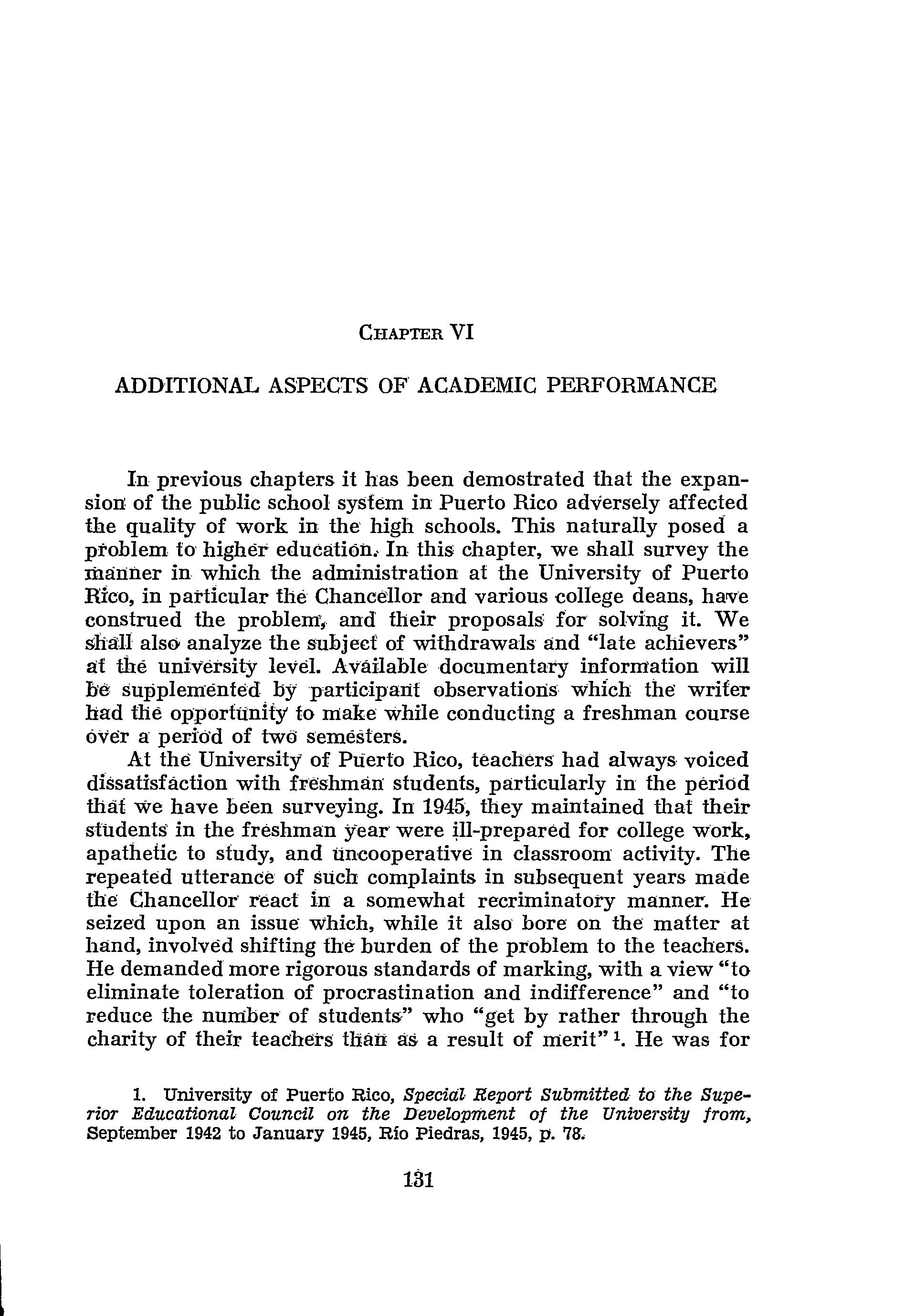
InpreviouschaptersithasbeendemostratedthattheexpansionofthepublicschoolsysteminPuertoRicoadverselyaffected thequalityofworkinthe'highschools.Thisnaturallyposeda problemtohighereducation:Inthischapter,weshallsurveythe mannerinwhichtheadministrationattheUniversityofPuerto Rico,inparticulartheChancellorandvariouscollegedeans,have construedtheproblem,andtheirproposalsforsolvingit.We shallalsoanalyzethesubjectofwithdrawalsand"lateachievers" attheuniversitylevel.Availabledocumentaryinformationwill besupplementedbyparticipantobservationswhichthewriter hadtheopportunityfomakewhileconductingafreshmancourse Overaperiodoftwosemesters.
AttheUniversityofPuertoRico,teachershadalwaysvoiced dissatisfactionwithfreshmanstudents,particularlyintheperiod thatwehavebeensurveying.In1945',theymaintainedthattheir studentsinthefreshmanyearwereill-preparedforcollegework, apathetictostudy,anduncooperativeinclassroomactivity.The repeatedutteranceofsuchcomplaintsinsubsequentyearsmade theChancellor'reactinasomewhatrecriminatorymanner.He' seizeduponanissuewhich,whileitalsoboreonthematterat hand,involvedshiftingtheburdenoftheproblemtotheteachers. Hedemandedmorerigorousstandardsofmarking,withaview"to eliminatetolerationofprocrastinationandindifference"and"to reducethenumberofstudents"who"getbyratherthroughthe charityoftheirteachersthanasaresultofmerit"1. Hewasfor
1. University of Puerto Rico,SpecialReportSubmittedto'theSuperiorEducationalCouncilontheDevelopmentoftheUniversityfrom, September 1942to January 1945,Rio Piedras, 1945,p.78:

puttingalimittothegrowthoftheinstitution,whichotherwise "mightoverwhelmallprospectsofprovidingageneraleducation forthebestqualified" Z.
In1948-49, after delvinginto theveryproblemitself,the Chancellorsuggestedadiversifiedcurriculumfortheseniorhigh schools.Heelaboratedonthissuggestioninhisreportof1949-50. Heheldthat"the•desireaswellastheneedoffullyhalfofthe (University)applicantsisnotauniversitytrainingassuch,but rather a terminal trainingwhich mayqualify them forsome usefulactivityinoursociety"3 Hefurthermaintainedthatsuch trainingcouldbebetterprovidedatthesecondarylevelrather thanattheuniversity.Nevertheless,thedemandforuniversity placescontinuedtomount.
In1953-54, the UniversityRegistrarurged caution against furtherexpansion.Heindicatedthattheriseof thefreshman intakeinthefaceoflimitedfacilitieshadalreadyobligedthe institution"tolowerthestandardsgenerallyacceptedwithregard toroomusageandsizeofclasses".Headdedthat"thequality ofteachingisadverselyaffected",andisforcingontheUniversity, "adangerousslackeningofacademicstandards"'.
Buttheextensionofuniversityeducationtothewidestlimits possiblehadbecometheaccepteddesirablegoal.Opportunities werestretchedtothepointofabolishingthesubjectrequirements foradmission,whilejuniorcollegesaretobeestablishedthroughouttheisland.Theideabehindallthisseemstohavestemmed fromtheUnitedStates'traditionoftheland-grantcollegewhich, astranslatedbytheNorth American accrediting body of the UniversityofPuertoRico,commitsthelatterto"theextension ofeducationalopportunitytothegreatestnumberofthosewho canprofittromitanddesireit"5. Itshouldbenotedthatthe Universityhadbeenassailedfor"dissipatingtheenergyandaspirationsofthePuertoRicopeopleforlearning,tothesamedegree thatitcurtailsopportunityandneglectsneed"s.Politicalforces, nodoubt,werealsoinoperation.Aswehavementionedbefore,
2.Ibid.
3.Id.,AnnualReporttotheGovernorofPuertoRico:1949-50,p.42.
4.Id.,AnnualReportoftheRegistrar:1953-54,p.5.
5.MiddleStatesAssociationofCollegesandSecondarySchools, CommissiononInstitutionsofHigherEducation,AReportontheUniversity ofPuertoRico,RioPiedras,1959,p.10.
6.JACKN.ABBoLINO,AReportonExtensionServicesattheU.P.R., RíoPiedras,1959,p.14.
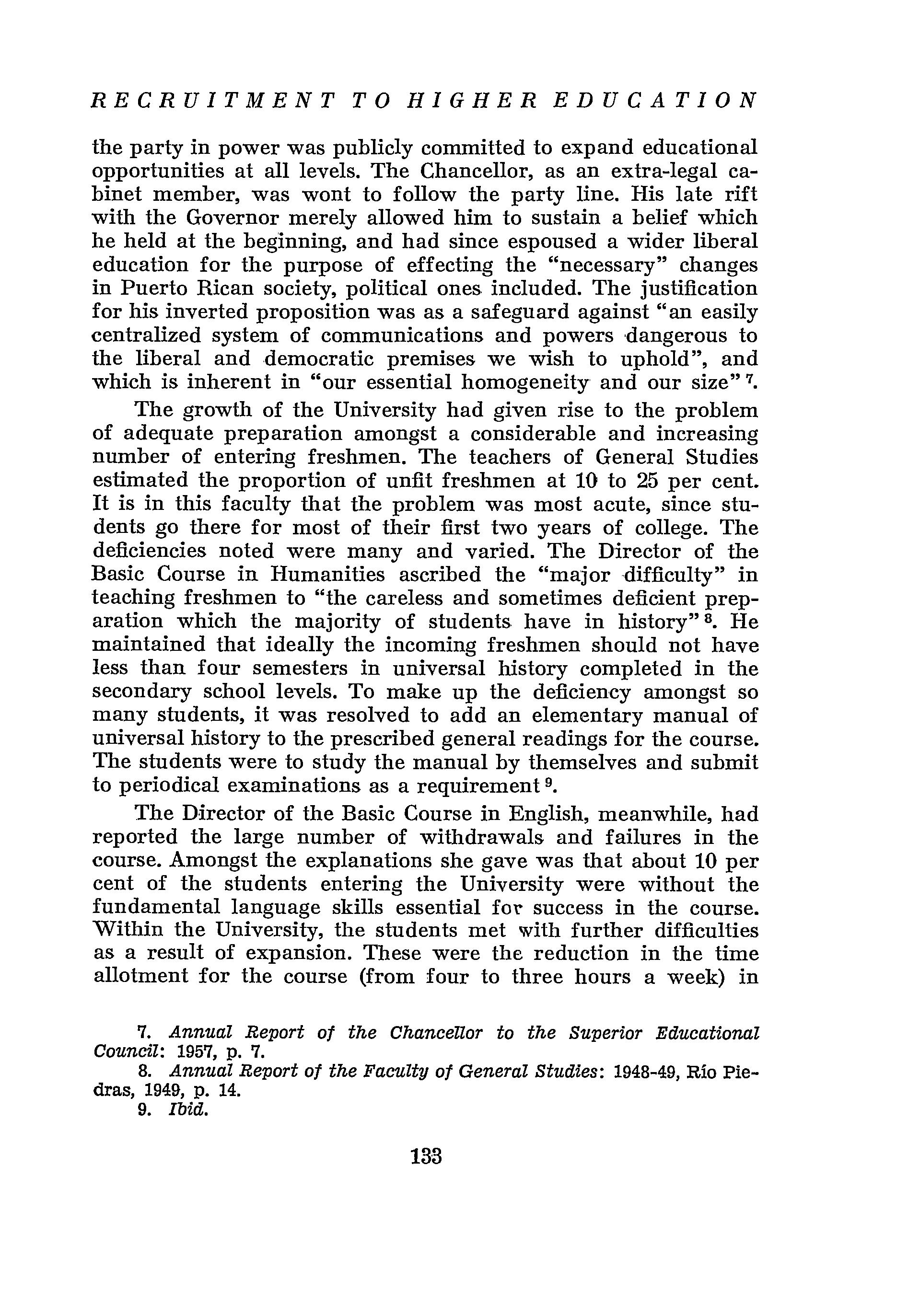
thepartyinpowerwaspubliclycommittedtoexpandeducational opportunitiesatalllevels.TheChancellor,asanextra-legalcabinetmember,waswonttofollowthepartyline.Hislaterift withtheGovernormerelyallowedhimtosustainabeliefwhich heheldatthebeginning,andhadsinceespousedawiderliberal educationforthepurposeofeffectingthe"necessary"changes inPuertoRicansociety,politicalonesincluded.Thejustification forhisinvertedpropositionwasasasafeguardagainst"aneasily centralizedsystemofcommunicationsandpowers'dangerousto theliberaland democraticpremiseswewishtouphold",and whichisinherentin"ouressentialhomogeneityandoursize" 7
ThegrowthoftheUniversityhadgivenrisetotheproblem ofadequatepreparationamongstaconsiderableandincreasing numberofenteringfreshmen.Theteachersof GeneralStudies estimatedtheproportionofunfitfreshmenat10to25percent. Itisinthisfacultythattheproblemwasmostacute,sincestudentsgothereformostoftheirfirsttwoyearsofcollege.The deficienciesnotedweremanyandvaried.TheDirectorof the BasicCourseinHumanities ascribedthe"majordifficulty"in teachingfreshmento"thecarelessandsometimesdeficientpreparationwhich themajorityof studentshavein history"$.He maintainedthatideallytheincomingfreshmenshouldnothave lessthanfoursemestersinuniversalhistorycompletedinthe secondaryschoollevels.Tomakeupthedeficiencyamongstso manystudents,itwasresolvedtoaddanelementarymanualof universalhistorytotheprescribedgeneralreadingsforthecourse. Thestudentsweretostudythemanualbythemselvesandsubmit toperiodicalexaminationsasarequirement 9
TheDirectoroftheBasicCourseinEnglish,meanwhile,had reportedthelargenumberofwithdrawalsandfailuresinthe course.Amongsttheexplanationsshegavewasthatabout10per centof thestudentsenteringtheUniversitywerewithoutthe fundamentallanguageskillsessentialforsuccessinthecourse. WithintheUniversity,thestudentsmetwithfurtherdifficulties asaresultofexpansion.Thesewerethereductioninthetime allotmentforthecourse(fromfourtothreehoursaweek)in
7.AnnualReportoftheChancellortotheSuperiorEducational Council:1957,p.7.
8.AnnualReportoftheFacultyofGeneralStudies:1948-49,RíoPiedras,1949,p.14.
9.Ibid.

ordertoaccommodatemorestudentsunderthesamenumberof teachers,thelargesizeofthesectionswhichruledoutindividual attention,andtheloweringofthegeneralgradeindexforentrance,totheUniversitylo.
TheSocialScienceDepartmentalsoalludedtoadeficiency inthesamelanguage.Thedirector"regrets"theuseofsome Englishreadings,againstthebetterjudgmentofthefaculty,who findthemdifficultfortheirstudentstounderstand,yetthereare nosuitablesubstitutesinSpanish 11 Thisinadequacyseemstohave beenbornebystudentstotheendofthebachelor'sprogramme, for,astheDeanoftheCollegeofNaturalSciencesreported,many wereundulyhandicappedintheirgraduatestudiesinmedicine ormilitarysciencesfromaninabilitytounderstandEnglish 12.
AsolutiontotheEnglishproblemevolvedfromafaculty recommendationfortheestablishmentofapre-basiccoursein English.Studentswhohadshowndifficultiesinunderstandingoral .andwrittenEnglishweretotakethecourse,forwhichtheywere nottoreceivecollegecredits.
FromtheDepartmentof PhysicalSciences,thecomplaints heardwerethoseofinadequacyinmathematics.Themeasure resortedtowassimilartothatforEnglish,.e.g.,anelementary courseinmathematicswithoutcollegecredits.Itshouldbenoted furtherthatthesameDepartment,likeothersegmentsof the teachingstaff inthe CollegeofGeneralStudies,deplored the inabilityofmanystudentstounderstandwhattheyreadandthe limitedamountofreadingtheydid 13,
ThereadinghabitsofstudentsattheUniversitywerethe subjectofcriticalcommentsfromseveralquarters.TableIshows theheartoftheproblem:thenumberofbookstakenoutper studentfrom thecirculation departmentin eachyear of our period.In1961-62theratiowastwo,oraboutfourbookslessthan thatof1942-43.Thecharacteristicallylowreadingratioobtaining
10. See AnnualReportsoftheFacultyofGeneralStudiesfor1949-50, p.10, and for1954-55, Appendix VII,p.4.AlsoAnnualReportofthe EnglishDepartmentfor1953-54,p.3-4.
11.AnnualReportoftheFacultyofGeneralStudies:1949-50,p.10.
12.AnnualReportoftheDeanofNaturalSciences:1954-55,p.7
13.AnnualReportoftheFacultyofGeneralStudies:1949-50,p.16; MemorandumfromtheDirectoroftheDepartmentofPhysicalSciences totheDeanoftheCollegeofGeneralStudiesofFebruary20,1950;Annual ReportoftheChancellortotheGovernor:1951-52,p.35-36;Annual ReportoftheDepartmentofPhysicalSciences:1953-54,p.2-3.

intheUniversitywasexplainedbythechieflibrarianasdueto "aneverincreasingdependenceontextsandmimeographedmaterialsinmanycourses"14. Helateraddedthatifthecurrent trendcontinued,"therewillbeultimatelyasamenessinthepreparationofourstudents;theywillallbegettingthesamematerialfromthesamemimeographedpamphlets,andwillhave neitherthetimenorstimulationtoforageforthemselvesamong books"15.
In1958,theCommissiononInstitutionsofHigherLearning oftheMiddleStatesAssociationofColleges.andSecondary Schoolsreceivedareportallegingthattheteachingprocessat theUniversityofPuertoRicorepresentedtextbookinstruction. In1960,theCommissiondeclaredthat"theevaluationteamdid nothaveachancetomakefirst-handobservations".Itwasunderstood,however,thatinthegeneralstudiesforundergraduates, textbookswere"notexclusivelyused".Ontheotherhand,"this maynotbetrueattheupperlevelsofundergraduatework"16
Inthesameyear,1960,FrankH.Bowlescommentedthat"all orvirtuallyallofthecoursesaregivenbytextbooksandlecture method"17. Intermsoflearningthismeantthat"astudentwho isfollovingatextbookandcollatingitwiththeinstructor'slectureshaslessstudyingandinasenselessthinkingtodoabouthis coursesthanastudentwhoisbeingtaughtbythereadinglistclassdiscussionmethod".Aswehavealreadynotedbefore, BowlesattributedthesituationattheUniversity.tothelackof instructionalsupervisionandthefactthataboutthree-quarters ofthefacultyhadnotprogressedbayondthemaster'sdegree.
Personalobservationsonafreshmangroupconfirmthe existenceofseriousdeficienciesinelementaryskillsandsubject preparationamongstnewcomersintheUniversity.IntheIntroductoryCoursetotheSocialSciences,therequiredreadings includedSpanishtranslationsofHobbes'Leviathan,Mill'sWhite Collar,Merton'sSocialStructureandotherstandardworks.At thecommencementofthecourse,theteacherdiscoveredthat15
14.Annual,ReportoftheLibrariantotheChancellor:1950-51,p.6. 15.Id.,1951-52,p.15.
16.MiddleStatesAssociationofCollegesandSecondary.Schools, op.cit.,p.14.
17.FRANKH.BOWLES,"TheHighCostofLowCostEducation".In SEYMOURE.HARRIS,ed.,HigherEducationintheUnitedStates(Cambridge: Mass.:HarvardUniversityPress,1960),p.199.

(1)Upto1954-55,theschoolyearincludesthetworegularsemesters andhalfofthesummersession(oneadditionalmonth).From1955-56onwards,itincludesonlythetworegularsemesters.
SOURCES of DATA:AnnualReports of theLibrariantotheChancellor fortheyears1942-43to1961-62.
outofhis35studentshaddifficultywithbasicSpanishvocabulary. Consequently,thefirstpartof theirassignmenthadtobeone oflookinguptheunfamiliarwordsinthedictionaryandunderstandingtheminthetext.Afterthestudentsshouldhavereada particularwork,a discussionwastofollow,revolvingonthe basicideasandargumentsoftheauthor,partlytodrawoutthe students'opinions.Thishadbeentheprescribedprocedurefor classroomteachingattheCollegeofGeneralStudies.Thediscussionmethod,however,provedinapplicabletomanyofthestudents enrolledinthewriter'ssection.Theycouldnotindicatethecentral ideas,norcouldtheydiscriminatebetweenthefundamentaland peripheralarguments.Itwasthusdecided togiveaseriesof

guidingquestionsfor eachreadingassignment and afterwards directadiscussiononthem.
Parallelsituationsweredealtwithinotherwaysbyother teachers.Someoptedtoconductapreliminarydiscussionwith capablestudentsandleavetheresttolistenandpickthemain threads.Otherslecturedoneveryparticularreading,givingtheir ownviewsandarguments,andthentriedtopromoteadiscussion alongthoselines.
Amongstthesectionhandledbythewriter,nomorethan 10studentsparticipatedinthediscussionduringeachclassroom period.Therewastheextremecaseof awomanstudentwho burstintotearsonthedayshewascalledupontogiveherviews withregardtothetopicunderdiscussion.Sheexplainedthatshe hadreadtheassignedarticlethreetimesbutjustcouldnotgrasp whatitwasallabout."BythetimeIreachthethirdpage",she groaned,"Ihaveforgottenwhatissaidonthefirstandsecond". Forfourmonths,.fortwohourseachweek,theteachermether andtwootherstudentswiththesamedifficultyinordertoteach themhowtoreadforunderstanding.
Amongst thesamegroup of freshmen, the ability to put thoughtsinwritingwasalsorverypoor.Anessaytypeof test was announced by the teacher and was met with vehement protests.Thestudentsarguedthatitwasunfairtogivethemthis typeoftestastheyhadhadnotrainingforit,beingaccustomed tothe"objective"methodsof measurement,such asdeciding betweentrueandfalsestatements,fillinginblanks,andmultiple choice.Theteacher,nevertheless,insistedongivinganessaytest. Thestudentswereconfirmedintheirobjections.Theirgrammar, aswellastheirspelling,wasverypoor;sowastheirhandwriting. Worstofall,theirideasastranslatedonpaperwerelackingin coherence,organization,andsequence.Four-fifthsof theclass wereinthisplight;theremainingone-fifthwerethefewwho passedinthatfirstessaytest.Theteacherwasthusobligedto spendsomeoftheclassroomtimeorientingthestudentstothe simplewaysof lucid presentation and logical argumentation. Moreover,hesentthedefectivestudentsforcorrectivehelpto ateacherwho,inhersparetime,wasgivingashortcoursein Spanishgrammartoagroupoffreshmenhavingsimilardifficulties.Itshouldbenotedthatfiveyearsago,freshmenwere groupedforthefirsttimeaccordingtolevelofability,soasto facilitatethetypeofremedialassistancéwehavejustreferredto.

Theywereclassifiedintohonor,intermediateandpoorsections accordingtotheiradmissionindexpercentiles.
Itispartlyowingtotheseprevalentfreshmandeficiencies thatmostofthecoursesinGeneralStudieshadbeencircumscribed withinasetofrequiredreadings.Inpractice,littleornoextra readingwasdonebythestudents.Thelecturesweredesigned generallytosupplementtheclassdiscussionswithotherideasand pointsofview,andquiteoften,merelytogivethestudentsinformationbasictotheunderstandingoftherequiredreadings.The timeschedulesetbythecorrespondingdepartmentfortheselectionsinagivencoursewasnotusuallykept.Ithadbeen necessaryformanyteacherstocompensateforthelackoftime withextrameetingswiththeirstudents.
Theextentoffreshmanacademicshortcomingsandthedilemma ofuniversityeducationatthislevelwasunderscoredbythe ChancellorinamemorandumtothefacultyatRioPiedras.He affirmedthatinstructionattheuniversitylevelshouldbeable toproceedtowards"thefulfilmentofitsowninstructional responsibilities".Hecontinuedtosaythatthiswaspossibleonly when"asignificantbodyofintellectualhabitsandmeaningful knowledgehavealreadybeenattainedbycandidatesbeforethey qualify,foradmissiontotheuniversity".Hethenconcludedthat "sincethisisnottruetotheextentitcouldandoughttobetrue... animportantpartoftheuniversityprogrammeisandperforce mustberemedialincharacterandbelowcollegiatelevelinnature"18.
Thusheputthesealonameasurewhichteachershadbeen obligedtoresorttoinanefforttokeepmanyfreshmenabreastof thebetterpreparedminoritywithinanalreadycircumscribed curriculum.Asheexpressedhisnewresolution,"non-university creditcourseswillbepreparedandofferedasadditionalsafeguardstoinsurebringinguptheregularfreshmanyeartoits morefittingtasks" 19,
Wehavejustseenhowtheexpansionoftheuniversitylevel hadaffectedthequalityofincomingfreshmen.Ithadresultedin theadmissionofstudentsunfitforcollegework,forwhom non-creditpre-collegiatecourseswereprescribedattheuniversity itself,andforwhomthecollegerequirementshadineffectbeen
18.JaimeBenítez,"Circularn.°36alclaustrodeloscolegiosdeRío Piedras,3deoctubre,1960",p.6. 19.Ibid.
1944-45

HighSchool Grades
increased.One.querieswhetherthistypeofremedialworkought to be done in college, considering the expense involved in universityeducation.
Withthisproblemof deficientfreshmenenteringtheuniversity,itissurprisingthattheproportion,offailuresamongst themhadnotbeengreaterthantheonepercentnoticedalmost throughouttheperiodunderstudy.(SeeTable2).Werecallat thispointthequalityofperformanceintheentranceexamination whichhaddiminished duringthesameperiodamongstpublic highschoolgraduates,orthemajorityof thosewhoobtained admission.Wealsocallattentiontotheseriousproportionof drop-outswhichhadoccurredinthehigher.collegiatelevels,past thefreshman,andwhichwillbedescribedsubsequently.

The proportion of C's amongst freshmen had remained almostthesamethroughoutourperiod,withthatofB'sslightly increasing.Comparingthefreshmangradeswiththoseofthehigh schoolgraduates,wenoticeatendencyto"downgrade"AandB freshmenandtoconcentrateattheClevel.Thus,whiletheA-grade fréshmen represented23percentof the A-gradehighschool graduatesof1944,thisproportionwasreducedto18andnine percentofthoseof1952and1960respectively.Thesametendency wasnoticedamongsttheBfreshmen,althoughlessmarked.This distribution of grades in the first collegiateyear might have followedthenormalcurveprinciple,reflectingthegreaterresistance amongst college teachersto give A's and B's and their strongerinclinationtowards"ahappymedium".ThedepartmentalexaminationsgivenintheCollegeofGeneralStudiespresent acaseinpoint.
Thoseexaminationsweretakenbythefreshmanstudents regardlessofsectionsandattheendof eachsemestralcourse. Theywere drawnupbyacommitteefor eachsubject-course, scrutinizedbytheentiredepartmentconcerned,andadministered byaproctor.Aftertheexamination,thepaperswerereturnedto theteacherswhotookchargeofcorrectingthoseoftheirrespective sections.Thisexaminationhadavalueequivalenttotwo-thirds ofthefinalsemestergrade.Theremainingone-thirdwasderived fromtheperiodicaltestswhichtheteacherwassupposedtohave givenhisstudents.duringthesemester.Thewriterrecallssome incidentsinDepartmentXwhichmighthaveaffectedthegrade distributionin1960-61.Aftertheexaminationhadbeengiven, the faculty concerned discussed the possible answers to the questions.In notless than teninstancestheyfailed to agree amongstthemselves,whereuponitwasruledthatthecontroversial questionsweretobeeliminatedfromtheconsiderationof the examinationresults.Moreover,beforetheexaminationwasgiven,. astandardhadbeensetbywhichastudentwhohadanswered correctlylessthanhalfofthequestions(allwereoftheobjective type)wastofail.Aftertheexamination,thisstandardwentbythe board.Eachteacherhadalreadypreviouslyratedhisownstudents, andintheplottingofthenomalcurvedistributionforthewhole department,hewouldnaturallytrytoinfluencethescalingsoas tohaveasfewfailuresinhisclassaspossible.Acompromisewas. reached,wherebythetoplimitswereraisedandthebottomones lowered.Thismanipulationoftheexaminationgradedistribution couldhavebenefittedonlythelow-scoringstudents,makingif

easierforthemtogetapassinggrade.Similaroccurrencesseemed tobetakingplaceintheotherdepartments.
Itshouldbenotedfurtherthatalthoughageneralgrading scalewasadoptedforthedepartmentalexamination,nosuch schemewasprovidedforthefinalgradingofallstudentsina particularsubject.Thuseachteachertreatedhisownsectionas aseparategroupofnormaldistribution.Oneeffectofthiswas inevitablyadifferingvaluationofthesamefinalgradescore amongstthevarioussections.Itthenfollowedthatgood-grade studentswouldusuallyrefusetoenrolin"top"sections,where theyallegedtheywerelikelytogetalowergradethanifthey wereinanintermediateorlowsection.Toencouragesuchstudentstoentertheirrespectivesections,aprocedurewasadopted wherebyanyofthemreceivinglowerthanAinatopclasswere enteredintherecordsas"passedwithhonours"andnotcomputableforuniversityaverages.Nonetheless,studentsinthepoorer sectionscontinuedtobenefitfromthemanipulationofthegrading scale.
Anotheraspectofacademicperformancewhichweshallexaminehereisthewithdrawalofstudentsfromcollege.Inthisstudy, acollegewithdrawalisdefinedasastudentwhoenteredthe universityandleftitbeforecompletingthebachelor'sprogramme, andupto1960-61hadnotreturnedtofinishthedegree.Thusa studentreturningtocollegeafteranabsenceofmanyyearsis notconsidereda wi₹hdrawal, if at any time before 1961 he had finished the four-year degree for which it is assumed he had originally matriculated. The words "withdrawal", "drop-out", and "leaver" are used synonymously here.
The problem of college withdrawal is in part an extension of the problem afflicting the lower educational system in Puerto Rico. As we have repeatedly pointed out, throughout the period surveyed, a large proportion of students entering school did not finish the six-year elementary level. The proportion of drop-outs in college had been almost equally large and just as continuous. In 1955, the Superior Educational Council published some figures relating to the students who started the first year in college and the proportion which reached the last year 20. However, no distinction was made between students who matriculated in a four-year curriculum and those who went into a two-year course.
20. Consejo Superior de Enseñanza, Análisis de la matrícula universitaria y sus proyecciones en el futuro, Río Piedras, 1955, p. 70-75.

Thisposesthefurtherquestionofwhetherastudentwhoentered atwo-yearcurriculumanddidnotproceedbeyonditshouldbe consideredaleaver.
AsubsequentstudymadeattheRegistrar'sOfficeoftheUniversityofPuertoRicoconfinedthestatisticstostudentsinthe bachelor'sprogrammeduringtheperiod1955-60.Itshowsthat between45and50percentíof thefirst-yearstudentsdidnot reachthesenioryear 21,
Inthissection,weshallanalyzecollege-leavinginrelation tosex,urban-ruralresidence,highschoolpreparation,type,locationandsizeofhighschool,occupationalstatus,andcollegiate academicperformance.Onlystudentsofthe1944and1952classes willbeconsideredsincethoseof1960willnotgraduateuntil1964.
Ofthosetwoclasses,45.2and48.5percent,respectively,did notfinishthebachelor'sdegree,oraratiooffivewithdrawalsout ofeverytenenrollers.In1944therewereproportionatelymore maledropoutsthanfemale;butin1952thewithdrawalsamongst bothsexesboreadirectratiototheirdistributioninthefreshman class.Similarly,theresidential distinction between urban and rural seems to have had no bearing on the distribution of withdrawals,both regions manifestingthesameproportionate distributionforbothyears.Inotherwords,theruraldwellers, oncetheyhadenteredtheuniversityhadasmuchéhanceasthe urbanresidentsforfinishingacollegiatecourse.
Therelationbetweendrop-outsandtypeofhighschoolwas alsoinsignificant,althoughtherewasatendencyamongstpublic andprivatedenominationalschoolstobeover-represented.The sizeandlocationofthepublicschoolsalsodidnotaffectcollegedropping.
Thenumberof drop-outs,however,did tend tobelarger amongst thosewho had completed the minimumhighschool graduationrequirementof'16units.Therelationtoparticular subjectsseemsonthewholeinsignificant,butforthosewhohad completedmoreunitsinSpanish,mathematics,andscience,the chancesforcontinuingseemedtobegreater.
Thédistributionofleaversbyoccupationalstatusbearsa directproportiontotheoccupationaldistribútioninthefreshman class,althoughin1944therewasaslightover-representationof
21.CÁNDIDOOLIVERASyJAIMEBENÍTEz,InformealaAsambleaLegislativadePúértoRicosobreColegiosRegionales,RioPiedras,1962,last tableinthéappéndb(n: p.).


thefarmerclass,andin1952,ofsmallbusiness.Thus,likethe residential factor, the occupational factor ceased to operate againstanyparticularsocialsegmentofthestudentpopulation oncetheuniversityhadbeenentered.
However,inrelationtothehighschoolgraduation index, withdrawalswerefoundtobemorefrequentamongstthelow quintiles,infact,thehigherthequintilethelessfrequentthedropouts.Thesamerelationshipwasseenwithrespecttotheentrance examinationscoreandthegradesattheendofthefreshman year.Hereagain,thelowertheexaminationscoreorthefreshman gradesthegreaterthechancesforastudenttoleavecollege. (SeeTable3).
AmongstthecollegesintheUniversity,SocialSciencesand Pedagogywereregisteringwithdrawalsproportionatelysmaller thantheirfreshmanintake.Moreimportantistheincreasingratio of leavers amongst "programme transfers" or students who shiftedfromthebachelor's curriculum in Río Piedras to the agriculturalandengineeringcoursesinMayagüez,ortotheextensionand two-yearcurriculum,or totheso-calledirregular programmes.The proportion of drop-outs amongst them was approximatelytwicethatamongstthefreshmenforboth1944-45 and1952-53,orarateofincreaseamongstdrop-outsbetweenthe twoacademicyearsindirectrelationtotheirenrolmentratein thefreshmanyear.
Wemaythusconcludefromourshortsurveyofwithdrawals thatthisproblemisacademicrather thansocial.Unpublished datacollectedbytheCóllegeofBusinessAdministrationcovering allstudentswhohadwithdrawnfromtheUniversityfor each oftheacademicyearsfrom1958to1962,irrespectiveofcollege orcurriculum,tendtoconfirmourfindings.TheStatisticsDivision of that College, through questionnaires and interviews,found thatthemostfrequentreasonforleavingcollegewasacademic, orafailuretocopewithcollegeworkforwhichstudentswere suspendedorwhichtheythemselvesrealizedandwhichledthem towithdraw 22. Oneotherconsequenceofthesituationmaybe
22.UnpublisheddataobtainedthroughthecourtesyofProf.,Cooney oftheCollegeofBusinessAdministration.Theyshowthat63.2percent ofthestudentswhodroppedin1961-62didsoforacademicreasons,(299 outof473).Fortheperiod1958-59to1961-62,suchstudentsaccounted for56percentofalldrop-outs(1115outof1991).Otherreasonsfor withdrawalwerepersonalhealth,sicknessinthefamily,opportunityto work,"personalproblems",andeconomicnecessity.

inferred.Totheexpansionoftheyearlyfreshmanintakeand therecruitmentofunqualifiedstudentsatthislevel,theUniversityhad responded by tightening the academicscrews which beganinthesecondyearandultimatelyeliminatednearlyhalf ofeachincomingfreshmangroup.
Inconcludingthissection,weshallstudywhatwepropose tocallthe"lateachievers",usingthesameformsofdistinction asthosefor"withdrawals"."Lateachievers",forwantofabetter term,arethosewhotookmorethanfouryearstofinishafouryearcurriculum,evenifthismeantonlyanadditionalhalfyear. Someofthemstretchedtheirstudyoveralongerperiod,enrolling inoneormorecoursesatatimeandneverdroppingfromthe registrationroll.Othersinterruptedtheirstudiesatleastonce aftertheinitialmatriculation.Thisclassofstudentsrepresents 41percentofthegraduatesfromthe1944freshmangroup(139 outof336),and39percentfromthe1952group(119outof299).
Betweenthesexes,theproportionoflateachieverswasheavier onthesideofthemales,anover-representationwhichwasmore markedin1952thanin•1944.Betweenruralandurbandwellers, theoccurrenceoflateachieverswasmorefrequentamongstthe former,withthoseof themetropolitan areascompletingtheir degreeinfouryearsorlessinproportionatelylargernumbers thantheirenrolmentinthefreshmanyear.Butthedifference wastoosmalltobesignificant.Thetype,sizeandlocationof highschools,secondarypreparation,andfather'soccupationalso borenosignificantrelationtotheincidenceof lateachievers, althoughin1944thistypeofstudentseemedtobemorecommon amongstchildrenoflowerwhite-collarandsmallbusinessmen, andin1952amongstthesemi-skilledandunskilledfamilies.High school graduation index, entrance examination score, and freshmangradesmadenosignificantdifference.Butonthebasis oftheuniversitygraduationindex,delayedgraduationseemed tobemorecommonthelowerthequintile.Thistrendwasmore clear-cutin1952thanin1944.Itsuggests,moreover,theretardative effectofthegradingsystempastthefreshmanyearonthedelayed achievers. Studies were discontinued once or more before finishingthebachelor'sprogramme,andasinthecaseof the withdrawals,thereasonwas,mainlyacademic.Infact,thestudents'difficultiesincreasedastheyclimbedtheuniversityladder. Thustheminimumgradeindexrequirementforthefreshman yearwas1.4,forthesophomore1.7,junior1.8,seniorandfifth

ACADEMICPERFORMANCEOFSTUDENTSWHOTOOKMORETHANFOURYEARSFINISHING
year1.9,andforgraduation2.023 Thenatureofthesituation wasfurtherclarifiedbytheRegistrar'sOfficewhichshowedthat in1952-53and1953-54,three-quartersofthesuspensionsforacademic deficiencies were amongst students with the minimum freshmangradeindex.
Amongstthecolleges,Business,NaturalSciences,andHumanitieshadthelargestproportionoflateachieversin1944.In1952, allexceptBusinessexperienceddrasticreductionsintheirproportionsofthistypeofstudents.Inthatyear,41percentofthe graduatesinBusinesstookmorethanthecustomaryfouryears tofinishthedegree,againstthesome25percentinPedagogy, SocialSciences,andPharmacy 25
Inconclusion,thesituationoflateachieversintheUniversity isparalleltothatofdrop-outs.Theunderlyingfactorisacademic ratherthansocial,operatingpastthefreshmanyearandincreasing instrengththroughthehigherlevelsofuniversitywork.

23.UniversidaddePuertoRico,BoletínInformativo,RíoPiedras, 1960,p.81.
24.Idem,InformeAnualdelRegistrador,1953-54,RíoPiedras,p.10.
25.CalculationsforPharmacywerebasedonthosestudentswhotook morethanfiveyears.

Thevarious analyseswehavecarried outwithregard to freshmenenteringtheUniversityofPuertoRicohavepermitted ustodrawattentiontocertaindistinguishingcharacteristicsof thecollege-goinggroupintheislandandtodivergenciesexisting withinthisgroup.Ournextproblemisto ascertain howthis group,aftertheyhaveenteredandpassedthefreshmanyear, distributethemselvesamongstthecollegesintheUniversity.Is thereaclusterpatterninthisdistribution?Inotherwords,do freshmenwhohaveoptedforaparticularcollegehaveanyset oftraitsthatdistinguishesthemfromthosewhoelectanother college?Weshallmeasurethesecharacteristics again byhigh schoolorigin,secondarypreparation,residence,father'soccupation,andsex.Inaddition,weshallusetheentranceexamination scoreandthefreshmanindextomeasure"quality"inthedifferentcolleges.
Thislineofinquirymayinturnenableustothrowsomelight onthepatternofrecruitmenttotheprofessionswhichdrawprincipallyfromthegraduatesofthestateuniversity.
Asinpreviousanalyses,thedataonwhichthediscussionof thevariouscollegesisbased represent theuniverse of three freshmanclassesattheRioPiedrascampusandbearonthethree academicyears1944-45,1952-53,and1960-61.ThedatawereespeciallycollectedbytheauthorfromexistingrecordsattheRegistrar'sOfficeoftheUniversityofPuertoRico.
First,weshalldescribethetrendsintotalenrolmentinthis campusbycolleges.Ourpurposehereistoascertaintowhat extentcurriculumchoiceinthesophomoreyearcorrespondsto thecollegedistributioninthetotalenrolment.

(1)Doesnotinclude3studentstransferredtotheMayagüezCampus, 24withclassificationofIrregularorExtension,19transferredtotwo-year courses,nor66whodropped-outbeforethesophomoreyear.
(2)Doesnotinclude85studentstransferredtotheMayagüezCampus, 46withclassificationofIrregularorExtension,92transferredtotwo-year courses,nor141whodropped-outbeforethesophomoreyear.
(3)Doesnotinclude29studentstransferredtotheMayagüezCampus, 14withclassificationofExtension,109transferredtotwo-yearcourses, nor200whodropped-outbeforethe,shophomoreyear.
AmongsttheLiberalArtsfaculties(excludingGeneralStudies), Humanities and Social Sciences made proportionate increasesinthetotalenrolmentduringtheperiod1940-1960,while NaturalSciencesdecreaseditsrepresentation.Amongsttheprofessionalfaculties,BusinessAdministrationaloneexpanded,while Pedagogy and Pharmacy both declined. The proportions of freshmanintakeinthecollegesshowedanalogoustrends,except Humanitieswhere thepullonfreshmenincreased at amuch greaterratethanthatseeninthecollege'srepresentationinthe totalenrolment.
HowcanweaccountforthisgreatstrideinHumanities?We havenoprecisedataonwhichtodraw.Itmighthavebeenin parttheresultofthehumanisticorientationintheCollegeof GeneralStudieswherefreshmenspendtheirfirstyearofcollege

education.Here,eventhesciencecoursesareapproachedasbasic coursesintheHumanities.Furthermore,itshouldbenotedthat thenumberofrequiredcredithoursingeneraleducationincreased from36in1952to54in1960.Fromtheirimmersioninthistype ofpreparationitmightbeexpectedthatthestudentswouldbe drawntotheliberaldisciplines.Andsincethetwootherliberal colleges,NaturalSciencesandSocialSciences,areprimarilypreprofessional,therelativelygreaterexodustothemostavocational ofthecolleges,theHumanities,wouldbeunderstandable.Itmight alsobeaddedthatthecollegehasbecomethedomainofupperclassgirls,andtheacceptedvogueamongstthisclassistogeta collegeeducationwhichisasavocationalaspossible.
However,the"liberal"influencesofGeneralStudieshadnot beenstrongenoughtodivertstudents'interestfromBusiness.The rushtothiscollegemaybetakentoindicatetheincreaseddemand by government agencies and private corporations for trained personnelin thefield of business.The underlyingfactorwas beyonddoubttheinitiationanddevelopmentofawideprogramme of industrialization. For the students who have their sights onfutureemployment,thegreatopportunitiesandthehighpay mustbetheprincipaldrawingpoints.Theexpansionofthecollege mayalso reflect thegrowing needfelt byupper-classfathers tohavetheirsonstrainedinsuchoccupationsaswouldpermit themtoparticipateinthebusinessandcommercialconcernsbeing openedupintheislandbyAmericancapital.
AsforPharmacy,thecollegewiththelargestproportionaldecreaseinfreshmanenrolment,somereasonshadbeensuggested bytheprofessorsthemselvestoexplainsuchacontraction.One might be the lengthening of the course from four to five years in 1949. Another might be the decline of the pharmacist's prestige. In previous times, when doctors were scarce, the pharmacist was called upon to write prescriptions as well as to fill them. With the organization of the medical profession, the opening and expansion of a medical school, and the proliferating supply of doctors, the medical services were more and more confined to the qualified graduates, while the pharmacists became reduced to the status of store attendants or salesmen. Besides, the small twoyear difference between the medical and pharmaceutical courses must have persuaded many students to turn to the former and try to break into one of the highest professions.
We are on less certain grounds in interpreting the trends noticedin Natural Sciences and Social Sciences. The former College

attracted the largest proportion of students in 1944. Between thisyearand1960,itscomplementof universityenrollees decreasedrelativelyandfelltothelevelofHumanitiesandPedagogy.Someof theteachersexplainedthistrendbyindicating that thecollege ismainly preparatory, pre-medical, and that althoughmedicinestillistheidealgoalofmanystudents,the difficultiesintheprofessionandtheconsiderablelengthofacademicpreparationmusthavelednumbersofstudents ₹o turn to the otherprofessions, such as accounting, which are as "profitable" and require a shorter period of college education. Still others think that the traditional "image of the college" —one where students have to work hard for long hours under tough teachers and are subject to many frustrations— has put many a student to flight. These explanations, of course, would require substantiation by additional data before they could be accepted unqualifiedly, and these data we do not have.
The College of Social Sciences could be seen doubling its proportion between 1940 and 1952 and then decreasing it slightly by 1960. Nevertheless, the overall trend was one of increase. The 1952 expansion might have been associated with the relatively high demand for personnel with some training in the social sciences to take the new job opportunities offered in the various government agencies. It was further felt amongst the teachers in the college that the decrease in such job opportunities had produced a corresponding decline in the demand for graduates of the college. They indicated that the most common complaint amongst Social Science graduates who do not proceed to Law or any graduate studies, is the lack of employment facilities. Many turn to teaching instead.
Let us now look into the characteristics of the freshman students who chose the different colleges. We begin with ₹he social class composition of each college and the changes it had been through over the period under study. As before, our index for class is the occupation of the students' fathers.
In the College of Humanities, the high-status occupations tended to predominate while low-status occupations continued to reduce their ratio sharply. The trends amongst upper-class groups were, however, not uniform throughout. We find that the professional and white-collar groups trebled their representation between 1944 and 1960. The "small-business" groups remained constant, while the semi-professionals experienced small decreases.

OCCUPATIONALCOMPOSITIONOFSTUDENTS'FATHERS INTHECOLLEGEOFHUMANITIESBYYEAR
Amongstthelowerrungsoftheoccupationalscale,theurban manual workers decreased their representation between 1944 and1952andcontinueddeclininginthenextdecade.Therural occupationsalsoexperiencedaconsi,stentdecreasethroughout, buttherateisslighter.
Thetrendbysexwasoneinwhichthewomenpredominated in1960-61;55percentasagainst45percentofmen.Thisyear alsosawanincreaseinthemetropolitanresidentsenrolledinthe college,augmentingtheirproportionfrom52percentin1944to 62percentin1960.Meanwhile,theruraldwellersremainedabout thesame,whiletheurbanonesexperiencedacontraction.Also noticeableinthe1960yearwastheincreaseofstudentsfrom privatedenominationalschools.Thisexpansionwasattheexpense ofpublicschools,andevenmoresoofprivatenon-denominational schoolswhichsufferedadrasticreduction.
Inconclusion,wemaysaythatby1960thefollowingfundamentalchangeshadoccurredintheCollegeofHumanities.Ithad becomethedomainofupper-classstudents,whoweremostlymetropolitan dwellersandwomen, andincreasinglythechoiceof graduatesofprivateratherthanpublichighschools.
TheCollegeofNaturalSciences,likeHumanities,appearsto havebeenpredominantlythechoicealsoofhigheroccupations, althoughthesegroupsshowedfluctuationsthroughouttheperiod..

Duringthetwodecadescoveredbyourstudy,theprofessionalgroupsdoubledtheirrepresentationintheCollegeofNatural Sciencestobecomethedominantgroup.Thelowerwhite-collar alsodoubledtheirproportioninthedecade1940to1950,but remainedconstantbetween1950and1960.Meanwhile,thesemiprofessionalgroupswhichhadthelargestproportionof allin 1944werecharacterizedbysmalldecreases.Thoughin1960their proportionwassmallerthanin1944,itrepresentedanimprovementover1952.Thesmallbusinessgroup,meanwhile,maintained itsposition.
The urban manual class, which constituted an important sourceofrecruitmentofNaturalSciencestudentsin1914,experiencedadecreasein1952andfromthenonremainedthesame. Theruraloccupationsalsoexperiencedadecreasein1952,and hadsinceremainedunchanged.
UnlikeHumanities,theCollegeofNaturalScienceswaspredominantlymalethroughout.Yet,theproportionoffemaleenrolleeswasnoticeablyontheincrease.Whilein1944-45thefemalescomprised30percentoftheenrolleesandin1952aslightly
smallerproportion,thefigureroseto47percentin1960.This mayhavebeenduetothefactthatNaturalScienceshadstarted sincetheturnofthefiftiestohelptheSchoolofTropicalMedicine preparefor`someoccupationswhichwereatractivetowomen: nursing,physicaltherapy,andmedicaltechnology.
Thetrendinthiscollegewas.algoforthenumberofstudents fromthemetropolitanareastoincrease.Theirproportionrose from52percentin1944to60percentin1960,whiletherural onesremainedaboutthesameandtheurbanitesdiminished.
ThetrendforpublicschoolenrolleesintheCollegeofNatural Scienceswasoneofcontinuousdecrease,althoughtheycontinued tobethepreponderantelement.Meanwhile,bothtypesofprivate schoolsexperiencedconsiderablegains,withtheprivate-denominationaltakingupthebetterpartofthosegains.Thisfinding certainlyrelates'tothefactnotedearlier,inthesectiononstudent preparation,thatstudentscomingtotheUniversityfromdenominationalschoolshadnotablyimprovedintheirsciencepreparationduringthelastdecade.Thisisdue,undoubtedly,tothe effortsoftheseschoolstoexcelinthisarea.
ThepicturethatemergesontheCollegeofNaturalSciences for1960isonewheretheupper-classeswererisinginimportance. Thefemaleshadbecomeasubstantialelementinitsenrolment, eventhoughthemalesstillremainedinthemajority.Moreover, bothmetropolitanresidentsandprivatehighschoolgraduates weregainingtheupperhand.
TABLE4

ofEnrolmentinCollegeByYear

InSocialSciences,theoccupationaldistributionofthestudents'fathersisillustratedintable4.
Inthiscollege,theupperurbannon-manualclasseswereall ontherise,exceptthebusinessgroup,whichfellbyahalfduring theperiodasawhole.Theruraloccupationgroupalsocontracted, though it recovered by1960, unlike the urbanmanual which diminishedbyathird.
Taking the college'scomposition bysex,we found slight differencesatfirstbetweenmalesandfemalesinfavourofthe former. In 1960, however, female representationsoared to a two-thirdsmajority.Theestablishmentofthegraduateschoolof SocialWorkmighthavegivenanimpetustofemaleenrolment inthecollege.
As with the two other colleges already described, Social Scienceshadthegreatestconcentrationofmetropolitan-dwelling students,butunlikethem,theruralenrolleeswerelessstrongly representedandmanifestlyonthedecline.Thesediminishedtheir representationbyahalfbetween1944and1960.Howdoesone accountforthisapparentlycontradictoryfindingwhenrelated toruraloccupations, amongstwhoma relative constancywas foundthroughout?Thismaybeexplainedpartlybythefactthat substantialfarm-ownersmovedtoRioPiedrasornearbytowns whentheirchildrenstartedattendingtheUniversity.
LikeNaturalSciencesandHumanities,theenrolleesinSocial Science throughout were predominantly graduates of public schools,butthesewerealsocontinuallydiminishingtheirrepresentation.Ontheotherhand,theprivatedenominationalschools doubledtheirsfrom10percentin1944to20percentin1960, withtheprivatenon-denominationalretainingitsposition.
InrelationtotheCollegeofBusinessAdministration,wecan seeinTable5that it had becomeincreasinglya collegefor childrenofhigh-statusoccupationsliketheCollegeofHumanities. Theexpansionoftheprofessionalsbetween1944and1960was considerable;thatofthelowerwhite-collarwasevenmore.On theotherhand,thetwoothersub-groupsoftheurbannon-manual class,thesemi-profesionalandsmallbusiness,wereprogressively losinggroud.Asregardthelower-rankingoccupations,theurban manualworkerscontinuedthroughouttoholdtheirown,while theruraloccupationsweresuccessivelyonthewane.
UnlikeHumanities,theCollegeofBusinessAdministration remainedamalepreserve,andalthoughtheoverallproportion of female enrollees in the Universityhad risensharply,this.
elementaccountedforonly33percentin1960intheCollege.To putitdifferently,wecansaythattheuppermiddle-classeswho hadbeensendingtheirchildrentotheUniversityofPuertoRico had tendedincreasinglyover theyears tosend theirsonsto NaturalSciencesandBusinessAdministrationandtheirgirlsto Humanities.
Usingtheplaceofresidenceasmeasurement,wefindthat the Collegehadremained remarkablystable throughout,with slightlyoverahalfofitsstudentbodyfrommetropolitanareas, 38percentfromotherurbanareasand7percentfromrural onesin1960.Incommonwiththeothercolleges,recruitmentwas pre-eminentlyfrompublicschools,eventhoughthetrendwas oneofprogressivedecline.Theprivatedenominationalstudents wereseentohaveexpandedagain,whiletheprivatenon-denominationalretainedasteadyrepresentationfrom1944.
In Puerto Rico, as in many other countries, at present andinthepast,theCollegeofPedagogyhasbeenthecollegeof lower classes,,women, and rural dwellers. It has been their instrumentofupwardmobility,bringingthemtotheloweredge ofthewhite-collarclass.Thiswasmuchmorepalpablein4960 thanithadbeenthroughoutthetwoprecedingdecades.ThedeclineinfreshmanintakeinPedagogycouldindicateawaning intheappealoftheprofessionforwhichitgivesacademicpreparation,particularlyamongstchildrenofwell-placedparents.

OCCUPATIONAL
PercentOccupationalGroupRepresents ofEnrolmentinCollegeByYear
Thetablesprovidefurtherdetailsofthesituation.Table6 showsthatPedagogyhadhadsofar thebiggest aggregateof studentsfromlowerclassfamilies. Of the urban non-manual occupations,onlythelowerwhite-collarshowed anincreasing representationbyslightlydoublingitsproportionbetween1944 and1960.Theprofessionalsremainedalmostthesame,whilethe semi-professionalsreducedtheirs.Thelargestshareoftheurban non-manualclasscamefromsmallbusiness,buteventhesewere withdrawing.Themoststrikingofthefigureswerethoseofthe urbanmanualworkerswhocontinuallyexpandedtheirposition inthecollege.
OCCUPATIONALSTATUS 1944-45
OFSTUDENTS'FATHERS

Asmightbeexpected,thecollegeleanedheavilyonitsfemale population.Ournexttablesshowthatthecollegeagaindiffered fromtheothersbythepredominanceofurbanandruralrather thanmetropolitandwellers.Theonlyothercollegeinwhichthis wastruewasPharmacy.Pedagogyfurthersurpassedalltheothers, initsconcentrationofpublichighschoolgraduates.Concurrently, therepresentationoftheprivateschoolswasalsothemostmeagre, although,incommonwithmostoftheothercolleges,theprivate denominationalwereprogressivelyincreasingtheirnumbers.
TABLE7
PLACEOFRESIDENCEOFSTUDENTSINTHECOLLEGE OFPEDAGOGYBYYEAR

SCHOOLOFORIGINOFSTUDENTBODYINTHECOLLEGE OFPEDAGOGYBYYEAR
Fromtheabovefindings,wemaydrawanumberofconclusions bearing upon the "quality" of the teaching corps, althoughthisqualitydoesnotnecessarilyreflectinherentability. Itisveryprobablethatruralandworking-classstudentssuffer fromeducationaldisadvantagesbothathomeandintheschools availabletothem.Ifthecorpsofteachersisrecruitedincreasingly fromtheseeducationallyhandicappedgroupsofcollegestudents, aviciouscircleofdecliningqualitywillbeatworkintheschools.

Nothingdeterminesthequalityofaschoolsystemassurelyas thequalityofitsteachers.
ThesituationintheCollegeofPedagogyisperhapsthemost significant of all,raisingcertainfundamental questionswhich oughttoaffectfutureeducationalplanninginPuertoRico.How canstandardsberaisedinapublicschoolsysteminwhichthey have been demonstrated to be very low? We believe that a screeningoffutureteachersshouldbeinitiatedattheUniversity. At present there are norequirementsfor admission into the CollegeofPedagogy,apartfromthelowindexrequiredatthe endofthefreshmanyear.Butthisprocessofselectionwillhave littlemeaningunlessPuertoRicansocietydecidestotakeastand andrecognizeteachingasaworthyinvestment.
Thepresentsalariesandworkingconditionsintheteaching professioningeneralarenotattractiveenoughtodrawstudents fromhigher-classfamiliesinlargerproportions.Ontheother hand,lower-classparentswhomakeanefforttoputtheirchildren intheuniversity,forpracticalpurpose,arelimitedintheirchoice ofcolleges.Humanities•doesnotprepareonedirectlyforajob. NaturalSciencesandSocialSciencesaremerelyastageinthe longandexpensivetrainingforthehighprofessions.Thetwo avenueslefttothejob-orientedarePedagogyandBusiness,the lattertraditionallyassociatedwithmaleoccupations.Thus,the tendencyof lower-classparentsistosend their daughtersto PedagogyandtheirsonstoBusiness,irrespectiveoftheirchildren'sfitness orpreferenceforthosestudies.In otherwords, economicstringenciespreventlower-classchildrenfromavailing themselvesofthetypeoftrainingforwhichtheymightbemore suited.
ThelastcollegeunderdiscussionisthatofPharmacy.The dataathandconfirman earlierstatementwithregard to the profesionofpharmacistsasdiminishinginprestige.Thecollege wasawoman'schoicethroughout.Butwhileatthebeginning ofthedecade1940-50itwasrecruitingwomenofuppermiddle classfamilies,bytheendofthatdecadeitwasdrawingmore heavilyfrom thelowermiddleandlower classes.Urban and metropolitanenrolleeswerealmostevenlyrepresentedin1944, butin1952and1960theurbanexceededthemetropolitan.The latterhadreducedtheirproportionfrom44percentin1944to 24in1960,whiletheruraldwellershadalmostdoubledtheirs from10to18percentduringthesameperiod.
OCCUPATIONALCOMPOSITIONOFSTUDENTS'FATHERS INTHECOLLEGEOFPHARMACYBYYEAR

Theproportionatepublicschoolrepresentationexceededall othersbutwasatthesametimecontracting.Ontheotherhand, thosestudentsfromeithertypeofprivateschoolswererepresentedinsmallproportionsandalthoughtheprivatedenomina₹ional expanded almost nine times from 1944 to 1960, the nondenominational ones shrank by two-thirds and made up a mere 3 per cent in the latter year.
Let us summarize our finding on college attendance and social class by looking at the same data by year, rather than by college and by taking the social composition of the entire student body of the campus. As shown in Table 10, in 1944-45 the variations in social composition of the different colleges were relatively small. Natural Sciences and Pharmacy tended to be the colleges for the upper middle class, the former for the male children and the latter for the female. Concurrently, the College of Humanities had students of all social classes in about the same proportions as they wererepresented on the campus as a whole. So did Pedagogy. Somewhat the same thing occurred in1952-53: the various colleges had all the classes represented in about the same proportions as they had on the campus, except for the persistent over-representation of the upper classes in Natural Sciences and of the urban manual and rural occupations in Pedagogy. But by 1960-61, the colleges of the Río Piedras Campus had taken on a more sharply

differentiatedclasscharacter.Thecollegesinwhichtheupper middleclasswasrepresentedoutofproportiontotheirstanding onthecampusas awholewasHumanities.This collegewas distinctivelythecollegeofuppermiddle-classgirls.Theboysof thesameclass were largely concentrated in Commerce, with substantialrepresentationsinNaturalSciencesandSocialScienceswhichwereofferingpre-medicalandpre-legalpreparation. Conversely, Pedagogy had become the college of the urban workingclassandruralfamilieswheretheywereover-represented,whiletheCollegeofBusinessandPharmacycontainedstudentsfromallclassesinproportiontotheirdistributiononthe campus.
Lookingatthedifferingsexcompositionintheindividual collegesintheirrelationtothecampusasawhole,weseethat BusinessAdministration had been disproportionately attended bymenandPedagogyandPharmacybywomen.TheCollegeof Humanitieskeptabalancedproportionofeithersexin1944-52, butintheseconddecadeshowedanover-representationoffemales.
InNaturalSciences,althoughthemaleswerestillpredominantandwereinproportionsgreaterthanthoseonthecampus, therewasastrongtendencyforthegapbetweenthemandthe femalestonarrow.
Afurthercomparisonoftherural-urbancompositionbetween collegeandcampusshowedmoreclearlythegrowingover-representation of rural and small-town students in Pedagogy and Pharmacyandtheconcurrentunder-representationoffreshmen fromthemetropolitanareas.InPedagogy,thesurfeitofruraland urbanenrolleesactuallybeganin1952.Thiscollege,infact,draws frommanymoremunicipalitiesof theisland than anyother college.Thisisverysignificantinthelightofrecent•efforts.ofthe Universitytoestablishjuniorcolleges.Asitis,mostofthestudents whocomefromoutsideliveintheUniversitytowninboarding houseswheretheyareovercrowded,sometimessixstudentsto asmallroom,andstudyconditionsaremostunfavourable.Ifthe University wishes to have community colleges, one of their functionsshouldbeteachertraining.
InHumanitiesandNaturalSciencesthetrendwastowards over-representationofmetropolitanstudents,whileinBusiness Administrationtheirpercentagedistributionalmostfollowedthat whichthegroupcontributedtotheentirecampus.Thedistribution ofpublicandprivateschoolgraduatesinthecollegesfollowed

classratherthantheirdistributiononthecampus.ThusinHumanities there was a disproportionate representation of private schoolfreshmenandinPedagogyofpublic,whileintheothers therewereonlyslightdifferencesbetweencollegeandcampus proportions.
Thehighschoolpreparationofincomingfreshmenstudents wasalreadydiscussedinaprevioussectionofthiswork.Wehave seenthatsince1944theproportionofstudentsgraduatingwith onlytherequisite.16unitshaddecreased.Inthispart,thematter inpreparationisintroducedtoseeifitwillyieldanysignificant clueswithrespecttocollegeselectionandstudentperformance withineachcollege.Asinthepreviousanalysis,highschoolpreparationheremeansthenumberofsubjectunitscompletedatthe secondarylevelandintracingitsrelationshipstocollegechoice, weshallconsiderthenumberof unitsobtainedonlyinthose subjectswhichformthecoreofthehighschoolcurriculum.They areSpanish,English,mathematics,naturalsciences,andsocial studies.
ThemaintrendsareshowninTable11.In1944,thestudents Businesswerethebestprepared.ThoseinthecollegesofHumanities,Natural Sciences, and Social Scienceshad broughtwith themaboutthesameamountofhighschoolpreparationandwere secondonthelist.Theleastpreparedappearstobethosewho enteredPedagogy.
In1952,Businesstookitsplace.alongsideHumanitiesand SocialSciencesonthesecondrungof thescale,withNatural Sciences and Pharmacy on top, Pedagogy remaining at the bottom.
In1960,Pharmacywasreceivingthebestpreparedfreshmen, Pedagogytheleast,withSocialSciencesinaslightlybetterpositionthanPedagogy.MidwayweretobefoundBusinessand NaturalSciences.
Ifweanalysethesubjectcontentofsecondarypreparation andthecorrespondingcollegechoice,wefindaperceptiblyconsistentpattern.Thusstudentswhohadtakenthemostlanguage unitsinhighschooloptedforHumanities;thosewiththemost mathematicsandscienceselectedNaturalSciencesandPharmacy andthosewiththemostSocialStudiesenteredSocialSciences. Thetrendisnotverystrongbutisnevertheless,evident.
Students In:

(N-124) (N=114) (N=65) (N=511) (N=316) (N=184) (N=169) (N=97) (N=766) (N=642) (N=229) (N=322) (N=105) (N=1298)

Wecomenowtothelastphaseofthisanalysis.Howdothe collegescompareasregardsstudentperformance?Themeasures whichweshallusetojudgethequalityofstudentsaretheentrance examination score and the freshman index. We have excludedfromthisdiscussionthehighschoolgraduationindex andtheuniversitygraduationindex.Thehighschoolgrades,as shownpreviously,arenotareliableindicatorofthequalityof preparation,since theymeasuresomewhat differentfunctions ofsecondaryeducation.Thehighschoolindex,infact,reflects thetypeofhighschoolattendedratherthanthequalityofpreparationreceived.Theuniversitygraduationindexalsopresents seriousdifficulties,similartothoseofthehighschoolindex.The collegesappeartodifferintheirgradingvalues.Forinstance,it isgenerallybelievedbyUniversitystudentsthemselvesthatNaturalSciencesisthetoughestcollegeonthecampus,whilePedagogy theeasiest.Ifthisweretrue,thentheUniversitygraduationindex' would mirrorcollegegradingpracticesratherthan qualityof academicperformance.
Thetabulationsontheentranceexaminationareshownin Table13.Judgingbythistableonecanseethatin1944-45.Humanities,NaturalSciences,andSocialScienceshadaheavyoverrepresentation of better performing students, while Business, PedagogyandPharmacyhadanunder-representationof them. In1952-53,NaturalScienceswaswayaheadoftheothercolleges inrecruitingtopstudents.Next toitwereHumanities,Social Sciences,andPharmacy.Businessgotonlyamodestshare,while Pedagogyhadthegreatestscarcity.In1960-61,NaturalSciences againledallcollegesinattracting'topstudents,withHumanities next.TheCollegesofBusiness,Pharmacy,andSocialSciences got a fair representation, with Pedagogy again drawing the smallestshareof thistypeofstudents.Meanwhile,wefind a tendencyfortop-gradeexamineestodecreaseinHumanitiesand SocialSciences.InBusinesstheyremainedconstantduringthe 1952-1960periodwhileinPedagogytheysufferedaslightdecrease.
Weshallnowrelatefreshmenindextocollege.In1944,NaturalSciences,Humanities,andSocialScienceshadanover-representationofstudentsinthetwotopquintiles.Businessreceived afairshare,whilePedagogyandPharmacydrewthesmallest. In1952-53,NaturalSciencesledallcollegesintherecruitment ofthistypeoffreshman,followedsomewhatdistantlybyHumanitiesandSocialSciences.PharmacyandBusinesshadtheirproportionateshare,whilePedagogycontinued'tohaveascarcity,
163.

In1960-61,NaturalSciencesretaineditsposition,againfollowed byHumanities.SocialSciencesnowtookamodicumoftop-ranking freshmen,incommonwithBusinessandPharmacy.Pedagogy, asbefore,drewtheminutestproportion.
Insummary,theoverallthendinthecollegesisthatHumanitiesandSocialSciencesbothsufferedproportionatedecreases amongsttheirfirst-ratestudents,whileBusinessmaintaineda steadysupply.Pharmacymanifestedsomeimprovement,particularlybetween.1944and1960.InPedagogy,thedeclinewassuccessive,withtheslumpoccurringbetween1944and1952.Itshould bepointedoutinthisconnectionthatwhiletheproportionof high-rankingstudentsdiminishedinPedagogyandSocialSciences,theratioofhonours-degreeawardessinthetwocollegeshad increased1. Thisagainmaybetakentoreflectthedifferinggrading practicesbetweencolleges.
Thefollowingisasummaryofthemajorfindingsinour analysisoftheundergraduatecollegesintheRioPiedrasCampus oftheUniversityofPuertoRico:
1.Ofthecolleges,Pedagogysufferedtheseverestcontraction initsproportionateshareofthetotalenrolment.Business,onthe otherhand,madethemostconsiderableimprovement.
2.Inthe1940'sthecollegesofNaturalSciencesandPharmacywerethecollegesoftheupper-class.NaturalSciencesfor themalesandPharmacyforthefemales.Theothercolleges, meanwhile,weredrawingstudentsfromallclassesinproportions whichwereanalogoustotheirrespectivepositionsonthecampus asawhole.Onthebasisofsex,Pedagogywaspredominantly femalewhileBusinesswasmale,withHumanitiesandSocial Sciencesmanifestingthesamedistributionasthatfoundinthe campusasawhole.
Somewhatsimilartrendswereseentopersistto1952-53,except thatPedagogyhadnowdistinctlybecomethelower-classcollege.
3.By1960-61,thecol&egeshadbecomemoresharplydifferentiatedastoclass.Thecollegewiththelargestrepresentation ofuppermiddle-classwomenwasHumanitieswhilemenofthe
1.OfficeoftheRegistrar,Unpublishedinformationofstudents graduatedwithhighhonoursandhonoursfrom1949-50to1961-62.
TotalNumberof UnitsCompleted

NUMBEROFHIGHSCHOOLUNITSCOMPLETEDBYENTERINGFRESHMENBYCOLLEGEBYYEAR

sameclasstendedtoconcentrateinNaturalSciences,Social Sciences,andCommerce.TheCollegeofPedagogywasalmost exclusivelythechoiceoftheurbanworkingclass,ruraldwellers andwomen.Offurtherinterestistheincreasingequalitybetween thesexesinNaturalSciencesandtheincreasingenrolmentofrural studentsinSocialSciences.
4.Thecompositionofthecollegesinthesenseofrecruitment frompublicandprivatesecondaryschoolsfollowscloselythe distributionofclassesassociatedwitheithertypeofhighschools.
5.Intermsofhighschoolunits,NaturalSciencesappearsto 'havethebestpreparedstudentsandPedagogytheleast.Ifthe preparationisexaminedwithrespecttosubjects,wefindwhat isnormallytobeexpected.EnrolleesinSocialSciencesbringthe mostcreditsinsocialstudies;thoseinNaturalSciencesthemost inmathematicsandsciences;thoseinHumanitiesarethebest qualifiedinlanguages.Thismerelyshowsaconstancyofinterest amongstcollege-goersinPuertoRico.
6.Intermsofquality,theentranceexaminationquintile resultssubstantiatewhathasalreadybeendemonstrated;thatthe liberalartscollegeshadbeendrawinganincreasingnumberof inferiorstudents.Ontheotherhand,theprofessionalcolleges, exceptPedagogy,weremanifestingagreaterpullonsuperior students.
Weconcludethischapterbyshowingthepossibilityofrelationshipbetweencollegecharacteristicsandrecruitmenttothe professions.
TheLiberalArtscolleges,e.g.,Humanities,NaturalSciences andSocialSciences,givetherequiredundergraduatetraining priortoenteringthefieldofspecializationfortheclassicalprofessions,medicine,law,collegeteachinganddentistry.Inaddition, theynowhavetheopportunitytoenter,socialwork,chemistry, andhigh-levelSpanish,economicsandpublicadministration. Theseprofessionsnotonlyhaveconsiderablesocialstatusbut alsoareamongstthehighestpaidinPuertoRico.
The"professional"colleges,meanwhile,trainpharmacists, personnelfortheschoolsystem,accountants,businessmanagers, andadministrativestaff.
Thegrowthandextentofthevariousrecognizedprofessions maybegaugedfromthefollowingfigures.Forevery9000indi-

vidualsinthepopulation,therewere,in1960,1dentist,4lawyers, 6doctors,7socialworkers,8collegeteachers,2socialscientists and1naturalscientist.Oftheotherprofessions,thedistribution inthatsamesegmentofthepopulationwas8publicadministrators,5pharmacists,32accountantsandauditors,32elementary schoolteachers,and13secondaryschoolteachers 2
Since the University alone in thewhole island has been grantingdegreesinmedicine,publicaccounting,pharmacy,law, socialwork,dentistry,chemistry,amongstothers,wecaninfer thatthevariousprofessionsrecruitchieflyfromthegraduates oftheUniversity,particularlythoseofthecollegeswhichhave beenchosenforthisstudy.Thepointwhichwehavealreadymade withregardtothesocialcharacteristicsofthosecollegesmaybe establishedbythedatawehavecollectedunderTable15.Itshows thatintheliberalartscolleges,studentsfromupper-classhomes increasedamongstthegraduatingclassbetweenthetwoacademic years.1944-45and1952-53,whilethosefromlower-classfamilies suffereddrasticreductions.Putdifferently,thehigh-statusoccupations, for which those colleges provide the undergraduate training,weredrawingfromthehighersocialclassestoagreater extentthantheydidbefore,andlessfromthelower-classgroups.
Intheprofessionalcolleges,ontheotherhand,therehad beenageneraldeclineintheoutputofgraduatesfromthehigher occupationalclassesandacorrespondingincreasefromthelower classes.Theexceptiontothegeneraltrendwasthelowerwhitecollargroupwhichdoubleditsproportionatesharebetweenthe twoacademicyears.Thismaybeexplainedbythesocialdifferentiationexistingamongsttheprofessionalcollegesthemselves. Pedagogyhadbeenturningoutgraduatesrecruitedinincreasing numbersfromhomesofindustrialworkers,althoughthecollege continuedtodrawsubstantiallyfromthesemi-professional,small business,andsmallfarmergroups.Pharmacy,whosegraduates hadceasedtobedrawnfromtheuppernon-manualoccupations, wasdrawingheavilyonhomesinthelowerrungsofthoseoccupationsandonthefarm-owninggroup.TheCollegeofBusiness Administration,ontheotherhand,hadbecomethedomainofthe upperclasses,althoughthechanceswerethatthemaleoffspring oflower-classparentswouldfindtheirwaythererather than totheothercolleges.
2.CalculatédfromU.S.BureauoftheCensus,U.S.Censusof Population1960,"DetailedCharacteristics",p.300-306.

STUDENTS'FATHERS

Thesumup,therecruitmenttothehigh-statusoccupations, botholdandmodern,hadincreasedfromamongsttheupperclassgroupsanddiminishedfromamongstthelowerones.This "contraction"inthepatternofrecruitmentmayinturnbeinterpretedasincreasingthe"exclusiveness"ofthoseoccupationsand reducing their social heterogeneity. On the other hand, the teachingandbusinessoccupationshadbecomemoreaccessible andperhapsamorerealisticchannelforlowersocialclassesto `moveup"inthesocialscale.

PuertoRicohasatpresentthehighestschoolenrolmentratio inLatinAmerica 1. Thisistheoutcomeoftherapiddevelopment ofeducationwhichhastakenplaceduringthelasttwentyyears. Theexpansioninthosetwodecadesstemmedinpartfromthe politicalcommitmentsofanewrulingeliteandthehighpriority whichitbestowedoneducationwithinthepurviewofeconomic development..Amongsttheproblemswhichfacedtheexpanding schoolsystemwereshortageofproperlytrainedteachers,inadequatefacilitiesandanunderlyingdeficiencyofeconomicresourcestosustainthehighcostsofexpansion.Nevertheless,budgetary allocationsforeducationalpurposescontinuedtoincrease,made possiblebyincrementsinthegovernmentrevenueswhichinturn wereraisedasaresultofthenewlawsonwealthandincome_ This,alongwiththereductionbyhalf of theschool dayand thecontinuedrecruitmentofundertrainedpersonnel,allowedthe programofexpansiontobepushedonandalargeportionofthe populationtoobtainasemblanceofeducation.Schoolconditions arebetterthanbefore,butthesystemhasyettocopewithsuch basicproblemsaspoorlytrainedteachers,overcrowdedrooms, lowholding-poweratmostlevelsandinadequateschoolday.
Whatarethebenefitstosocietyoftheexpansionoftheschool system?Hasthepursuitoftheofficialgoalsproducedundesirable results?
Themostpalpableeffectof thegrowthofthesystemhas.
1.UnitedNations,DepartmentofEconomicandSocialAffairs„ ReportontheWorldSocialSituation(NewYork:UnitedNationsPublications1961),Table5,p.48-49.SeealsoU.N.E.S.C.O.,BasicFactsand Figures,1961,p.25.

beenanincreasingenrolmentoftheschool-agepopulationand thebreak-down of traditionalnormswhichformerlykept the educationalhorizonofwomenconstricted.SocietyinPuertoRica at present distributes educational opportunities almost evenly betweenthesexes,afactwhichaccountsstronglyforthechanging conceptionofwomen'srole,particularlywithrespecttothelabour marketintheisland.Infact,theircontributiontotheeconomic developmentofPuertoRicohasreceivedcarefulofficialconsideration.Manyofthelightindustrieswhichhavebeenestablished aredesignedforfemaleratherthanmaleemployment.Theeducationandemploymentofwomenhasproducedsomestrainin theirrelationshipswithmenbutonthewhole,theirnewposition insocietyhasbeensalutaryratherthandisruptive.
Themostunfavourableeffectofeducationalgrowthhasbeen feltonthequalityofstudentperformanceinthepublicschools. Thedatapresentedinthisstudyshowarelativedeclineinquality inthesystem.Thedeteriorationofqualityundertheimpactof quantityisnotpeculiartoPuertoRico.Othercountriesofthe worldwhichhavetriedtoacceleratetheplacementoftheschoolagepopulationwithoutthecorrespondingprovisionforteachers andfacilitiesaresufferingfromanalogousresults.Thus,inthe Philippines,acountrywhichsharesmanysimilaritiesinhistorical traditionswithPuertoRico,post-warexpansionhasresultedin theloweringof pupilachievementinsuchsubjectsasreading andarithmetic.Thiswasindicatedbythedifferenceinresults betweentheMonroseSurveyof1925andtheeducationalsurvey of1960.Butfarmoreillustrativeoftheeducationaldeterioration occurringinthatcountryiswhatwasobservedfromtheresults ofthenation-wide,governmentexaminationadministeredtohigh schoolsenior in1960. Of the100,000 examinees, 90percent wouldnothavegraduatedifpassingtheexaminationhadbeen arequirementforadiploma Z.
ParallelresultswerenotedwithrespecttoIndia,China,and Burma 3 OntheothersideofthecoinisSweden,whereexpansion
2.ARTHURL.CARSON,HigherEducationinthePhilippines(Washington,D.C.:GovernmentPrintingOffice,1961),p.196-197.
3.TheIndiansituationismentionedbyINvzRGSVENNILSON,FRIRDRIcH EDDINGArmLIONELELvINinTargetsForEducationinEuropein1970 (Washington,D.C.OrganizationForEconomicCooperationandDevelopment,1962),p.30.ForChinaandBurmaseethefollowing:LEoA.ORLEANS,ProfessionalManpowerandEducationinCommunistChina(Was-

atthesecondarylevelappearstohavehadnosignificanteffecton quality 4. ThenthereistheUnitedStates,wheresomecriticsfeel that"thestandardsofthelessablehavetendedtodominatethe school"s.
TosolvetheprobleminPuertoRicowillrequiremoreresearchintothestructureoftheeducationalsystem,adeeper insightintotheworkingsofthesystem,carefulintegratedplanning andaboveall,adeterminationtorectifythesituationinallits aspects.Herewecanonlyventuretoexplainthenatureofthe problemandsuggesttheopeningsthroughwhichtomakethe approach.
Thefollowingisasummaryoffindingswhichthisstudyhas broughttolightontheproblémofquantitativeexpansionatthe variousschoollevelsinPuertoRico.
Educationalgrowthintheislandproceededtoofast,outstrippingthesupplyofteachersandtheprovisionoffacilities.
Increasedmonetaryallocationsforeducationfailedtomatch theaugmentedenrolmentwithacorrespondingexpansioninstaff andfacilities.
Politicaldecisionsrelatingtoeducation,suchastheprovision offreetextbooksandteachinginthevernacular,addedtothe existingproblemsofaneconomicandacademicnature.
Policy-makershadproceededalongnewlineswithoutproper measuresforforecastingfuturedevelopmentsorpossibleimplicationsonvarioussectorsoronthewholeoftheschoolsystem. Examplesofthisarethepromotionpolicy,theadoptionofthe 6-3-3plan,theintegratedcurriculum,andthekindergarten.The automaticpromotionsinthelowergradescreatedabacklogof deficientchildrenwho,becauseofacademicinadequacy,could notgobeyondtheelementarylevelintohighschool.The6-3-3 plan,whichwasadoptedtoreplacetheacademic8-4plan,was supposedtoprovideapre-vocationalorientationtostudentsrequiringitbeforeenteringtheseniorhighschoolbuthasbecome ameregradedivisionsimilartoandasacademicallyslantedas the8-4plan.Moreover,thedrop-outrates,whichitwasthought
hington,D.C.:GovernmentPrintingOffice,1961),p.197;HUGH TINxER, TheUnionofBurma(London:OxfordUniversityPress,1961),p.191-222.
4.IngvarSvennilsonandothers,op.cit.,p.32.Anotherimportant sourceforSwedenisamimeographedarticlebyTorstenHusen,"Problems ofDifferentiationinSwedishCompulsorySchooling",1959.
5.IiigvarSveiliilsonandOthers, Ibid.

woulddiminishunderthenewplan,remainunabated.Thekindergarten,averyrecentinnovationintheisland'spublicschools, meansmerelytheadditionofagradetoasystemwhichhasso farfailed tomeet theminimumrequirementsforschool day attendanceattheelementarylevel.
Theassumptionthatwithathree-hourschooldaythesame standardscouldbemaintainedaswiththefive-hourdayobscured theactualfactsof expansion.Poorteacher preparation, overcrowdedroomsandlackof textswererealitieswhichfurther reducedthe"learning"periodofeachchild.Goalswereraised, whileconditionscontinuedtodeteriorate.Conditionsofemergency infactpassedoffquielyintoconditionsofnormality.Therewas thusanabsenceofthesystematicadjustmentorevaluationwhich newperspectivesandchangingvaluesrequired.
The expansion of enrolment had wrought adverse effects principallyontheelementaryschoolsandparticularlythosein theruralareas.Theruralschoolshadbecomethe"poorrelations" in thesystem,under-privileged and neglested, where teaching couldberegardedasaburdenifcomparedtotheworkexperience oftheurbanteacher.Thisdepressedsituationoftheruralschools hadbeenperpetuatedbyprevailingpracticesandtheabsence,of anofficialconsciencetowardsthem.
Theexpansionofenrolmentputalmosteverychildof elementaryschool ageinschool,buthalf of thosefoundinthe ruralareasdroppedoutbeforetheycompletedtheirelementary schooling.Bythetimethehighschoolwasreached,atremendous wastageshowingdifferencesbetweenthesocialclasseshadalreadyoccurred.Themostunfavouredinthissituationwerethe lowerclasses.Inotherwords,theholdingpowerofthesystem continuedtobeweak.
Theloweringofstandardsinthepublicschoolshadcreated dissatisfactionwithpubliceducationamongstthemiddleclasses, whowerethendriventosendtheirchildrentoprivateschools. Adichotomyhasthusbeencreatedbetweenthepublicschools dominatedbythelowerclassesandtheprivateschoolsbythe upperclasses.Theofficialbureaucracythemselveshelpedtoperpetuatethissituation.Theywereamongstthefirsttosendtheir childrentotheprivateschools,whiletheyusedtheirpolitical influencetofindplacesfortheirchildrenintheUniversity'sown specialelementaryandsecondaryschools.Theseschoolsarefinanced'withUniversityfundsandstaffedwithpeoplewhohave universityrank.Theydrawtheir enrdlment exclusivelyfrom

childrenofgovernmentemployeesandofUniversityteachers. Theyareineffectprivateinstitutionssupportedbypublicfunds, designedtogivean"exclusive"educationtoa"privileged"few. Classdifferentiationandisolationhasthusbeenaccentuated andislikelytoreachseriousproportionsunlessthepublicschools aremademorepalatabletothemiddleclassesandmeasuresare takentointegratetheprivateschoolsintoahealthysystem.There isalsothedangerthattheschoolsystemmaybecometheinstrumentforwideningratherthannarrowingthesocialdistance betweenclasses.Itmayevenbequeriedwhetherthegovernment hasnotbeenmerelypayinglip-servicetotheConstitutionalinjunctionthat"nodiscriminationwillbepermittedonthebasisof race,colour,sex,birth,originorsocialcondition,norpolitical orreligiousideas".Thattheproblemissusceptibleofimmediate practicalsolutionisshowninthecaseofthe"escuelasejemplares".Theseareexperimentalschoolsinwhichtheacademicrequirementshavebeenraisedandtheteachingstaffisadequately trainedandforwhichtheeducationalauthoritieshaveincreased thenormalbudgetaryallocation.Therehasbeenademandfrom middle-classparentsforplacesfortheirchildreninthese"model" schools,whichisproofthatthehighersocialgroupsarenotaverse toapubliceducationfortheirchildrenprovidedthatthestandards shownarecomparablewiththoseoftheprivateschools.
Theexpansionoftheschoolsystemwasalsoreflectedatthe universitylevel.Asinthelowerlevels,therewastheproblemof adequatepersonnel,classroomandotherfacilities,andtheadditionaloneofill-preparedfreshmen.Thelatterproblemhadbeen dealtwithbytheintroductionofremedialcoursesofanon-collegiatetypeandforwhichnouniversitycreditwasgiven.Tomeet thedemandforcollegeeducationofasmanyhighschoolgraduatesaspossible(themainresponsibilitywhichofficialpolicyhas placedonthestateuniversity),asystemofjuniorcollegeshas recentlybeeninitiatedwhichisdesignedtoservethewholeisland. Butunlessasignificantimprovementisachievedinthequality ofthehighschoolproduct,thepresentpolicythreatenstoflood theUniversitywithunfitfreshmen.Thisinturnmayforcethe stateinstitutiontoincreasemonetaryexpendituresforremedial purposes.Itmayotherwisedecidetorequirefurthertrainingin theseniorhighschoolsandrefertheapplicantsbacktothemfor redressingtheirdeficiencies.
Fromthefindingsofthisstudy,theexpansionofuniversity enrolmentdoesnotseemtohaveaffectedthequalityoftheuni-

versityproduct,thegraduate,asmeasuredbythegraduation index.Thismaybeduetotheselectionprocessoperatingafter thefreshmanyear,whicheliminatesbeforegraduation5outof every10originalentrants.Themaincauseofthishighwithdrawal ratiohasbeenacademicfailure.Anotherfactorwhichcontributed toensureasatisfactoryqualityamongstgraduatesisthehigh ratioofdelayedgraduation;,aboutone-thirdofthosegoing through.collegeprolongedtheirstudy,takingmorethanthe standardfour-yearperiodtofinishabachelor'sdegreeandthis mainlytomakeupforacademicdeficiencies.
Thepatternofstudentrecruitmentintothevariouscolleges oftheUnibersitymaywellhaveadecisivebearingontheteaching situationintheisland.ThéstudentswhochosetheCollegeof Pedagogytendedto.bepooreracademicallyandfromlower-status occupationsthanthosewhooptedfortheothercolleges.These studentsmayinturnhelptoperpetuatetheproblemofqualityin thepublicschoolsunlessthecycleisbrokensomewhere.MoreselectiveproceduresintheCollegeofPedagogyandbetterinducementsfromthegovernmenthavebeensuggestedtomake teachingmoreattractiveasaprofession.But,thatthereareother aspectstoconsiderwhichpertaintoteacherrecruitmentis,indicatedbythefactthatthenetlossoverthelasttenyearsofabout 10percentofthequalifiedteachersinthesystemshowedno signsofdiminishinginspiteofthepayincrease.
Aswehaveseen,theselectionprocessesintheelementary stagehadworkedagainsttheruralpopulation,diminishingtheir chancestogetbeyondthisstage.Ateachsuccessiveleveltheir opportunitieswerecorrespondinglyreducedandbythetimethe seniorhighschoolwasreached,theyhadbeenvirtuallypushed outoftherace,withtheexceptionofthefarm-owningclass. Furtherselectioninthetransitionfromhighschooltouniversity alsofavouredtheupper-statusfamilies,especiallyofthemiddle classes,whichwereover-representedinthestateuniversity. Studentsfromtheseclassesingeneralcamefromprivatehigh schools,whereacademicpreparationwasbetterthanthatobtained inthepublicschools.Moreover,thosestudentsshowedtheirsuperiorityintheuniversityentranceexamination.Butoncetheuniversitywasentered,classdifferentiationtendedtodisappear.All classeshadproportionatelythesamechancesofgraduatingorof withdrawingorofdelayinggraduation.
Nevertheless,,sincethesituationintheUniversityisan extensionoftheprocessofsocialselectionoperatinginthelower

levelsoftheschoolsystem,itisaprioriaperpetuationofexisting socialinequalities.Thatthesesocialinequalitieshadbeenaccentuatedattheuniversityleveloverthepasttwentyyearsisdemonstratedbytheaugmentedproportionofupper-classstudents and the relativelystatic one of students from the industrial working class.Thesonsoffarmlabourers,inparticular,had remainedmeagerlyrepresentedamongstthecollege-goers.
Whathastheschoolsituationcostsocietyasawhole?In termsofeconomicgoals,thesystemisfallingbehindtherateof economicdevelopment.Inotherwords,itslowretentionratehas aggravatedtheshortageofcollegegraduatesbutmoresointhe caseofelementaryandhighschooleligibles,bywhichagapis leftinthemanpowerneedsofeconomicdevelopmentascalculated byexperts.Moreover,keepingchildreninschooluntiltheireducationiscompleterepresentsanexpensiveitemtoasocietywhich inthemeantimeisdeniedthissourceoflabour.Theultimate objectiveis thatthe proficiencies andqualifications developed inschoolwillcompensateforthe expensesof education.The sacrificeofqualitytotheidealofquantity,asdictatedbyofficial policyinfactlimitstheextenttowhichfurthereducationcan contributetonationalincome.Weshouldnotforgetthatin1960 publicschool children were takingmoresubject-time only to givethesameperformanceasthosein1944.Thusmoremoney wasspenttoachievethesameresults.Alsoofsignificancetothe economyoftheislandisthefailureofthesystemtonarrowthe existinggapsbetweensocialclasses.Educationaldifferenceshave increasedbetweenruralandurbanareas,resultinginamarked wastageoftalentamongstthesocialclasses,especiallythelower ones,operatingthroughoutthelowerlevelsoftheschoolsystem. Insocialterms,theschoolsystemhasincreasedratherthan reducedtheareasoftension.Amorerigidclassstructurehas emergedasaresultof theeducationaldifferentiationbetween ruralandurbanschoolsandbetweenpublicandprivate.Moreover, the increased educational opportunities have operated to the disadvantageofthelowerclasseswhoseaccesstohighereducation hasactuallyproportionatelydiminished.Thisisdueinpartto the failure of the government to provide adecu.ate economic schemes.whichwoullallowlower-classchildren;ifnottoreach theuniversitylevel,atleasttofinishtheelementaryschool. Whatarethefeasibleapproachesinthemodificationofthe strategy of educational developmentnowprevailingin Puerto Rico?Isitnotbettertostrengthenthehighschoolsbyimprove-

mentofteachers'trainingandsalaries?Oughtitnottobequeried• whetherallthehighschoolgraduateswhoseekuniversityadmissionreallywantauniversityeducation?Arethejuniorcolleges, whicharedesignedtoexpandhighereducation,,theanswertothe educationalneedsofthosegraduates?Isitnotbettertoexplore thepossibilitiesofagreaterdiversityinhighschoolcurriculaand ofestablishingtechnicalinstitutes?Isremedialteachingatthe. universitylevel-sound?Shoulditnotbeundertakeninthehigh schoolsinstead,whereatleasttheexpenseswouldbesmaller?
Ourfinalcommentrelatestothephilosophicalorientationo£ theUniversityofPuertoRico.Uptothepresent,themajorresponsibilityoftheinstitutionhasbeenasasortofemployment agencyforthestate,thepoolfrom'whichtorecruittheexecutives andtechnicalpersonnelrequiredtooperateanindustrializing society.Itisexpectedtoassumeresponsibilityforeverytypeof trainingventure.Thecivilservants,themanagersofprivateand publicenterprises,medicalandhealthpersonnel,engineers, lawyers,agriculturalexperts,accountants,secretaries,teachers, physiotherapists,andascoreofotheroccupationsaredrawn almostexclusivelyfromthegraduatelistsoftheUniversity.This. hascontributedtowardanexaggeratedstressonthevocational aspectofeducation,undermining.theconceptbehindthetwoyeargeneraleducationcurriculum.Infact,generaleducationhas. cometobeidentifiedwithremedialteachingontheonehand,and ontheother,withoneofthenumerousspecializationsavailable intheeducatedfield.
Thusthemainfunctionoftheinstitutionisentrepreneurial, asanothergovernmentfactorywhosejobistoturnoutpersons with.suchskillsasthelabourexchangedemands.This"materialistic"approachhasbeenstrengthenedbythepolicyof"noncommitment"whichtheUniversityhasemphasizedoverthelast thirteenyears,thepolicyreferredtoasthe"doctrinadecasade estudios".Thisorientationfolloweduponthegeneralstudents. strikeof1947-48,whichultimatelyledtotheeliminationofstudentrepresentationinuniversityaffairs.andtothebanningof studentassociations,meetingsandpublication.Politicalassociations,.anddiscussionsinthecampusarestillproscribed;afact whichdeprivesthestudentsofafruitful!opportunitytoprepare themselvesforoneofthemostimportantphasesofmodernlife..
Oneisinevitablyledtoquestionthevalidityoftheconnection thatexistsbetweentheconcernsofthePuertoRicanincollege andlifeinthecommunityinwhichhehastoworkandlive.Had

nottheculturalanduniversalpreceptsofhighereducationas avowedbyhisUniversitybeeninactualjeopardy?Willnothis materialisticpreocupationinobtainingacollegeeducationbe reflectedinhiscareerandextendtothepursuitandmaintenance ofasetofstatussymbols?Willnothisphilosophicaloutlook necessarilynarrowdowntoloyaltieswithinhisimmediate surroundings,toindividualsandfamily?Howstrongwillhissense ofnationalidentityanddestinybe?Forthe"academic"whostays incollegetoteachorwork,willnotthepatternofintellectual developmentalsobedictatedbythelimitssetbyhiscollegeeducation?Ifhisgoal,too,hasbeenmainlyoneoffindinganoccupation,willhenotseehisresponsibilitieswithinthecontextof loyaltytotheadministrativehierarchy,ratherthaninthelight ofadetachedsearchaftertruth?

Col.1. Yearandstudyidentificationnumber
1. 1944-45
2. 1952-53
3. 196(-61
8. Studyidentificationnumber Number..ofcases 44-45 52-5360-61
Col.2, 4, 3, 5. Student identification number. (Writein thesefourcolumns the last four numbers of the student identificationnumber.)
Col.6. Sex
1. Male
2.

Col.7. AgewhenenteringU.P.R.
0. Lessthan15yearsold
1. 15yearsoldbutnotyet16
2. 16yearsOldbutnot°yet17
3. 17yearsoldbutnotyet18
4. 18yearsoldbutnotyet19
5. 19yearsoldbutnotyet20
6. 20yearsoldto22yearsoldbutnotyet23
7. 23yearsoldto25yearsoldbut notyet26
8. 26yearsoldto34yearsoldbut notyet35
9. 35yearsoldupto45birthday

Col.8.
Sizeofcommunitywherestudentwas born
1. Rural(lessthan2,500inhabitants).
2. Urban place with population of 2,500thru5,999inhabitants
Col.9. Communitywherestudentcomesfrom (Presenthomeaddress)atthetimehe enteredU.P.R.
1. Rural(lessthan2,500inhabitants)
Col.10. Homecommunity(i.e.,Presenthome address)Metropolitanornot

Col.11. RegionsofPuertoRico(Werestudent comesfrom)
1. Northwesterncoast
2. Northcentralcoast
3. Easterncoast.
4. Southerncoast
5. Western coast
6. Westerninterior
7. Easterninterior
Col.12. Secondary and/or College Study Abroad
1.
2.
3.
4. Some secondary and/or college elsewhereabroad
5. Nosecondaryorcollegeabroad
Col.13. Father'sOccupation:IndustrialCommercialandProfessional
1.
2. Proprietors
3.
4.
5.
6. Smallerbusinessmen(owners)
7. Peddlersandvendors(blue-collar)
8. Skilledworkers
Y. Father's occupation is coded in Col.14or15

Col.14. Father'sOccupation:Agriculturaland other
1. Farmownerormanager
2. Farmtenant,laborer,agregado.
3. Retired
Col.15. Father'sOccupationwereinformation isincomplete
1. Manualnon-farmoccupation(but notclear whether skilled,semiskilledorunskilled)
2. Non-manual,non-farmoccupation (Professional,business orwhitecollar)
3. Farmer

Col.16. Father'sEducation
1.
2. Someschoolingbutlessthan4th grade
3. Through4thgradebutlessthan 6th
4. 6thgradebutlessthan8th
5. Completed8thgradegraduation fromelementaryschool
6. Morethan8thgradebutnohigh schooldiploma
7.
8. TechnicalorvocationalafterH.S.
9. Somecollegebutnocollegedegree (Normalandsecretarialcertificate)
Col.17. Father's Education when informationisincomplete

Col.18. TotalHigh SchoolUnits Completed Y. Lessthan16
16
161/2
17
4. 171/2
Col.19. Number óf High School Units of
Spanish
1. Twounitsorless
2. Twoandahalfunits
3. Threeunits,
4. Threeandahalfunits
5. Fourunits
6. Morethanfourunits
Noinformation
Col.20. Number of High School Units of
English
1. Twounits.
2. Twoandahalfunits
3. Threeunits
4. Threeandahalfunits
5. Fourunits
6. Morethanfourunits
0. None X. Noinformation

Col.21. Number of High School Units Mathematics
1. Twounitsorless
2. Twoandahalf
3. Threeunits
4. Threeandahalfunits
5. Fourunits
6. Morethanfourunits
7. None
Col.22. Number of High School Units
1.
2.
Col.23. Number of High School Units of
SocialStudies
1.
2.
Numberofcases 44-4552-5360-61

Cols.24,25,26. HighSchoolGraduationIndex (NumericalScore)
XXX. Noinformation
Cols.27,28. High School Percentile (i. H.S.graduationindexinrelation to graduation indexes of all high schoolsenior admitted to U.P.R.)
XX. Noinformation
Cols.29,30,31. EntranceExaminationScore
XXX. Noinformation
Cols.32,33. EntranceExaminationPercentile (In relation to all high school seniorswhotookentranceexamination)
XX. Noinformation
Cols.34,35. EntranceexaminationPercentile inrelationtoallfreshmenadmittedtoU.P.R.
Cols.36,37,38. Score of general ability on entranceexamination
XXX. Noinformation YYY. Tookexaminationotheryear, notcomparable
Cols.39,40,41. ScoreofGeneralInformation onentranceexamination
XXX. Noinformation YYY. Tookexaminationotheryear, notcomparable
Cols.42,43,44. Name of Secondary School Attended

Col.45.SizeofHighSchool(Enrollment)
Col.46.LocationofHighSchool
1.Metropolitan
Col.47.TypeofHighSchool
1.Publichighschool

Col.48.Wherethestudent.liveswhileat
U.P.R.
1.Liveswithparents
2.Doesnotlivewithparents
3.Liveswithwifeorhusband
4.Liveswithparentsandwifeor husband
5.Livesalone
6.Partlywithparentsorhusband andwifeandpartlywithother relative
7.Alone,laterwithwifeorhusband
Col.49.CollegeEnteredatUniversity
alArtsandSciences

Cols.50,51,52. Grade Index, at End of FreshmanYear YYY. Dropped outdid not finish
Col.53. Dropouts:Reasons
O. Movedtostudysomeotherplace.' 31 38 1
1. Academicfailure
2. Disciplinary
3. ArmyService"
4. Financialprobléms
5. MigratedtotheUnitédStates
6. Tookajob,tambiénconflictoscon eltrabajo
7. Illness
8. Familyproblems
9. X. Other Noinformation,reasonunknown.
Doesnotapply,neverdroppedor currentstudents
Col.54. NumberofCourseWithdrawalsatthe University
5. Five
6. Six
7. Seven
8. Morethanseven
Noinformation
DroppedU.P.R.,withdrawnfrom

Cot55.
UniversityGraduationatU.P.R.
1. Graduated(neverdroppedor
suspended) 221 387
2. DroppedU.P.R.,didnotgraduate 281 521
3. DroppedU.P.R.,latergraduated. 114 150
4. Transferredtotwoyearcourse, did notgraduate 9 16
5. Gottwoyear.diploma,took,other courses,didnotfinishB.A. 4 28
X. Noinformation
Y. Doesnotapply,stillstudyingfor degreeorcurrentstudents 21 64 1749
CoL56. Facultyfromwhichreceiveddegree
1.. Humanities .... 12 33
2. NaturalSciences 79 83
3. SocialSciences 47 97
4. Pedagogy 127 156
5. BusinessAdministration 35 137
6. Pharmacy 35 26
7. Didnotreceiveddegree(dropped out) 293 565
8. Dropped out, returned, has not finisheddegree 21 64
9. C.A.A.M. 1 5
X. Noinformation
Y. Notapplicable,currentstudents. — — 1749
Cols.57,58,59. Universitygraduation index (Numericalscore)
XXX. Doesnotapply(currentstudents) YYY. NotgraduatedatU.P.R.
Col.60. Numberofyearbetweenfirstentering U. P. R. and obtaining degree at U. P. R.
1. Threeyears 6 10
2. Threeandahalf 8
3. Fouryears -
6. Fiveandahalf
Sixyears
Morethansevenyears

Col.61. VeteranStatus

Col.62. EconomicAssistance (MultipleCoding)
0. Alojamiento
1. Asistencia Económica ($15.00 o menos)
2. Asistencia Económica($16.00 o más) _
3. Cafetería
4. Exencióndematricula
5. BecaLegislativa($15.00omenos).
7. Matrículadiferida(prórroga)
8. Préstamo
Servicesnotgranted.
Col.63. FederalLoans(1960only?
:Drop-outs

ColegiodeCienciasSociales RíoPiedras,PuertoRico.
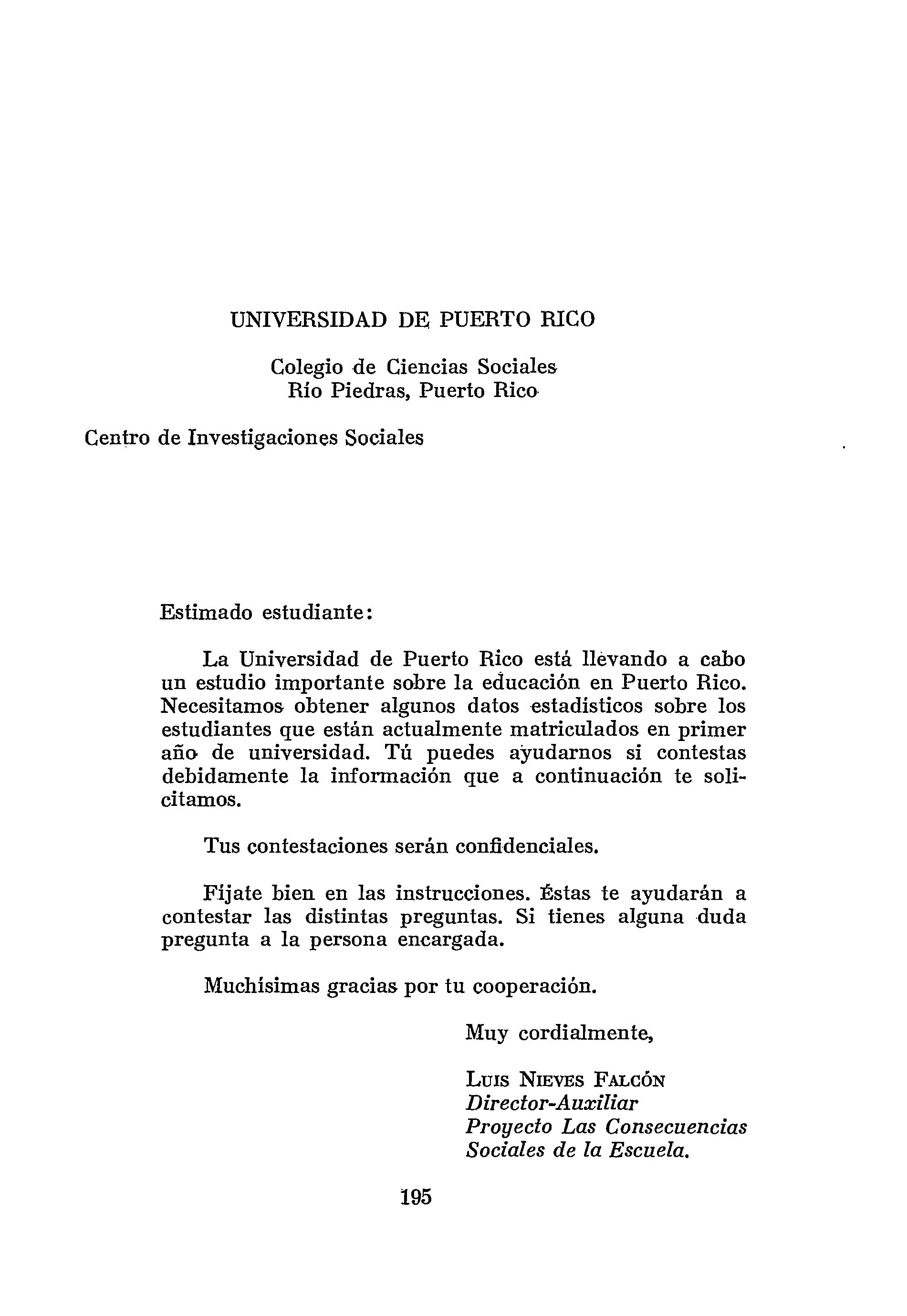
Estimadoestudiante:
LaUniversidaddePuertoRicoestállevandoacabo unestudioimportantesobrelaeducaciónenPuertoRico. Necesitamosobteneralgunosdatosestadísticossobrelos estudiantesqueestánactualmentematriculadosenprimer aña de universidad. Tú puedes ayudarnos si contestas debidamentelainformaciónqueacontinuacióntesolicitamos.
Tuscontestacionesseránconfidenciales.
Fijatebienenlasinstrucciones.Éstasteayudarána contestarlasdistintaspreguntas.Sitienesalguna duda preguntaalapersonaencargada.
Muchísimasgraciasportucooperación.
Muycordialmente, LUISNIEVESFALCÓN Director-Auxiliar ProyectoLasConsecuencias SocialesdelaEscuela.
Datos Estadisticos Sobre
EstudiantesdePrimerAfio
1. Númerodeidentificación
2. ¿Dóndenaciste?

Sexo Masculino Femenino
Barrio Municipio Pais
3. ¿Cuáleslaocupaciónprincipaldetupadreoencargado?
Instrucciones:Hazelfavordedarnoslasiguienteinformaciónacercadelaocupacióndetupadreoencargado.Siestádesempleadoactualmentedá lainformaciónsobre eltrabajo queélhace cuandoestátrabajando.
1. ¿Dóndetrabajageneralmentetupapáoencargado?
2. ¿Cuáleselnombredesuocupación?
3. ¿Quétrabajohaceenesteempleo?
4. ¿Esduefiodealgunapartedelnegociodondetrabaja?
Sí No
Silacontestaciónes"si",¿quépartedelnegocioposee? Todo Lamitadomás Menosdelamitad
5. ¿Tieneempleadosquetrabajanbajosusórdenes?
Si No
Silacontestaciónes ¿cuántosempleadostienebajosus órdenes?

6. ¿Escomerciantetupapá?
Si No
Silacontestaciónes"sí",¿cuáleseltamañodesucomercio? grande mediano pequeño
7. ¿Esdueñodefincatupapá?
Si No
Silacontestaciónes"si",¿cuántascuerdasposee?
4. ¿Cuántosañosdeeducaciónformalcompletótupapá?
Instrucciones:Indicaconunamarcadecotejo(x)lainstruccióncompletadaportupadreoencargado.
1.Ningunainstrucciónformal,nofuealaescuela.
2.Terminóelprimergrado,peronoterminóelcuarto grado.
3.Terminóelcuartogrado,peronoterminóelsexto grado.
4. Terminóelsextogrado,peronoterminóeloctavo grado.
5.Terminóeloctavogrado,peronoasistióalaescuela superior.
6.Tienealgunaescuelasuperior,peronotieneeldiplomadeescuelasuperior.
7.Tienediplomadeescuelasuperior.
8.Tienealgunainstrucciónvocacionalotécnicadespuésdehaberterminadolaescuelasuperior(técnico derayosX,mecánicoderadio),peronotienepreparación deuniversidad.
9.Fuealauniversidadperonoterminóelbachillerato.
10.Tieneeldiplomadebachilleratodeuniversidad.
11.Realizó estudiosdespuésdel bachillerato (estudios post-graduados).

ColegiodeCienciasSociales UniversidaddePuertoRico
Datos.EstadísticosSobreelEstadoSocio-Económico deEstudiantesdeEscuelaSecundaria ~
Nombredelestudiante
Escueladondecursóduodécimogrado (12 año)
Municipio Zona
Añoenqueesteestudiantecursóduodécimogrado
Sobreesteestudiantefavordeofrecerlasiguienteinformación.
1.Ocupaciónprincipaldelpadreoencargado.
Instrucciones:Indiquelaocupaciónprincipaldelpadredel alumnotalycomoapareceenlosformularios deorientación,latarjetaacumulativaoalgún otroexpedienteacadémico.Dédetallesdela ocupaciónsiloshay.Ej.:dueñodetiendapequeñadecalzado,vendedordebilletesdela lotería,agricultor,dueñodefincade20cuerdas.
Sinohayinformaciónalgunasobrelaocupacióndelpadredeesteestudianteenlosexpedientesdelaescuela,perousted,laconsejera oalgúnmaestrodelplantelconocelaocupacióndedichapersona,favordellenarlainformación.
2.Ocupacióndelamadre.
Instrucciones:Favordeseguirlasinstruccionescorrespondientesalapreguntaanterior.

3. Situacióndeempleo.
Instrucciones:Indiqueconunacruz (►~i) la aseveración que mejor describe la situación de empleo del padre o el encargado del estudiante.
Trabaja por su.cuenta (empleo propio)
Empleado con una agencia del gobierno Empleado con una empresa privada Empleado con la familia sin paga
Desempleado
4. Ingreso del padre o encargado.
a. Indique el sueldo devengado por el padre del estudiante. Marque con una cruz ( ) el encasillado correspondiente para señalar el periodo de tiempo cubierto por dicho ingreso.
Sueldo devengado anual mensual semanal
b. Si la información aparece en forma semanal o mensual indique si la persona:
Trabajó regularmente
Trabajó en forma irregular a estacional
c. Si no hay información alguna sobre el ingreso del padre de este estudiante en los expedientes de la escuela, pero usted, la consejera o algún maestro del plantel tienen una idea aproximada del ingreso anual de dicha persona favor de indicarlo en el siguiente espacio:
5. Ingreso de la madre.
a. Indique el sueldo devengado por la madre del estudiante. Marque con una cruz (►ji) el encasillado correspondiente para señalar el período de tiempo cubierto por dicho ingreso.
Sueldo devengado $ anual mensual semanal
199

b. Silainformaciónapareceenformasemanalomensual indiquesilapersona: Trabajóregularmente Trabajóenformaregularoestacional
c. Sinohayinformaciónalgunasobreelingresodelamadre deesteestudianteenlosexpedientesdelaescuela,pero usted,laconsejeraoalgúnmaestrodelplanteltieneuna ideaaproximadadelingresoanualdedichapersonafavor deindicarloenelsiguienteespacio:$
6. ingresodeotrosmiembrosdelafamilia:
Instrucciones:Calculelascontribucionesaportadasporotros miembros de la familia al ingreso anual. Cantidadanualaportadapormiembrosadicionales$
7. Educación.
Instrucciones:Indiqueelúltimoaño deinstrucciónescolar completadoporlospadresdelestudiante.Si el padre estuvo en ocMvo grado, pero no terminódeestudiarlo,señaleelséptimogrado comoelúltimoañodeinstrucción.Procédase asíencasossimilares.
a. Últimoañodeinstruccióncompletadoporelpadreoencargado
b. Últimoañodeinstruccióncompletadoporlamadredel estudiante
Sialgunadelainformaciónanteriornopuedesersuministrada favordeindicarlasrazones.



Name
29.RíoPiedras(SanJosé) 204
30. (UniversityHigh) 419
31.SanJuan(CatholicAcademy) 133
32. " (Col.Puertorriqueño) 111
33. " (PerpetuoSocorro) 297
34.TrujilloAlto(Sta.Cruz) 75
35.Yauco(HolyRosary) 77

(Thisappendixpresentsthedetailsofseveralresults summarizedinthetext.)


SOURCES of DATA:School-agepopulationestimatedbyP.R.Department ofHealth,BureauofDemographicStatistics.Figuresonenrollmenttaken fromtheAnnualReports of theSecretaryofEducationfortheyears 1940-41to1959-60.

SOURCES of DATA:SameasTable1.—AnnualReportsoftheSecretary of Educationfortheyears1940-41to1959-60.

SOURCESOFDATA: SameasTable1.—AnnualReports of theSecretary ofEducationfortheyears1940-41to1959-60.
TABLE4
TEACHERPREPARATIONINTHEELEMENTARYPUBLICSCHOOLS,URBANANDRURAL,BYYEAR
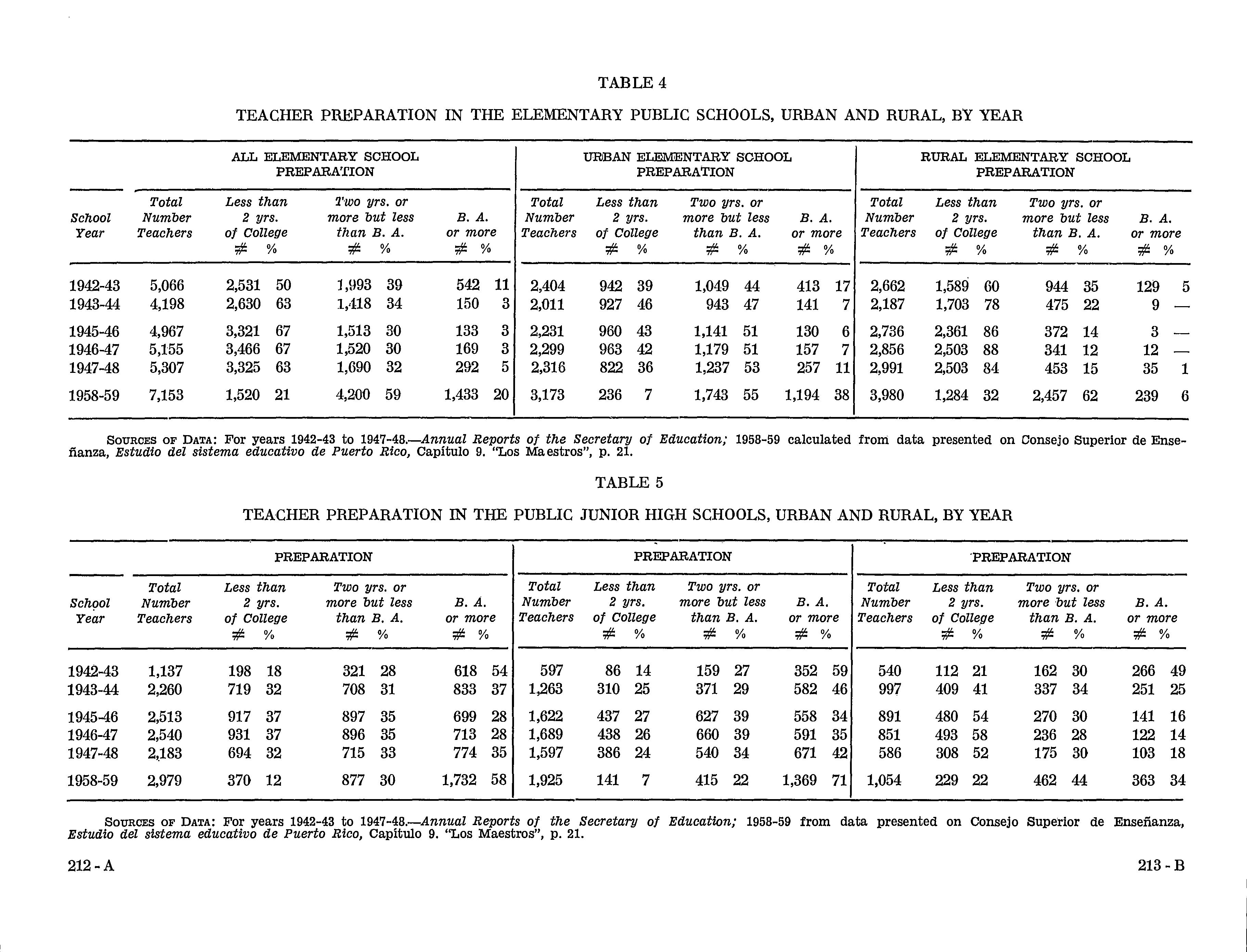
SOURCES OF DATA: Foryears1942-43to1947-48.—AnnualReportsoftheSecretaryofEducation;1958-59calculatedfromdatapresentedonConsejoSuperiordeEnseñanza,EstudiodelsistemaeducativodePuertoRico,Capítulo9."LosMaestros",p.21.
SOURCES OF DATA: For years 1942-43 to 1947-48.—Annual Reports of the Secretary of Education; 1958-59 from data presented on Consejo Superior de Enseñanza, EstudiodelsistemaeducativodePuertoRico,Capítulo9."LosMaestros",p.21.
SchoolYear
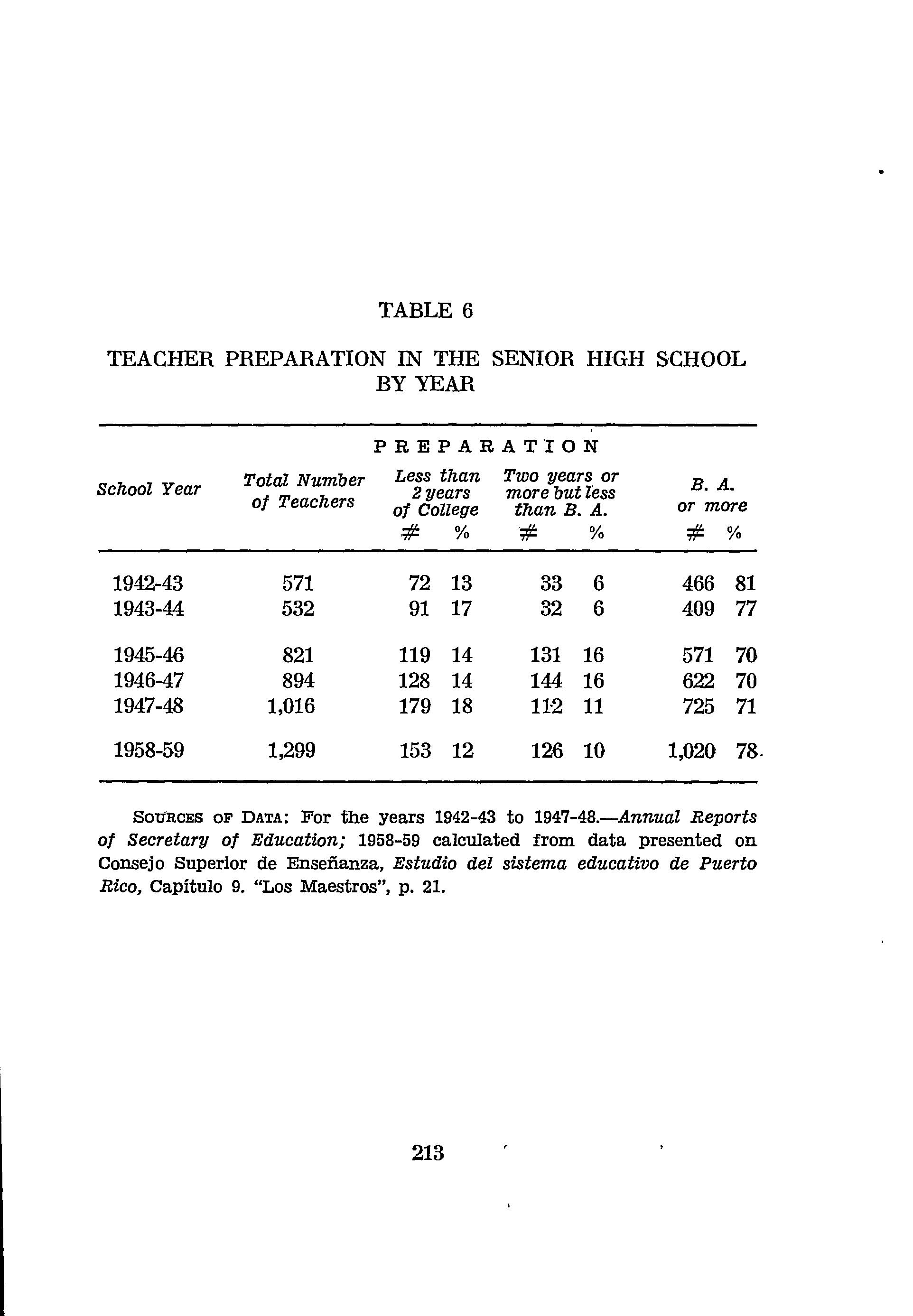
SOURCESOFDATA:Fortheyears1942-43to1947-48.—AnnualReports ofSecretaryofEducation;1958-59calculatedfromdatapresentedon ConsejoSuperiordeEnseñanza,EstudiodelsistemaeducativodePuerto Rico,Capítulo9."LosMaestros",p.21.
PERCENTAGEOFTHEUNIVERSITYAGE-GROUPPOPULATIONENROTLEDINALLCOLLEGESANDUNIVERSITIES INPUERTORICO,BYYEAR

Souuczs of DATA:Estimatesonuniversityage-grouppreparedby P.R.Department of Health,BureauofDemographicStatistics.Figures ontotalenrolmentfortheyears1940-41to1948-49fromConsejoSuperior deEnseñanza.Análisisdelamatrículauniversitariaysusproyeccionesen elfuturo,p.91;1949-50to1958-59;Id.,Estudiodelsistemaeducativode PuertoRico.Capítulo21.LasinstitucionesdeenseñanzasuperiorenPuertoRico,p.234;1959-60to1960-61,PersonalcorrespondencewithRegistrars'officesofthevariousinstitutions.
YearGraduated FromHighSchool DayHighSchool Graduates (Public&Private) Private) AllHighSchool Graduates (DayandBureau ofExtension)

SouacEsor DATA:FiguresonhighschoolgraduatesfromAnnualReportsoftheSecretaryofEducationfor theyears1950-51to1959-60.DataonfirstyearenrolmentfromConsejoSupériórdeEnseñanza.Estudiodel sistemaeducativodePuertoRico.Capítulo21."LasinslitucionesdeenseñanzasuperiorenPuertoRico",p.234 andRegistrar'sOffice,UniversityofPuertoRico,foryearadmissionsof1959-60graduates.


SOURCES of DATA:Foryear1940-41.ConsejoSuperiordeEnseñanza, Análisisdelamatrículauniversitariaysusproyeccionesenelfuturo(Río Piedras,1955),p.60-61.Foryears1941-42to1958-59,JaimeBenítez,The UniversityofPuertoRico(RíoPiedras:OfficeofInformationoftheUniversity,1960).Table7ofappendix,notnumbered.Foryears'1959-60to 1960-61.OficinadelDecanodeEstudios,Grados,certificadosydiplomas conferidosporcolegio,agosto,1962.
RICO FROM 1940 TO 1960

SOURCES OF DATA: SameasforTable1.
RATIOOFSTUDENTS PERTEACHERAT THEUNIVERSITY OFPUERTO RICO FROM 1940-41TO1960-61

SOuncEs OFDATA:
Number of students:1940-41.ConsejoSuperiordeEnseñanza,Análisis delamatrículauniversitaria...,p.53.1941-42to1958-59.University PlanningOffice,FirstSemesterandSummerSessionEnrolmentby Campus,1958,p.1-2.1959-60.OfficeoftheRegistrar,Matrículaporrecinto, añodeclasificaciónysexo:1959-60.1960-61.Id.,MatrículaenlaUniversidaddePuertoRico,PrimerSemestre:1960-61.
Number of teachers:1940-41.ConsejoSuperiordeEnseñanza,op.cit., p.58.1941-42to1958-59.JaimeBenítez,TheUniversity of PuertoRico,1960, Table8ofAppendix.1959-60to1960-61.OfficeoftheDeanofStudies. InstructionalStaffbyCampus,CollegeandAcademicAttainment.December4,1959andSeptember29,1960.

SOURCESOFDATA:SameasforTable3.

SOURCESOFDATA:
Number of students:1940-41.ConsejoSuperiordeEnseñanza,Análisis delamatrículauniversitaria...,p.53.1941-42to1958-59.UniversityPlanningOffice,FirstSemesterandSummerSessionEnrolmentbyCampus, 1958,p.1-2.1959-60.OfficeoftheRegistrar,Matrículaporrecinto,añode clasificaciónysexo:1959-60.1960-61.Id.,MatrículaenlaUniversidadde PuertoRico,PrimerSemestre:1960-61.
Number of teachers:SameasforTable3. T—Teachers.
S=Students.
R=Ratioofstudentsperteacher.

SOURCES:Figuresonnumberofclassroomsforyears1944-45to1955-56 calculatedfromdatapresentedbyPuertoRicoPlanningBoard,Historical Statistics1959,p.40-41.FiguresforallotheryearsfurnishedbytheUniversityPlanningOfficeandtheOfficeoftheDeanofStudies.
RATIOOFSTUDENTSTOCLASSROOMINTHEUNIVERSITY OFPUERTORICOBYCAMPUSANDACADEMICYEAR

SovacEs of DATA: SameasforTables3and6. S-Students. C=Classrooms. R=Ratioofstudentsperclassroom.

RATIOOFBOOKSPERSTUDENTINTHEGENERALLIBRARY UNIVERSITYOFPUERTORICO(RÍOPIEDRAS BYACADEMICYEAR
SOURCESOFDATA: AnnualReports of theLibrarian of theUniversityof PuertoRico,RíoPiedrasCampus,Years1939-40to1960-61.
TABT<F,. 9

1. Up to 1954-55 the academic year includes the two regular semesters and half of the summer session (one additional month). From then on, it covers only the two regular semesters.
2. Includes visiting professors. SOURCES of DATA:¡Same as for Table 8.

NUMBEROFUNITSINSPANISHCOMPLETEDBYENTERING FRESHMENBYYEAR

NUMBEROFUNITSINENGLISHCOMPLETEDBYENTERING FRESHMENBYYEAR
NUMBEROFUNITSINMATHEMATICSCOMPLETED BYENTERINGFRESHMENBYYEAR
NUMBEROFUNITSINNATURALSCIENCESCOMPLETED BYENTERINGFRESHMENBYYEAR

NUMBEROFUNITSINSOCIALSTUDIESCOMPLETED BYENTERINGFRESHMENBYYEAR
TOTALNUMBEROFHIGHSCHOOLUNITSCOMPLETEDBYENTERINGFRESHMENBYTYPE
OFHIGHSCHOOLBYYEAR:1944-45

TOTALNUMBEROFHIGHSCHOOLUNITSCOMPLETEDBYENTERINGFRESHMENBYTYPE
OFHIGHSCHOOLBYYEAR:1952-53 TotalNumberofUnitsCompleted
TABLE6B.
TOTALNUMBEROFHIGHSCHOOLUNITSCOMPLETEDBYENTERINGFRESHMENBYTYPE OFHIGHSCHOOLBYYEAR:1960-61
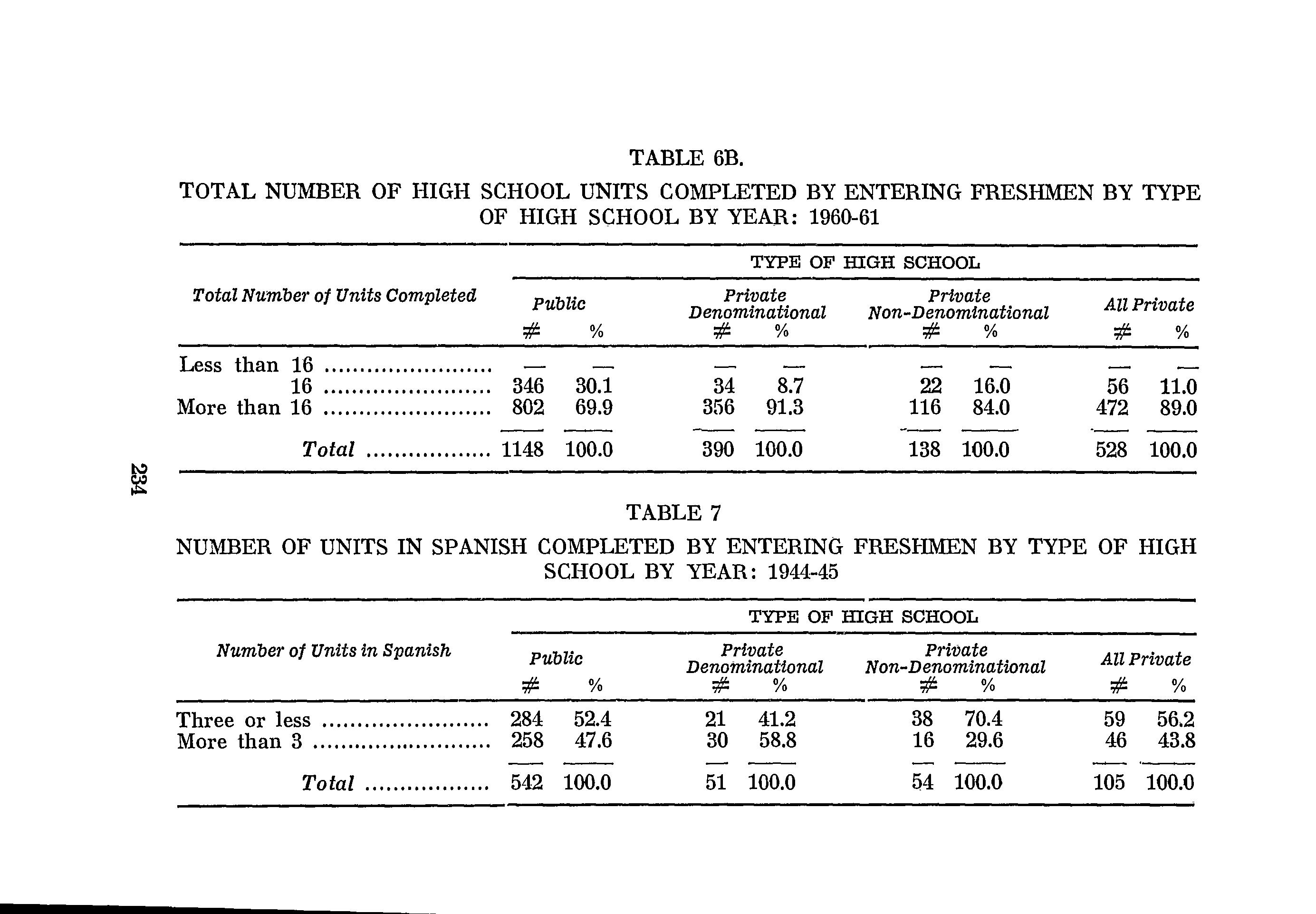
TABLE7
NUMBEROFUNITSINSPANISHCOMPLETEDBYENTERINGFRESHMENBYTYPEOFHIGH SCHOOLBYYEAR:1944-45
NUMBEROFUNITSINSPANISHCOMPLETEDBYENTERINGFRESHMENBYTYPEOFHIGH SCHOOLBYYEAR:1952-53

NUMBEROFUNITSINSPANISHCOMPLETEDBYENTERINGFRESHMENBYTYPEOFHIGH SCHOOLBYYEAR:1960-61
NUMBEROFUNITSINENGLISHCOMPLETEDBYENTERINGFRESHMENBYTYPEOFHIGH SCHOOLBYYEAR:1944-45
TYPEOFHIGHSCHOOL

NUMBEROFUNITSINENGLISHCOMPLETEDBYENTERINGFRESHMENBYTYPEOFHIGH SCHOOLBYYEAR:1952-53
TYPEOFHIGHSCHOOL
NUMBEROFUNITSINENGLISHCOMPLETEDBYENTERINGFRESHMENBYTYPEOFHIGH
SCHOOLBYYEAR:1960-61
TYPEOFHIGHSCHOOL

NUMBEROFUNITSINMATHEMATICSCOMPLETEDBYENTERINGFRESHMENBYTYPE
OFHIGHSCHOOLBYYEAR:1944-45
TYPEOFHIGHSCHOOL
NUMBEROFUNITSINMATHEMATICSCOMPLETEDBYENTERINGFRESHMENBYTYPE

NUMBEROFUNITSINMATHEMATICSCOMPLETEDBYENTERINGFRESHMENBYTYPE
NUMBEROFUNITSINNATURALSCIENCESCOMPLETEDBYENTERINGFRESHMENBYTYPE

NUMBEROFUNITSINNATURALSCIENCESCOMPLETEDBYENTERINGFRESHMENBYTYPE
NUMBEROFUNITSINNATURALSCIENCESCOMPLETEDBYENTERINGFRESHMENBYTYPE OFHIGHSCHOOLBYYEAR:1960-61
TYPEOFHIGHSCHOOL

NUMBEROFUNITSINSOCIALSTUDIESCOMPLETEDBYENTERINGFRESHMENBYTYPE
TYPEOFHIGHSCHOOL
NUMBEROFUNITSINSOCIALSTUDIESCOMPLETEDBYENTERINGFRESHMENBYTYPE

NUMBEROFUNITSINSOCIALSTUDIESCOMPLETEDBYENTERINGFRESHMENBYTYPE
TABLE12
TOTALNUMBEROFHIGHSCHOOLUNITSCOMPLETEDBYENTERINGFRESHMENBYSIZE OFPUBLICSCHOOLSBYYEAR
SIZEOFPUBLICHIGH;SCHOOLSANDYEAR

TotalNumber of UnitsCompleted
TABLE13
TOTALNUMBEROFHIGHSCHOOLUNITS COMPLETED BY ENTERING FRESHMEN BYLOCATIONOFPUBLICHIGHSCHOOLBYYEAR
NUMBEROFUNITSINSPANISHCOMPLETEDBYENTERINGFRESHMENBYSIZEOFPUBLIC
HIGHSCHOOLBYYEAR
SIZEOFHIGHSCHOOLANDYEAR

NUMBEROFUNITSINSPANISHCOMPLETEDBY
NUMBEROFUNITSINENGLISHCOMPLETEDBYENTERINGFRESHMENBYSIZEOFPUBLIC

NUMBEROFUNITSINMATHEMATICSCOMPLETEDBYENTERINGFRESHMENBYSIZE

NUMBEROFUNITSTNNATURALSCIENCESCOMPLETED'BYENTERINGFRESHMENBYSIZE OFPUBLICHIGHSCHOOLSBYYEAR

NUMBEROFUNITSINNATURALSCIENCESCOMPLETEDBYENTERINGFRESHMEN BYLOCATIONOFPUBLICHIGHSCHOOLSBYYEAR
NUMBEROFUNITSINSOCIALSTUDIESCOMPLETEDBYENTERINGFRESHMENBYSIZE OFPUBLICHIGHSCHOOLSBYYEAR




SIZEOFPUBLICHIGHSCHOOLSANDHIGHSCHOOLGRADUATIONINDEXQUINTILE BYYEAR:1944-45 HIGHSCHOOLGRADUATIONINDEXQUINTILE(FROMLOWTOHIGH)

SIZEOFPUBLICHIGHSCHOOLSANDHIGHSCHOOLGRADUATIONINDEXQUINTILE BYYEAR:1952-53 HIGHSCHOOLGRADUATIONINDEXQUINTILE(FROMLOWTOHIGH)

SIZEOFPUBLICHIGHSCHOOLSANDHIGHSCHOOLGRADUATIONINDEXQUINTILE BYYEAR:1960-61

SIZEOFPUBLICHIGHSCHOOLSANDENTRANCEEXAMINATIONQUINTILEBYYEAR:1944-45



TYPEOFHIGHSCHOOLBYINDEXATEND OFFRESHMANYEAR QUINTILE BYYEAR:1960-61
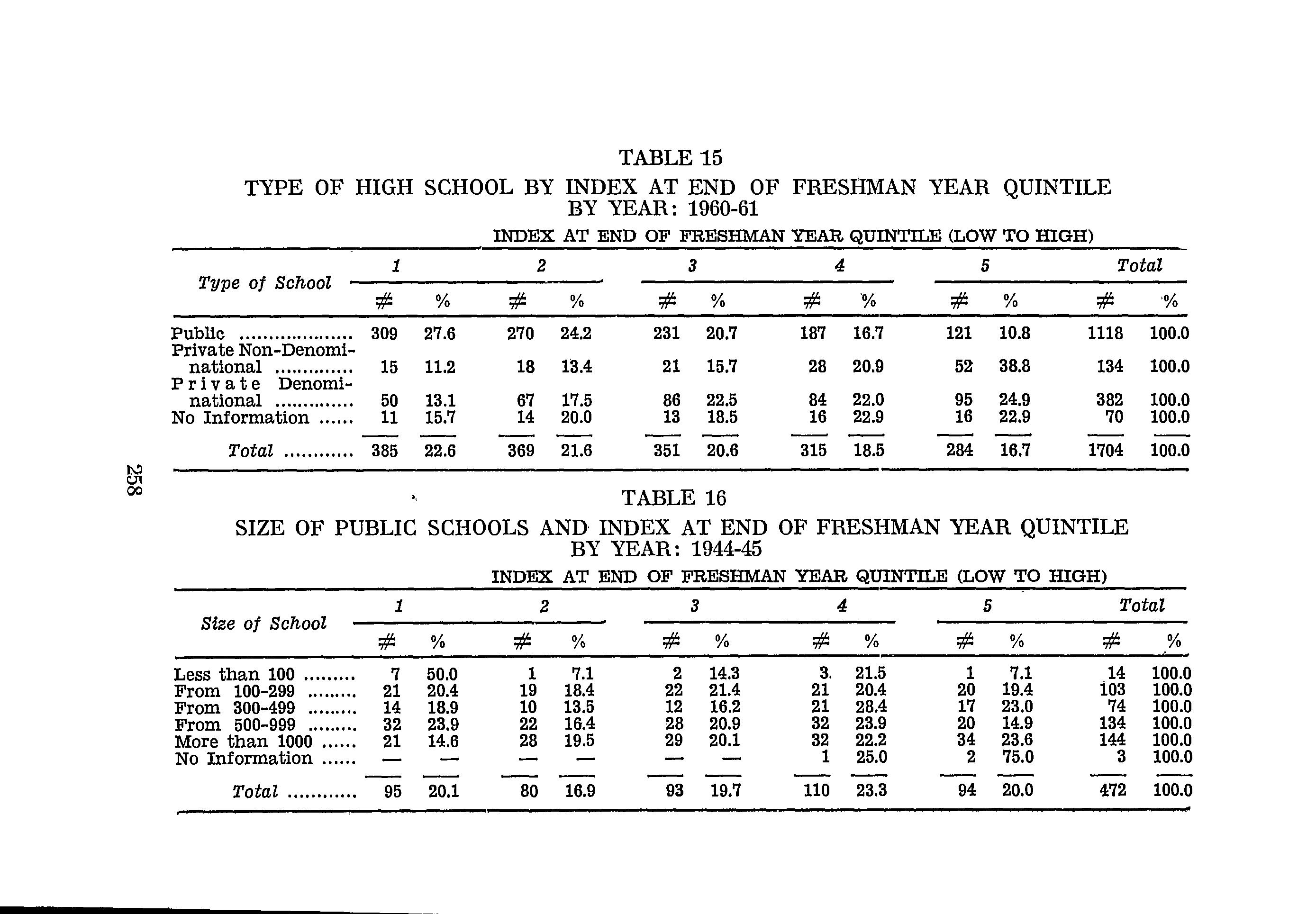
SIZEOFPUBLICSCHOOLSANDINDEXATENDOFFRESHMANYEARQUINTILE
SIZEOFPUBLICHIGHSCHOOLSANDINDEXATENDOFFRESHMANYEARQUINTILE BYYEAR:1952-53

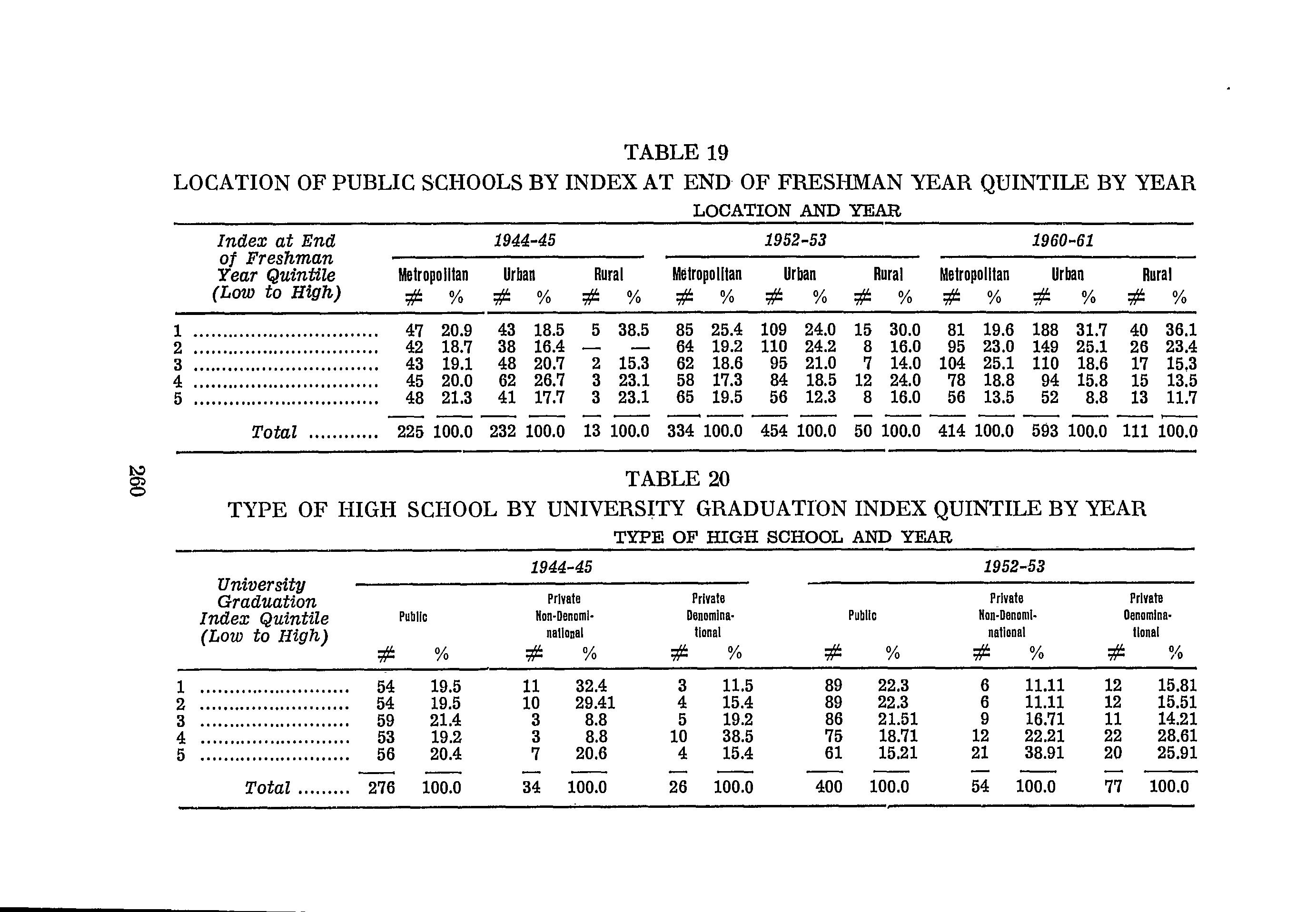

OCCUPATIONALSTATUSOFSTUDENTS'FATHERSANDHIGHSCHOOLGRADUATION

OccupationalStatusofStudents'Fathers
OCCUPATIONALSTATUSOFSTUDENTS'FATHERSANDHIGHSCHOOLGRADUATION
INDEXBYYEAR:1944-45

OccupationalStatusofStudents'Fathers

OCCUPATIONALSTATUSOFSTUDENTS'FATHERSANDHIGHSCHOOLGRADUATION
INDEXBYYEAR:1952-53
OCCUPATIONALSTATUSOFSTUDENTS'FATHERSANDHIGHSCHOOLGRADUATION
INDEXBYYEAR: 1960-61

OccupationalStatusofStudents'Fathers
RATEOFINCREASEINHIGHSCHOOLGRADUATIONINDEX
INPUBLICANDPRIVATESCHOOLS
BYFATHERS'OCCUPATIONIN1944AND1960 Fathers'Occupation

MEANHIGHSCHOOLINDEXINPUBLICANDPRIVATESCHOOLS
BYFATHERS'OCCUPATIONBYYEAR
OCCUPATIONALSTATUSOFSTUDENTS'FATHERSANDENTRANCEEXAMINATIONSCORES
BYYEAR:1944-45

OccupationalStatusofStudents'Fathers
OCCUPATIONALSTATUSOFSTUDENTS'FATHERSANDENTRANCEEXAMINATIONSCORES
BYYEAR:1952-53

OccupationalStatusofStudents'Fathers
OCCUPATIONALSTATUSOFSTUDENTS'FATHERSANDENTRANCEEXAMINATIONSCORES
BYYEAR:1960-61

OccupationalStatusofStudents'Fathers

OCCUPATIONALSTATUSOFSTUDENTS' FATHERS IN PUBLIC HIGH SCHOOLS
BYHIGHSCHOOLGRADUATIONINDEXQUINTILEBYYEAR:1944-45
HIGHSCHOOLGRADUATIONINDEXQUINTILE (LOW TOHIGH)

OCCUPATIONALSTATUSOFSTUDENTS'FATHERSINPUBLICHIGHSCHOOLS
BYHIGHSCHOOLGRADUATIONINDEXQUINTILEBYYEAR:1952-53

OCCUPATIONALSTATUSOFSTUDENTS'FATHERSIN.PUBLICHIGHSCHOOLS
BYHIGHSCHOOLGRADUATIONINDEXQUINTILEBYYEAR:1960-61
HIGHSCHOOLGRADUATIONINDEXQUINTILE(LOWTOHIGH)


COMPARISONINPERCENTAGESBETWEENPRIVATEDENOMINATIONALHIGHSCHOOL
STUDENTS'GENERALHIGHSCHOOLINDEXANDENTRANCEEXAMINATION

COMPARISONINPERCENTAGESOFPUBLICHIGHSCHOOLSTUDENTS'GENERAL HIGHSCHOOLINDEXANDENTRANCEEXAMINATIONSCORESIN

COMPARISONINPERCENTAGESOFPUBLICHIGHSCHOOLSTUDENTS'GENERALHIGH SCHOOLINDEXANDENTRANCEEXAMINATIONSCORESINQUINTILESBYLOCATIONOF HIGHSCHOOLBYYEAR

OccupationalStatusofStudents'Fathers
OCCUPATIONALSTATUSOFSTUDENTS'FATHERSANDINDEXATEND OFFRESHMANYEAR:1944-45

(1)Thisfiguredoesnotinclude82sheetswhodroppedoutbeforefreshmanyear.
OCCUPATIONALSTATUSOFSTUDENTS'FATHERSANDINDEXATEND OFFRESHMANYEAR1952-53
OccupationalStatusofStudents'Fathers

(1)Thisfiguredoesnotinclude88sheetswhodroppedoutbeforetheendofthefreshmanyear.
OCCUPATIONALSTATUSOFSTUDENTS'FATHERSANDINDEXATEND OFFRESHMANYEAR:1960-61
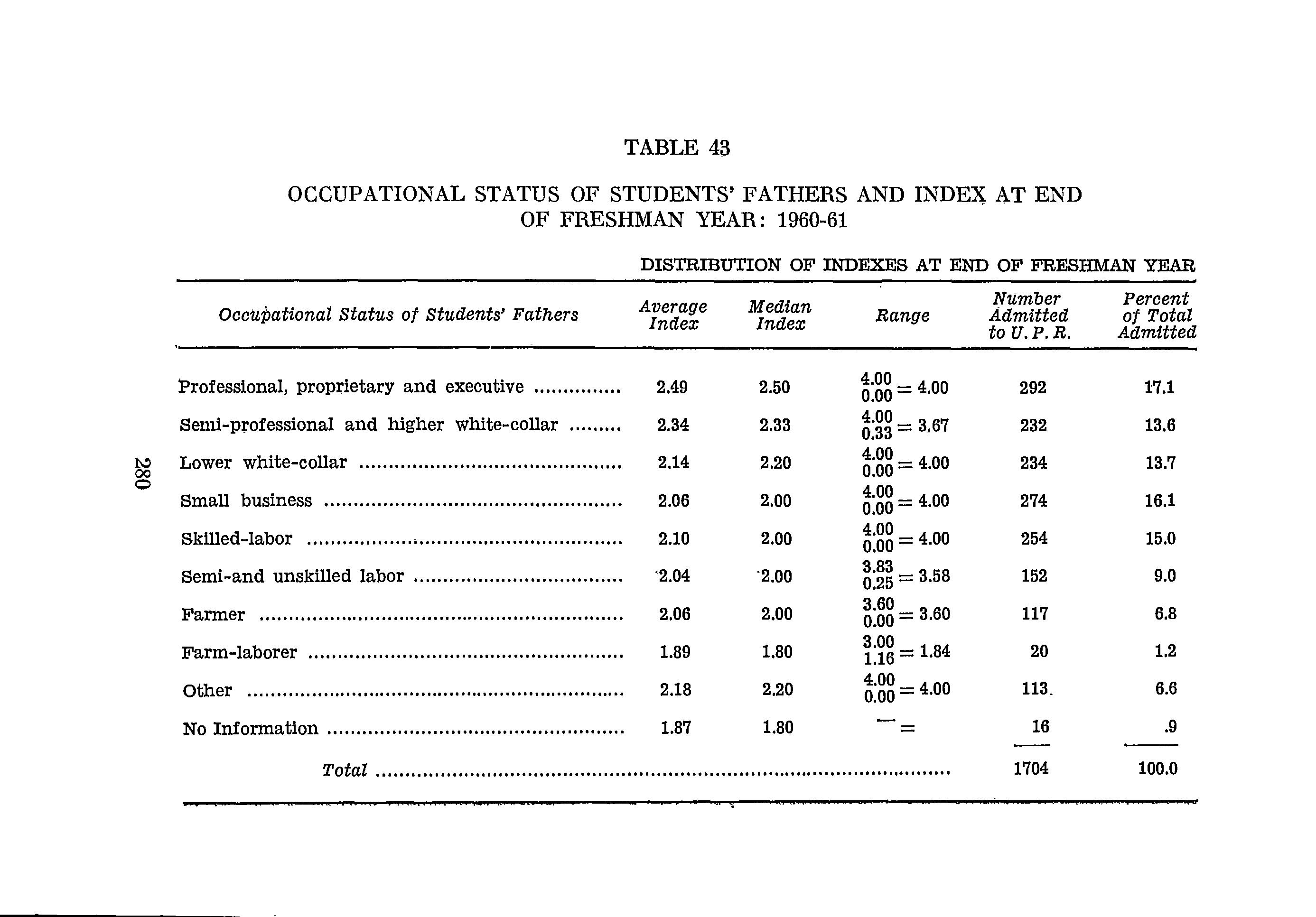
OccupationalStatusofStudents'Fathers

UNIVERSITYGRADUATIONINDICES

OCCUPATIONALSTATUSOFSTUDENTS'FATHERSANDUNIVERSITYGRADUATION INDEXBYYEAR:1944-45

OCCUPATIONALSTATUSOFSTUDENTS'FATHERSANDUNIVERSITYGRADUATION
INDEXBYYEAR: 1952-53
PLACEOFRESIDENCEOFDROPOUTSANDFRESHMEN STUDENTS


FATHERS'OCCUPATIONSOFFRESHMENSTUDENTSANDTHOSEWHOFINISHEDADEGREE, BYLENGTHOFTIMEFINISHINGADEGREEANDACADEMICYEAR

OccupationalStatusofStudents'Fathers
1944-45
FreshmenTimeFinishingDegree studentsFouryearsMorethan orless fouryears
FreshmenTimeFinishingDegree studentsFouryearsMorethan orless fouryears

I.OfficialDocuments(PublishedbytheUniversityofPuerto Rico,RíoPiedras,unlessotherwiseindicated):
AdministracióndeFomentoEconómico.Índicescomparativosde progresoeconómicoysociales:1950-54.SanJuan,1955.
AnnualReport theGovernor PuertoRico(1940-1960).San Juan.
AnnualReport theChancellor theUniversity of PuertoRico (1939-40to1959-60).
AnnualReport theLibrariantotheChancellor theUniversity PuertoRico(1939-40to1961-62).
ARBOLINO,JACKN.AReportonExtensionServicesattheUniversity PuertoRico.RíoPiedras:ConsejoSuperiordeEnseñanza,1959.
BENÍTEZ,JAIME.BasesparaunadiscusiónanteelConsejoSuperior deEnseñanzaacercadeactividadesyproblemasdela UniversidaddePuertoRicosometidasporelRectordela UniversidaddePuertoRico.25dejuniode1946.
Circularnúm.36alClaustrodelosColegiosdeRíoPiedras,3deoctubrede1960.
—Circularnúm.11,30demarzode1961.
—Circularnúm.21,17deseptiembrede19132.
EducationandDemocracy.Addressdeliveredatthe61st AnnualConvention theMiddleStatesAssociationof CollegesandSecondarySchoolsandAffiliatedAssociations, heldatAtlanticCity,NewJersey,November29,1947.
—"Lareformauniversitaria",TheUniversity PuertoRico Bulletin,.SeriesXIII,N.°3,March1943.
—MemorándumdereconsideracióndeasignacióndepresupuestoparalaUniversidaddePuertoRicoenelpresupuestomodelo1962-63,7demarzode1962.

BENÍTEZ, JAIME. ProgramasgraduadosendesarrolloenlaUniversidaddePuertoRico,1958.
-- Reflexionessobreelpresente:tresdiscursos,1950. Suplemento al informe sobre programas graduados en desarrolloenlaUniversidaddePuertoRico,1958. TheFunctionoftheUniversity:PreliminaryStatementto theSuperiorEducationalCouncilbytheChancellorofthe UniversityinhisAnnualReport,1955. TheUniversityofPuertoRico,1960.
-- Valoresyproblemasen la UniversidaddePuertoRico. DiscursodelRectordelaUniversidaddePuertoRicoenla ConferenciadelBicentenariodelaUniversidaddeColumbia,sobrelibertadresponsableenlasAméricas,del25al 30deoctubrede1.954.
"Values on a Frontier".Address deliveredat the Fifth Annual Caribbean Conference, University of Florida, December3,1954.
BLAudn, LLOYDE.PublicEducationintheTerritoriesandOutlying Possessions. Washington D. C.: Government Printing Office,1939.
BOWLES, FRANK H.Informepreliminardealgunasfasesdelestudio de lasinstitucionesde enseñanza de niveluniversitario. ConsejoSuperiordeEnseñanza,1959.
— Preliminary Report to theSuperiorEducational Council andChancelloroftheUniversityofPuertoRicorelative tothedevelopmentofagraduateprogrammeattheU.P.R., April23,1954.
BROWNELL, WILLIAM A.SummaryofCommentsinInstructional AspectsofPublicElementaryEducation inPuertoRico: AReporttotheDeanoftheCollegeofEducation,1941.
BUNKER, HARRIS F.¿Quéestudiosnecesitanrealizarlosestudiantes quesepreparanparacolegio?InformedelRectoralConsejo SuperiordeEnseñanza,Apéndice11.
Bureau of Demographic Registry and Vital Statistics. Annual Reports on Vital Statistics: 1950 to 1961. San Juan, DepartmentofHealth.
Caribbean Commission, Central Secretariat. Education in the Caribbean,1954.
CASELMANN, CHRISTIAN, BORGHI, LAMBERTO AND BREDSFORFF, MORTEN. TheEducationalSysteminPuertoRico:Recommendations andSuggestions,May1959(Confidential).

CírculodeSupervisiónyAdministraciónEscolardePuertoRico. Problemasdelaescuelarural.SanJuan,1945. ColegiodeAgriculturayArtesMecánicasdelaU.P.R.Encuesta realizadaporlaseccióndeorientacióndeempleosdel DecanatodeEstudiantessobrelosgraduadosdelasfacultadesdeagriculturaeingenieríaylastareasalascuales sededican,1961.
ComitédelGobernadorparaelEstudiodelosDerechosCiviles enPuertoRico.InformealHonorableGobernadordelEstadoLibreAsociadodePuertoRico.SanJuan:Colegiode AbogadosdePuertoRico,1959. CommitteeonHumanResources.PuertoRico'sManpowerNeeds andSupply.SanJuan:PlanningBoard,1957. ConsejoSuperiordeEnseñanza.Análisisdelamatrículauniversitariaysusproyeccionesenelfuturo,1955. ElanalfabetismoenPuertoRico,1945.
—Estudiodelosindicesacadémicosdeescuelasuperiorcomo criteriodeadmisiónalaUniversidad,1947.
—EvaluacióndealgunosaspectosdelaprovechamientoacadémicodelosalumnosgraduadosdelaFacultaddeLeyes delaUniversidaddePuertoRico(1939-1948),1949.
—FacilidadeseducativasdelEstadoLibreAsociadodePuerto Rico,1957.
—FasestécnicasdelestudiodelsistemaeducativodePuerto RicoqueserealizabajolosauspiciosdelaComisiónde instruccióndelaCámaradeRepresentantesdePuertoRico, 1960(Chaps.1,2,4,9,11,12,15,20and21).
-- Informesobrevariosaspectosdelaprovechamientoacadémicodealgunoscolegiosuniversitarios(1939-47),1948.
—ProblemasdeeducaciónenPuertoRico,1947. Recursoshumanosconpreparaciónuniversitaria,1958. CRUZ,RAMÓNA.Elfuturodelaescuelapuertorriqueña,suplanificación.HatoRey:DepartamentodeInstrucciónPública, 1961.
DELROSARIO,RUBÉN.InformesdelRepresentantedelClaustro,: Núms.13-19.
DepartmentofEducation.AnualReportoftheSecretaryof Education(1940-41to1959-60).
BulletinofGeneralInformation.PublicSchoolSystemof PuertoRico,1950.
EducationalPhilosophyandReformsintheCurriculum oftheElementarySchool,1942.

DepartmentofEducation.Estudiosobrelosfracasosenprimer gradoenlasescuelaspúblicasdePuertoRico,1950.
— FactsontheSchoolSystemofPuertoRico.(Nodate.) LaeducaciónsecundariaenPuertoRico.MensajedelsecretariodeinstrucciónpúblicadePuertoRico(Sr.Mariano Villaronga,alosdirectoresdeescuelasecundariareunidos enasambleaelsábado27denoviembrede1954).
— LaescuelapúblicaenPuertoRico;normasdesupervisión yadministraciónescolar,1954.
Orientation and organization of the secondary school curriculum,1943.
(DivisiónofStatistics).Poderderetencióndelasescuelas dePuertoRico,1961.
— Programadeeducaciónsecundaria,1952.
— Programadelasegundaunidadrural,1953. ReglamentoparalasescuelassecundariasdePuertoRico, 1961.
Rules and Regulations Governing the Organization and AdministrationoftheSeniorHighSchoolsofPuertoRico, 1944.
— OrganizationofJuniorHighSchools,1942. EstadoLibreAsociadodePuertoRico.Susdocumentosconstitucionalesysímbolos,SanJuan,1958.
VERNOSISERN,ANTONIO.NecesidadeseducativasdePuertoRico. Declaración rendida ante el Subcomité de Educación y TrabajodelaCámaradeRepresentantesdelosEstados Unidos,mayo25,1949.Washington,D.C.:OfficeofPuerto Rico,1949.
GARCÍA,PILAR.Elproyectoparamejorarelcurrículoenlaescuela superior..San Juan: Editorial delDepartamento de InstrucciónPública,1952.
GuErrs,JosÉ."InformeanualalRector:resumendedatos,1954-55", Informe del Rector al Consejo Superior de Enseñanza, ApéndiceIV,1955.
HAYWARD,BERESFORDL.TheFutureofEducationinPuertoRicoItsPlanning.HatoRey:DepartmentofEducation,1961.
— Toward Comprehensive Educational Planning in Puerto Rico,1958.
HoLus,ERNESTV.OrganizationforGoverningandAdministering HigherEducation in Puerto Rico.Río Piedras: Consejo SuperiordeEnseñanza,1959.

Junta Universitaria, Universidad de Puerto Rico. Certificación Núm.6(año1953-54)-Enmiendasalasreglasdeadmisión. —Reunióndel18deenerode1954-Nuevaregladeadmisión, p.1983-84.
I{ENWORTHY, LEONARD S.EducationinPuertoRico. Hato Rey: Department of Education, 1955.
MALDONALD, JAMES. "Summer Exchange of Staff and Reactions to this Summer Program". Typewrittenmemorandumtothe DeansoftheCollegesofEducationoftheUniversityof Wisconsin-Milwaukee,andoftheUniversityofPuerto Rico. August 1,1962.
MALDONADO DENNIS, MANUEL. "Las fraternidades y la perpetuación del prejuicio en la Universidad", (Circulatedamongstthe RíoPiedrasFaculty, February 23,1961).
MimeographedcopyoflettersenttoMr.PedroJavierBoscio ontheintellectualenvironmentofthestudentcenter, February 23,1961.
MimeographedMemorandumcirculatedamongsttheRío PiedrasFacultyonpersonalattacksmadebyastudent newspaper, April 6,1961.
MADRAS POVENTUD, JESÚS. Laescuelaelementalpuertorriqueña. Hato Rey: Department of Education, 1961.
MELÉNDEZ, RAMÓN. AlaHonorableAsambleaLegislativa. Rio Piedras, Asociación Puertorriqueña de Profesores Universitarios, 1962.
MELLADO, RAMÓN A. Informesobrelaorganizacióndelosestudios graduadosdeeducación,conducentesalamaestríaenartes, enlaUniversidaddePuertoRico,1955.
Middle States Association of Colleges and Secondary Schools. CommissiononInstitutionsofHigherEducation.AReport ontheUniversityofPuertoRico,1959. —EvaluationReport,1954.
Office of the Registrer. Estudiosobrelosgraduadosdelosaños 1951-52,1952-53y1953-54.
-- Resumenestadístico:examendeingresopara1955.
OLIVERAS, CÁNDIDO AND BENÍTEZ, JAIME. InformealaAsamblea LegislativadePuertoRicosobrecolegiosregionales,1962.
O'REILLY, BILL. LaeducaciónenPuertoRicodurantelosúltimos 45años. San Juan: Department of Education, 1954.
PRIETO, CLAUDIO. Proyectopreliminardecolegiosregionalesdela UniversidaddePuertoRico,1961.

PropuestasrecibidasporelComitédeReglamentoyLeyUniversitaria,1963.
PuertoRicoPlanningBoard.Informeeconómicoalgobernador, SanJuan,1961.
— ProyeccionesdeldesarrolloeconómicodePuertoRico,1957. StatisticalYearbook:1954to1960.
— (BureauofEconomicsandStatistics).HistoricalStatistics, 1960.
RAMOSANTONINI,ERNESTO.SupplementaryInformationRelativeto theCommonwealthofPuertoRicopreparedfortheMidAtlanticRegionalConference(ThePresident'sCommittee onEducationBeyondtheHighSchool)heldinNewYork UniversityonApril30andMay1,1957.
REEVES,FLOYDW.MemorandumonAspectsoftheOrganization andAdministrationoftheUniversityofPuertoRico,1955.
REIMER, EVERra"1."Implications of Economic Development for Education",.San Juan: CommitteeonHumanResources, 1960.
RODRÍGUEz, SAMUEL L. Estado profesional de losgraduadosde administracióncomercial,1938.
ROsARIo,CHARLES.ReportonExtensionActivities:Problemsand Prospects,August3,1959.
SANCHEzHIDALGO,EFRAÍN."Informesobrelosresultadosdelas pruebascooperativasinteramericanasdadasalosestudiantesdelasescuelaselemental,intermediaysuperiordela UniversidaddePuertoRicoenabrilde1954".Informedel RectoralConsejoSuperiordeEnseñanza,ApéndiceII,1955. TheUniversityofPuertoRicoBulletin(1939-40to1961-62). TheUniversityofPuertoRicoBudget.Resumengeneraldelpresupuesto(1940-41to1960-61).
TORRES,EULALIO.LosmaestrosenelsistemaescolardePuerto Rico.HatoRey:DepartmentofEducation,1961. UniversityPlanningOffice.Distribucióndelnúmerodesemestres yveranosqueasistieronalaU.P.R.antesdegraduarse 428estudiantesdeEstudios Generales, CienciasSociales, HumanidadesyCienciasNaturales,1959. ListofVisitingProfessorsbyCollegeandFieldofSpecializationfrom1941-42.
U.S.BureauoftheCensus.U.S.CensusofPopulation:Puerto Rico(1940,1950,and1950).
WITMER, ELEONORM. Proposals for the Expansion of Library Facilities to Accompany the Establishment of Graduate

Studies in Education at the University of Puerto Rico, November 23, 1955.
II. Books and theses:
American Council on Education. On Getting Into College. Washington, D. C.: The Council, 1949.
ANDERSON, RONALD S. Japan: Three Epechs of Modern Education. Washington, D. C.: Department of Health, Education and Welfare, 1959.
BENDIX, RICHARD, AND LIPSET, MARTIN. Class, Status and Power. London: Routledge and Kegan Paul Ltd., 1954.
BERDIE, R. F., PAYTON, W. AND WILLERMAN, G. After High School What? Minneapolis: University of Minnesota Press, 1953.
BIRD, AUGUSTO. Bibliografía puertorriqueña de fuentes para investigaciones sociales 193045. Rio Piedras: Universidad de Puerto Rico, 1947.
BLANCO, TOMÁS. Prontuario histórico de Puerto Rico. San Juan: Biblioteca de Autores Puertorriqueños, 1955.
BRAMELD, THEODORE. The Remarking of a Culture: Life and Education in Puerto Rico. New York: Harper and Brothers, 1959.
CALLICUT, DOROTHY HINDS. A Study of Socio-economic Status ,of Puerto Rican School Children, M. A. thesis. University of Texas, 1945.
CARLSSON, COSTA. Social Mobility and Class Structure. Sweden: CWK Gleer Up/Lund, 1958.
CARSON,ARTHUR. Higher Education in the Philippines. Washington, D. C.: Department of Health, Education and Welfare, 19.61.
CEBOLLERo, PEDRO A. A School Language Policy for Puerto Rico. Río Piedras: Superior Educational Council, 1945.
— El líder y la universidad. Lima: Universidad Nacional de San Marcos, Facultad de Educación, 1951.
CLARK, BURTON R. The Open Door College: A Case Study. New York: Mc Graw-Hill Book Company, 1960.
COF iESI, EMILIo. Realidad Poblacional de Puerto Rico. San Juan: Imprenta Venezuéla, 1951.
CONANT, JAMES B. The American High School Today. New York: Mc Graw-Hill Book Co., Inc., 1959.
— T(Ze Child, the Parent and the State. Cambridge: Harvard University Press, 1959.

CONANT, JAMES B. EducationandLiberty. Cambridge: Harvard University Press, 1953.
—SlumsandSuburbs:ACommentaryofSchoolsinMetropolitanAreas. New York: Mc Graw-Hill Book Co., Inc., 1961. Columbia University. TeachersCollege. Institute of Field Studies. Public Education and the Future of Puerto Rico:A Curriculum Survey 1948-49. New York: Columbia University, 1950.
CRUZ MOATCI.OVA, LIDIO, AND COLORADO, ANTONIO J. Noticiaypulso delmovimientopolíticosocialpuertorriqueñodel1898-1952. México, D. F.: Orion, 1955.
CUELE, ADAM. EducationalStrategyforDevelopingSocieties. London: Tavistock Publications, 1963.
DE COSTER, SYLVAIN, AND VAN DER ELST, GEORGES. ,MobiliteSociale etEnseignement. Brussels: Les editions de la librairie encyclopedique, 1954.
DEWHURST, FREDERIC J. AND ASSOCIATES. AmericasNeedsand Resources:ANewSurvey. New York: American BookStratford Press, Inc., 1955.
DEWrrr, NICHOLAS. EducationandProfessionalEmploymentin theU.S.S.R. Washington, D.C.: National Science Foundation, 1961.
DÍAz DE VEGA, ELISA. Laenseñanzauniversitariaysuaccesibilidad alasfamiliasjornalerasdePuertoRico. School of Social Work, Rio Piedras, 1945.
DURKHEIM, SMILE. EducationandSociology,Glencoe:TheFree Press,1961.
Educational Testing Service. BackgroundFactorsRelatingto CollegePlansandCollegeEnrollmentAmongPublicHigh SchoolStudents. New Jersey: Educational. 'Testing Service, 1957.
FAUST, AUGUSTUs F. Brazil:EducationinanExpandingEconomy. Washington, D. C.: Department of Health, Education and Welfare, 1959.
FERNANDES, FLORESTAN. Acienciaaplicadaeaeducaocomofactores demudancaculturalprovocada. Sao Paulo: Serviro de Medidas e Pesquisas Educacionais, 1959.
FERNÁNDEZ MÉNDEZ, EUGENIO. Filiaciónysentidodeunaisla: PuertoRico. San Juan: Editorial del Departamento de Instrucción, 1955.
FLOUD, J. E., HAI.say, A. H., AND MARTIN, F. M.SocialClassand

EducationalOpportunity. London: William Heinemann Ltd., 1958.
FRAGA IRIBARNE, MANUEL. Lafamiliaylaeducaciónenunasociedad demasasydemáquinas. Madrid: Cuadernos de Investigación, 1960.
GARRIGA RODRÍGUEZ, FRANCISCO. PredictingtheScholasticSuccess ofCollegeFreshmenattheUniversityofPuertoRico. M.A. Thesis. University of Chicago, 1949.
GEIGEL POLANCO, VICENTE. Elproblemauniversitario. San Juan: Imprenta Venezuela, 1941.
GLASS, D. V. (ed.). SocialMobilityinBritain. London: Routledge and Kegan Paul Ltd., 1954.
GONTAN, Josi A.Historiapolítico-socialdePuertoRico. San Juan: Editorial Esther, 1945.
CREER, EDITH S., AND HARBECK, RICHARD M. WhatHighSchool PupilsStudy. Washington, D. C.: Department of Health, Education and Welfare, 1962.
HALSEY, A. H., FLOUD, J., AND ANDERSON, ARNOLD S. (eds.). Education, EconomyandSociety. New York: The Free Press of Glencoe, Inc., 1961.
HALsEY, A.H. (ed.). AbilityandEducationalOpportunity. Paris: O.E.C. D. Publications, 1961.
HAMUY, EDUARDO. Educaciónelemental,analfabetismoydesarrollo económico. Santiago de Chile: Editorial Universitaria, S.A., 1960.
—ElproblemaeducacionaldelpueblodeChile. Santiago de Chile. Editorial del Pacífico, S.A.,1961.
HARNER, EVELYN. ChangingPatternsofEducationinLatinAmerica. Santa Bárbara California: Technical Military Planning Operation, General Electric Company, 1960.
HARRIS, SEYMOUR E. HigherEducationintheU.S.A.:TheEconomicProblems. Cambridge: Harvard University Press, 1961.
HATT, PAUL K.BackgroundsofHumanFertilityinPuertoRico. New Jersey: Princeton University Press, 1958.
HAUCH, CHARLES C.EducationalTrendsintheCaribbean. Washington, D.C.: Department of Health, Education and Welfare, 1960.
HAVEMANN, E., AND WEST, PATRICIA S.TheyWenttoCollege:The CollegeGraduateinAmericaToday. New York: Harcourt Brace and Co.,1952.
HAVIGHURST, ROBERT J. AmericanHigherEducationinthe1960's. Columbus: Ohio State University Press, 1960.

HOLLINSHEAD, BYRON S.WhoShouldGotoCollege? New York: Columbia University Press, 1952.
HUTCHINSON, BERTRAM. Mobilidadea Trabalho.Rio de Janeiro: Centro Brasileiro de Pesquisas Educacionais, 1960.
IFFERT, ROBERT E. RetentionandWithdrawalofCollegeStudents. Washington, D. C.: Department of Health, Education and Welfare, 1958.
JACI{SON, BRIAN, AND MARSDEN, DENNIS. EducationandtheWorking Class. London: Routledge and Kegan Paul, 1962.
JAFFE, A. J. People,JobsandEconomicDevelopment. Illinois: The Free Press of Glencoe, 1959.
KELSALL, R. K. Report on an Inquiry Into Applications for AdmissiontoUniversities. London: Association of Universities of the British Commonwealth, 1957.
LAUWERYS, J. A. InternationalStudyof University,Admissions: England and Wales. Mimeographed copy restricted to members of the Commission of Experts and Staff conducting the study sponsored by U.N.E.S.C.O. London, 1962.
LIPSET, SEYMOUR M., AND BENDIX, R'EINHARD. SocialMobility in IndustrialSociety. Berkley: The University of California Press, 1959.
MC INToSH, D. M. EducationalGuidanceandthePoolofAbility. London: University of London Press, 1959.
MEJÍAS, FÉLIX. Condicionesdevidadelasclasesjornaleras. San Juan: Imprenta Venezuela, 1946.
MELLADO PARSON, RAMÓN. CultureandEducationinPuertoRico. San Juan: Bureau of Publications, Teachers' Association, 1948.
MILLSC. WRIGHT, SENIOR, CLARENCE, AND GOLDSEN, ROSEK.The PuertoRicanJourney. New York: Harper and Brothers, 1950.
Ministry of Education. Early Living. London: Her Majesty's Stationery Office, 1955.
— 15 to18:Report of the Central Advisory Council for Education-England. London: Her Majesty's Stationery Office, 1960.2vols.
MORALES CARRIÓN, ARTURO. Puerto Rico and the Non-hispanic Caribbean.Rio Piedras: University of Puerto Rico Press, 1952.
MORALES OTERO, PABLO, AND PÉREZ, MANUEL. HealthandSocioeconomicStudies in Puerto Rico. San Juan: School of Tropical Medicine, 1941.

MOREY,LLOYD.TheState-supportedUniversity.Carbondale: SouthernIllinoisUniversityPress,1961.
MUNIZSOUFFRONT,Luis.ElproblemadelidiomaenPuertoRico. SanJuan:BibliotecadeAutoresPuertorriqueños,1954.
NIBLETT,W.R.(ed.).TheexpandingUniversity.London:Faber andFaber,1962.
OrganizationforEconomicCo-operationandDevelopment.Policy ConferenceonEconomicGrowthandInvestmentin Education.Paris:O.E.C.D.Publications,1962.5vols.
ORLEANS,LEOA.ProfessionalManpowerandEducationin CommunistChina.Washington,D.C.:NationalScience Foundation,1961.
OSUNA,JUANJosÉ.AHistoryofEducationinPuertoRico.RíoPiedras:EditorialdelaUniversidaddePuertoRico,1949.
PAYNE,GEORGELouis.Britain'sScientificandTechnological Manpower.London:OxfordUniversityPress,1960.
PEREIRA,Luiz.Aescolanumaareametropolitana.SaoPaulo, Brazil:FacultadedeFilosofia,CienciaseLetrasdaUniversidadedeSaoPaulo,1960.
PERLOFF,HARVEYS.PuertoRico'sEconomicFuture.Chicago: UniversityofChicagoPress,1950.
PORRATA,OSCAREMILIO.Asuggestedpolicyfortheadministration andcontrolofpubliceducationinPuertoRico.SanJuan: BureauofPublications,PuertoRicoTeachers'Association, 1949.
Qum mRO ALFARO,ÁNGEL.ACriticalAnalysisoftheGeneralStudies ProgramoftheUniversityofPuertoRicoandaPlanfor itsDevelopment.Ph.D.Thesis.UniversityofChicago,1949.
REID,CHARLESFREDERICK.Educationintheterritoriesandoutlying possessions of theUnitedStates.NewYork:Teachers College,ColumbiaUniversity,1941.
REISS,ALBERTJ.OccupationsandSocialStatus.NewYork:The FreePressofGlencoe,Inc.,1961.
RIVERACORREA,RICARDOR.Memoriasdeunestudiante.RioPiedras:TipografiaPorvenir,1950.
ROBERTS,LYDIAJ.,ANDSTEFANI,ROSAL.Patterns of Livingin PuertoRicanFamilies.RíoPiedras:UniversityofPuerto RicoPress,1949.
ROGLER,CHARLES.Comerlo.Lawrence:UniversityofKansasPress, 1940.
ROPER,ELMO.FactorsAffectingtheAdmissionsofHighSchool

SeniorstoCollege.Washington,D.C.:AmericanCouncil onEducation,1949.
ROSARIO,JosÉCOLOMBAN.Laescuelarural.SanJuan:Imprenta Venezuela,1936.
ROSARIO,IsAAcDEL.Elperegrino:historiadeunaescuelapública elementaleintermedia,vividaporespaciodequinceaños. SanJuan:CooperativedeArtesGráficasRomualdoReal, 1956.
ROSENBERG,MORRIS.OccupationsandValues.Glencoe:TheFree Press,1957.
SANFORD,NEvITT(ed.).TheAmericanCollege.NewYork:John WileyandSons,1962.
TheScottishCouncilforResearchinEducation.Educationaland OtherAspectsofthe1947ScottishMentalSurvey.London: UniversityofLondonPress,1958.
SELLESSOLA,GERARDO.LecturashistóricasdelaeducaciónenPuertoRico.RíoPiedras:EditorialdelaUniversidaddePuerto Rico,1943.
SEXTON,PATRICIACAYO.EducationandIncome.NewYork:The VikingPress,1961.
SIEGEL,Mourns.APuertoRicanTown.ManuscriptintheSocial ScienceResearchCenter,UniversityofPuertoRico.
SILVERT,K.H.,ANDBONILLA,FRANK.EducationandtheSocial MeaningofDevelopment:APreliminaryStatement.New York:AmericanUniversitiesFieldStaff,Inc.,1961.
SoTo,JUANB.Launiversidadylaescuelaeneldramadelavida. RioPiedras:EditorialdelaUniversidaddePuertoRico, 1942.
STEWARD,JULIÁN,(ed.),ThepeopleofPuertoRico.Chicago: UniversityofIllinoisPress,1956.
SVALASTOGA,KAARE.Prestige,ClassandMobility.Copenhaguen: ScandinavianUniversityBooks,1959.
TMOMAS,LAWRENCE.TheOccupationalStructureandEducation. NewYork:PrenticeHall,1956.
TINKER,HUGH.TheUnionofBurma.London:OxfordUniversity Press,1961.
TUMIN,MELVINM.SocialClassandSocialChangeinPuertoRico. NewJersey:PrincetonUniversityPress,1961.
TUGWELL,REXFORDG.TheStrickenLand:Story.ofPuertoRico. NewYork:DoubledayandCo.,Inc.,1947.
U.N.E.S.C.O.BasicFactsandFigures:InternationalStatistics

RelatingtoEducation,CultureandMassCommunications. Paris,1961.
UnitedNations.DepartmentofEconomicandSocialAffairs. ReportontheWorldSocialSituation.NewYork:United NationsPublications,1961.
U.S.CommissiononCivilRights.Education:1961Commission onCivilRightsReport.Washington,D.C.:U.S.Government PrintingOffice,1962.
U.S.President'sCommissiononHigherEducation.Higher EducationforAmericanDemocracy:AReport.Washington, D.C.:U.S.GovernmentPrintingOffice,1947..6vols. UniversidaddeBuenosAires.CensoUniversitario.BuenosAires, Argentina,1959.
UniversidaddeChile.InstitutodeInvestigacionesEstadisticas. BoletínEstadísticodelaUniversidaddeChile.Vol.IV, N.°2,1964.
UniversidadNacionalAutónoma.InstitutodeInvestigacionesSociales.PrimerCensoNacionalUniversitario.México:EditorialStylo,1953.
UniversidadNacionaldeSanMarcos.ComisiónCoordinadorade laReforma,OficinaCentralEjecutiva.Estudiodelarealidad universitaria:censodelalumnado.Lima,Perú,1957. UniversityGrantsCommittee.UniversityDevelopment:1947-1952. London:HerMajesty'sStationeryOffice,1953.
—UniversityDevelopment:1952-1957.London:HerMajesty's StationeryOffice,1959.
UniversityDevelopment:1957-1961.London:HerMajesty's StationeryOffice,1962.
VAIZEY,JOHN.BritainintheSixties:EducationforTomorrow. London:PenguinBooksLtd.,1962.
—TheCostsofEducation.London:GeorgeAllenandUnwin, Ltd.,1958.
TheEconomicsofEducation.London:FaberandFaberLtd., 1962.
VALENTINE,P.F.(ed.).TheAmericanCollege.NewYork:PhilosophicalLibrary,1949.
VERNON,P.E.SecondarySchoolSelection.London:Methuenand Co.Ltd.,1957.
VIVASMALDONADO,JosiL.HistoriadePuertoRico.SanJuan: OfficeoftheDiocesanSuperintendentofSchools,1957. WARNER,W.L.HAVIGHURST,R.J.,ANDLOES,M.B.WhoShallbe

Educated?TheChallengeofUnequalOpportunities.New York:HarperandBrothers,1944.
WAYLAND,,SLOAN,ANDBRUNNER,EDMUNDDES.TheEducational Characteristics of the AmericanPeople.NewYork: TeachersCollege,ColumbiaUniversity,1958.
Warm,RUELCLYDE.TheseWillGotoCollege.ClevelandsPress ofWesternReserveUniversity,1952.
WILGUs,CURTISA.(ed.).TheCaribbean:ContemporaryEducation. Gainsville:UniversityofFloridaPress,1960.
WOLFLE,DAL.America'sResourcesofSpecializedTalent.New York:HarperandBrothersPublishers,1954. YearbookofEducation:1950.London:EvansandBrothersLtd., 1950.
III.Pamphlets,articlesandnewspapers:
AGUIRREBELTRÁN,GoNzuo.OrganizationandStructureofLatin AmericanUniversities.Washington,D.C.:PanAmerican Union,1961.
ANDERSON,C.A.,"SocialClassDifferentialsinthe.Schoolingof YouthWithintheRegionsandCommunitySizeGroupsof theUnitedStates",SocialForces,25.4.47,p.434-40. "TheSocialStatusofUniversityStudentsinRelationto TypeofEconomy:AnInternationalComparison",TransactionsoftheThirdWorldCongressofSociology,Vol.5,56, p.51-63.
ARMSTRONG,M."Schools,ClassandSociety",UniversityLeft Review,1(1)Spring1957,p.63-65.
BARENDSEN,ROBERTD."Self-supportingSchoolsinCommunist China:TheHalf-work,Half-studyUniversities",Washington,D.C.:OfficeofEducation,Pre-publicationDraft Copy,1962.
BENEDICT,BURTON."EducationWithoutOpportunity:Education, Economicsand CommunalisminMauritius",Human Relations,Vol.11,N.°4,1958,p.315-329.
BOWLEs,FRANKH."TheHighCostofLowCostEducation",in SeymourE.Harris,ed.,HigherEducationintheUnited States,Cambridge:HarvardUniversityPress,1960,p.199202.
BRANDAOLOPES,J.R."EstructuraSocialeEducaonoBrasil", Educ.Cienc.Soc.4(10),Apr.59,p.53-77.
300
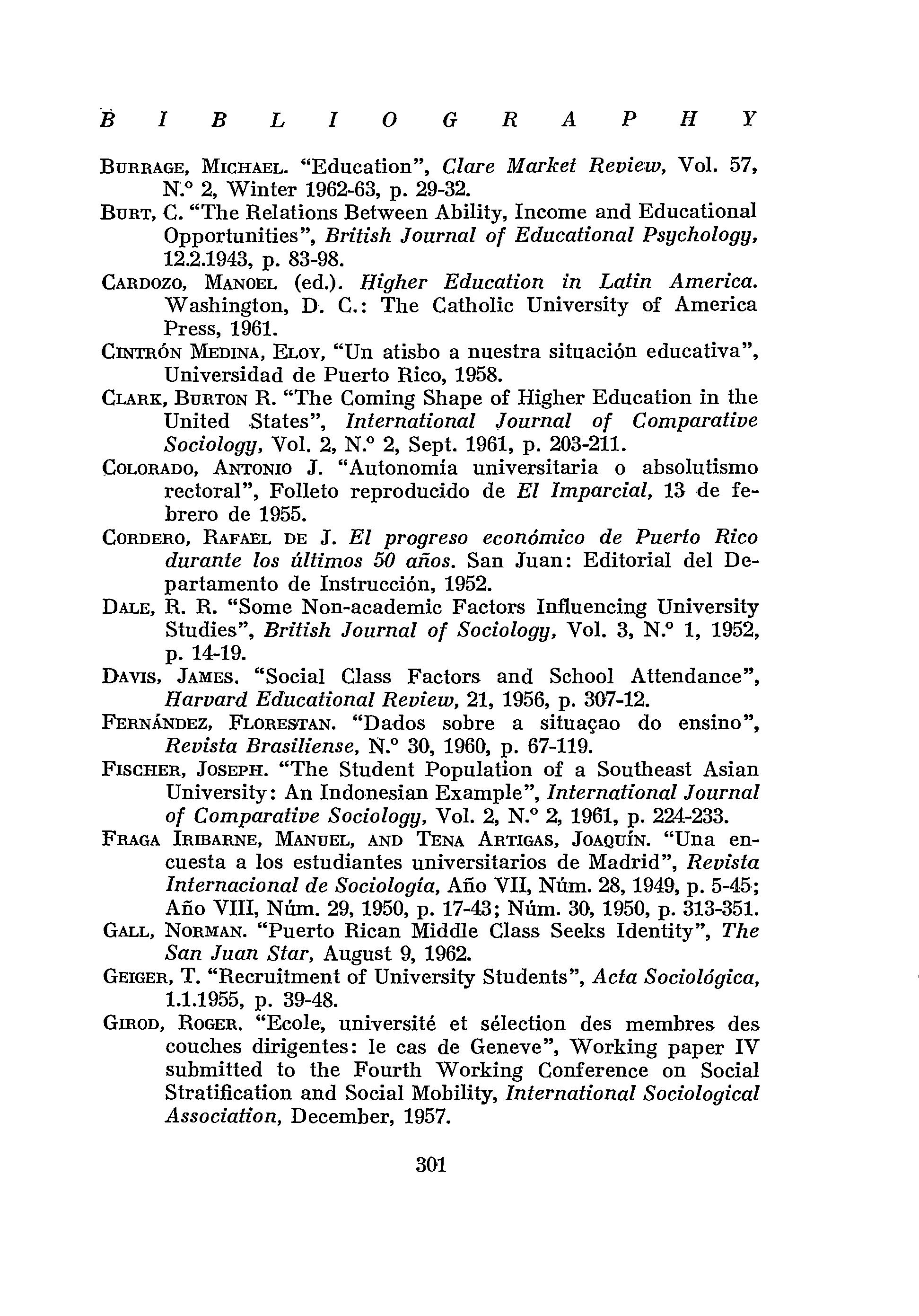
BURRAGE,MICHAEL."Education",ClareMarketReview,Vol.57, N.°2,Winter1962-63,p.29-32.
BURT,C."TheRelationsBetweenAbility,IncomeandEducational Opportunities",BritishJournalofEducationalPsychology, 12.2.1943,p.83-98.
CARDozo,MANOEL(ed.).HigherEducationinLatinAmerica. Washington,D.C.:TheCatholicUniversityofAmerica Press,1961.
CINTRÓNMEDINA,ELOY,"Unatisboanuestrasituacióneducativa", UniversidaddePuertoRico,1958.
CLARK,BURTONR."TheComingShapeofHigherEducationinthe UnitedStates",InternationalJournalof Comparative Sociology,Vol.2,N.°2,Sept.1961,p.203-211.
COLORADO,ANTONIOJ."Autonomíauniversitariaoabsolutismo rectoral",FolletoreproducidodeElImparcial,13•defebrerode1955.
CORDERO,RAFAELDEJ.ElprogresoeconómicodePuertoRico durantelosúltimos50años.SanJuan:EditorialdelDepartamentodeInstrucción,1952.
DALE,R.R."SomeNon-academicFactorsInfluencingUniversity Studies",BritishJournalofSociology,Vol.3,N°1,1952, p.14-19.
DAVIS,JAMES."SocialClassFactorsandSchoolAttendance", HarvardEducationalReview,21,1956,p.3O7-12.
FERNÁNDEZ,FLORESTAN."Dadossobreasituacaod0ensillo", RevistaBrasiliense,N.°30,1960,p.67-119.
FISCHER,JOSEPH."TheStudentPopulationofaSoutheastAsian University:AnIndonesianExample",InternationalJournal ofComparativeSociology,Vol.2,N°2,1961,p.224-233.
FRAGAIRIBARNE,MANUEL,ANDTENAARTIGAS,JOAQUÍN."UnaencuestaalosestudiantesuniversitariosdeMadrid",Revista InternacionaldeSociología,AñoVII,Núm.28,1949,p.5-45; AñoVIII,Núm.29,1950,p.17-43;Núm.3O,1950,p.313-351.
GALL,NORMAN."PuertoRicanMiddleClassSeeksIdentity",The SanJuanStar,August9,1962.
GEIGER,T."RecruitmentofUniversityStudents",ActaSociológica, 1.1.1955,p.39-48.
GIROD,ROGER."Ecole,universitéetsélectiondesmembresdes couchesdirigentes:lecasdeGeneve",WorkingpaperIV submittedtotheFourthWorkingConferenceonSocial StratificationandSocialMobility,InternationalSociological Association,December,1957.

GROSS,N."ACritiqueofSocialClassStructureandAmerican Education",HarvardEducationalReview,23,1953,p.298329.
HALSEY,A.H."ChangingFunctions'ofUniversities",Harvard EducationalReview,Vol.30,N.°2,1960,119-27.
HAVIGHURST,R.J."Education,.SocialMobilityandSocialChange inFourSocieties",InternationalReviewofEducation, Vol.4,N.°2,1958,p.167-82.
HAUCH,CHARLESC.CollegeandUniversityPublicEducation.in theCaribbean,Washington,D.C.:OfficeofEducation,1960. —PresentSituationinLatinAmericanEducation.Washington,D.C.:DepartmentofHealth,Educationand Welfare,1962.
HUSEN,TORSTEN.ProblemsofDifferentiationinSwedishCompulsorySchooling.Stockholm:InstituteofEducationalResearch, TeachersCollege,UniversityofStockholm,1960.
IRVING,J."WhoGoestoCollege?",JournalofSocialResearch,5, 1954,p.73-80.
JACCARD,P."L'originesocialedesetudianteenSuisseeta l'etranger",SchweizerHochschulzeitung,Vol.28,N.°1, 1955,p.17-25.
JAHODA,G."TheSocialBackgroundofaWestAfricanStudent Population",BritishJournalofSociology,Vol.5,N.°4,1954, p.355-365.
KLINGENDER,F."ChanginPatternsofStudentRecruitmentin England",UniversitiesQuarterly,Vol.1,N°2,1955, p.168-76.
LEWIS,ARTHURW."EducationandEconomicDevelopment", SocialandEconomicStudies,Vol.10,N.°2,1961,p.113-27.
LITTLE,A.N."WillMoreMeanWorse?:AnInquiryintoEffects ofUniversityExpansion",BritishJournalofSociology, Vol.12,N°4,1961,p.351-62.
LYNN,R."TheRelationBetweenEducationalAchievementand SchoolSize",BritishJournalofSociology,Vol.10,N°2, 1959,p.129-36.
MULLIGAN,R.A."Socio-economicBackground and College Enrollment",AmericanSociologicalReview,16,1951, p.188-96.
—"SocialCharacteristicsofCollegeStudents",American SociologicalReview,18,1953,p.305-10.
NASH,MANNING."EducationinaNewNation:TheVillageSchool

inUpperBurma",InternationalJournalof Comparative Sociology,Vol.2,N.°2,1961,p.135-43.
PALMIER,LESLIEH."OccupationalDistributionofParentsofPupils inCertainIndonesianEducationalInstitutions",Indonesie, Vol.1,1957,p.320-76.
PAGAN DE COLON,PETROAMERICA.Woman'sRoleinPuertoRico. New York: Department of Labour, Commonwealth of PuertoRico,1955.
PEYRE,CHRISTIANE."RegionalVariationsinEducationalOpportunity in France", International Journal of Comparative Sociology,Vol.2,N°2,1961,p.167-75.
RODRÍGUEZ Bou,ISMAEL.Laeducaciónentrestiemposdelquehacer puertorriqueño. Rio Piedras:UniversidaddePuertoRica, 1953.
LaeducaciónyelproblemapoblacionaldePuertoRico. RioPiedras:UniversidaddePuertoRico,1952.
Elpapelque desempeña un colegio universitario en los asuntos de la comunidad. Discurso pronunciado en el simposiosobrecooperacióndelasagenciaseducativasen lavidadelacomunidad.InstitutoPolitécnico,2demarzo de1956.
Planeamiento cualitativo de la Educación superior. Rio Piedras: Consejo Superior de Enseñanza, 28 de marzo de1958.
ROGOFF,NATALIE.NotesandDraftsfor"AmericanHighSchools atMidcentury"(Tentativechapteroutlineofabook).New York: Bureau of Applied Social Research, Columbia University,1959.
SEWELL,W.H.,HALLER,A.O.,ANDSTRAUS,MURRAYA."Social StatusandOccupationalAspirations",AmericanSociological Review,22,1957,p.67-73.
STRAUss, MURRAYA."Family Characteristics and Occupational ChoiceofUniversityEntrantsasCluestoSocialStructure ofCeylon",UniversityofCeylonReview,9,1951,p.125-135.
U.S.Bureauof theCensus.Fertility bySocialandEconomic StatusforPuertoRico,Washington,D.C.:Bureauofthe Census,1954.
U.S.NationalCommissionforU.N.E.S.C.O.AfricaandtheUnited States.Washington,D.C.:U.S.GovernmentPrintingOffice, 1961.
WELLS, HENRY.La consecucióndelgobiernopropio enPuerto

Rico.SanJuan:EditorialdelDepartamentodeInstrucción, 1955.
WisE, MAX W. They Come for the Best of Reasons: College StudentsToday.Washington,D.C.:AmericanCouncilon Education,1958.
YOUMANS, E. G. "Factors in Educational Attainment", Rural Sociology,Vol.24,N.°1,1959,p.21-28.

SE TERMINÓ DE IMPRIMIR ESTE LIBRO EL DÍA
7 DE JUNIO DE 1965, EN LOS TALLERES DE INDUSTRIAS GRÁFICAS "DIARIO - DÍA" DE PALENCIA DE CASTILLA, BAJO EL CUIDADO TIPOGRÁFICO DE LA EDITORIAL UNIVERSITARIA DE RÍO PIEDRAS, PUERTO RICO
THOMAS E. BENNER. FIVE YEARS OF FOUNDATION BUILDING. THE UNIVERSITY OF PUERTO RICO 1924-1929.
Prefaced by chancellor Jaime Benitez
Chancellor Benner's narrative, written many years after the events and based principally upon a diligent review of university files, contemporary newspaper accounts and his own carefully kept record, makes very illuminating reading. Price $2.50
Traces the history of Puerto Rican education under the government of Spain and, later, the United States. Makes a careful survey of education in Puerto Rico from 1920 to1945.
657pp. Hard _cover $1.25

fundofourknowledgeaboutVenezuelan mycology. 1
Stuart J. Danforth 'r
A scientific study of different species of birds which are found on the island of Santa'Lucia:The study wasmadein thefieldbyaspecialistinthesubject. i 129pp. ;